
| Homepage > The Work of the Assembly > Committees > Regional Development > Reports > Report on the Committee's Inquiry into Sustainable Transport | |||||||||||||||||||||||||||||||||||||||||||||||||||||||||||||||||||||||||||||||||||||||||||||||||||||||||||||||||||||||||||||||||||||||||||||||||||||||||||||||||||||||||||||||||||||||||||||||||||||||||||||||||||||||||||||||||||||||||||||||||||||||||||||||||||||||||||||||||||||||||||||||||||||||||||||||||||||||||||||||||||||||||||||||||||||||||||||||||||||||||||||||||||||||||||||||||||||||||||||||||||||||||||||||||||||||||||||||||||||||||||||||||||||||||||||||||||||||||||||||||||||||||||||||||||||||||||||||||||||||||||||||||||||||||||||||||||||||||||||||||||||||||||||||||||||||||||||||||||||||||||||||||||||||||||||||||||||||||||||||||||||||||||||||||||||||||||||||||||||||||||||||||||||||||||||||||||||||||||||||||||||||||||||||||||||||||||||||||||||||||||||||||||||||||||||||||||||||||||||||||||||||||||||||||||||||||||||||||||||||||||||||||||||||||||||||||||||||||||||||||||||||||||||||||||||||||||||||||||||||||||||||||||||||||||||||||||||||||||||||||||||||||||||||||||||||||||||||||||||||
|
|||||||||||||||||||||||||||||||||||||||||||||||||||||||||||||||||||||||||||||||||||||||||||||||||||||||||||||||||||||||||||||||||||||||||||||||||||||||||||||||||||||||||||||||||||||||||||||||||||||||||||||||||||||||||||||||||||||||||||||||||||||||||||||||||||||||||||||||||||||||||||||||||||||||||||||||||||||||||||||||||||||||||||||||||||||||||||||||||||||||||||||||||||||||||||||||||||||||||||||||||||||||||||||||||||||||||||||||||||||||||||||||||||||||||||||||||||||||||||||||||||||||||||||||||||||||||||||||||||||||||||||||||||||||||||||||||||||||||||||||||||||||||||||||||||||||||||||||||||||||||||||||||||||||||||||||||||||||||||||||||||||||||||||||||||||||||||||||||||||||||||||||||||||||||||||||||||||||||||||||||||||||||||||||||||||||||||||||||||||||||||||||||||||||||||||||||||||||||||||||||||||||||||||||||||||||||||||||||||||||||||||||||||||||||||||||||||||||||||||||||||||||||||||||||||||||||||||||||||||||||||||||||||||||||||||||||||||||||||||||||||||||||||||||||||||||||||||||||||||||
| Discussion Groups | Thematic Area | Organisations | Participants |
|---|---|---|---|
| Working Group 1 | Social Aspects | 17 |
18 |
| Working Group 2 | Economic Aspects | 14 |
14 |
| Working Group 3 | Environmental Aspects | 14 |
16 |
| Working Group 4 | Policies | 22 |
24 |
| Working Group 5 | Attitudes | 13 |
13 |
| Working Group 6 | Technologies | 11 |
12 |
52. Details of the names of the organisations and the participants can be found in Appendix 9. Working Group 1 and Working Group 4 were each divided up into two subgroups to ensure that the maximum participant number in group discussions did not exceed 15. One participant moved between groups in both sessions.
53. Copies of the questions to be addressed in each working group, a list of participants in the working groups, and copies of the written submissions received were made available to participants in advance of the evidence engagement event. Working group materials can also be found in Appendix 9.
54. Working groups were facilitated by a member of the Assembly's Research and Library Services. Committee Members were free to join working groups in the role of a silent observer for all or part of any given workshop. Each working group identified one of its number to act as rapporteur on the outcome of their group's discussions to the plenary sessions. After the rapporteurs' feedback, individual participants had an opportunity to voice any other points they wished to raise.
55. Members considered a report on the evidence engagement event at the meeting of 2 June 2010, and agreed draft heads of report of the inquiry, together with outline conclusions and recommendations at a number of meetings in June 2010.
56. In addition to the specific written and oral inquiry evidence received, over the course of the inquiry the Committee also commissioned research papers, from the Assembly's Research Service, and included oral and written evidence and information received during the normal course of the Committee's business which Members thought directly or indirectly had relevance to inquiry. Where appropriate, these are reflected in this report.
57. It is the Committee's view that the time is ripe to move towards more sustainable transport in Northern Ireland. The revised Regional Development Strategy and the Regional Transportation Strategy have both been issued for consultation, and together with the recently completed review of public transport and Transport Act, and the development of rapid transit for Belfast all represent opportunities to stimulate the debate on sustainable transport and to take the actions needed to achieve a modal shift in transport in Northern Ireland. It is to this debate that the Committee wishes to contribute in publishing this report.
58. The terms of reference for this inquiry were wide ranging. The scope of the terms of reference, together with the full programme of legislative, financial and pre-legislative scrutiny as reflected in the Committee's forward work programme, meant that it would not be feasible for the Committee to engage in detailed "drill down" deliberation and exploration of all aspects of the diverse and complex evidence received in the course of the inquiry.
59. For these reasons, and reflecting the Committee's desire to put the issue of sustainable transport onto the agenda for discussion and action, at the meeting of 30 June 2011, Members agreed the key issues it wished to see in its final report.
60. During the finalisation and publication of this report, work has been ongoing on the budget for Northern Ireland for the period 2011 - 2015. The public expenditure context in Northern Ireland, Great Britain, and indeed across the global economy has changed. The Executive is moving from a period of previously stable and steady growth in the economy and in levels of public expenditures into a more uncertain economic and public expenditure environment. The Committee is acutely aware of the profoundly challenging scale and scope of savings to be delivered, and this is reflected in the conclusions and recommendations reached in this report.
61. The Committee agreed its final report on 21 March 2011, and the remainder of this report is structured as follows. The following section sets out what the Committee understands sustainable transport to be, encompassing the relationship between transport and economic, environmental and social sustainability. This is followed by a short section setting out the challenge of sustainable transport in Northern Ireland and includes recently published information on performance against PSA 22 on the reduction of greenhouse gas emissions, the contribution of transport to greenhouse gas emissions in Northern Ireland and forecasts of future levels of transport related greenhouse gas emissions in Northern Ireland. The penultimate section of this report provides an analysis of the written and oral evidence received by the Committee during this inquiry. The final section contains the Committee's conclusions and recommendations on the terms of reference of the inquiry.
62. Appendix 1 contains extracts of the Minutes of Proceedings relating to the Committee's deliberations on the Inquiry. The Minutes of Evidence (Hansard) from the Sustainable Transport Inquiry of 18 March 2010 are at Appendix 2. Written submissions received by the Committee are at Appendix 3. Appendices 4 and 5 contain memoranda and papers from the Department for Regional Development and from others, respectively. The research papers provided by the Assembly's Research and Library Service can be found at Appendix 6. The Evidence Matrix identifying the key themes in the written submissions is included at Appendix 7 and Appendix 8 contains reviews of the written evidence received. Finally, Appendix 9 contains other documents relevant to the inquiry, including information about the oral evidence event working groups.
63. This section explores the different aspects of sustainable transport and sets out the Regional Development Committee's approach to sustainable transport as encompassing the established social, environmental and economic benefits that come from adopting a sustainable approach to transport.
64. Sustainability does not focus solely on environmental issues. The notion of policy making which provides an enduring solution to policy area issues is central to the concept of sustainability. World Commission on Environment and Development (1987) speaks of sustainable development policy as something which "… meets the needs of the present without compromising the ability of future generations to meet their own needs".
65. Academics reiterate this endurance dimension, but include the notions of fairness and balance, stating "Sustainability is equity and harmony extended into the future, a careful journey without an endpoint, a continuous striving for the harmonious co-evolution of environmental, economic and socio-cultural goals." (Mega and Pedersen, 1998)
66. Sustainable Transport is a specialist area of sustainability policy making. It has often been defined in terms of its beneficial enabling dimensions. The European Conference of Ministers of Transport 2004 definition speaks of a policy which:
67. The goals of sustainable transport have been defined as ensuring "that environment, social and economic considerations are factored into decisions affecting transportation activity" (Most 1999).
68. Transport plays a part in three of the five principles for sustainable development, as agreed by the UK Government and the Devolved Administrations.[4] The relationship between transport and economic, environmental and social sustainability is explored below. This section of the Committee's report focuses on a number of key reports and studies. It also substantially draws on papers provided by the Assembly's Research and Library Service.
69. Turning first to economic sustainability, the UK principles for Sustainable Development encapsulate this as achieving a sustainable economy. This means building a strong, stable and sustainable economy, which provides prosperity and opportunities for all, in which environmental and social costs fall on those who impose them (sometimes called the polluter pays principle), and efficient resource use is incentivised.
70. The 2006 Eddington Transport Study[5] was commissioned by the UK Government (the Treasury and DfT) to advise the UK Government on long-term links between transport and the productivity, growth and stability of the UK economy, in the context of UK Government commitment to sustainable development. The UK Government agreed with Eddington's analysis, and committed to reviewing its transport strategy, policy and delivery as a result of the advice given by Eddington and by Stern (on the Economics of Climate Change).
71. The conclusions in Eddington's report also appeared to chime with the submissions of key business stakeholders, such as the Confederation of British Industry and the Institute of Directors. Eddington reported that:
72. Eliminating existing congestion on UK roads could save £7-8bn of GDP per year, in Eddington's view. He also reported that the rising costs of congestion could waste £22bn worth of time in England alone by 2025, while a reduction in travel time for UK business of 5% could save £2.5bn of business costs, or 0.2% of GDP.
73. This report further illustrated this issue and suggested that inward investors in London, for example, view the quality of its international connections and domestic networks as a key element of its locational advantage. In his view, this is threatened, by rapidly rising demand on travel systems, densely concentrated on certain parts of the networks at certain times of day, and putting parts of the system under serious strain. To address these problems, Eddington suggested that the key economic challenge is to improve the performance of the existing network, and advised that Government should prioritise action on those parts of the system where networks are critical in supporting economic growth, and there are clear signals that such networks are not performing.
74. Eddington identified a sophisticated policy mix to respond to these challenges. In summary, these are:
75. Finally, Eddington recommended that the strategic economic priorities for long-term transport policy should lie where transport constraints have significant potential to hold back economic growth: in the growing and congested urban areas and their catchments; key inter-urban corridors; and key international gateways that are showing signs of increasing congestion and unreliability.
76. IPPR[6], an independent think-tank, concurred with Eddington's report on the links between transport and national productivity, and, in particular, on the inherent relationship between maximising the economic benefits of density and improving the transport system. IPPR suggested that:
77. If UK policy, as informed by Eddington, was translated into the Northern Ireland context, it might suggest concentrating transport investment in Northern Ireland into the Belfast Metropolitan Area and key strategic routes, to maximise economic returns. This would, of course, need to be balanced by consideration of important environmental and social issues, including climate change and inclusion/equality of opportunity.[7]
78. The 2006 Stern Review on the Economics of Climate Change[8] was commissioned by the UK Government (the Treasury) to deliver evidence on the economic impacts of climate change, the economics of stabilising greenhouse gas emissions, and the complex policy challenges in making the transition to a low-carbon economy and ensuring adaptation to the unavoidable consequences of climate change. Stern concluded that:
79. Stern reported that transport accounts for 14% of global greenhouse gas emissions and the majority of transport emissions come from road transport and aviation (76% and 12% respectively). This is less than the power and land use sectors, and the same as the agriculture sector. Transport also contributes to climate change in other ways, for example upstream CO2 emissions, where the refineries that produce transport fuel release CO2 emissions, and the electricity consumed by electric trains and road vehicles is indirectly associated with CO2 emissions from the power sector.
80. Transport was the fastest growing sector in OECD countries, and the second fastest growing sector in non-OECD countries between 1990 and 2002, with emissions increasing by 25% and 36% respectively, as reported by Stern. He found that between 2005 and 2050, emissions are expected to grow fastest from aviation (tripling over the period, compared to a doubling of road transport emissions). By 2050, emissions from aviation are expected to account for 2.5% of global GHG emissions.
81. Of particular interest to policy makers is Stern reported that demand for transport is a derived demand: it is not demanded for its own sake, but rather for the things it enables people to do, such as get to work, take leisure trips, and move goods from one place to another. He reported that growth in transport emissions is driven by:
82. Stern also expects transport to be among the last sectors to bring emissions down below current levels. He explains that transport is one of the more expensive sectors in which to cut emissions, because the low carbon technologies tend to be expensive and the welfare costs of reducing demand for travel are high. In addition, he expected that transport was likely to be one of the fastest growing sectors in the future.
83. In assessing the prospect for decarbonisation, Stern suggested that road transport was likely to be decarbonised before aviation, and rail could be decarbonised by electrifying the service and generating the electricity in a renewable way.
84. Turing to decarbonisation and carbon reduction, the 2008 King Review of Low-Carbon Cars[9] was commissioned by the UK Government (the Treasury and DfT) to independently review and examine the vehicle and fuel technologies which, over the next 25 years, could help to de-carbonise road transport, particularly cars. King concluded that:
85. To achieve this, King suggested that substantial progress is needed on cleaner fuels, more efficient vehicles and smarter driver choices. King stated that in the long term, carbon-free road transport fuel is the only way to achieve de-carbonisation (essentially 80-90% reduction in emissions). Given supply constraints on bio-fuels, this will require a form of electric vehicle, with novel batteries, charged by 'zero-carbon' electricity. Clean cars are dependent on clean power, so de-carbonisation of road transport will require de-carbonisation of power generation. It will also require more efficient vehicles and in King's view considerable savings can be achieved through technological enhancements to conventional vehicles, in the short term.
86. Finally, King recommended that consumers must be engaged in order to reduce substantially CO2 from road transport. Savings of around 10-15% could come from consumer behaviour by reducing emissions, congestion, and the amount spent on fuel by: demanding new technologies; making the most of technologies and simple aspects of driver efficiency; and small reductions from avoiding low-value journeys, use of alternative means of transport, and more car sharing.
87. Of interest to policy makers is that King noted that environmental awareness and action in road transport tend to lag behind other sectors, and people tend to discount heavily, or ignore, future cost savings from fuel economy when buying a car, even though it is in their own interests. Finally, King suggested that consumer choices can be more directly influenced at a national or local level.
88. The Social Exclusion Unit of the Cabinet Office[10] describes social exclusion as a complex and multi-dimensional situation which:
89. Transport can be a major influence on all of these. According to the Eddington Transport Study[11] for the Treasury and DfT, transport is one of several factors influencing the decision of many people to work or not. This arises because transport costs can represent a much larger share of the income of lower income groups, and it may be these groups where the impacts of transport policy may be perceived as greatest. Therefore Transport interventions can play an important role in supporting the matching of people and skills to jobs. Transport improvements can also limit housing options for lower-paid workers, by encouraging increases in house prices and rents in an area, meaning that such groups can no longer afford to live in areas closer to work, have to move further away, and face the problems of transport costs described above.
90. Eddington also reported that the coordination of transport policy with housing policy can be extremely valuable, therefore, in securing GDP benefits and promoting social inclusion. Quality of life and non-work/leisure travel options are important considerations in influencing location choices in a world where labour, capital and business are all mobile, and transport provision may improve the desirability of urban areas and their catchments to potential incoming migrant workers and foreign investors.
91. The DfT considers the term 'transport poverty' to be useful as a label for the conjunction of certain transport-related problems. The term is not universally agreed, but refers, in broad terms, to the cumulative effect of poor public transport services, poor provision for walking and cycling, and low levels of car ownership, particularly affecting women, the poor, the disabled, dwellers in rural areas and other classically disadvantaged groups. The DfT outlines the ways in which people are excluded[12]:
92. The DfT's work resonates with the Eddington Transport Study, concluding that inadequacies in transport provision may create barriers to social inclusion. The transport system may generate environmental and social costs that bear disproportionately on certain individuals and groups, and transport provision can potentially play an important role in influencing many of the outcomes of social exclusion.
93. Sustrans, the sustainable transport campaign and advisory organisation, believes that the millions of people in the UK who do not have a car, or struggle to afford one, in our 'must-have-car' society, suffer 'transport injustice'[13]. Examples of 'transport injustice' include: difficulties accessing work and other opportunities; enforced indebtedness; reduced opportunity to lead an active healthy life; and, ironically, proportionately greater exposure than average to pollution, road danger and noise caused by those who do have a car. It is important to note that this 'transport injustice' could spread further through society, if oil prices continue to rise and our society continues to be shaped on the assumption that we can all 'hop in the car'.
94. Sustrans sees the steps required to make our transport system 'socially-just' are the same steps needed to make the transport system less carbon-intensive and more robust to oil price shocks:
95. Sustrans considers the measures needed to tackle 'transport injustice' to be small-scale, affordable and excellent value for money. An additional annual spend of just £40 per citizen on such measures would have a major impact, be modest in comparison with current spending on roads, and achieve a socially-just transport system for less than current transport expenditure.
96. The NHS is clear that transport and health are inextricably linked, that transport has major health impacts, and that there are significant inequalities in the impact of transport on the health of individuals and communities[14]. Transport issues are integral to a range of NHS aims and health issues, including physical activity. The Chief Medical Officer of the Department for Health noted that 'the scientific evidence is compelling. Physical activity not only contributes to wellbeing, but is also essential for good health.' The clearest evidence of decreases in physical activity over the past 20–30 years comes from changes in travel patterns, where driving has increased and walking and cycling have decreased steadily.
97. Looking now at transport related injuries. In 2007 the total number of road casualties of all severities was 247,000 in Britain (4% lower than in 2006), and 6,300 in Northern Ireland (5% lower than in 2006). 2,700 people were killed on roads in Britain (7% lower than in 2006), and 110 were killed in Northern Ireland (14% lower than in 2006). 27,000 were seriously injured in Britain (3% lower than in 2006), and 1,000 were seriously injured in Northern Ireland (10% lower than in 2006). Finally, 217,000 were slightly injured in Britain (4% lower than in 2006), and 8,500 were slightly injured in Northern Ireland (8% lower than in 2006).
98. Such statistics, while improving, represent a substantial cost to NHS services. The NHS Health Development Agency, in a report on improving health through transport, notes that air pollution is associated with increased mortality and morbidity in both hot and cold weather. The NHS estimates that, each year, 8500 premature deaths in the UK are caused by exposure to particulates, and 3500 premature deaths in the UK are caused by sulphur dioxide. It is thought that exposure to air pollution was worse in areas of greatest disadvantage.
99. The 26% of NI households without access to a car find it harder to travel to get to shops, employment, healthcare and other services. For illustration, the NHS claims that, over a 12 month period in the UK, 1.4 million people miss, turn down or choose not to seek medical help because of transport problems.
100. Studies have demonstrated the links between strong social networks and health: busy roads disrupt social networks and sever communities; and widespread car use results in fewer people interacting on the streets in the ways that pedestrians and cyclists are able to. In addition, ownership/access to a car is highly related to social class. Exposure to air pollution tends to be greater for people experiencing disadvantage, as they are less likely to own a vehicle. Access to healthcare, shops, work and leisure is likely to be more difficult for poorer groups. Children in lower social classes are more likely than those in higher social classes to die as pedestrians.
101. Finally, and illustration of the economic costs of the impact of transport on health includes: £560m from hospital and ambulance costs of injury accidents in GB; and £8.2bn from physical inactivity in England. Economic benefits include have been estimated as £1.3-1.7bn from reductions in particulates, sulphur dioxide and ozone; and £40m from implementation of 110 '20 mph zones' in Kingston-upon-Hull.
102. IPPR[15], the independent think-tank, contends that the car continues to dominate because people have emotional attachments to their cars, there appears to be a rational basis for the car's popularity and there is often a perception, and a reality, that no viable alternative is available. IPPR also notes that congestion is identified by the public as one of the major transport-related problems in Britain, and believes that the public appears to feel that the best way to tackle congestion is by improving public transport.
103. Visible improvements in public transport could increase trust and help persuade people that schemes such as road pricing are not 'just another tax', according to the IPPR. Schemes such as road pricing raise concerns about possible impacts on those with low incomes and those who live in rural areas with limited access to viable alternatives to using cars. Schemes in which revenue is returned, for example through tax cuts or investment in public transport, are found to be more acceptable. Although the idea of a revenue-neutral scheme is more popular than a revenue-raising scheme, it is not known how people reconcile the contradiction of wanting a revenue-neutral scheme at the same time as wanting to hypothecate revenue for public transport. Regardless, transparency in the use of revenue is important.
104. IPPR suggests that a large proportion of the UK population is currently failing to take action to reduce their contribution to climate change, despite high levels of awareness of the problem. It also found that reductions in average emissions from the nation's car fleet are largely driven by technology, not consumer behaviour and few motorists recognise the concept of driving more efficiently.
105. Climate change provides perfect conditions for the 'bystander effect', where there is mass paralysis when people are confronted with a problem but do not act, because they think others should, and will, according to the IPPR. It characterises the two most dominant approaches within the UK dialogue on climate change are the 'alarmists' and the 'small actions'; and finds that this combination is not convincing.
106. The IPPR found that that providing more information about environmental problems has frequently failed to translate into behaviour change. The use of taxes and subsidies to discourage, or encourage, behaviour change has been effective; examples include the switch to unleaded petrol and the London congestion charge. However, its evidence suggests that price signals alone are rarely sufficient; in some cases, because other factors are more influential in determining behaviours than rational calculations about cost, price fails to stimulate behaviour change at all. In response, the IPPR recommends that a policy to reduce car use which takes account of the diverse and complex range of influences on behaviour. Such a policy must include providing convenience; raising understanding; improving the image of alternatives; social proofing; setting attractive rewards and repellent penalties; increasing affordability; and encouraging committing to change.
107. In common with the rest of the United Kingdom, the Republic of Ireland, the European Union and internationally, the Northern Ireland Executive has signed up to reducing carbon emissions.
108. In addition to a range of environmental Directives and an EU based emissions trading scheme, the EU target is for a reduction of 20% in greenhouse gas (GHG) emissions by 2020 on 1990 levels. Commitment has been given that, in the right international conditions, the EU would move to a 30% reduction target. In the United Kingdom, the 2008 Climate Change Act puts into statute the UK's targets to reduce carbon dioxide emissions through domestic and international action by at least 80% by 2050 and at least 34% in the period 2018-2022, against a 1990 baseline. It also includes compliance with a system of five-year carbon budgets, set up to 15 years in advance, to deliver the emission reductions needed to meet the 2022 and 2050 targets. These targets extend to the whole of the UK, and although there is no explicit target or carbon budget for Northern Ireland in the Climate Change Act, Northern Ireland will be expected to play its part in achieving the reductions required.[16]
109. In Northern Ireland, Public Service Agreement (PSA) 22 of the current Programme for Government (PfG) has a target to reduce greenhouse gas emissions by 25% below 1990 levels by 2025. In February 2011, the Cross- Departmental Working Group on Greenhouse Gas Emissions published the Northern Ireland Greenhouse Gas Emissions Reduction Action Plan,[17] setting out how this target reduction will be delivered.
110. The challenge facing Northern Ireland in relation to transport related greenhouse gas emissions is significant. Northern Ireland has a relatively higher level of emissions per capita compared to the UK figure. The reasons for this include high transport emissions due to greater levels of rural driving; greater dependency on oil for home heating systems and the relatively large contribution by agriculture to the economy. The key points to note from the Greenhouse Gas Inventory for England, Scotland, Wales and Northern Ireland, 1990-2008 are as follows:
111. The Action Plan by the Cross-Departmental Working Group on Greenhouse Gas Emissions makes clear that;
"Modelling by the CCC (Climate Change Committee) suggests that for the UK to meet the 2020 target, the macroeconomic impact would be less than 1% GDP. The Committee have not attempted to estimate the GDP impact at the level of the national authorities. Nevertheless, both the CCC and the Stern Review agree that the costs of mitigation are substantially lower, and pose less of a threat to economic growth and human welfare, than the damage costs of uncontrolled climate change." (p23)
112. The report also states that although the CCC has not attempted to estimate the impact of carbon budgets on economic growth for the devolved administrations, it finds that there is a relatively small risk to employment and output in Northern Ireland and meeting carbon budgets and emission targets will create job opportunities.[19]
113. Turning now to estimates of future levels of transport related emissions. A number of scenarios have been modelled by the Department and based on the current trend, the results for road transport emissions would be a proportional increase from 13% in 1990 to 20.7% in 2008 to 28.1% in 2025.
114. Two other scenarios are also considered. If road transport emissions follow the short-term historic trends by 2025, emissions are estimated to be 24% higher than in the UK and will account for 31.9% of total Northern Ireland emissions, or a 66.3% increase on the 1990 baseline. If road transport emissions follow the short-term trends to 2015 but level out to 2025 (the +12% scenario) , then road transport related emissions are estimated to account for 29.7% of total Northern Ireland emissions, or a 50.2% increase on the 1990 baseline. It is import to note that this scenario (scenario two) would require significant local policy intervention measures.
115. There are undoubtedly measurement problems identified by the Department in relation to projecting past levels of emissions into the future. The Regional Development Strategy and the Regional Transportation Strategy have both been published for consultation however no costs or benefits can be estimated at this time. The DRD has stated that more comprehensive modelling and research is required, however it will continue to explore how the impacts of policy interventions can be quantified and the estimates for Northern Ireland road transport emissions could be made more robust and Northern Ireland relevant.
116. These are sobering findings. Despite the measurement issues identified by the Department for Regional Development, it is clear that unless serious and urgent action is taken to address transport sector GHG emissions, particularly road transport related emissions, then Northern Ireland's contribution to the overall UK achievement of its reduction targets will be jeopardised. There will also be negative impacts on the efficiency and competitiveness of doing business here, the health and wellbeing of our population, and the vibrancy of our communities.
117. The first element of the Committee's inquiry terms of reference is to explore and clarify the social, environmental and economic aspects of sustainable transport. This section of the Committee's inquiry report presents an overview of the key inquiry issues emerging from the written and oral evidence received by the Committee.
118. In response to the Committee's call for evidence, a total of 24 organizations and individuals submitted written evidence to the Committee's inquiry on sustainable transport. These included academics, transport and planning professionals, government departments, environmental NGOs, transport providers, industry and voluntary and community sector organizations. Responses were also received from the Department of Education, the Enterprise Trade and Investment Committee, the Social Development Committee, the Agriculture and Rural Development Committee and the Department of Agriculture and Rural Development
119. Generally speaking, there was a high degree of commonality in the themes and issues identified in the submissions received. The following points provide an overview of the range and depth of information provided. Some of the submissions noted the interdependence and connectedness of the social, environmental and economic sustainability, and many highlighted the health benefits of more active modes of transportation. Increasing emissions from transport, against a backdrop of falling emissions generally, was a feature in many of the submissions, as was the role of road freight in generating emissions.
120. Many of the submissions highlighted the potential of new technologies, electronic and hybrid vehicles powered by renewable energy sources. A rethinking of the use of existing technologies and transport modes was also advocated, as was a greater role for walking and cycling. Many of the submissions recommended the development of specific, and in many cases, legally binding targets for Northern Ireland in areas such as emission reductions, procurement, and policy.
121. A number of submissions contained information which would merit further examination such as tax incentives for employees using public transport to travel to work, and employer sponsored bike to work schemes.
122. The written submission stage produced an extensive bibliography of existing literature from academic, governmental and public and private sector organisations. Whilst the use of case studies, comparative examples and best practice examples are useful per se as an illustrative function to demonstrate the signposts and goal posts for Northern Ireland's Sustainable Transport future, there is a lack of clarity as to the extent of the validity of the comparators in terms of the degree of applicability of illustrative examples to the socio-economic profile and socio-geographic profile of Northern Ireland. Notwithstanding this possible limitation, this information provides signposts to possible solutions to sustainable transport solutions which have been found by policy neighbours. There is merit in the further investigation of whether such comparative and best practices examples can be transferred in whole or tailored to accommodate the individual make-up and needs of Northern Ireland.
123. Similarly, whilst many of the respondees acknowledged both the need for new investment in infrastructures which supports the core components of a sustainable transport strategy and the growing awareness of the implications of the current economic crisis on public sector budgets, none of the submissions specifically identified possible sources of funding for new infrastructures. European engagement was rarely identified as a possible tool of networking, for example in terms of exploring of funding possibilities from the EU.
124. The respondees indicate that the social aspects of sustainable transport are to be found in issues of social equity and inclusion, with particular regard to the distribution of resources, the accessibility of transportation modes, road safety and the ability to utilise the health benefits of walking and cycling. Responses clearly expressed a need for policy making to promote a positive discrimination approach towards public transport, cycling and walking and at the same time to make private car usage an unattractive alternative, in particular the predominant single passenger usage.
125. In terms of environmental issues, the responses identify the reduction of greenhouse gas emissions and fossil fuel dependency as key issues, in particular, to be achieved by the reduction of the over-dependency on private car usage in Northern Ireland. This issue is intrinsically linked to an improvement in cycle and pedestrian safety measures to encourage an uptake in non-motorized transportation modes. Further town planning and land planning are named as key policy areas which contribute to the environmental aspects of sustainable transportation. Obesity is identified as a major health concern which could be partially addressed by encouraging walking and cycling.
126. Investment, reward and financial information underline the third subsection, economic aspects of sustainable transport. Respondees highlight sustainability as having real potential as a future growth industry in Northern Ireland. In this context respondees indicate the need for investment into research with cost-benefit analysis outcomes, or revealing "full-external costs" of current town and land planning decision making. Reward aspects are generically concerned with carrot-stick approaches to sustainable transport friendly travel choices. Some respondees highlighted the effectiveness of financial penalties in terms of higher taxation, fees, etc., for non-sustainable transport choices and policy making.
127. The responses received indentified generic policies likely to underpin a move to sustainable transport in Northern Ireland. The focus of the comments received reflects the awareness of the overdependence on private individual car transport in Northern Ireland. Respondees express a need for policy making to promote a positive discrimination approach towards public transport, cycling and walking and at the same time to make private car usage an unattractive alternative, in particular the predominant single passenger usage.
128. Further, many respondees identified a vast span of already existing literature which is deemed relevant to the discussion. Frequent reference was made to the findings of the Stern Review to evidence climate change issues. The scope of the additionally cited sources is vast and included international, European; national and local level research conducted by academics and scientists as well as public sector and private sector bodies which have a particular interest in the theme of sustainability and sustainable transport. The themes addressed in this literature mirror the issues raised in the responses to the Committee and include global environmental issues, urban environment, energy consumption, public transportation, health, cycling, and road safety.
129. In terms of changing mindsets, there was considerable commonality around the need to deliver educational programmes to all members of, and groups within, our society to raise awareness of more individual contributions to the sustainable transport system. Respondees also highlighted the need for employer incentives to reduce individual private car transportation, the desirability of promoting opportunity and innovation in this field, increased awareness of our environmental limits and of the linkage between sustainable transport and healthy living.
130. Responses, when asked to identify technologies likely to underpin a move to more sustainable transport in Northern Ireland highlighted existing public transportation schemes such as Dial-A Lift and the Assisted Rural Transport Scheme as examples of good practice. Reference was also made to new technologies in operation in other cities in the UK and in Europe. The proposed bus-based rapid transport system for Belfast was named as forward-looking expansion on our current public transportation services. The availability of integrated information systems technology was also seen as providing an advance in the customer's experience of public transportation. The freight industry identified double-decker and flexible freight trailer designs as new technological advances which could reduce the overall volume of freight road transportation. The development of new, and the expansion of existing, cycle path networks coupled with improved provision of facilities at workplaces was also highlighted by several respondees.
131. Figure 1 below provides an overview of the responses received, by theme.
| Thematic Area | General Issue | Sub Issues | Identified By |
| Modes of Transport | Overdependency of Private Cars | Including Single Car Usage, Emotional Attachement to Cars | Acheson, Bc,Acis, Bmrg, Cilt, Iph, Niel, Sdc, Sustrans, Wwf |
| Externalised Costs | Acheson | ||
| Vehicle Miles Travelled (under 5 miles) | Acheson, SDC, Sustrans | ||
| High Occupancy Vehicle Lanes | British Council, SDC | ||
| Car Clubs | CILT, SDC | ||
| Car Sharing | CILT, SDC | ||
| Car Pooling | CILT, SDC | ||
| Park and Ride Facilities/Walking Facilities | CTA, PGI | ||
| Lower Speed Limits in Residential Areas | NIEL, SDC, Sustrans | ||
| On site car parking | PGI | ||
| Off-site car parking for staff | PGI | ||
| Allocation of Public Sector Jobs (Bain Review) | RCN | ||
| Introduction of congestion charging | SDC | ||
| Current public transportation system | Challenge to Improve Services and Attractiveness | ACIS, PGI | |
| State subsidies for transport links in new developments | BMRG | ||
| Tax effective purchasing of tickets | CTA | ||
| Online purchasing of tickets | CTA | ||
| Review of Bus Corridors in Main Cities | CTA | ||
| Integrated public transport timetabling | CTA, PGI | ||
| Education in schools about public transportation | CTA | ||
| Provision of Enhanced Traffic Management Systems | ACIS, PGI | ||
| Lack of coordination | PGI | ||
| Underutilization of existing transportation vehciles | RCN, Wilson,, DENI | ||
| Dissemination of information on public transport services | RCN, SDC | ||
| Walking and Cycling | Health and Environmental Benefits | Acheson, BC, BHC, CILT, FotE. Greenway to Stay, IPH, NIEL, RCN, SDC | |
| Road and Pedestrian Safety and Education thereof | Acheson, BHC, FotE, IPH, SDC, Sustrans | ||
| Employer and State Incentives | Acheson, | ||
| Cost-Benefits Analysis | Acheson, | ||
| Cycle Rental Schemes | British Council | ||
| Provision of Hygiene and Changing Facilities | CILT | ||
| Reduced Absenteeism and Improved Fitness | FotE, Sustrans | ||
| Greater independence of our children | FotE | ||
| Broad Accessibility | FotE | ||
| Promotional Events | FotE | ||
| Tax-Free Bicycle Purchase Schemes | FotE | ||
| Creation of Walking and Cycling Networks | RCN | ||
| Alternative Modes of Transport | Electric Vehicles, Monorails | BMRG, WWF | |
| Potential of Inland Waterways | CILT | ||
| Bus Rapid Transit (pro) | CILT | ||
| Bus Rapid Transit (anti) | Greenway to Stay | ||
| Door-to-Door | CTA, RCN | ||
| Rail | LLoA, SDC | ||
| Electrification of current and future NI Rail Network | LLoA | ||
| Trams, Quality Bus Corridors | PGI | ||
| School Transport | DENI, RCN | ||
| Social Services Transport | RCN | ||
| Low Carbon Vehicles | SDC, WWF | ||
| Hybrid Vehicles | ETI |
| Thematic Area | General Issue | Sub Issues | Identified By |
| Accessibility and Equality | Social inclusion, including pt service provision | Geographical, Age, Gender, Disability, Economic | A2B, Acheson, BHC, CILT,CTA, IPH, NIEL, PGI, RCN, Sustrans, Wilson |
| Concessions (passes, fuel) | A2B, RCN | ||
| Real Time Passenger Information Technology | ACIS | ||
| Community Engagement | Belfast Healthy Cities | ||
| Disability and Accessibility | Door-to-Door as an interim solution | CTA | |
| Education | Low Education Level of Professional Drivers | CTA | |
| Spatial Planning | Carrot and Stick measures | Parking charges reflecting full external costs | Acheson, NIEL, PGI, WWF |
| Cost-Benefit Methodology of Road Building | Flaws in current weighing systems | Acheson, | |
| Cost-Benefit Analysis of Rail Infrastructure | External Benefits of Rail mode | LLoA | |
| Comparative Costs of Cycling and Road Building | Higher comparative cost benefit ratio | Acheson, | |
| Cycle Path infrastructure | Lack of cycle paths, greenway networks, signage | CILT, FotE | |
| Adequate Cycle Access and Storage | Cycle Stands | BMRG | |
| Rail Travel | Less Land Intensive | LLoA | |
| Improved pedestrian access | PGI, SDC | ||
| Enhanced public transport links | NIR/Ulsterbus | PGI, SDC | |
| Employment related planning issues | Flexi-time, home office, audio visual conferences | PGI, SDC, DENI | |
| Integrated system of land use and public transport | No detectable features at present | PGI, RCN, SDC, WWF | |
| Need for Health Impact Assesments | in context of transport and land use decisions | Sustrans | |
| Lack of policy in rural areas | Need for a Rural and Equality Proofing scheme | RCN | |
| Removal of sectarian legacy transport planning | Shift to non-sectarian route planning of buses | Wilson |
| Thematic Area | General Issue | Sub Issues | Identified By |
| Health | Walking and Cycling | See "Modes of Transport" | BHC, IPH, WWF |
| Obesity and the need for Physical Activity | BHC, IPH, Sustrans | ||
| Health Authorities to assess impacts of transport | BHC, FotE, IPH | ||
| Higher health risk to urban dwellers | NIEL | ||
| Environment | Overdependency on fossil fuels | Acheson, EST, NIEL, RCN, SDC, Sustrans, WWF, ETI | |
| Emissions - Greenhouse Gas, Fossil Fuels | BHC, CILT,NIEL, RCN, SDC, Sustrans, WWF, ETI | ||
| Reduction of Air Pollution | BHC, LLoA, NIEL, SDC, WWF | ||
| Tackling Climate Change | BHC, IPH, LLoA, NIEL, SDC, Wilson, WWF, ETI | ||
| Aviation emissions and pollution | CILT, SDC | ||
| Alternative fuel sources | Biofuels, Biogas, Wind Energy, RTFO | CILT, NIEL, SDC, ETI | |
| Incentives to purchase low carbon emission cars | EST, | ||
| Education of public on environmental issues | EST, | ||
| Rail freight as environmentally friendly mode | LLoA | ||
| Attainment of EU policy and directive targets | NIEL, WWF, ETI | ||
| Govt. Investment in Sustainable Transport | Level of allocation too low | NIEL, Sustrans | |
| Mandatory Vehicle Efficiency Improvement | SDC | ||
| Promotion of Home Shopping | Reduction in road usage by private cars | SDC |
132. The second phase of evidence gathering for the inquiry was an oral evidence session at the Long Gallery in Parliament Buildings. The evidence session was divided into two sessions. Participants self selected into one of three working groups in Session One focusing on social, environmental or economic sustainability, and in these groups they were asked to identify and prioritise key aspects of social, environmental or economic sustainability. In Session Two, three working groups were held to identify priorities for action on policies, attitudes and technologies likely to underpin a move to more sustainable transport in Northern Ireland.
133. There were three working groups in Session One: Social Aspects, Economic Aspects and Environmental Aspects. The key findings from the working groups 1, 2 and 3 are set out below.
134. Working Group 1, consisting of two subgroups, was asked to explore the following discussion questions:
It is often said that for transport to be sustainable, it must be environmentally, socially and economically sustainable.
What are the 3 most important aspects of social sustainability?
Of these 3 characteristics, which is the single most important?
135. In terms of social aspects of sustainable transport, subgroup 1 produced a non-hierarchical list of three aspects which were deemed to be the most important social aspects of social sustainability. These are:
136. Subgroup 2, which responded to the same questions, similarly produced a non-hierarchical list of the three aspects which were deemed to be the most important social aspects of social sustainability. These are:
137. The broader discussion of social sustainability reiterated issues raised in the written submission stage, as referred to in the opening address. These include:
138. The outcome presentation by the rapporteur of the social aspects working group was expanded by one group member. The focus of this contribution was on the link between achieving social equity through improving infrastructure, in particular through the allocation of road space. Making more road space available to more sustainable modes of transport and less road space to less sustainable may help direct citizens' choices. The impact of high volumes of road on road safety and in restricting use of open spaces to pedestrians and residents of residential areas was also raised.
139. Working Group 2, was asked to explore the following discussion questions:
It is often said that for transport to be sustainable, it must be environmentally, socially and economically sustainable.
What are the 3 most important aspects of economic sustainability?
Of these 3 characteristics, which is the single most important?
140. In terms of the economic aspects of sustainable transport, Working Group 2 did not restrict itself to specifically identify the three most important aspects, but did through qualifiers indicate a non-hierarchical list of aspects which were deemed to be the most important aspects of economic sustainability. These are:
141. The broader discussion of economic sustainability was anchored in the context of "what sustainability meant in relation to living within our means, supporting the ability of future generations to live within their means and consuming at a sustainable rate" (Hansard 18 March 2010). The points raised mirrored the content of the evidence submitted by respondents at the written evidence stage. These included:
142. The rapporteur feedback was expanded by one further contribution which highlighted the need to examine how to internalise the costs of carbon-intensive transport systems which are currently externalised.
143. Working Group 3 was asked to explore the following discussion questions:
It is often said that for transport to be sustainable, it must be environmentally, socially and economically sustainable.
What are the 3 most important aspects of environmental sustainability?
Of these 3 characteristics, which is the single most important?
144. In terms of the environmental aspects of sustainable transport, Working Group 3 produced a non-hierarchical list of three aspects which were deemed to be the most important aspects of environmental sustainability. These are:
145. The broader discussion of environmental sustainability mirrored the content of the evidence submitted by the respondents at the written evidence stage. These included:
146. The rapporteur's presentation of the working group evidence on environmental aspects was not expanded by further plenary contributions by individual working group members.
147. The second session working groups (4,5,6) reflected the thematic areas identified in the inquiry terms of reference, namely, "to identify the policies, attitudes and technologies likely to underpin a move to more sustainable transport in Northern Ireland". The overall aim of these working groups was to use the impetus of the session one discussions, where participants had agreed priority areas in each of their specialist thematic areas, as the basis for reflexive discussion of how to move towards a more sustainable transport system in Northern Ireland.
148. The value of the changed composition of earlier working group participants was explicitly commented upon in the plenary session: "The first sessions were fine because we were all in our comfort zones. We were all in our little groups: the social group; the economic group; and the environmental group. However, when we mixed …… we started to see tensions among the various stakeholders."(Hansard 18 March 2010)
149. Working Group 4, consisting of two subgroups, were asked to explore the following discussion questions:
What are the 3 most important policy interventions needed to underpin a move to more sustainable transport in Northern Ireland?
Of these, which is the single most feasible policy action?
In policy terms, what is the greatest opportunity to deliver more sustainable public transport in Northern Ireland?
Again, in policy terms, what is the biggest threat to achieving more sustainable transport in Northern Ireland?
150. In terms of the identification of three most important policy interventions needed to underpin a move to a more sustainable transport in Northern Ireland, subgroup 1 arrived at the following outcome:
151. In response to the second question, the single most feasible policy action, subgroup 1 considered the need for integration to be "the most important"(Hansard 18 March 2010)
152. In response to question three, three types of opportunities were identified:
153. In response to question four, the biggest threats to achieving more sustainable transport, the following threats were identified:
154. In terms of the identification of three most important policy interventions needed to underpin a move to a more sustainable transport in Northern Ireland, subgroup 2 stated the need for policy aims to assist:
155. Subgroup 2 engaged in a broader discussion of policy issues which mirrored the content of the evidence submitted by the respondents at the written evidence stage. The discussion included issues such as:
156. In response to the second question, the single most feasible policy action, subgroup 2 suggested that "investment up front at this stage in transportation development would benefit budgets in the long term." (Hansard 18 March 2010) The group noted that a balance must be found in equitable investment between rural and urban areas.
157. In response to question three, what is the greatest opportunity to deliver more sustainable public transport in Northern Ireland, the following opportunities were identified:
158. In response to question four, the biggest threats to achieving more sustainable transport, the indirect responses to this question are to be found in concerns that future transportation development plans may be detrimental to the rural economy. (Hansard 18 March 2010)
159. Working Group 5 was ask to explore the following discussion questions:
What are the 3 most important attitudinal changes needed to underpin a move to more sustainable transport in Northern Ireland?
Of these, which is the single most achievable attitudinal change?
What, in your opinion, is the greatest opportunity to change attitudes in favour of more sustainable public transport in Northern Ireland?
What, in your opinion, is the biggest threat to changing attitudes to more sustainable transport in Northern Ireland?
160. In terms of the identification of three most important attitudinal changes needed to underpin a move to a more sustainable transport in Northern Ireland, the following outcome:
161. In response to the second question, the single most achievable attitudinal change was identified as being
162. The broader discussion which resulted in this response covered a range of issues related to:
163. In response to question three, the greatest opportunity to change attitudes in favour of more sustainable public transport in Northern Ireland was stated as:
164. In response to question four, the biggest threats to changing attitudes to more sustainable transport in Northern Ireland, the following threats were identified:
165. The rapporteur's feedback was expanded by one further contribution which highlighted the usefulness of the Carbon Footprint metric. It was argued that increased awareness amongst the public of this metric would prove beneficial in terms of the government taking the right decisions.
166. Working Group 6 was asked to explore the following discussion questions:
What are the 3 most important technologies to develop/adopt to underpin a move to more sustainable transport in Northern Ireland?
Of these, which is the single most achievable technological change?
In terms of technologies, what is the single opportunity most likely to deliver more sustainable public transport in Northern Ireland?
Again in terms of technologies, what is the biggest threat to achieving more sustainable transport in Northern Ireland?
167. In response to the task of identifying the three most important technologies to develop/adopt to underpin a move to more sustainable transport in Northern Ireland , working group 6 identified six technologies, namely,
168. In response to the second question, the single most achievable technological change, the group is possibly reflected in its concentration on fuel technology.
169. It is not possible to deduce a clear response to question three (what is the single opportunity most likely to deliver more sustainable public transport in Northern Ireland) from the rapporteur's evidence.
170. In response to question four, the biggest threats to achieving more sustainable transport, the group expressed the view that sustainable transport would not be achieved unless there was a change in people's attitudes and behaviours.
171. Following the Session Two rapporteur presentations, nine further contributions were made to the discussions.
172. Three of the nine individual participants voiced positive comments for the structure of the workshop, which included "congratulations (sic) … for holding the event" and describing the exchange of ideas as being "enlightening to hear alternative views". As previously mentioned, one participant expressed the workshop structure as being "interesting" as it provided an opportunity to discuss issues both with similar minded people where all participants where "in their comfort zone" and in hybrid groups where it was possible to experience "tensions amongst the various stakeholders". (Hansard 18 March 2010)
173. One participation expressed regret that the private sector was underrepresented at the event and specifically noted the absence of the Confederation of British Industry (CBI), the Institute of Directors (IoD) and the Northern Ireland Independent Retail Trade Association (NIIRTA).
174. Other participants raised points of information, concerns and comments about a variety of issues including:
175. In terms of leadership by government, the contributors indicated that
176. The Committee recognises that sustainability in transport is not as simple as spending on roads versus spending on public transport, particularly when set against a pattern of dispersed settlement, restricted public expenditures, and the needs of a wide variety of groups. These groups include those for whom private car-based transport is not an option (such as older people, people with disabilities, young people and people without access to a car) as well as rural and urban-based businesses and those without access to viable public transport options.
177. The Committee is keenly aware that sustainable transport may mean different things in urban and rural areas – one policy does not fit all. There are many communities and individuals across Northern Ireland for whom public transport is not a viable option. This may be because services are not available at times or to destinations that suit their needs, or because population density is not high enough to make the provision of public transport services economically sustainable. In such circumstances, reliance on private car use is inevitable and investment in the road network is essential. The Committee is of the view that the challenge is to maximise the numbers moving from private to public transport in situations where public transport is a viable option, and to encourage those for whom public transport is not an option to plug into the public transport network whenever possible.
178. It is the Committee's view that developing truly sustainable transportation in Northern Ireland requires policies to underpin this move. This section includes policy areas within the remit of DRD, and those falling to other Departments, which can be demonstrated to contribute to developing more sustainable transport.
179. The Committee is very concerned by the data on Northern Ireland's past performance, and the modelling data on likely future emissions levels, published by the Cross-Departmental Working Group on Greenhouse Gas Emissions in February 2011. The Committee recommends the immediate review of Public Service Agreement 22 in the Programme for Government, with a view to allocating GHG emission reduction targets to the relevant government departments, including the Department for Regional Development.
180. The Committee noted that the UK level GHG reduction targets have a statutory basis and recommends that the Executive begins a dialogue to explore the implications for Northern Ireland of putting our GHG reduction targets onto a statutory footing. This dialogue should include government departments and the wider public sector, key stakeholders, representatives of business and industry, expert academics and scientists and other relevant stakeholders.
181. The Committee recommends that the balance of expenditures between roads and public transport in Budget 2011-2015, currently approximately 80:20, should be revisited over the course of this budget period with a view to supporting policy actions to reduce road transport related carbon emissions.
182. Examples from other jurisdictions and evidence received by the Committee suggest that land-use planning and transport planning must be integrated. There is an opportunity to do this and make sustainability a key element in the Regional Development Strategy (RDS) and the Regional Transportation Strategy (RTS), both of which are being consulted on at present. Links are also needed between the high level RDS and RTS and more localised Area Plans and Local Transport Plans if the commitment to sustainability is to be realised. The Committee recommends that this opportunity be taken as a matter of urgency and the RDS and RTS used to address the challenge of creating sustainable transport in Northern Ireland.
183. The Committee is of the view that sustainable transport would receive higher priority across government departments if robust carbon costing was included in business cases and sustainability issues were assigned higher weighting in government procurement.
184. Transport costs are a key element of any business, and have a direct impact on the cost of Northern Ireland's imports and the competitiveness of our exports. The Committee is of the view that now is the time to begin planning, in the long term, for more sustainable models of freight transport.
185. The Committee has expressed the view on many occasions that, modal shift will not be achieved unless and until public transport is prioritised in the allocation of road space, particularly in our city centres. This should be accompanied with actions to disincentivise private car use when viable alternative public transport options exist, for example, by reducing the number of car-parking spaces available or setting car-parking charges higher than park and ride tickets.
186. Consumer Council research has demonstrated that those using public transport want high quality, modern, reliable, clean and value for money public transport. Providing a service that meets these needs will increase the use of public transport.
187. The Committee is aware of the existence of new and more established bike hire schemes in cities such as London and Paris, and is looking forward to seeing the outcome of the Belfast bike hire pilot scheme. In the interim, the Committee recommends that the Department takes the opportunity to review its existing walking and cycling strategies, with a view to promoting the development of walking and cycling plans by private sector employers, schools, colleges and universities.
188. Moving to more sustainable transport in Northern Ireland requires attitudinal change from individuals, businesses and government. This section identifies the attitudes likely to underpin a move to more sustainable transport in Northern Ireland.
189. The Committee recommends that the Department should develop a set of clear messages, aimed at the general public, on sustainable transport that identify the financial, social, health and environmental benefits of changing to more sustainable transport. This should include a menu of small changes that could be made in every-day life, many of which encompass current Departmental initiatives, for example, car-sharing to work, using public transport to work once a week, walking journeys of 1 mile or less and cycling journeys of less than 5 miles, substituting park and ride for some journeys etc. to promote understanding and change behaviours.
190. Attitudinal change is not just a matter for the public, and there is a need to make sustainability a key cross-cutting priority in the decision making processes of the Executive and the government departments. Government should lead by example, and the Committee recommends that the Executive acts to ensure departments consider the ways in which they do business. For example, do they provide free or subsidised car-parking to their staff, do they actively encourage remote or home working, do they use video-conferencing instead of travelling to meetings?
191. The Committee also recommends the application of a robust impact assessment tool to be used when evaluating bids for, as well as making allocations of, resources. The Committee is aware that this would have to be agreed with the Office of the First Minister and deputy First Minister and the Department of Finance and Personnel, and supported by championing from Minister and senior officials across the government departments.
192. The Committee is also of the view that opportunities exist to promote and achieve more sustainable transport planning across the wider public sector where, for example, sustainable transport planning for health visitors, community nurses, social workers, patients travelling to hospitals, school transport, and so forth, could be incentivised. In addition, both the private sector and the community and voluntary sector should be supported to develop sustainable travel and transport plans for their organisations.
193. Consumer Council research has shown that 25% of people state that they would never in any circumstances use public transport. The Committee recommends that the Department acts to understand why this group reports this opinion, and how this group could be encouraged to change its reported attitude to public transport use.
194. The Committee considered the evidence received, and has identified the following technologies, in the broadest sense, likely to underpin a move to more sustainable transport in Northern Ireland.
195. The Committee is of the view that, in the past, the solution to the problem of climate change was sometimes assumed to be the development of a cheap, convenient and clean technological alternative to fossil fuels. This 'magic bullet' technology would allow us to maintain our lifestyles unchanged. The debate has moved on and so have the technologies and, with the ongoing improvements in electric, hybrid and fuel-cell technologies the opportunity now exists to apply these technologies to public transport in Northern Ireland. The Committee recommends that the Department and Translink investigate the opportunities to apply the full range of "green" technologies to public transport in Northern Ireland.
196. The Committee noted the recently announced successful Office for Low Emissions Vehicles (OLEV) bid, and would encourage the Department for Regional Development and its partners to progress this project with all possible speed.
197. Changes in how we receive and exchange information as well as advances in ICT and the development of new media opens up the possibility of disseminating more accessible, integrated and timely information on public transport services. This could include, for example, information on next scheduled service, service delays, alternative routes, wi-fi on buses, text alerts re carbon saved by taking the journey a passenger is on etc. Technological developments will also facilitate the introduction of integrated on and off-board ticketing systems, including m-ticketing and other ICT based options, as well as incorporating flexible and accessible information and audio visual systems. The Department, together with Translink, should progress the application of these new media and technologies as a matter of immediacy.
198. The Committee recommends that, across government and the wider public sector, advances in the speed, security and costs of information and communications technologies (ICT) should be harnessed to develop alternatives to our current patterns of travel and commuting-dependent ways of working, through increased home-working, remote or teleworking.
199. Integration in public transport does not simply mean ensuring that Translink's services are joined-up. The Committee recommends that the Department and Translink works with other bodies to integrate initiatives such as bike schemes and bike parks and private car-clubs with scheduled public transport provision.
200. Almost half of Northern Ireland's road transport GHG emissions are accounted for by freight transport. The cost and efficiency of doing business in Northern Ireland is highly dependent on transport costs, and the majority of freight in Northern Ireland is transported by road. The Committee noted material provided on new models and technologies in logistics and supply chain management which can make a valuable contribution to more sustainable freight transport. Members are also aware of the work being undertaken by the Freight Forum. The Committee is of the view that freight related emissions must be addressed, however great care must be taken in how this is achieved, especially given the difficulties faced by all businesses in the current economic climate. The Committee recommends that new technologies and advances in logistics and supply chain management be further explored by the Department, the freight industry and businesses with a view to developing a long-term emissions reduction plan for the freight sector.
[1] http://www.oecd-ilibrary.org/transport/ecmt-annual-report-2004_9789282103463-en
[2] http://www.oecd-ilibrary.org/transport/ecmt-annual-report-2004_9789282103463-en
[3] http://www.oecd-ilibrary.org/transport/ecmt-annual-report-2004_9789282103463-en
[4] http://www.sustainable-development.gov.uk/publications/pdf/SD_Framework.pdf
[5] http://www.dft.gov.uk/about/strategy/transportstrategy/eddingtonstudy/
[6] http://www.ippr.org.uk/publicationsandreports/publication.asp?id=530
[7] Research Papers provided by the Assembly's Research and Library Service, see Appendix 6 of this report.
[8]http://www.hm-treasury.gov.uk/independent_reviews/stern_review_economics_climate_change/sternreview_index.cfm
[9] http://www.hm-treasury.gov.uk/independent_reviews/king_review/king_review_index.cfm
[11] http://www.dft.gov.uk/about/strategy/transportstrategy/eddingtonstudy/
[12] http://www.dft.gov.uk/pgr/inclusion/sitransportaspects.pdf
[13] http://www.sustrans.org.uk/webfiles/Info_sheets/FF46_info_sheet.pdf
[14] http://www.healthandtransportgroup.co.uk/articles/makingcase_health_transport.pdf
[15] http://www.ippr.org.uk/publicationsandreports/publication.asp?id=541
[16] Northern Ireland Greenhouse Gas Emissions Reduction Action Plan (2011), p.16
[17] http://doeni.gov.uk/northern_ireland_action_plan-on-greenhouse-gas_emissions_reductions.pdf
[18] Northern Ireland Greenhouse Gas Emissions Reduction Action Plan (2011), p.20-21 and 86
[19] Northern Ireland Greenhouse Gas Emissions Reduction Action Plan (2011), p.27
Present: Fred Cobain, MLA (Chairperson)
Cathal Boylan, MLA
Allan Bresland, MLA
Willie Clarke, MLA
John McCallister, MLA
Raymond McCartney, MLA
George Robinson, MLA
Alastair Ross, MLA
Jim Wells, MLA
Brian Wilson, MLA
In Attendance: Roisin Kelly (Assembly Clerk)
Conor Coughlin (Assistant Assembly Clerk)
Pauline Devlin (Clerical Supervisor)
Annette Page (Clerical Officer)
Apologies: John Dallat, MLA
10.33 am Members decided to commence the meeting in open session.
Members noted receipt of the list of participants for the Assembly Research and Library Services' stakeholder event regarding sustainable transport scheduled for 6 February 2009. Members also noted that the Committee is planning to begin work on the inquiry following the Easter recess period.
[EXTRACT]
Present: Fred Cobain, MLA (Chairperson)
Allan Bresland, MLA
John Dallat, MLA
John McCallister, MLA
George Robinson, MLA
Jim Wells, MLA
Brian Wilson, MLA
In Attendance: Roisin Kelly (Assembly Clerk)
Conor Coughlin (Assistant Assembly Clerk)
Andrew Larmour (Clerical Supervisor)
Annette Page (Clerical Officer)
Apologies: Cathal Boylan, MLA
Willie Clarke, MLA
Raymond McCartney, MLA
Alastair Ross, MLA
10.37am Members decided to commence the meeting in open session.
Members noted receipt of correspondence, dated 12 March 2009, from William Wright, Group Director of Wright Group Limited requesting that the Committee presses the Assembly and the Executive for their engagement and constructive support as it and its workforce try to weather the economic storm. The Chairperson informed Members that both he and the deputy Chairperson have arranged to meet with the Minister for Regional Development on Thursday 19 March 2009 on other matters, and Members agreed that the Chairperson and deputy Chairperson should raise this correspondence at the meeting with the Minister for Regional Development. Members also decided to invite Wright Bus to provide evidence to the Committee on its work on new technologies for public transport vehicles as part of the Committee inquiry into Sustainable Transport.
[EXTRACT]
Present: Fred Cobain, MLA (Chairperson)
Cathal Boylan, MLA
Allan Bresland, MLA
Willie Clarke, MLA
John McCallister, MLA
Raymond McCartney, MLA
George Robinson, MLA
Alastair Ross, MLA
Jim Wells, MLA
Brian Wilson, MLA
In Attendance: Roisin Kelly (Assembly Clerk)
Conor Coughlin (Assistant Assembly Clerk)
Andrew Larmour (Clerical Supervisor)
Annette Page (Clerical Officer)
Apologies: John Dallat, MLA
10.40am Members decided to commence the meeting in open session.
Members noted receipt of an email, dated 16 April 2009, from Tom McCelland, Chairperson of the Northern Ireland Cycling Forum regarding the Committee's planned inquiry into sustainable transport. Members decided to respond to Mr McClelland, informing him of the proposed start date and format of the planned inquiry.
[EXTRACT]
Present: Fred Cobain, MLA (Chairperson)
Cathal Boylan, MLA
Allan Bresland, MLA
Willie Clarke, MLA
John McCallister, MLA
Raymond McCartney, MLA
George Robinson, MLA
Alastair Ross, MLA
Jim Wells, MLA
Brian Wilson, MLA.
In Attendance: Roisin Kelly (Assembly Clerk)
Conor Coughlin (Assistant Assembly Clerk)
Andrew Larmour (Clerical Supervisor)
Annette Page (Clerical Officer).
Apologies: John Dallat, MLA
10.35am Members decided to commence the meeting in open session.
Members noted receipt of a letter, dated 6 March 2009, from the office of Sir Reg Empey, forwarding a letter from Bob Pue, Chief Executive of the Great Northern Ireland Railway (Ireland). Following consideration of the correspondence, Members decided to write to Mr Pue outlining the Committee's work on this topic, and informing him of the Committee's planned inquiry into sustainable transport.
[EXTRACT]
Present: Fred Cobain, MLA (Chairperson)
Cathal Boylan, MLA
Willie Clarke, MLA
John Dallat, MLA
John McCallister, MLA
Raymond McCartney, MLA
George Robinson, MLA
Alastair Ross, MLA
Brian Wilson, MLA.
In Attendance: Roisin Kelly (Assembly Clerk)
Conor Coughlin (Assistant Assembly Clerk)
Stephanie Galbraith (Researcher)
Andrew Larmour (Clerical Supervisor)
Annette Page (Clerical Officer)
Apologies: Allan Bresland, MLA
Jim Wells, MLA.
10.35am Members decided to commence the meeting in open session.
Members received briefing from the researcher on the draft reports from the research event on sustainable transport. Following a question and answer session, Members thanked the researcher for their briefing.
Members noted the briefing provided by the researcher.
Members decided that they were content with the approach to the sustainable transport inquiry. Members also decided to return to consider draft terms of reference and a handling plan at the meeting to be held on 17 June 2009.
[EXTRACT]
Present: Fred Cobain, MLA (Chairperson)
Willie Clarke, MLA
John Dallat, MLA
Danny Kinahan, MLA
Raymond McCartney, MLA
Brian Wilson, MLA
In Attendance: Roisin Kelly (Assembly Clerk)
Emma Patton (Assistant Assembly Clerk)
Andrew Larmour (Clerical Supervisor)
Alison Ferguson (Clerical Officer)
Apologies: Cathal Boylan, MLA
Allan Bresland, MLA
George Robinson, MLA
Alastair Ross, MLA
Jim Wells, MLA
10.33am Members decided to commence the meeting in open session.
Members agreed the wording of the public notice and timeline for the Committee's forthcoming inquiry into sustainable transport.
[EXTRACT]
Present: Michelle McIlveen, MLA (Deputy Chairperson)
Cathal Boylan, MLA
Allan Bresland, MLA
Willie Clarke, MLA
Tommy Gallagher, MLA
Danny Kinahan, MLA
Raymond McCartney, MLA
Alastair Ross, MLA
Brian Wilson, MLA
In Attendance: Roisin Kelly (Assembly Clerk)
Colin Jones (Assistant Assembly Clerk)
Andrew Larmour (Clerical Supervisor)
Alison Ferguson (Clerical Officer)
Dr Kevin Pelan (Assembly Research)
Apologies: Fred Cobain, MLA (Chairperson)
George Robinson, MLA
10.35am Members decided to commence the meeting in open session.
Members noted receipt of a report from DRD on 'Public Perceptions on Car Emissions, January 2009' and decided that it may be of use for the Committee's Inquiry into sustainable transport.
[EXTRACT]
Present: Fred Cobain MLA (Chairperson)
Michelle McIlveen MLA (Deputy Chairperson)
Allan Bresland MLA
Willie Clarke MLA
Tommy Gallagher MLA
Raymond McCartney MLA
Ian McCrea MLA
George Robinson MLA
Brian Wilson MLA
In Attendance: Roisin Kelly (Assembly Clerk)
Trevor Allen (Assistant Assembly Clerk)
Andrew Larmour (Clerical Supervisor)
Alison Ferguson (Clerical Officer)
Apologies: Cathal Boylan MLA
Danny Kinahan MLA
10.31am The meeting commenced in open session.
Agreed: Members received an update on the Sustainable Transport Inquiry and agreed that the update be published on the Assembly website and circulated to relevant stakeholders.
Agreed: Members noted a revised timetable for the inquiry and agreed that it be published on the Assembly website.
Agreed: Members noted a memo to the Assembly's Statutory Committees requesting written evidence as part of the Inquiry and agreed that the memo be issued.
[EXTRACT]
Present: Fred Cobain MLA (Chairperson)
Michelle McIlveen MLA (Deputy Chairperson)
Allan Bresland MLA
Willie Clarke MLA
Danny Kinahan MLA
Raymond McCartney MLA
Ian McCrea MLA
Brian Wilson MLA
In Attendance: Roisin Kelly (Assembly Clerk)
Trevor Allen (Assistant Assembly Clerk)
Andrew Larmour (Clerical Supervisor)
Alison Ferguson (Clerical Officer)
Apologies: Cathal Boylan MLA
Tommy Gallagher MLA
George Robinson MLA
10.43am The meeting commenced in open session.
[EXTRACT]
Present: Michelle McIlveen MLA (Deputy Chairperson)
Cathal Boylan MLA
Allan Bresland MLA
Tommy Gallagher MLA
Danny Kinahan MLA
Raymond McCartney MLA
Ian McCrea MLA
George Robinson MLA
In Attendance: Roisin Kelly (Assembly Clerk)
Trevor Allen (Assistant Assembly Clerk)
Andrew Larmour (Clerical Supervisor)
Alison Ferguson (Clerical Officer)
Apologies: Fred Cobain MLA (Chairperson)
Willie Clarke MLA
Brian Wilson MLA
11.06am The meeting commenced in open session.
Agreed: Members noted correspondence from the Department for Regional Development, dated 28 January 2010, in response to a request for information on the Transport Emissions Baseline Report and agreed to consider the response as part of the Committee's Sustainable Transport Inquiry.
[EXTRACT]
Present: Fred Cobain MLA (Chairperson)
Michelle McIlveen MLA (Deputy Chairperson)
Cathal Boylan MLA
Allan Bresland MLA
Willie Clarke MLA
Tommy Gallagher MLA
Danny Kinahan MLA
Ian McCrea MLA
George Robinson MLA
In Attendance: Roisin Kelly (Assembly Clerk)
Trevor Allen (Assistant Assembly Clerk)
Andrew Larmour (Clerical Supervisor)
Alison Ferguson (Clerical Officer)
Apologies: Raymond McCartney MLA
Brian Wilson MLA
10.39am The meeting commenced in open session.
Agreed: Members agreed to defer research briefings and a briefing on the emerging issues from the written submissions to the Committee's Sustainable Transport inquiry to the meeting on 17 February 2010.
Agreed: Members agreed to host an oral evidence gathering event with key stakeholders during March 2010.
[EXTRACT]
Present: Fred Cobain MLA (Chairperson)
Michelle McIlveen MLA (Deputy Chairperson)
Cathal Boylan MLA
Allan Bresland MLA
Tommy Gallagher MLA
Danny Kinahan MLA
Ian McCrea MLA
George Robinson MLA
Brian Wilson MLA
In Attendance: Roisin Kelly (Assembly Clerk)
Trevor Allen (Assistant Assembly Clerk)
Andrew Larmour (Clerical Supervisor)
Alison Ferguson (Clerical Officer)
Apologies: Willie Clarke MLA
Raymond McCartney MLA
10.14am The meeting commenced in open session. The Deputy Chairperson took the chair.
10.28am Mr Wilson joined the meeting.
The Committee noted research papers from Assembly Research and Library Services entitled "Sustainable Transport: Actions in Scotland, the Republic of Ireland, England and Wales" and "Comparison of 'First Steps' strategy to the draft 'everyone's involved' strategy".
The Committee received a briefing from Assembly Research and Library Services on the above papers.
10.44am Mr Cobain joined the meeting and took the Chair.
10.44am Mr Robinson left the meeting.
The Committee received a briefing from Committee office staff on the issues emerging from submissions received on the Committee's Sustainable Transport Inquiry.
10.47am Mr Robinson returned to the meeting.
Agreed: Members decided to extend invitations to this event to groups not represented in the written submissions received to date.
Agreed: Members agreed to host the Committee's oral evidence gathering event with key stakeholders on 18 March 2010.
[EXTRACT]
Present: Fred Cobain MLA (Chairperson)
Michelle McIlveen MLA (Deputy Chairperson)
Allan Bresland MLA
Tommy Gallagher MLA
Danny Kinahan MLA
Raymond McCartney MLA
George Robinson MLA
Brian Wilson MLA
In Attendance: Roisin Kelly (Assembly Clerk)
Trevor Allen (Assistant Assembly Clerk)
Andrew Larmour (Clerical Supervisor)
Alison Ferguson (Clerical Officer)
Apologies: Cathal Boylan MLA
Willie Clarke MLA
Ian McCrea MLA
10.38am The meeting commenced in open session.
Members again noted that the Committee's Sustainable Transport Inquiry event has been scheduled for 18 March 2010.
[EXTRACT]
Present: Fred Cobain MLA (Chairperson)
Michelle McIlveen MLA (Deputy Chairperson)
Cathal Boylan MLA
Allan Bresland MLA
Willie Clarke MLA
Tommy Gallagher MLA
Danny Kinahan MLA
Raymond McCartney MLA
Ian McCrea MLA
George Robinson MLA
In Attendance: Roisin Kelly (Assembly Clerk)
Trevor Allen (Assistant Assembly Clerk)
Andrew Larmour (Clerical Supervisor)
Alison Ferguson (Clerical Officer)
Apologies: Brian Wilson MLA
10.44am The meeting commenced at in open session.
[EXTRACT]
Present: Michelle McIlveen MLA (Deputy Chairperson)
Cathal Boylan MLA
Allan Bresland MLA
Tommy Gallagher MLA
Billy Leonard MLA
Trevor Lunn MLA
George Robinson MLA
In Attendance: Roisin Kelly (Assembly Clerk)
Trevor Allen (Assistant Assembly Clerk)
Andrew Larmour (Clerical Supervisor)
Alison Ferguson (Clerical Officer)
Apologies: Fred Cobain MLA (Chairperson)
Willie Clarke MLA
Danny Kinahan MLA
Ian McCrea MLA
10.40am The meeting commenced in open session.
Agreed: Members noted correspondence from the Committee for the Office of the First Minister and deputy First Minister regarding the draft Sustainable Development Strategy and agreed to reflect the findings of the draft strategy in the Committee's Sustainable Transport Inquiry report.
The Committee noted a publication from the Forum of European National Highway Research Laboratories (FEHRL) entitled "Forever Open Road, Refining highway transport for the 21st century", and agreed to consider it as part of its Sustainable Transport Inquiry.
[EXTRACT]
Present: Michelle McIlveen MLA (Deputy Chairperson)
Allan Bresland MLA
Willie Clarke MLA
Danny Kinahan MLA
Ian McCrea MLA
George Robinson MLA
In Attendance: Roisin Kelly (Assembly Clerk)
Trevor Allen (Assistant Assembly Clerk)
Andrew Larmour (Clerical Supervisor)
Alison Ferguson (Clerical Officer)
Apologies: Fred Cobain MLA (Chairperson)
Cathal Boylan MLA
Tommy Gallagher MLA
Billy Leonard MLA
Trevor Lunn MLA
12.07pm The meeting commenced in open session.
Agreed: Members noted a position paper on Sustainable Transport from the Quarry Product Association Northern Ireland and agreed to consider the paper as part of its sustainable transport inquiry.
[EXTRACT]
Present: Fred Cobain MLA (Chairperson)
Michelle McIlveen MLA (Deputy Chairperson)
Cathal Boylan MLA
Willie Clarke MLA
Danny Kinahan MLA
Billy Leonard MLA
Ian McCrea MLA
Conall McDevitt MLA
George Robinson MLA
In Attendance: Roisin Kelly (Assembly Clerk)
Trevor Allen (Assistant Assembly Clerk)
Andrew Larmour (Clerical Supervisor)
Alison Ferguson (Clerical Officer)
Apologies: Allan Bresland MLA
Trevor Lunn MLA
10.36am The meeting commenced in open session.
11.53am Mr McCrea left the meeting.
The Committee noted a summary of the oral evidence received, and an analysis of the written evidence received, on its Sustainable Transport Inquiry.
Agreed: The Committee considered and agreed, subject to amendment, the heads of report, in advance of considering an early draft of its inquiry report on 16 June 2010, with a view to agreeing a draft report before the summer recess and scheduling Plenary debate early in the 2010-2011 session.
[EXTRACT]
Present: Michelle McIlveen MLA (Deputy Chairperson)
Cathal Boylan MLA
Allan Bresland MLA
Willie Clarke MLA
Danny Kinahan MLA
Billy Leonard MLA
Conall McDevitt MLA
George Robinson MLA
In Attendance: Roisin Kelly (Assembly Clerk)
Trevor Allen (Assistant Assembly Clerk)
Andrew Larmour (Clerical Supervisor)
Alison Ferguson (Clerical Officer)
Apologies: Fred Cobain MLA (Chairperson)
Trevor Lunn MLA
Ian McCrea MLA
10.42am The meeting commenced in open session.
12.24pm The meeting moved into closed session.
Agreed: Members considered sections 1 and 2 of the draft Committee report on its Sustainable Transport Inquiry and agreed the broad themes of the report and subject areas to be developed, as part of the report.
Agreed: The Committee agreed its approach to further evidence gathering for the inquiry, that would be incorporated into a revised draft of the report, following the summer recess.
Agreed: The Committee agreed to consider an issues paper at the Committee meeting on 30 June 2010.
[EXTRACT]
Present: Michelle McIlveen MLA (Deputy Chairperson)
Willie Clarke MLA
Danny Kinahan MLA
Billy Leonard MLA
Conall McDevitt MLA
George Robinson MLA
In Attendance: Roisin Kelly (Assembly Clerk)
Trevor Allen (Assistant Assembly Clerk)
Tara McKee (Clerical Supervisor)
Alison Ferguson (Clerical Officer)
Apologies: Fred Cobain MLA (Chairperson)
Cathal Boylan MLA
Allan Bresland MLA
Trevor Lunn MLA
Ian McCrea MLA
10.44am The meeting commenced in open session.
12.27pm The meeting moved into closed session.
Agreed: Members discussed and agreed the revised heads of report and agreed that the revised draft report accurately reflects the views of the Committee and that the current draft should guide the drafting of the final report.
Agreed: The Committee decided to engage the Assembly's Youth Panel when taking forward the report. It also agreed to convene a reference group to consider the inquiry findings and recommendations.
[EXTRACT]
Present: Fred Cobain MLA (Chairperson)
Michelle McIlveen MLA (Deputy Chairperson)
Billy Armstrong MLA
Cathal Boylan MLA
Allan Bresland MLA
Fra McCann MLA
Ian McCrea MLA
Conall McDevitt MLA
George Robinson MLA
In Attendance: Roisin Kelly (Assembly Clerk)
Trevor Allen (Assistant Assembly Clerk)
Andrew Larmour (Clerical Supervisor)
Alison Ferguson (Clerical Officer)
Apologies: Billy Leonard MLA
Anna Lo MLA
10.33am The meeting commenced in open session.
Agreed: The Committee considered a draft of its Sustainable Transport Inquiry Report and agreed amendments to the report.
Agreed: The Committee agreed to consider a revised draft of the report at the meeting of 21 March 2011.
[EXTRACT]
Present: Fred Cobain MLA (Chairperson)
Michelle McIlveen MLA (Deputy Chairperson)
Billy Armstrong MLA
Cathal Boylan MLA
Allan Bresland MLA
Anna Lo MLA
Fra McCann MLA
Ian McCrea MLA
Conall McDevitt MLA
George Robinson MLA
In Attendance: Roisin Kelly (Assembly Clerk)
Trevor Allen (Assistant Assembly Clerk)
Andrew Larmour (Clerical Supervisor)
Alison Ferguson (Clerical Officer)
Apologies: Billy Leonard MLA
11.35am Members decided to commence the meeting in open session
11.40am Mr McDevitt joined the meeting.
Agreed: The Committee considered a revised draft of its Sustainable Transport Inquiry Report and agreed amendments to the report.
Agreed: The Committee agreed the Executive Summary section of the report, subject to agreed amendments.
Agreed: The Committee agreed the Recommendations section of the report, subject to agreed amendments.
Agreed: The Committee agreed the Introduction section of the report, subject to agreed amendments.
Agreed: The Committee agreed the "What is sustainable transport?" section of the report, subject to agreed amendments.
Agreed: The Committee agreed the "The challenge of sustainable transport in Northern Ireland" section of the report, subject to agreed amendments.
Agreed: The Committee agreed the "Overview of evidence received" section of the report, subject to agreed amendments.
Agreed: The Committee agreed the "Conclusions and recommendations" section of the report, subject to agreed amendments.
Agreed: The Committee agreed that the Committee office takes forward production of the appendices to the report.
Agreed: The Committee agreed that the Committee office takes forward the amendments to the report agreed at today's meeting and that the Chairperson and Deputy Chairperson approve the final version of the report to ensure that it is reflective of the Committee's decisions.
Agreed: The Committee ordered that the Report on the Committee's Inquiry into Sustainable Transport be printed.
[EXTRACT]
Members present for all or part of the proceedings:
Miss McIlveen (Deputy Chairperson)
Mr Boylan
Mr W Clarke
Mr Gallagher
Mr Kinahan
Mr McCartney
Mr B Wilson
Witnesses:
Mr Martin Gregg |
Advanced Communications and Information Systems |
|
Mr Uel Hoey |
Belfast International Airport |
|
Mr John Wright |
Belfast Metropolitan Residents Group |
|
Mr Arthur Acheson |
Boyd Partnership Chartered Accountants |
|
Mr Aodhan O'Donnell |
Consumer Council |
|
Mr Tom McClelland |
CTC and NI Cycling Initiative |
|
Ms Caroline Watson |
Energy Saving Trust |
|
Mr Richard Agus |
Greenway to Stay |
|
Mr Michael Lorimer |
Inclusive Mobility and Transport Advisory Committee |
|
Mr Gordon Best |
Quarry Products Association Northern Ireland |
|
Mr Des McKibbin |
Research and Library Service |
|
Mr James Dillon |
Sustainable Development Commission |
|
Mr Steven Patterson |
Sustrans |
|
Mr Mal McGreevy |
Translink |
|
Mr Malachy Campbell |
WWF Northern Ireland |
1. The Deputy Chairperson (Miss McIlveen): Ladies and gentlemen, on behalf of the Regional Development Committee, I wish to thank you for attending this evidence-engagement event. Unfortunately, the Chairman, Mr Fred Cobain, is unable to attend and therefore sends his apologies.
2. The Committee has had a long-standing interest in sustainability issues. As far back as the Budget of 2007, members have highlighted that although the Executive have a public service agreement (PSA) target of reducing Northern Ireland's carbon footprint, the Department for Regional Development did not have a direct responsibility for delivering that reduction. That has been a recurring theme in the Committee's responses to the Executive on the Budget processes over the subsequent years.
3. The Committee's inquiry is aimed at initiating a debate on sustainable transport in Northern Ireland; the Committee specifically wants to explore and clarify the social, environmental and economic aspects of sustainable transport; it wants to identify the policies, attitudes and technologies likely to underpin a move to more sustainable transport in Northern Ireland; and, where possible, make recommendations arising out of those investigations to the Assembly.
4. We received a tremendous response to our call for written evidence — 24 responses were received from a wide range of organisations, including the transport sector, environmental groups, academics, and voluntary- and community-sector organisations. I wish to thank all those who made written submissions.
5. Among the key points to emerge from the responses were that the social aspects of sustainable transport are to be found in issues of social equity and inclusion, with particular regard to the distribution of resources, the accessibility of transportation modes, road safety and the ability to utilise the health benefits of walking and cycling.
6. The reduction of greenhouse gas emissions and fossil fuel dependency are key environmental issues, and the principal means of tackling them will be reducing the over-dependence on private-car usage in Northern Ireland. That issue is intrinsically linked to an improvement in cycling and pedestrian safety measures to encourage an uptake in non-motorised transportation modes; and town and land planning are named as key policy areas that contribute to the environmental aspects of sustainable transportation. Obesity is identified as a major health concern, which, it is suggested, could be partially addressed by encouraging walking and cycling.
7. Investment, reward and financial information underline the third subsection: economic aspects of sustainable transport. The responses highlighted sustainability as having considerable potential as a future growth industry in Northern Ireland. It was also suggested that there is a need for investment into research with cost-benefit analysis outcomes, as well as identifying the full external costs of current town and land planning decision making.
8. Carrot-and-stick options were included as means of promoting sustainable transport-friendly travel choices; some responses highlighted the effectiveness of financial incentives — higher taxation and fees — in inducing people to choose more sustainable modes of transport.
9. The responses identified attitudes, technologies and existing government policies likely to underpin a move to sustainable transport in Northern Ireland. The responses' focus reflects the awareness of the over-dependence on private-car transport in Northern Ireland. Some responses expressed a need for policies to promote a positive-discrimination approach towards public transport, cycling and walking while making private-car use an unattractive alternative — particularly the predominant single-passenger usage.
10. The responses also identified the wide range of literature on sustainable transport, including the Stern review and King report, as well as international, European, national and local-level research conducted by academics and scientists; the responses also noted the work of public- and private-sector bodies that have a particular interest in sustainability and sustainable transport.
11. Among the themes addressed in that literature are global environmental issues, the urban environment, energy consumption, public transportation, health, cycling and road safety.
12. The need to deliver educational programmes to all members of, and groups in, our society to raise awareness of more individual contributions to the sustainable transport system was a key feature of responses on changing attitudes. Suggestions included the need for employer incentives to reduce individual car transportation; the desirability of promoting opportunity and innovation in that field; increased awareness of our environmental limits; and the link between sustainable transport and healthy living.
13. Finally, I will address some of the key points on technologies. Many of the responses cited the sustainability aspect of existing transportation schemes, such as dial-a-lift and assisted rural transport schemes as examples of good practice. The responses also mentioned new technologies in operation in other cities in the UK and Europe. The availability of integrated information systems technology was also seen as providing an advance in the customer's experience of public transportation.
14. The road movement of freight is particularly important in Northern Ireland, and reference was made to double-decker and flexible freight trailer designs as advances that could reduce the volume of freight transportation by road. The development of new and the expansion of existing cycle-path networks, coupled with improved provision of facilities at workplaces, was also highlighted in several responses.
15. I hope that that provides a flavour of the range and detail of the responses that we received. Thank you for taking the time to attend today, and I look forward to hearing from the working groups during the plenary sessions. Before we start, I invite the Committee Clerk, Róisín Kelly, to take you quickly through some housekeeping arrangements for the remainder of the afternoon. [Applause.]
16. The Committee Clerk: Thank you. I ask that people turn off their mobile phones, particularly during the plenary sessions, as the feedback sessions are being recorded. Your room allocations are included in the papers: working groups 1 and 4 will be in the Long Gallery; working groups 2 and 5 will be in room 152; working groups 3 and 6 are in room 144. One person will be asked to act as rapporteur on the positions and issues agreed by each group for the plenary sessions.
17. Mr Ryan Simpson (Consumer Council): Our group discussed the social aspects of sustainable transport and decided on the three most important aspects of social sustainability, which are interlinked: one cannot be put above either of the others. They are: social equity; economic prosperity, but not, perhaps, in the simple form that we understand it; and community involvement. I will come to each of those in more detail.
18. The group made several points, including the interesting suggestion that public transport should be free for everyone at the point of use. That would create the modal shift that we are all looking for, it would cost less than the present road budget, and it would send a very strong message that public transport was a viable option that people would want to take. That sparked a debate about the other issues, such as how people would gain access to services, for example, access to bus routes and, in particular, the main bus routes on urban corridors; and how people would get to bus stops to use those forms of transport. The same applies to rail services.
19. An important social aspect is that people are encouraged to drive because of the convenience and kudos of driving a car. Sometimes, the timetabling and accessibility of public transport facilities means that it is not an option, and, therefore, using a car is easier. Once people have paid for a car, they will use it.
20. To look at some of the investment priorities, it was pointed out last week that the Sydenham bypass will be widened from two lanes to three. Some members of the group felt that that was skewed towards single-occupancy car users. Indeed, a member of our group pointed out that he had never seen a traffic jam on the Sydenham bypass and wondered why we needed to invest more money in it.
21. When looking at accessible transport, a major part of the equation is social exclusion. When people cannot access transport — either public or private — they cannot access training, schools and employment opportunities; that is social exclusion. There is a wide gamut of opportunities that people with private transport take for granted.
22. We also looked at the profiling of accessibility; accessing health facilities is a big issue for many people in Northern Ireland. It was pointed out that it disproportionately affects certain groups, for example, older people, women and people with disabilities, who cannot travel to access the essential services that they need.
23. We looked at behaviour change and how we could get people to use public transport; it is easy to put strategies in place, but it is difficult to get people to take advantage of them.
24. There is a mix of urban and rural. When people think of sustainable transport solutions, they think of cities, but we need to look at rural areas. Most people in Northern Ireland live in rural areas, and we must look at how access to essential services through transport is achieved.
25. At an economic level, we must look at the outcomes that we expect from investment in transport. Is it simply getting from A to B more quickly, is it more economic prosperity, or should we consider the health benefits that sustainable transport provides and the savings that will be made in regional development, in health, employment and learning, and education? Savings can be made from more suitable transport across government.
26. More community involvement and ownership of public transport and sustainable transport was required to encourage a behaviour change. We thought that the review of public administration and the likelihood of new councils having more control over transport would provide an opportunity. We also thought that we should look at demonstration or pilot projects across Northern Ireland so that local communities would have ownership. We thought that it was important for people to feel that they had ownership of public transport and that it was not something separate or a last resort, as the Minister said, but that it was something that had equal value with private transport.
27. Finally, we considered examples from other countries — which I am sure the Committee will do — cities such as Basel and Freiburg, which many people know about. Those cities have integrated not just the transport system but how land use is planned. They have zoned residential and commercial business so that the whole system is integrated, not just around transport but around how people work and live their lives. [Applause.]
28. Mr James Dillon (Sustainable Development Commission): Hello, everyone, I am reporting on behalf of the second group, which considered the social aspect of transport. Before we got into the three key issues, we agreed that the point needed to be made that we are still dealing with the legacy of transport and planning policies that have always centred on car use and ownership. Traditionally, accessing services through public transport has been something of an afterthought, and that must be taken as the basis on how we move forward.
29. The three main points that arose out of our discussion were, first, increasing access to transport, to which we thought there were several aspects. Our main point was about allowing people to access the public transport network, and there is a variety of ways of doing that through, for example, developing cycling and walking routes to the public transport network or using dial-a-lift and door-to-door services and community transport.
30. Another aspect of access to transport was access to information, which involves more than phoning the Translink call centre to find out where one's local bus stop is. People accepted that they may not know whom to phone to find out a safe route to their local bus stop or whether there were other public transport services once they had come to the end of their bus journey. For such people, public transport might be only a small part of their journey from A to B. Information about the whole transport network is vital.
31. Our final point about access was the accessibility of vehicles and infrastructure. The group recognised that there has been massive investment in public transport, and people have seen the resulting improvements, such as low-floor buses and new bus stations. However, we also recognised that we have some way to go. It is the perception of many people who might not have used public transport in many years that buses still have three or four steps to mount, which puts people off using public transport. The investment has been made, but we need to do more to show people how accessible public transport is.
32. Our second point was about supporting people to use public transport, including travel training for older people who might not have used public transport for some time and for those who may be unaware that there are services other than Translink or taxis. People should be educated about sustainable public transport and encouraged to use it. That would build confidence and increase people's feeling of safety; they could be confident that a bus would turn up and that they could get to the bus stop. It is a question of looking at the whole journey and of how to get from A to B.
33. We thought that it was important to make transport more affordable in order to encourage people to use it. Many people have to take a taxi or use a door-to-door service that involves a charge to get to a bus stop, and that involves extra cost. Public transport should be the affordable option.
34. Our final point concerned reducing the need to travel in the first place, which could be done through future planning. The Titanic Quarter is a good example: its infrastructure is being designed and built, but public transport links to it are being considered at the same time. We must also look at how health and education services can be delivered more locally to avoid the need to travel to access them. [Applause.]
35. Ms Caroline Watson (Energy Saving Trust): I am Caroline Watson from the Energy Saving Trust; I was in the group that addressed environmental aspects.
36. The group was asked three questions, the first of which was: which of the three aspects of sustainability should be given the highest priority and why? That was the last question that the group was asked, but we answered it first, because, as you will all know, the three pillars of sustainability are environmental, social and economic, and the group felt that all three are very important. Even though the group was asked to address the environmental aspect, we felt that sustainability cannot be achieved unless all three strands are addressed. By the end of the session, the group concluded that all the solutions that we had come up with to the environmental aspects addressed all three pillars.
37. The second question asked what the three most important aspects of environmental sustainability were. The group had an in-depth conversation on that question and several different things were mentioned. However, the three that the group settled on were climate-change emissions, air quality and land use and planning issues.
38. The third question was: which of the three characteristics is the most important? The group did not focus too much on that question because we felt passionate about discussing solutions. We recognised what the three problems were, but we wanted to get down to the nitty-gritty of what could actually be done about them; therefore because we felt that all the problems were very important, we did not settle on an answer. Many of the solutions that the group discussed have already been reflected in the social aspects group that was just reported on, and there will probably not be too many surprises.
39. The group thought that it was important for Northern Ireland to have transport climate-change targets that reflected the UK targets for 2020 and 2050 and to ensure that those targets were met. The group decided that the way to deliver reductions in CO2 emissions and address the problems of air quality and land-use planning was to reduce dependency on car use through improving access to public transport; a factor that was addressed in the social aspects report. However, reducing car use would require modal shifts to forms of transport such as walking and cycling. The group felt that focusing on those aspects was vital and that there should be greater investment in them.
40. The group agreed that technology was an incredibly important solution. Much of the required technology already exists; we do not have to wait 10, 20 or 30 years for it to be created or developed However, we must ensure that it is accessible. Some of the technologies that were suggested included biofuels, electric cars or electricity to fuel vehicles and fuel cells. Most of the emissions that come from a car — some 80% — are from the fuel that it uses rather than making or delivering it. Changing the fuel on which cars run would make a vast difference to the environment.
41. The third most important solution in addressing the environmental aspect was the prioritisation of funding. The discussion on that point almost degenerated into one on whether funds were available, and one group member suggested that we should perhaps discuss prioritising where the money goes. A great deal of money is spent on roads to the detriment of public transport, and if funding was reprioritised to public transport, services could be vastly improved. [Applause.]
42. Mr Aodhan O'Donnell (Consumer Council): I am reporting on behalf of the economic group. The group conducted a very broad discussion on the economic issues faced by sustainable transport, including questioning the question on what was meant by "economic sustainability".
43. We returned to the broad issue of what sustainability meant in relation to living within our means, supporting the ability of future generations to live within their means and consuming at a sustainable rate.
44. Our first point probably answers the last question on prioritising what is most important. The other groups also mentioned the strong interdependence between the social, economic and environmental issues on sustainability; it is difficult to consider one at the expense or absence of the others. All three aspects need to be considered equally.
45. The group spoke about the context in which the discussions were taking place. Over the past 25 to 50 years there has been a strong change in travel patterns and the choices that have been available to people in how we move around. Other groups said that reducing the need to travel and the distance that we travel is a priority. We recognised the need for ongoing economic investment and support to provide public-transport services in rural and urban areas.
46. There are several issues that we believe to be important. The first is the cost and affordability of public transport; convenience and choice were also raised. We discussed the cost of running private vehicles compared to public-transport provision and the need to ensure that people are aware of those benefits. The social group spoke of the historic underinvestment in infrastructure, and we concentrated on the importance of priority lanes, such as in Belfast, and the capacity of park-and-ride facilities to support people in making a modal shift from taking the car to using public transport.
47. A big bugbear for the group was the availability and cost of parking in places such as Belfast. Given the wide availability of parking spaces, people will not move on to buses, trains or other, more sustainable, means of transport. Another issue raised was that of land-use planning: the way in which we organise and plan for people to use their cars less. That is an essential issue that we have to grapple with right across Northern Ireland in order to facilitate people to move away from private-car use on to other, more sustainable, means.
48. We discussed the need to address our culture of car dependency — three quarters of people here use a car at least three times a week. That will probably be brought up later in discussions on behaviour, but there is a great deal of work to be done. We spoke about the concessionary passes that are available for older people, although I think that they used to be available for young people. That enabled people to choose to use the car less.
49. Improving infrastructure and the ability of public transport to move through our towns and cities more conveniently is a priority, although we recognise that provision has improved. We discussed rural coverage and the need to ensure that all forms of community and other transport provision in rural areas tie into the public-transport network so that there is better co-ordination and integration between services.
50. The final point was an acknowledgement of the fact that there is a regional development strategy and regional transportation strategy; however, we need an overall integrated transport policy. Aviation and air transport play a vital role in connecting us to Great Britain and Europe, although that role may not be fully considered in the regional development and regional transportation strategies. [Applause.]
51. The Deputy Chairperson: Thank you. Does anyone wish to comment on what they have heard?
52. Mr Steven Patterson (Sustrans): I was in the social group, on which James provided excellent feedback. One of the points that we picked up on was social equity. Our number-one desire for the social equity of transport priorities was to do with infrastructure, particularly road space and how it is prioritised. We were also concerned about safety on our roads.
53. There is limited road space, and there is neither the money, space nor community desire to build many more roads, particularly in urban areas. The question is how our road space is best used. At the moment, we have not decided how we want to use it, and we thought that the best way to create equal social choices was to give active travel and the sustainable travel modes more space on the roads, say with continuous bus lanes. Inevitably, that would be of disadvantage to people who want to drive their cars, but we felt that they would have the choice to use buses or to walk and cycle.
54. Allocating limited road space is an issue. We thought that infrastructure was crucial to residential space. Cars tend to dominate residential areas, and, as a result, children and young people who want to play or cycle to school are treated unequally. There is an inequality because they are being prevented from doing those activities. We thought that quality of life, infrastructure and how we deal with the balance between people who want to use roads and pavements and cars using them was a crucial issue, and we think that the balance at the moment is wrong.
55. Mr Tom McClelland (CTC and NI Cycling Initiative): I was part of working group 4, the economic group. We discussed externalising the cost of carbon-intensive transport, which, in effect, uses the atmosphere as a sewer. We pondered how such external costs could be internalised. You have already heard the report about how we move to price roads and car-parking properly. Carbon-intensive transport systems externalise their costs, and we would like to see how those costs could be internalised so that better choices could be made.
56. The Committee Clerk: Working group 4 discussed policies, and it will now give us some feedback. Each group will have five minutes in which to provide feedback from its working group session. I ask that the rapporteurs state their name and that of the group for which they are providing feedback. After a rapporteur from each group has spoken, the floor will be opened for any additional points of view. The Deputy Chairperson will then make some closing remarks.
57. Mr Richard Agus (Greenway to Stay Campaign): Good afternoon. I gather that there are to be two feedback sessions from the policies group, which was divided into two. We had four questions to consider. However, it was pointed out that there is no magic solution to achieving more sustainable transport in Northern Ireland, and it is hard to quantify that in answering those four questions.
58. Our first question was to identify the three most important policy interventions required to underpin a move to more sustainable transport. Our first suggestion was that a sustainability baron is needed. There are currently too many Departments for us to have proper integration. Much better collaboration is required. The costs and benefits of sustainable transport are spread over many different Departments. Having a sustainability baron would provide the necessary focus and drive.
59. Our second suggestion was a need for clear targets for a sustainability baron to meet so that clear advice can be given. Public transport is a major part of the solution, but there will be residual car users who need advice on the most sustainable option, and so on, when choosing cars.
60. The third most important policy intervention would be a change in policies on road space, car parking and funding to achieve a more balanced and socially inclusive solution.
61. Our second question was to identify the most important of those three policy interventions, and we concluded that it was a need for integration. Our third question asked what opportunities exist for improving public transport. A sense of urgency is needed in order to achieve change, and there are two opportunities to achieve that change: first, public acceptance of climate change; and, secondly, the recession. People accept that what we are doing now is not working, so they can accept that change will happen. The way in which to improve that is to do it at a local level. We discussed local transport plans that would give ground-up solutions, but the critical point that was raised was that if our current policymakers were to lead on those plans, they would not necessarily be successful.
62. There are also technological opportunities. It was pointed out that it is possible to access the Internet or a mobile phone and easily find 20 different routes from Belfast to Johannesburg, yet if one tried to find out how to get from Armagh to Stormont using a different range of options, it would prove a struggle.
63. Our fourth and final question concerned threats to the development of more sustainable transport. One threat identified, to follow on from the last point, is barriers to information. Another threat is the silo mentality in government, and in society in general. That suffocates innovation. Lack of leadership is a threat, as Departments go off in different policy directions and thereby create tensions. A final threat is lack of recognition of the economic benefits of sustainable transport. Only the negative side is reported, but there are real economic benefits to adopting a sustainable transport policy. [Applause.]
64. Mr Uel Hoey (Belfast International Airport): I am reporting on behalf of the second group that discussed policies. I hope that we dovetail to a certain extent with what has gone before. The first policy that we considered was to support public transport to make it more accessible, both physically and financially, and to have broad policy aims to assist in that respect. We discussed enforcing reduced speed limits on minor roads to lessen the number of collisions, which would encourage people to use public transport. We also discussed the full door-to-door transportation package, as well as the need to address the use of transport at every level.
65. We moved on to a discussion on sustainability and the idea of hybrid buses that use less fuel and that make fewer emissions. We also discussed the use of alternative technologies such as hydrogen fuel cell, wind power, electric cars and renewable-energy sources in buses and freight vehicles. That would improve the environmental side of transportation.
66. In summary, the three main aspects that we considered were: the general integration of transport issues; road safety; and improved technologies. We discussed a fresh approach to land use and transportation plans, and we thought that, historically, decision-makers might have been unfamiliar with those issues. We also thought that there could be better sectoral or departmental collaboration in making decisions. One of our group even suggested that we should close the car park at Stormont for two months to all Members and senior civil servants to see whether that brought about the desired end of increasing the use of public transport.
67. Mr McCartney: We would not be here; that is the only thing. [Laughter.]
68. Mr Hoey: We discussed prioritising strategic infrastructure, the regional transportation strategy and improving gateways. We also discussed prioritising road developments to and from airports and seaports to make access more efficient and to improve their image, which would encourage inward investment and tourism.
69. We then moved on to a discussion on improving existing policies and thought that investing up front at this stage in transportation development would benefit budgets in the long term. The point was made that a strong city means a strong economy, but that was balanced by the need for any transportation development plans not to be detrimental to the rural economy.
70. It was noted that the Department for Regional Development and the Assembly are now writing policies and that Roads Service, which had done that formerly, has since assumed the role of an agency. We felt that that facilitated greater joined-up thinking in how transportation policies might be adopted in future.
71. Aviation and sea access was discussed in the round, from the general to the particular. The group examined the aspects on the ground in Northern Ireland, and the economic aspects of driving people here for inward investment and tourism as a general point on transportation, before we address the idea of how we move them around on the ground.
72. In summary, the group examined a full integration of transportation to maximise economic benefit, balanced with social need, personal safety and environmental future-proofing. We also talked briefly about integrating the roles of other Departments such as the Department of Education and the Department of Health, Social Services and Public Safety in transportation policies, and we decided that various forms of decision-making should not be carried out in a piecemeal or fragmented fashion. Amsterdam was cited as a good example of a city and region that has got its transportation infrastructure right.
73. A couple of minor points were made at the conclusion of the session. The idea of incrementing free public transport for young people, as well as for retired people, would push more people towards using public transport in the short term. It was also noted that if 109 cyclists were to use their bicycles regularly, the Health Service would save £1 million per annum. However, cycling figures in and around Belfast city centre have dropped recently. The group decided that some movement should be made to remove obstacles to cycling routes in the city. Finally, it was considered important that the overall quality of life for the community should be considered a central aspect of any transportation policy. [Applause.]
74. Mr Patterson: I am the director of Sustrans, and I am reporting on behalf of working group 5, which discussed attitudes. The group discussed at length the attitudes of government and of individuals who make transport choices. Within government, we included elected representatives and civil servants, and particularly those who work for Translink and Roads Service who make day-to-day decisions on transport. We decided that the fundamental attitude of government should be to decide what the priorities are and what outcomes are expected from transport investment. The group asked whether government wanted to stick to the status quo, knock some time off long journeys or concentrate on the fact that 65% of journeys taken are less than five miles. The Government should decide where they want to go with their transport plans.
75. We were asked what the three most important attitudinal changes are to help underpin a move to more sustainable transport. First, the group felt that integrating the economic, social and environmental pillars was a key attitude. Currently, the concept of economic growth is the overriding attitude, and the group felt that a more balanced approach is needed. The group also discussed individuals and the fact that ultimately they will make their own travel choices, but government should take the lead.
76. The group then discussed what motivates people to change their mode of transport and whether telling them that they are contributing to CO2 emissions, that certain modes of transport are not beneficial to their health or that their car-parking space takes up space from a bus lane is the deciding factor in their doing so. However, the group came to the conclusion that people make travel decisions based on what affects their lifestyle. Therefore, devising and promoting solutions was felt to be a good idea.
77. Part of the evidence obtained from the sustainable travel towns in England is that people long for information, whether that be on bus timetables or walking speeds. Indeed, there is a perception that to walk from the City Hall in Belfast to the Royal Victoria Hospital takes a long time, when it takes only seven minutes.
78. We thought that the provision of information on the realities of sustainable travel is important. However, in order to make sustainable travel work, that information needs to be targeted in areas where the infrastructure already exists. Some people thought that there was no point now in trying to persuade, inform or encourage people to travel sustainably, owing to the perception that the right infrastructure does not exist anywhere. We thought that there was a mixed picture. Some places have a good public transport infrastructure, whereas other places, such as rural areas, do not. The focus should be on trying to deliver more sustainable travel through learning from successful pilot projects in England, or even from Northern Ireland. We believe that change needs to happen now and that issues around health and road safety, such as car collisions, need to be addressed immediately.
79. There was also a perception that people who have a car will drive it, unless the alternative is quicker and more comfortable. Mal McGreevy cited figures for the many people who have stopped using their cars and started taking public transport over the past five years. The number of people taking the train has increased fantastically, and Metro buses are also being well used. However, that is only because those options suits individuals better. People take the bus or the train because they can do their work during the journey and do not have to pay for car parking when they get into town.
80. Secondly, we believe that there needs to be an attitudinal change to the way in which infrastructure, such as roads and buses, is used. People cited road safety and their perception of the roads as dangerous as key reasons why they do not travel actively. Therefore, we thought that improving infrastructure is absolutely crucial to addressing that. Again, it is down to the roads engineers and politicians to take braver decisions and prioritise buses, walking and cycling. We do not know how that attitude can be changed, but it is blocking the development of sustainable travel.
81. We also talked about local lifestyles. That issue again returns to the need for the Government to develop sustainable planning policies that reduce the need for people to travel in the first place by creating the necessary environments for them locally. It is about keeping local libraries open and about building health centres in urban areas so people do not have to drive halfway between Enniskillen and Omagh to get to a hospital, because that inevitably makes sustainable travel much more difficult. We even talked about air miles and food sources and about how those issues relate to the concept of promoting local lifestyles and local services so that people can travel sustainably.
82. Thirdly, we discussed the provision of information and education, which we have touched on already. We talked about the importance of campaigns and of the media informing people about transport choices, as well as about the forms of transport that we want them to choose.
83. We were also asked to discuss three other questions. The first was what we thought to be the single most achievable attitudinal change. We believe that the provision of information to the public is the most achievable attitudinal change. It is important that the public be informed of the advantages of more sustainable public transport and of the ease with which they can use that, where it exists.
84. We were also asked what, in our opinion, is the greatest opportunity to change attitudes in favour of more sustainable public transport. We thought that to have the Government lead the way provided the greatest opportunity to change attitudes. I think that around 40% of the population are civil servants, so if the Civil Service took the lead by doing away with free car parking in the middle of Belfast and by encouraging its staff to travel more sustainably, that target would be more achievable.
85. The final question was what, in our opinion, is the biggest threat to changing attitudes. We talked about lethargy among the public. However, we then delved a bit further into that issue. People who are rich enough to afford a car may not want to use it, given that petrol prices have now risen to £1·20 a litre. In addition, we felt that people from socially deprived areas who have a car may be spending 25% of their income on running it.
86. There was another threat concerning government and the review of public administration, as responsibility for transport might go to councils, and they might not be well informed on the subject. However, I do not think that transport issues will be handed over to councils; that point may be cleared up in the open-mic session. It is a difficult issue. [Applause.]
87. The Committee Clerk: I am aware that we have run over time, so there will be a very short summing-up session and opportunity to comment as soon as this presentation is finished.
88. Mr Des McKibbin (Research and Library Service): Working group 6 discussed technologies that could improve sustainable transport. Our main focus was on fuel technology and on vehicle efficiency and technology. Among the many fuels that are out there are hydrogen fuel cells, biofuels and electricity. There are also hybrid vehicles. However, we felt that each has its limitations. Electrical vehicles can travel only very short distances, and the electricity that runs them is derived from fossil fuels. Biofuels are also unsustainable, as producing them can force up food prices. We came to the conclusion that there needs to be a shift towards producing electricity that does not require the use of fossil fuels. That is the only sustainable way forward.
89. We also focused on road construction and agreed that improved road surfaces can reduce emissions.
90. We discussed traffic-management systems. An integrated transport system will help to reduce CO2 emissions by encouraging people to use public transport as well as their own forms of transport. Integrated ticketing systems were also proposed. The point was made that double-decker buses are more efficient as they carry more passengers, and there are lower emissions per passenger carried.
91. The group came to the conclusion that technology is not the only answer: people's attitudes and behaviour also need to change. [Applause.]
92. The Deputy Chairperson: Do delegates have any comments?
93. Mr Arthur Acheson (Boyd Partnership Chartered Architects): I would like to see a significant headline emerge from today's event: "Translink Gears up for Free Public Transport". We have a fantastic, adaptable, flexible construction industry that is brilliant at building roads. We can also build railways. We also have a fantastic bus manufacturer; therefore, local industry could help in the development of sustainable transport. Many of the responsibilities for developing a sustainable transport infrastructure fall squarely at the feet of the Department for Regional Development.
94. Mr Gordon Best (Quarry Products Association Northern Ireland): I congratulate the Committee for holding this event; it has been enlightening to hear alternative views. As one of three or four representatives from the private sector, I would like to hear more of those views as I missed the consultation on the sustainable transport inquiry.
95. I am amazed that the Confederation of British Industry (CBI), the Institute of Directors (IoD) and the Northern Ireland Independent Retail Trade Association (NIIRTA) are not in attendance. If it were possible, I would like to get a list of all the organisations with which the Committee corresponded.
96. Mr Malachy Campbell (WWF Northern Ireland): I have a quick point to make on the strategic approach taken. In 2008, Denmark announced a green traffic initiative, on which it is going to spend €20 billion, two thirds of which will be on its railways. Not only is there an argument for spending more money — bearing in mind the fact that budgets are tight and are generally being cut — but there is an argument about how the budget that is allocated to the Department is being spent. At present, the spend is roughly 80% on roads and 20% on public transport. Delegates may be familiar with the PricewaterhouseCoopers report 'Bridging the Gap: Transforming Public Transport in Northern Ireland', which stated that, per capita, England, Scotland, Wales and the Republic of Ireland have been investing at least twice as much in public transport as Northern Ireland. Indeed, Scotland has been investing five times as much. Although we could do with extra money, there is the question of how the money allocated to the Department is spent. An 80% spend on roads is sending out completely the wrong message. Ideally, if it were the other way around, and 20% were being spent on roads and 80% on public transport, one might say that that was being a bit aspirational. Surely at least a 50:50 split for the next budget is achievable. It is not just a matter of saying that there is no more cake to go around; it is how the cake is divided up. Do you think that that split is possible? Would the Committee be prepared to argue for that in future spends?
97. Mr John Wright (Belfast Metropolitan Residents' Group): I am happy to agree with Malachy. The money has not followed policy as set out in the regional transportation strategy. More and more money has been allocated to roads, and that is why DRD policy is, I would say, not fit for purpose. We have a very high rate of traffic growth and a very high rate of carbon dependency, which is rising, while the carbon consumption in all the other Departments has being going down. Since 1990, DRD's carbon consumption has risen by more than 44%. That is a very serious issue.
98. We came up with many interesting little solutions in the workshop on technologies. We touched on some interesting solutions, such as taxing fuel, because carbon is the problem and there might be effective ways in which to tax it and speeding. However, to do that requires difficult political decisions to be taken, and we recognise that fact. There may be more opportunities for our politicians to get braver and to know about more and newer technologies. I am optimistic; otherwise, I would not be here. However, our politicians need to step up and realise that their Departments are not fit for purpose at the moment. There is a crisis.
99. Mr Michael Lorimer (Inclusive Mobility and Transport Advisory Committee): Today's event has been interesting. The first sessions were fine because we were all in our comfort zones. We were all in our little groups: the social group; the economic group; and the environmental group. However, when we mixed and we went into policy groups, we started to see tensions among the various stakeholders. We have been talking about changing our travel behaviour and getting a modal shift: to get people to shift out of their cars. However, we must not forget that many people do not have that choice. As well as changing travel behaviour, we need to extend travel choices to more people. Any sustainable transport strategy or project must examine that issue.
100. There was consensus on what is preventing change. The culture that exists in our Departments came across clearly. There is the silo mentality of protecting their budgets at all costs, and that is stifling innovation and change. We talked about the dire economic situation and how that should be driving change and encouraging people to work together more. However, it does not seem to be doing that, and everyone in our policy group agreed on that point.
101. Mr Mal McGreevy (Translink): I took part in the working group on attitudes. It is easy to criticise government, but we have to change attitudes, including the public attitude. One useful development has been the concept of the carbon footprint, but that is still not fully understood. If we can promote that by generally increasing the awareness of carbon consumption among the public — that may take five or 10 years — that will make it easier for government to take the right decisions.
102. Mr Best: I want to reply to Mal, because he did not mention the spend on roads in Northern Ireland in comparison with the rest of these islands. In Northern Ireland, we spend less per capita on roads maintenance and infrastructure — the capital spend — than any other region on these islands. The reason that we are and have been spending on capital projects over the past five years is because of the infrastructure deficit that we have had. We will get to the stage at which we have the roads that we need to make the Northern Ireland economy fit for purpose.
103. Mr Patterson: To return to the point about the recession, we are going to face huge public sector cuts, and my attitude is "Never waste a crisis". It is time to stand back and take a look at what we want from our transport system. We need to examine what outcomes we want, rather than just go through the next five years saying that we will cut spending on road building, Translink and cycle lanes by half. Money will be tight.
104. Frankly, I cannot agree with the Quarry Products Association representative when he says that we are spending less on roads than any other part of the UK. I work in a UK-wide company that cannot believe that we are planning to spend £3·1 billion on roads up to 2018. Mr Best has a point about the maintenance of roads, but one could argue that if you live in a house and the roof is leaking, why are you building a conservatory? I took that from the DRD permanent secretary.
105. We would like to step back and say that an economic cost-benefit analysis needs to be done on each of the options. Roads and big infrastructure generally come in at about 3:1 on a cost-benefit analysis. If one looks at projects such as Sustrans's Safe Routes to Schools or information campaigns that have resulted in modal shift away from car use, economic benefits are coming in at 7:1, 10:1 and 15:1. Therefore, I think that it is time to take a step back and ask what the best use of our limited funds is.
106. Mr Martin Gregg (Advanced Communication and Information Systems): The Committee needs to take away from today the fact that this is a big issue that will take a long time to solve. It is bigger than one person; it is bigger than one party; and it is bigger than one Assembly. The Committee needs to be prepared to take the fall and realise that this will be difficult for the public to accept and get on with it.
107. Mr Acheson: I do not think that it is any more difficult than suggesting, five or 10 years ago, that one would not now be allowed to smoke in an Irish pub.
108. The Deputy Chairperson: Thank you for coming along today, and for sharing your time and obvious expertise with the Committee. I am sure that I speak for all Committee members when I say that it was a very stimulating and productive event for us.
109. The next step in the inquiry is that the transcripts of the plenary sessions will be circulated to all participants for comment next week. Once those are finalised, they will be fed back into the Committee report. Updates will then be provided on the Committee's inquiry website, which you can access.
110. Finally, I thank the staff from the Research and Library Service for facilitating the working groups; the Office of the Official Report for logging and providing transcripts; and the catering staff for their help and support through the day. Thank you all for coming, and I wish you a safe and sustainable journey home.
Dear Sirs,
I am writing as a private citizen who lost some eyesight following a stroke 6 years ago when I was 32 and as a result now rely 100% on Public Transport and private hire vehichles to commute. I have a young family and have used public transport considerably over this period and am very interested in the subject after reading the PWC report.
The new rolling stock and upgrades to stations are fantastic for travelling and it is easy to see the increase in passengers taking the opportunity of travelling into the Belfast by public transport, avoiding traffic congestion etc. at not much more personal cost (if any) than by private transport. Public transport also allows people to remain productive whilst on the move, with many working commuters working when travelling. I often do likewise when travelling from my home in Lurgan to he University of Ulster at Jordanstown, a journey which used to take me the same amount of time by car, yet allows me to get over an hours work done in comfort whilst travelling.
The positive environmental implications of increased use of public transport speak for themselves, whilst a reduction in private vehicles on roads could make our already overstretched road network more accessile for commercial traffic which is essential in the current tough economic climate. The examples used by PWC in comparing capital investment in public transportation as opposed to road networks in N.I. with other countries is quite startling.
The point I wished to make to the enquiry relates to the added value of some existing bus services and possibilities to redesign services which will reduce cost, maintain service levels and free up resources to be used elsewhere. This example is quite simple in nature, but if the practice is replicated across N.I. it is potentially a very significant area which I would respectfully suggest deserves to be looked at.
I have lived in a housing estate in Lurgan which is considered to be unionist all of my life. Next to it lies a housing estate which is considered to be nationalist. There is little (if any) trouble in any of the interface areas. The unionist estate is served with a town bus service that operates every 30 minutes from 9.00 to 5.00 each day, whilst the nationalist estate service operates every hour. Each uses one of the large 52 seater buses and averages 5-10 passengers per trip who are mainly elderly. This timetable has remained the same as far as I can remember from when I was a child, the estates had just been built and many of the residents did not have cars.
There is an obvious social need to provide these services, but to a lay person questions of value are raised as to why one of the smaller 20 seater buses are not used on the routes which are more fuel efficient and do not cause as much congestion, particularly when going into what is a very busy town centre for traffic. I cannot logically work out why a smaller bus is not used unless it is a question of capital investment for stock of the smaller buses. Taking this to the next level however I cannot foresee why the service to the unionist and nationalist estate cannot be combined into one town service again sing one of the smaller buses, given the low levels of cross community tension and the fact that it is elderly people using the service.
This would at worst free up two large buses to be replaced by two smaller buses, and at best would free up two large buses and two drivers, to be replaced by one smaller bus and one driver. The resources could then be used to either lower cost or redirected to other areas of the network on which there is a larger demand. I am also not just making this point about Lurgan, but also throughout the whole of Northern Ireland.
I have travelled extensively and every town service I have come accross seems to be similar, with only a handful of passengers on a large vehicle. As I said earlier this might be due to the capital required to replace larger vehicles with smaller ones, but the benefits to be gained both in operating costs and environmentally as well as the possibilities to reconfigure services to other parts of the network at no additional cost seem to a lay person to be worthy of serious consideration.
This submission is intended to be constructive and in no way should be read as any form of complaint.
Kind regards
Lurgan
ADDRESS: A2B: Access to Benefits
Unit 40, North City Business Centre
2 Duncairn Gardens
Belfast BT15 2GG
EMAIL ADDRESS:
COMMENTS: I am particularly interested in the sustainability of free transport for older people and rural transport in general. There are a wide range of access issues compounded by the fact that concessionary passes are not accepted on community and rural transport schemes.
Many thanks
The Report, "Building Health", is very relevant to consideration of sustainable transport. The Report was produced by The National Heart Forum, in partnership with Living Streets and The Commission for Architecture and the Built Environment.
Building Health: Creating and Enhancing Places for Healthy,
Active Lives: Blueprint for Action
Published by the National Heart Forum
© National Heart Forum, 2007
ISBN: 978 1 874279 14 4
"The National Heart Forum is the leading alliance of over 45 national organisations working to reduce the risk of coronary heart disease in the UK.
Living Streets is the champion of streets and public spaces for people on foot, working on practical projects to create safe, vibrant and healthy streets for all.
The Commission for Architecture and the Built Environment (CABE) is the Government's advisor on architecture, urban design and public space.
Together we share an interest in nurturing an environment that has a positive impact on public health.
Building Health is the result of a partnership of these three organisations. The project sets out to increase awareness of the public health role of organisations concerned with urban design and improving the public realm, in particular in relation to population levels of physical activity, and to facilitate implementation of good health-promoting practice."
Page 13 – 14 of the Report deals with Transport:
"Transport is the lifeblood of human settlements. When the economy is doing well, there is more of it. There is therefore a strong tendency, built into national and regional policymaking, to assume that more transport is good for us. So there has been a programme of investment in road, rail and air facilities, essentially to promote continued economic growth. The growth of transport, of course, is predominantly in the form of more and longer car trips. The vicious circle of growing car dependence, land-use change to facilitate car use, and increased inconvenience of non-motorised modes leading to further rises in car ownership, with its knock-on effects on climate change, is widely recognised. There is intuitive understanding that the vicious circle is encouraging lifestyle patterns that are antipathetic to the taking of regular healthy exercise. Yet the trend continues unabated.
Despite the stated commitment to reduce greenhouse gas emissions, government transport policy at all levels continues to foster car dependence. Two examples at the level of city regional planning illustrate this issue. The first is the fondness for bypasses and ring roads. The economic raison d'être for them is often strong, the environmental factors evenly balanced, but the social equation problematic. Evidence suggests that they trigger a greater switch to the car than expected in forecasts13 and a corresponding decline in active travel. For example, a bypass demonstration project14 which measured walking levels in six towns in the UK before and after the construction of bypasses and associated traffic-calming in the town centres, found a significant decrease in levels of walking and cycling.
From the viewpoint of physical activity, the problem is that bypasses and ring roads lead to locational change by institutions, firms and households in order to profit from the altered pattern of accessibility. New edge-of-town facilities take over from in-town and locally-based facilities. Fewer locations remain accessible by foot, speeding up the increase in car dependence and disenfranchising those who do not use a car. The second example is 'park and ride' (P&R). P&R has the potential benefit of reducing congestion (with its attendant air quality problems) in-town. It is often sold also as a means of promoting public transport. However, part of the effect of P&R is to increase car dependence and reduce active travel in the suburban or exurban areas it serves. It does this by taking riders away from the normal bus services, which are accessed by foot, and instead enabling people to get in their vehicles and park conveniently close to the P&R stop. Subsequently the normal services, starved of passengers, may need to be cut to balance the books, thus tightening the vicious circle even further. So, while there could be situations where P&R is part of a sustainable and healthy strategy, often it is not. Indeed it could be seen to be altogether counterproductive, contributing to increased greenhouse gas emissions and adding to the decline of small settlements.
By contrast, investment in high-quality public transport services such as light rail, routed so as to serve residential areas and main attractions efficiently, can be a positive stimulus to walking and cycling. In general, people are prepared to walk up to 1km to access a good, reliable public transport service. Yet rail travel seems to have been made more and more expensive, with car travel at least appearing to be the cheaper option for most journeys."
This region is well placed to break the vicious circle described above. The distances here are relatively short. Government already invests heavily in public transport provision and in addition it has a programme for road investment alone over the seven year period from 2011/12 and 2017/18 which will spend every year on average over three times the annual cost of providing public transport free at the point of use.
The following are the most up to date figures published on the Translink and DRD websites:
| Total Translink Group Revenue Turnover in 2008 | £175.4 Million |
| Total Translink Government Support Received (Revenue) in 2008 | £63.7 Million |
| The Total Translink Turnover Less Government Revenue Support Received | £111.4 Million |
| In Addition, Capital Grants From Government in 2008 | £79.0 Million |
DRD Website shows DRD Investment Delivery Plan (IDP) for Roads that it expects to spend a total of £2,483.2 million on Roads between 2011/12 and 2017/18. That averages over £354 million per year.
Roadbuilding and maintenance could be reduced by a third or more if the number of cars using the roads were reduced by a shift to public transport, allowing the provision of public transport in Northern Ireland to be free at the point of use without any additional public expenditure.
There would, as noted in the British Heart Foundation's "Building Health" Report (quoted above) be significant health improvements, even through people walking to the bus stop or station, together with the benefits to all other Northern Ireland government departments as noted below:
There are many reasons why public transport should be free at the point of use:
1. There is a pressing urgency for severely disadvantaged people to gain access to employment opportunities through training schemes; at present these unemployed people simply cannot afford the bus / train fares to go for training. This is a public disgrace.
2. The resulting additional use of buses and trains by current car users, increasing overall efficiency of the road network, resulting in lower levels of congestion and lower carbon dioxide emissions, will help to meet a significant target in the programme for government;
3. The wider benefits include changing habits and thereby reducing the medium and long term need for expensive road schemes;
4. Overall efficiency in public transport improves through eliminating resource costs of ticketing, fare collection, etc.
5. The proposal would invoke delight among tourists who would enjoy their visits to Northern Ireland to a greater degree, resulting in additional repeat visits, overnight stays and tourist spend, particularly as word spreads in tourists' home countries of the extra attraction of coming to this part of the world.
Northern Ireland government departments will each enjoy benefits from public transport which is free at the point of use as follows:
Health (DHSSPSNI) benefits as described above,
Economic benefits to the province (DFPNI) because overall transport costs in our economy will reduce
Educational (DENI) benefits of not having to administer the assessment of children's distance from school to home and not all those parents having to pick up and deliver children (not just those whose schools are over 3 miles from home)
Cultural, Arts, Sports and Leisure benefits (DCALNI) of wider accessibility of events, particularly at night; and
Rural Development (DARDNI) benefits of increased accessibility of facilities for rural dwellers,
Regional Development (DRDNI) benfits in meeting targets for carbon reduction,
Social Development (DSDNI) which is responsible for benefits, etc., since DSD is paying out benefits to people who can't get jobs because they can't afford to get to the training programmes,
Employment and Learning (DELNI) of attracting students to universities and further education who presently cannot afford to travel daily from home or to rent accommodation elsewhere,
Industrial and Tourism benefits (DETINI) as more travellers are attracted to the region.
Planning (DOENI) and sustainability benefits
All government departments could show a benefit from public transport which is free at the point of use….. I believe that Councils would also see major benefits in services and access to activities.
I would urge that the new arrangements be province-wide on both rail and bus networks, giving us a unique advantage in Europe and costing less than the road improvement schemes proposed to accommodate the congestion caused by our present excessive use of the private car.
Arthur Acheson
Architect and City Planner
Belfast July 2009 (arthuracheson@hotmail.com)
ADDRESS:
EMAIL ADDRESS:
COMMENTS: I am regional right to ride representative of the CTC and for the time being Chair of the NI cycling Forum
Sustainable transport provides solutions to the problems of obesity and other public health issues,green house gas emissions, social inclusion and other economic issues, for a tiny fraction of the costs both current and ongoing of road provision, - email me if you want to read more
Dear Sir
ACIS supply the Real Time Passenger Information System to the partnership of Roads Service and Translink.
As a Responsible Partner we wanted to make this submission on the Real Time System.
Attached are a Brief Guide and also a Case Study on 1 other Real Time System.
If you need any further information – please do not hesitate to contact me.
Kind Regards
Noel Goulty

The Real Time Passenger Information (RTPI) system in Belfast was commissioned with ACIS in 2002. Over the 7 year period to present, there has been significant and consistent investment in the system, both by Translink and Roads Service.
The Belfast system operates using low band radio coverage. Each bus is fitted with a radio unit, an ACIS proprietary processor, a GPS antenna and a link to the customer ticketing system, in this case Wayfarer. At the beginning of each journey, the driver enters the individual journey into the Wayfarer, which in turn sends this journey data to the ACIS processor where it is matched to a preloaded timetable. The ACIS processor then sends details of this matched journey back to the central systems via the radio link every 30s. The vehicle position, recorded from the GPS antenna, is also sent as part of this data. This allows a controller to view the known location of every bus in the fleet – to within 30s.
The radio system not only relays the data through to ACIS central systems, but also to the local displays on the street. Each display is also fitted with a radio unit and an ACIS processor. These displays use the GPS position of the bus to work out when it will arrive at the stop. The prediction also allows for variations in traffic intensity by using the last few journeys to calculate the arrival time. So, when a display reports a bus will be there is 14 minutes, the public can be sure that a bus will arrive in 14 minutes rather than the historical 'wait and hope' schedules.
The contract in Belfast, as with so many of ACIS' BusNet systems, started along a trial number of routes with a few displays dotted in and around Belfast City Centre. It has since expanded year on year at quite a pace. The system is now of a significant size covering the entire Translink Metro fleet and a number of Ulsterbus vehicles. In total this gives 340 vehicles with RTPI technology fitted. We also have almost 180 passenger information displays throughout the city. This has allowed ACIS to build a trusted, strong working relationship with both Translink and Roads Service.
RTPI Technology delivers:
All major routes within Belfast are fitted with Traffic Light Priority equipment. There are currently 107 junctions fitted with this technology. This allows buses which are running unacceptably late to request a green light at junctions to allow them the opportunity to catch up with their schedules.
TLP Technology delivers:
'If bus journey times were cut by half through bus priority measures, 26% of car users say they would very likely travel more by bus'
'Commission for Integrated Transport 2002'
'In the right circumstances, with the necessary commitment and support, bus use can be increased dramatically'.
'Transport White Paper 2004'
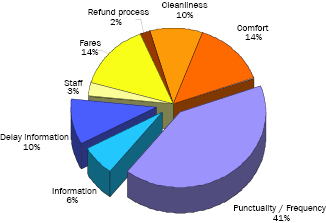
ACIS is the leading UK based provider of integrated information systems in passenger transport applications. ACIS employs over 175 staff and has its principal offices and extensive Research and Development facilities in Cambridge whilst installation and maintenance services are delivered through a network of local depots.
The ultimate ACIS solution is based on extensive experience built over many years and in many systems. Across the United Kingdom, ACIS are currently partnering with all seven Passenger Transport Executives (PTE's), 46 regional and local authorities, 15 regional airports and all the major UK bus operating companies.
The Bridge is the first major regeneration project in Thames Gateway and ACIS has provided the complete RTPI, Control room and traffic management functionality as a turnkey solution to compliment and integrate partner relationships at the development.
Local government guidelines now encourage environmental sustainability by reducing the need to travel and in particular by making the best possible use of existing transport infrastructure, enhanced by intelligent transport solutions. Section 106 agreements between developers and planners are now just as likely to include public transport enhancements as they are to include contributions for improved roads or junctions.
The Bridge is a 264-acre development at Junction 1a of the M25 (Dartford Toll junction) of 1500 homes and future planning for 1.5million sq ft of commercial space, which will bring in 7500 jobs to the area.
ACIS was awarded the telematic partnership tender by Prologis (land owners) in 2001 and started to design the RTPI system specification with other partners. Highways' planning was agreed in 2003 and ACIS received the first order to fulfil The Bridge's innovative transport requirements in 2005.
To improve modal shift at The Bridge development and surrounding areas in support of the new sustainable home development.
The Dartford Toll currently has circa 100,000 vehicles per day pass the bottom of The Bridge and this number is projected to increase to 190,000 by 2016. To add to this number, Dartford Borough currently has population of 86,000 residing in circa 40,000 homes and as one of the Governments key growth zones. Dartford must build a further 20,000 homes by 2025.
Traffic congestion in UK is projected to grow by 26% between 2000 and 2010' and it is stated that the growth in car ownership and traffic levels in the South East region will be above the average figure predicted for the UK. Therefore, the emphasis is based on public transport and towards modal shift is ever increasing along with the delivery of results from ACIS' turnkey solution.
Dartford Borough is the owner of the brown-field site and keen to find partners who would invest in technical transport solutions thus enabling the successful development of the land to meet housing expectations without the use of public funding.
Prologis (international owner and developer of distribution facilities) is the master planner of the site; they lease industrial space to manufacturers, retailers, transportation companies, third-party logistics providers and other enterprises with large-scale distribution needs. The central location of The Bridge being close to the M25 and M20 made it an obvious choice for investment.
Kent Highways Agency required the development to be neutral in terms of traffic impact on Junction 1a M25 and therefore involved in section 106 discussions with Dartford, Kent County and Prologis.
George Wimpey (of Taylor Wimpey UK Ltd) is the chosen home builder of the1,500 houses and flats to be built on the site over the coming years, 150 completions in phase one through December 07 and January 08.
Alfred McAlpine is a leading support services business focused on the built environment such as The Bridge and are contracted for Infrastructure build out at the development.
A Bus Rapid Transit System (BRT) also known as Fastrack, these are high frequency, dedicated bus ways, priority given through traffic signals. Easily extended through the new development sites throughout Kent Thameside, as unlike trams, trains and guided bus ways Fastrack is able to leave the dedicated bus ways to join existing roads where it receives priority.
ANPR provides an accurate mechanism for monitoring vehicle movement, journey times, highlighting delays at junction approach and traffic counting. ANPR is able to monitor and reduce vehicles using developments as 'rat runs' or commuter parking. ACIS ANPR is also used to monitor and manage car parking spaces and by extension can provide accurate records for travel planning rewards for employee reduction in car use at businesses local to The Bridge.
ACIS recommends CCTV on the grounds of enhanced personal security, crime prevention and modal shift. Recent surveys have shown that the more secure a passenger feels the more likely they are to use public transport. CCTV also greatly reduces vandalism and graffiti to street furniture. ACIS has installed CCTV on buses, in shelters and at tactical locations on new developments. Latest technologies allow ACIS to integrate CCTV technology alongside CCTV using the same hardware, delivering this information in real time to a dedicated control station.
As buses travel along their routes they can use TLP to request priority passing through the traffic lights. There are four levels of priority available, which may be varied across a vehicle fleet: time of day, lateness, number of passengers or other such settings as agreed by the Operator and Local Authority. The ACIS system uses an on board transmitter which communicates either directly with the traffic light, or over the radio network to a central control point. By using ACIS' award winning GPS and radio technologies, there is no need to install expensive sensors beneath the road surface, enabling infrastructure and maintenance costs to be minimised, while traffic flow remains undisrupted. ACIS has installed Traffic Light Priority in Belfast, Bristol, Cardiff, Kent, Norfolk, Surrey, West Sussex and York.
'If bus journey times were cut by half through bus priority measures, 26% of car users say They would very likely travel more by bus'
Commission for Integrated Transport
Using ACIS on bus technology, barriers, gates and bollards can be integrated into used to police dedicated bus ways, control and monitor parking facilities at universities.
The House Display is the real innovation that completes the ACIS turnkey solution towards improved modal shift. This is the first RTPI display designed and developed for installation in the home and ACIS is the originator. Every George Wimpey home on The Bridge will have an ACIS House display that is fully interactive to display real-time bus and train information, community updates, weather, news, club, car share and energy monitoring. The displays are now regularly featured in section 106 agreements and travel plans where planning is sought for high density, low trip developments.
The most effective time to change behaviour is at a transition point in someone's life – so if you canget people when they've just moved into a new house it can be habit-forming.'
David Rowe TfL Head of travel demand management
Passengers can now receive accurate real time travel information via the Web by visiting the ACIS Live website or interacting with their House Displays. With Real Time information available at the touch of a button public transport becomes a real alternative for city visitors who have little if any local knowledge.
"Initiatives like this that provide better passenger information can make public transport much easier to use. That is more and more important as we aim to tackle congestion in the West Midlands and do our bit to help the environment."
Councillor Gary Clarke, Chairman of Centro-PTA
ACIS developed and implemented a state of the art control room which brings together the ACIS elements of TLP, barriers and bollards, CCTV, ANPR, Displays and shelters in one visual hub. Site security and management have a complete picture of all areas of transport and passenger waiting shelters across 12 TFT screens, a XX" commercial display and audio communication into every shelter on the Fastrack route. The system installation, project management and ongoing system maintenance is provided by ACIS from a local office based in Kent.
Please find attached submission to the Sustainable Transport Inquiry from the Northern Ireland Sustainable Development Commission. If you need any further information please do not hesitate to contact me. Could you please acknowledge receipt?
All the best,
James
The independent government advisor on sustainable development
James Dillon
Communications and Engagement Manager (Northern Ireland)
Room
Stormont Estate
Belfast BT4 3SR
? tel:
? email:
www.sd-commission.org.uk

1.1. The SDC is the Government's independent advisor on sustainable development, reporting to the Prime Minister, the First Ministers of Scotland and Wales and, in Northern Ireland, the First and Deputy First Minister. Through advocacy, advice, appraisal and capacity-building, we help to place sustainable development at the heart of Government policy.
1.2. The SDC thanks the Committee for its invitation to submit a written response to this inquiry and welcomes the opportunity to contribute to this important initiative. The SDC recognises the need for a modal shift in transport patterns and attitudes in Northern Ireland, as a contributory factor in the move towards a low-carbon society. This will involve fundamental changes in the operation of government and business and in all of our lives as citizens and consumers. The SDC believes that the only consistent, effective and equitable way to meet this challenge is through the framework of sustainable development – applying the six principles of sustainable development agreed in our strategy, First Steps to Sustainability.
Living within environmental limits
Achieving a sustainable economy
Promoting good governance
Using sound science responsibly
Ensuring a strong, healthy and just society
Promoting opportunity and innovation
2.1 Currently transport accounts for 25% of Northern Ireland's greenhouse gas emissions – and this percentage of the total has been increasing rapidly.
2.2 Northern Ireland's per capita greenhouse gas emissions of 12.83 tonnes pre annum lies above the UK average of 10.48 tonnes.
2.3 There is a striking imperative to bring forward targeted policies to counter this growth.
2.4 In Northern Ireland 82% of the total distance travelled is by car, about 7% on public transport, with the rest made up of taxis, walking, motor cycles and so on (Roads Service)
2.5 From 2006-07 to 2007-08 the number of passenger journeys on Ulsterbus rose 1% from 43.4 million to 43.9 million. On Metro services, passenger journeys have increased 8% from 24.1 million to 26.0 million[1]
2.6 During 2007-08 there were 9.5 million rail passenger journeys made, an increase of 12% from 2006-07.[2]
2.7 There were 97,463 air transport movements (landings and takeoffs) during 2007, an increase of 9% on the 2006 figure of 89,822. DRD Annual Transport Statistics 2007-08[3]
2.8 In 2007 the most frequently used method of travel to work in Northern Ireland was car, van or minibus, with 84% of the workforce interviewed in October to December using these methods. This compares to 70% in the United Kingdom as a whole.[4]
2.9 During 2007-08, 806,483 tonnes of petroleum and diesel were delivered for use in Northern Ireland. This is 6% more than the 759,076 tonnes in 2006-07.[5]
2.10 According to the Roads Service 2005-2007 Travel Survey for Northern Ireland:
2.11 Car journeys were, on average, just over seven miles long
2.12 Nearly one fifth (17%) of all journeys were less than one mile long, and just over two thirds of these were on foot (68%).
2.13 The number of people travelling to work by car in Belfast fell from 67% in 2004 - 2006 to 59% by 2007. At the same time, those using the bus rose from 10 to 12% and those walking rose from 16 to 21%.
3.1 A raft of influences determines our travel decisions. These range from emotional attachment to and pride in car ownership, to the practical requirement for safe, comfortable and reliable modes of transport.
3.2 Cost and underlying infrastructure are also important.
Applying sustainable development principles to transport requires:
Fundamentally the SDC advocates a four strand approach to transport:
4.1 Government should aim to reduce demand for motorised transport. Increased demand for 'active travel' (cycling and walking) should be viewed positively. Demand reduction should be achieved through the widest possible application of spatial planning, fiscal interventions, behavioural change and technological measures (e.g. teleconferencing/ICT, working from home, home shopping, travel planning.
4.2 There needs to be a modal shift to more sustainable and space efficient modes – this should focus on two areas in priority order:
i. Shifting away from motorised modes to cycling and walking due to the multitude of benefits this creates (congestion reduction, health and air quality improvements, noise reduction, greater social cohesion). A range of measures including reducing speed limits, restricting motorised transport access and creating high quality, safe and attractive routes for cyclists and pedestrians can be employed.
ii. Shifting from private motor vehicles to public transport. Increasing passenger numbers on existing public transport improves efficiency. Regular public transport users also tend to have higher levels of walking and cycling. This category should include measures to improve inter-modality between different forms of public transport and active travel, i.e. bus/train/cycle.
4.3 Efficiency improvements to existing transport modes are required – this is a broad category covering a range of possible options including: legislation to mandate vehicle efficiency improvements; encouraging higher vehicle occupancy rates; promotion of car clubs; eco-driving; measures to spread demand peaks on public transport; measures to promote more efficient use of existing transport networks.
4.4 Capacity increases for motorised transport – only once the full potential impacts of 1-3 have been appraised, an explicit delivery programme determined, and the full effects of that programme included in assessing the residual role for 4. Any capacity increases that are required should be prioritised to the most efficient modes.
There will always be a demand and a need for access to some form of private transport, but the committee should address the particular overdependence on the car as a mode of transport in Northern Ireland.
5.1 Cars will always be an important part of our transport system
5.2 The problem at the moment is that people feel they don't have a choice other than to own and use cars. Across the UK cars account for:
78% of 2-3 mile trips[6]
80% of all trips of 5 miles or more[7]
58% of our domestic transport emissions[8]
5.3 People want a choice:
45% of people would like to reduce their car use[9]
62% of people would use their car less if public transport were better[10]
87% of people agree that cycling should be encouraged but 74% agree that 'cycling on busy roads frightens me'.[11] Just 2% of all trips are by bike
80% believe the current level of car use has a serious effect on the climate
5.4 DfT's own research further backs this up:[12]
"nearly half of drivers say they would like to drive less than they do"
"Over 90% of people are in favour of action to enable or encourage more walking to improve personal fitness, and a majority (though not so large) also supports encouragement of cycling for this reason."
6.1 SDC wants people to have a choice and it wants people to be able to choose the most sustainable and lowest carbon ways of meeting their transport needs.
6.2 We recommend the following policies:
Firstly we do support the government's initiatives to promote ultra-low carbon vehicles. It is necessary to develop much more efficient vehicles to reduce greenhouse gas emissions and our reliance on oil. However simply substituting much more efficient vehicles into current transport trends is clearly not sustainable.
As outlined previously we advocate a hierarchical approach to transport:
i) Demand reduction
ii) Modal shift to more sustainable modes
iii) Efficiency improvements
iv) Capacity increases only when all the above have been fully applied.
6.3 So Government should:
a) Promote ways to reduce the number of motorised journeys people have to make:
b) Create an environment in which people can choose more sustainable modes when they do travel:
c) Improve the efficiency of existing modes
7.1 The major advantage of cars over public transport is that they enable door to door journeys. The only other form of transport which offers this is the bicycle.
7.2 Cars are best used for transporting several people together, particularly over longer journeys which are too far to cycle or if carrying heavy or bulky loads. An economical car carrying two or more people is a relatively efficient means of transport in terms of energy consumption and CO2 emissions per passenger kilometre.
7.3 Of course there are many other impacts associated with car use - deaths and serious injuries on the roads, noise, air and water pollution[13], and the effects of traffic on communities and children.
7.4 The most inefficient use of cars is for individuals making shorter journeys, yet these account for the vast majority of car journeys. Fuel consumption is up to twice as high on short journeys and single occupancy cars are very space inefficient, creating urban congestion.
7.5 Whilst technological advances such as electric cars will help decrease fuel consumption and reduce overall emissions, we must point out that they will not combat other difficulties such as congestion in built up areas, health problems associated with obesity, and increased risk of traffic accidents. However the SDC believes that the Committee should look at the wider role of electric transport as part of an integrated solution – the benefits that it could provide are clear.
7.6 Park & Ride systems offering free parking and aimed primarily at car users are likely to encourage short, single occupancy journeys. They fail to take advantage of the car's ability to make door to door journeys. In addition, if they attract large numbers of people, they need large car parking areas.
When Park & Ride systems are introduced, it is essential that they do not simply lead to an increase in overall parking provision otherwise they are likely to increase overall car use. There should be a simultaneous reduction in city centre car parking in line with the overall ambition to reduce car use.
7.7 SDC believes transport policy should aim to:
1) integrate public transport primarily with walking and cycling rather than cars
2) focus on reducing single occupancy car use
7.8 Various other options designed to lower car ownership and usage should be explored. Examples would include:
i. Car leasing and car clubs which would be attractive to city dwellers who want to avoid the hassle and worry of car ownership.
ii. City Centre residential developments could have a small on site car pool included in the purchase price – residents could then book a pool car as and when required. This would not only reduce car ownership but also reduce congestion in the city centre.
iii. Employers could promote 'Green Commuting' policies and provide incentives for staff to explore transport options other than the car. For example, In Kent, pharmaceutical company Pfizer is paying its employees £2 a day not to drive to work, while here Bombardier is facilitating tax friendly schemes for employees to purchase bicycles. Similar pilot schemes are being developed within the Northern Ireland Civil Service. Insurance company Unum Provident offers incentives (such as time off) to employees who walk or cycle to work.
iv. These are not only positive developments from an environmental or health perspective – green travel policies are also often cheaper than providing car parks, and far cheaper than building new roads.
v. There is also an opportunity for the public sector in Northern Ireland to take a lead role in reducing private transport. Government departments and local council buildings, particularly in our larger towns and cities, should address the reality that providing large staff car parks in built up urban areas only encourages staff to use them. By cutting down on this available space and providing incentives to staff not to drive to work, as outlined above, positive behaviour change can be achieved.
vi. On a wider scale the committee should also note that there is a large amount of relatively cheap and available car parking spaces in our towns and cities. This does not promote a shift to more sustainable modes of transport. Of course, ensuring that a fully integrated public transport system is able to step in and replace the car is another challenge.
vii. Nottingham City Council are the latest authority to consider the introduction of a Workplace Parking Levy for large businesses in the city centre – all the money raised by the levy would go into improving public transport and managing congestion problems.
8.1 A fully integrated public transport system is key to a sustainable transport system. It must cater for dispersed rural communities as much as it does for urban dwellers.
8.2 Enhanced public transport provision and other non-car measures must be targeted at disadvantaged areas first.
8.3 A reliable and easy to access system must be the goal – making best use of new technology to help public transport users. For example, Intermodal journey planners allow travellers to plan their journey across more than one mode of transport. Advanced systems incorporate real-time information into their computations, capturing incidents as they happen.
8.4 The SDC would recommend that the committee look in to examples of best practice in city transportation systems, such as Freiburg in Germany and Curitiba in Brazil. Indeed the most successful urban transport initiatives remodel the infrastructure to make travel fast and convenient, effectively creating demand for public transport use in the same way that the infrastructure of traditional cities create demand for private motor vehicles. For example, continuous priority lanes should be created on all strategic corridors into major urban areas.
9.1 The SDC believes that carbon and health impacts should be considered in all transport decisions. Ultimately it must be recognised that a truly sustainable transport system is by definition one which only uses the earth's resources at a speed at which they can be replenished. In comparison to today, this will inevitably require that we all travel less far and less fast. Walking and cycling will need to become the normal modes of transport for short journeys.
9.2 Simply put, we also need to pedestrianise more of our urban areas and reduce car parking to make people, not cars, the prime consideration in urban areas. The introduction of dedicated cycle lanes, physically separated from motor traffic should be promoted when and where possible. Many people are wary of using cycle lanes at the side of busy urban roads as they simply do not feel safe, particularly during rush hour.
9.3 Of course government should promote the associated short and long term health benefits of this transport shift, considering active and public transport as a public health enabler. Government should also consider introducing 20mph speed limits in residential areas and around schools, thus helping to lower the number of fatal collisions and helping communities to engage with local transport solutions.
9.4 We also believe that the committee should look into the prospect of developing a number of 'sustainable travel towns' in Northern Ireland, were best practice models can be put in place and were behaviour change in travel patterns can be studied and the benefits promoted. Pilot projects in other regions have proven to be very successful, for example, Darlington, Peterborough, and Worcester.
10.1 While air transport will continue to be part of our future transport networks we must use other technological advances to cut out the need for unnecessary air travel. We must also ensure that air and sea travel are included in future emissions budgets as part of a dedicated overall Northern Ireland budget. Cutting down on emissions does not need to mean cutting down on economic outputs but it will help the Government and business to think carefully about the best ways of pursuing economic growth in Northern Ireland. The Committee should also consider if the public transport options available to people travelling to and from our major airports are sufficient.
10.2 Government should also use aviation taxation revenues to improve active and public transport system.
This submission can only introduce some limited aspects of the wide number of issues embraced by the extensive terms of reference for this important Inquiry. SDC will be pleased to expand on these comments with an oral presentation, if the Committee would find that helpful.
Sustainable Development Commission
Northern Ireland
September 2009
[1] DRD Annual Transport Statistics 2007-08
[2] DRD Annual Transport Statistics 2007-08
[3] DRD Annual Transport Statistics 2007-08
[4] DRD Annual Transport Statistics 2007-08
[5] DRD Annual Transport Statistics 2007-08
[6] The Car in British Society – RAC Foundation, April 2009
[7] The Car in British Society – RAC Foundation, April 2009
[8] Low Carbon Transport – A Greener Future, Department for Transport, July 2009
[9] 2007 Survey of "Public Attitudes and Behaviours Towards the Environment" for Defra
[10] RAC Report on Motoring 2008
[11] CTC Safety in Numbers Campaign May 2009
[12] Glen Lyons et al, June 2008, Public attitudes to transport: Knowledge review of existing evidence http://www.dft.gov.uk/pgr/scienceresearch/social/evidence.pdf
[13] Environment Agency - Underground, Under Threat
Dear Sir/Madam,
As co-ordinator of Belfast Friends of the Earth I would like to draw your attention to the Belfast Cycle City report published July 2009.
The report was authored by Friends of the Earth with input from Sustrans and the Northern Ireland Cycle Initiative.
The Belfast Cycle City vision is that Belfast will become of one of the top ten cycling cities in the UK by 2020.
The report identifies the many positive benefits of cycling, and identifies best practice from the UK and Ireland and wider EU that should be implemented in Belfast -
1. target 10% of all journeys to be made by bike by 2020
2. support an increase in annual DRD spending on cycling to £15 per person , in line with the top performing English cities.
3. creation of a detailed cycle strategy from 2010 to 2020.
I would like the opportunity to present the report and its recommendations to the inquiry into sustainable transport.
www.belfastcyclecity.org.uk
Regards,
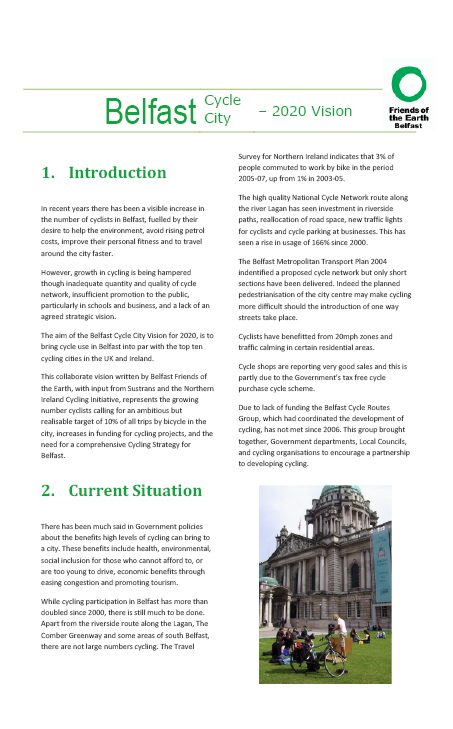
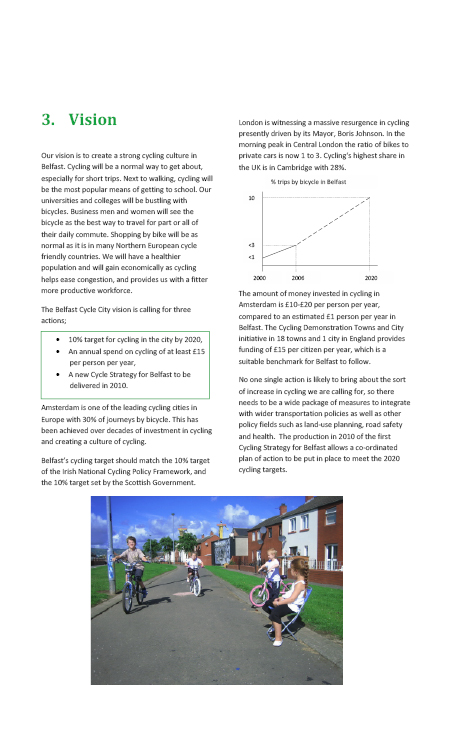
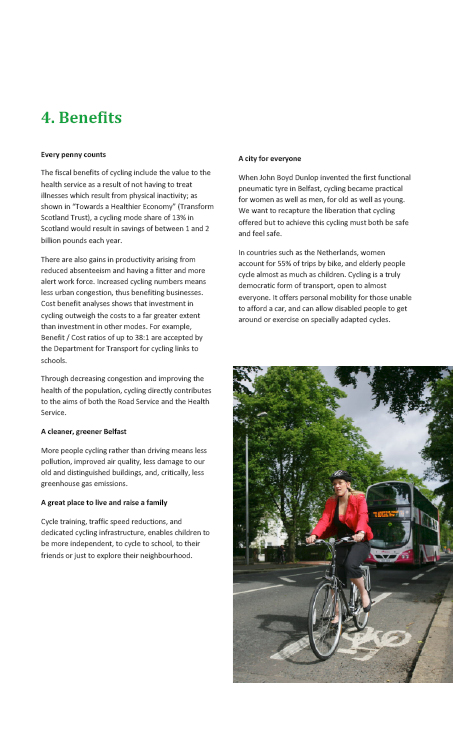
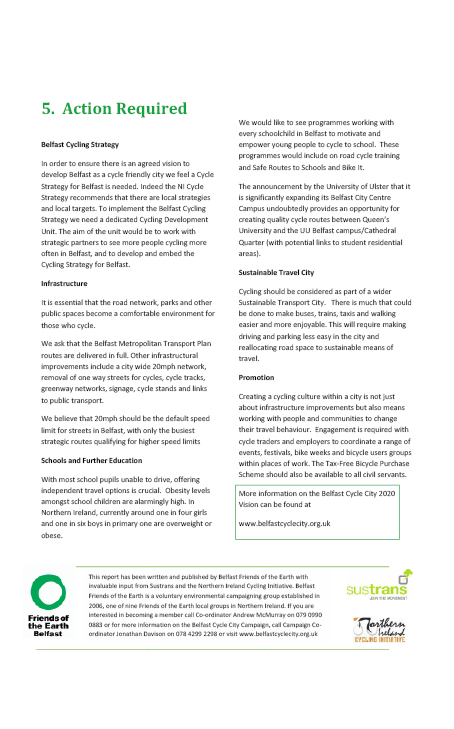
ADDRESS:
EMAIL ADDRESS:
COMMENTS: On behalf of the Belfast Metropolitan Residents Group I would like to make an oral submission covering the following points:-
1 There is need to change the mind-set of government departments, developers and planners towards sustainable transport.
2 The design of new developments must allow for (a) adequate cycle access and storage and (b) recharge points for pivate and public electric vehicles.
3 New developments must be served by public tansport from the start of construction even if this means the introduction of some sort of subsidy (which can be tapered. Roads must be constructed facilitate public transport.
4 New forms of public trasport should be investigated e.g. overhead monorails over dual carriageway median strips.
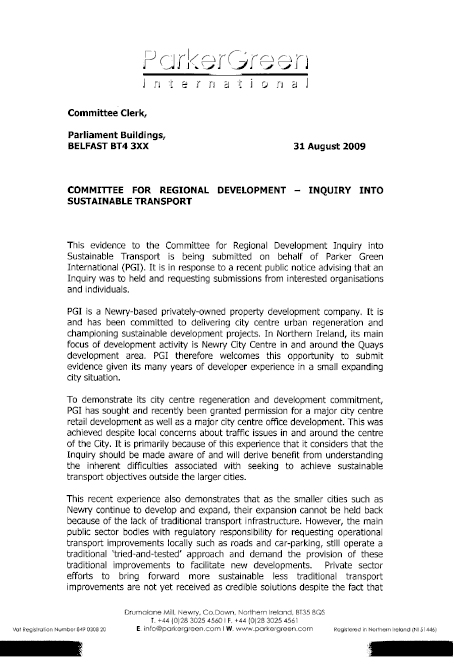

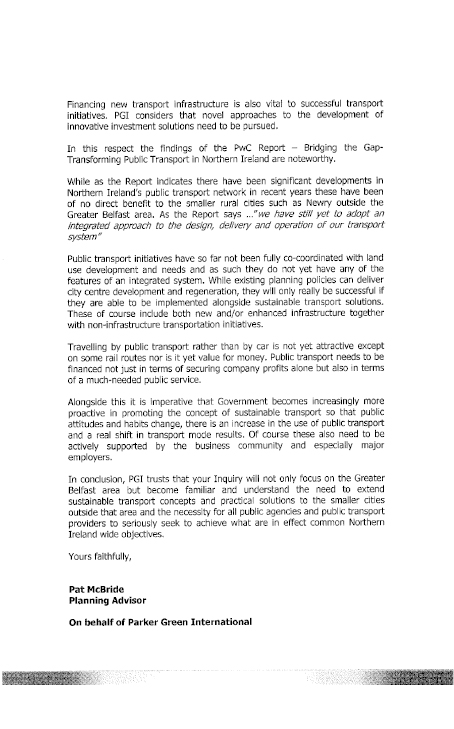
Prof JP Hine - Evidence to Sustainable Transport Inquiry
Professor Julian Hine
Professor of Transport
Built Environment Research Institute
University of Ulster
Jordanstown Campus
BT37 0QB
26th August 2009
Committee Clerk
Regional Development Committee
Parliament Buildings
Stormont, Belfast, BT4 3XX
Dear
Please find enclosed a submission that I would I like to be considered as part of this inquiry. This submission raises a number of issues in relation to how a sustainable development strategy can be achieved and also what the current problems are in relation to the development and achievement of a strategy for sustainable transport in Northern Ireland. These issues have been grouped around a number of key headings that relate to the Committee's terms of reference for this inquiry.
Yours sincerely,
Professor Transport
University of Ulster
Built Environment Research Institute
*Enc
Transport infrastructure is important for the development of regional economies but at the same time transport choices and strategy can have a significant impact on the environment, society, health and lifestyle. Importantly, it is also central to debates about how to create livable environments in our towns and cities. The current reviews of the Regional Transport and (RTS) Development Strategies (RDS) offer an opportunity for the development of a modern and sustainable transport system. This means that future strategy and investment decisions must be 'future proof'. It is widely acknowledged that the current policy framework as specified in the RTS and RDS has achieved significant new investment in transport infrastructure which has addressed decades of underinvestment. Although the RTS and RDS aimed to achieve mode shift from the private car to public transport, cycling and walking, it is quite clear that this has not been achieved, despite rising numbers of passenger journeys on the rail and bus system. In addition the land use planning system has allowed the proliferation of development outside existing settlements. These are often locations that cannot be served by an adequate public transport system.
The emphasis in funding within the strategy has been on roads and this bias is likely to continue unless checked. The Programme for Government and Investment Strategy published in 2008, commits the region to continuing high levels of investment in roads. Currently funding is estimated for the period 2008/09 to 2017/18 to be at £2,645 million for roads and for the same period at £725 million for public transport. Clearly highway improvements can make environmental improvements including improvements to air quality and also journey time savings yet these patterns of investment reinforce existing patterns of travel and reliance on the car. It is widely accepted that investment in new roads generates new traffic and can, in the medium to longer term, undermine the investment that has been made as a result of rising traffic levels and congestion. In general terms, the emphasis in terms of road investment must increasingly be about management of existing capacity rather than the creation of new. This is especially important given Northern Ireland's poor greenhouse gas emissions performance compared to the rest of the UK. A recent report by Northern Ireland Environment Link has highlighted the divergence in emissions data when Northern Ireland is compared with the rest of the UK. Northern Ireland's per capita greenhouse gas (GHG) emissions of 12.83 tonnes per annum compares badly with the UK average of 10.48 tonnes. This difference is principally due to transport, while domestic transport emissions in the UK increased by 9% over the period 1990 to 2006, in Northern Ireland the increase for the corresponding period was 51% (NIEL, 2009).
Conventional transport planning has emphasised speed and capacity that has been to the detriment of slower green modes and public transport. It has also underestimated the environmental and wider societal costs associated with the current range of transport choices and patterns of provision. This conventional approach to transport planning has produced car dependent communities which in turn have produced patterns of disadvantage especially amongst those on low incomes, women, the elderly and disabled. These user groups have been shown to experience lower levels of car access, and as a result experience poorer levels of access to a variety of goods and services (Hine and Mitchell, 2003). These patterns are especially pronounced in rural areas and outer metropolitan/urban areas. Increased public transport use can conversely reduce the need for expensive road infrastructure, reduce greenhouse gas emissions and urban air and noise pollution.
Evidence from the Travel Survey for Northern Ireland shows clearly the need for change. Over the period 2002-2007 aggregate data suggests that miles travelled by car have changed little and that car ownership and licensing holding have changed little. On the face of it, it also suggests that the share of journeys per person per mode have also not changed to any great degree (DRD, 2008). Data published from the Travel Survey however does not disaggregate this data by trip purpose and mode so unless special tabulations of the data are requested, then it is not clear what proportion of miles travelled by car are accounted for by commuting and other more optional types of activity. This type of information would be important if any new strategies being developed embraced the idea of reducing vehicle miles travelled (VMT) through the use of targets as it may be easier to target and achieve mode shift for these more optional types of journeys than commuting trips. The role of VMT targets are discussed later in this submission.
There is clear evidence that the numbers of bus and rail passengers have increased over the period 2002-2009 as a result of the investment and funding that has been made available under the RTS. It is not clear however how much of this expansion in passengers is based on car users shifting to public transport. This suggests that increased public transport use may be due to its ability to attract trips made by those with travel concessions (for example older people, school children), new users who previously did not use public transport at all, but may also reflect the ability of public transport to attract new users who do not drive or own cars, and the introduction of the rebranded Metro network. Evidence regarding the attraction of car users to public transport is limited or non existent in the Northern Ireland context. It also clearly demonstrates the need for a step change in policy. If public transport is to attract more car-borne trips and if mode shift is seen as a serious policy objective then it is clear that policy needs to adopt a different framework to the management of transport demand particularly in urban areas.
Given the dominance of the car in the commuting market and the expansion of travel to work areas in Northern Ireland, significant changes will be required to achieve changes in mode share for other modes. Studies suggest that car users are more responsive to pull factors that would attract them to public transport. These pull factors not only relate to lower fares but also other types of service improvements such as travel information and regular departure times. For shorter trips of under 5 miles made by car users, evidence suggests that it is not only these factors that are influential but also security and improved cycling and walking infrastructure (Mackett, 2001). However, to obtain a reduction in car use would not only require a significant investment in public transport but also the introduction of other measures such as high parking charges (Wardman, Hine and Stradling, 2001; TRL, 2004). Evidence from international reviews of elasticity studies also suggest that fuel price rises and reductions in income will also have a large effect. Nonetheless, changes in the demand for public transport with regard to fares result in significant changes in demand (TRL, 2004; Goodwin et al, 2004; Litman, 2009a) (see for example Table 1), although it is clear that the effect is widely variable depending on journey type. Commuting trips by car owners for example have a high value attached to them so estimates of changes in behaviour will be larger than for other trip types. Another consideration in assessing the relevance of these types of measures is the geographical setting, and other time-space factors which will influence the degree of response to changes in price.
| Factor | Elasticity |
|---|---|
| Overall transit fares | -0.33 to –0.22 |
| Riders under 16 years old | -0.32 |
| Riders aged 17-64 | -0.22 |
| Riders over 64 years old | -0.14 |
| People earning <$5,000 | -0.19 |
| People earning >$15,000 | -0.28 |
| People without a car | -0.10 |
| Car owners | -0.41 |
| Work trips | -0.10 to –0.19 |
| Shopping trips | -0.32 to –0.49 |
| Off-peak trips | -0.11 to –0.84 |
| Peak trips | -0.04 to –0.32 |
| Trips < 1 mile | -0.55 |
| Trips > 3 miles | -0.29 |
In rural areas, undeniably the car plays an important role in enabling access to goods, services, and schools yet there are still opportunities for reducing the reliance on the car and reducing miles travelled by car. The growth of the rural population in Northern Ireland has also created higher traffic levels on rural roads. The reduction of car travel in rural areas will necessitate the development of policy approaches that provide more travel choices including greater co-ordination of rural transport bus operations with community transport operations and educational transport provision than exists at the present time. More investment in safer routes for cycling and walking is required. Evidence from safer routes projects suggests that the mode share of walking and cycling can be expanded where physical improvements are made (e.g. cycling lanes, space re-allocation). Economic appraisal of local walking and cycling schemes has shown that significant benefits (principally health benefits) can be achieved by investing in these types of schemes. Benefit to cost ratios have been shown to be significantly higher than for roads and public transport schemes at 20:1 for investment in walking and cycling compared to 3:1 that can be found for roads and public transport schemes (SUSTRANS, no date).
In Belfast and other urban areas in Northern Ireland car use is at high levels. Larger settlements are clearly where greater opportunities exist to provide improved public transport operations, introduce traffic restraint and management measures. Evidence from successive population censuses 1971 to 2001 have shown an expansion in the share of work trips made by car into Belfast of 27% and a 23% reduction in those made by public transport. Private Non-Residential (PNR) parking has also expanded by 55% over the period 1975 to 2001 (NIEL, 2009). Significant changes in public policy are required to reduce levels of car dependence. There is a growing evidence base for the implementation of demand management measures. In many cases, these have consisted of packages of policy measures. In Northern Ireland it is also clear that future land use planning decisions need to be focused on increasing density and focusing development in existing urban areas and also reducing average journey lengths. Evidence from the Travel Survey for Northern Ireland indicates that 234 journeys per person per year are made by car for journeys of between less than 5 miles. This represents around 54% of all car trips. It is precisely this range of trips distances in urban areas that can be targetted by public transport, walking and cycling initiatives.
In many other cities, both medium sized and world cities, demand management policies have been implemented with some success. While in many cities public transport investment has lagged behind and as a result car ownership and use have increased. There are now numerous examples of policies aimed at improving travel choice and reducing car use. Invariably these include a mixture of 'carrots' (public transport improvements, park and ride and improvements to pedestrian and cycling networks), and 'sticks' (parking policy, reallocation of road space and controls on vehicle access). Nottingham (-1.8%), Perth (Australia) (-4%) and Rome (-7%) are examples of cities where car mode share has been reduced. Each of these cities has implemented traffic restraint policies, new public transport investment and service enhancements. Policies have also included the implementation of policy aimed at reducing urban sprawl, transit orientated development including the focusing of new development around suburban stations, and higher densities. Perth has also implemented a work place parking levy whilst Nottingham and Rome have implemented travel plans. In addition Rome has reduced city parking and reallocated these spaces at park and ride sites in combination with access controls Commission for Integrated Transport, 2005a; 2005b; NIEL, 2009).
If we look at world cities a number of these have also managed to reduce car mode share: London, New York, Paris, and Barcelona. This reduction in car dependency has been achieved through a package of policy measures. As with the smaller city examples, these strategies have included investment in public transport and integrated ticketing, removal of car parking and the reallocation of road space in favour of greener modes. These transport policies have also benefitted from city centres with relatively high land use densities, a mix of people and jobs and high quality pedestrian facilities.
Transport strategy in Northern Ireland would benefit from the introduction of clear mode shift targets and/or vehicle miles travelled reduction targets. Indeed these targets should be seen as a key way in which sustainable transport strategy can be monitored in terms of any impact on transport choices. There is a strong case for the introduction of VMT reduction targets and/or mode share targets in Northern Ireland. VMT targets should be seen as central to the development of a sustainable transport strategy because they force a shift from car dependent transport systems towards transport systems that are multi-modal. It can be argued that these can be justified on the following grounds, that they:
In the US there are several examples of these targets now in use in California, Washington State and Yolo County.
The adoption of mode shift targets that are realistic and reflect current transport needs and the range of trips and trip patterns present in a region that with the exception of several larger settlements and cities is predominantly rural in nature and has lower population densities should be seen as an important way in which the effect of policy intervention can be assessed and evaluated. Data from the Northern Ireland Travel Survey (DRD, 2008) indicates that 4,739 miles per person per year were travelled by car in 2007. If a target to reduce the number of motorised trips by car was introduced say a 5% reduction per annum, this would result in significant reductions. In year 1 this could result in a reduction of 237 miles per person at best or at worst would slow down the growth in car trips. This reduction could be achieved through the introduction of a package demand management measures (not necessarily road pricing) and improved public transport for example. This reduction could also be partially achieved by the adoption of flexible work practices which are now easier for business to operate with ICT access.
In order to develop a clear sustainable transport policy there are a number of improvements that can be made. Transport policy is clearly currently at the cross-roads in terms of the need to now achieve reductions in carbon emissions and achieve lasting changes in travel behaviour balanced against a requirement to maintain existing infrastructure for the purposes of trade and the economy. Associated with these developments is clearly the ongoing need to continue to reduce the fossil carbon content of transport fuel and increase the fuel efficiency of vehicles, but we also need to reinvent transport policy with new objectives in mind. Using the Spatial Development Strategy Framework outlined in the RDS can an annual 5% reduction in motorised trips by car be achieved? Possibly, it does not necessarily mean reductions in levels of our personal mobility but a change in the way we behave and make our travel choices. However to ensure that some steps are taken in this direction we need to urgently address the following issues:
1. adopt mode shift targets/vehicle miles travelled reduction targets – aimed at reducing the % carborne trips.
2. integrate land use and transport (increase urban population densities and reduce job density).
3. focus development around public transport nodes
4. reduce car parking in city centres and introduce other demand management measures as necessary.
5. encourage walking and cycling and the development of high quality networks for these modes.
6. Strengthen public transport in rural and urban areas - increase public transport speeds and reliability, and lower fares.
This submission represents the views of the author and the opinions expressed in it do not necessarily reflect the views of the University of Ulster.
Commission for Integrated Transport (2005a), World Cities Research – Final Report, London.
Commission for Integrated Transport (2005b), World Cities Research – Research on Comparable Medium Sized Cities Final Report, London.
DRD (2008), Travel Survey for Northern Ireland 2005-2007, DRD Road Service, Belfast.
David Gillen (1994), "Peak Pricing Strategies in Transportation, Utilities, and Telecommunications: Lessons for Road Pricing," Curbing Gridlock, TRB, pp. 115-151.
Goodwin, G., Dargay, J. and Hanly, M. (2004), "Elasticities of Road Traffic and Fuel Consumption With Respect to Price and Income: A Review," Transport Reviews, Vol. 24, No. 3, May 2004, pp. 275-292.
Hine, J.P. and Mitchell, F. (2003), Transport Disadvantage and Social Exclusion: Exclusionary Mechanisms in Transport in Urban Scotland, Transport and Society Series, Ashgate Publishing Limited, Aldershot (ISBN 07546 18471)
Litman, T. (2009a), Transportation Elasticities – How Prices and Other Factors Affect Travel Behaviour, Victoria Transport Policy Institute.
Litman, T. (2009b), Are Vehicle Travel Reduction Targets Justified? Victoria Transport Policy Institute.
Mackett, R. (2001), "Polices to Attract Drivers Out of Their Cars For Short Trips"
Transport Policy, Vol. 8, No. 4, pp. 295-306.
NIEL (Northern Ireland Environment Link) (2009), Sustainable Transport Report, June.
SUSTRANS (no date), Economic Appraisal of Walking and Cycling Routes, Available here
TRL (2004), Demand for Public Transport: A Practical Guide, TRL Report 593, Transport Research Laboratory.
Wardman, M., Hine, J. and Stradling, S. (2001) Interchange and Travel Choice, Volumes 1 & 2, Scottish Executive.

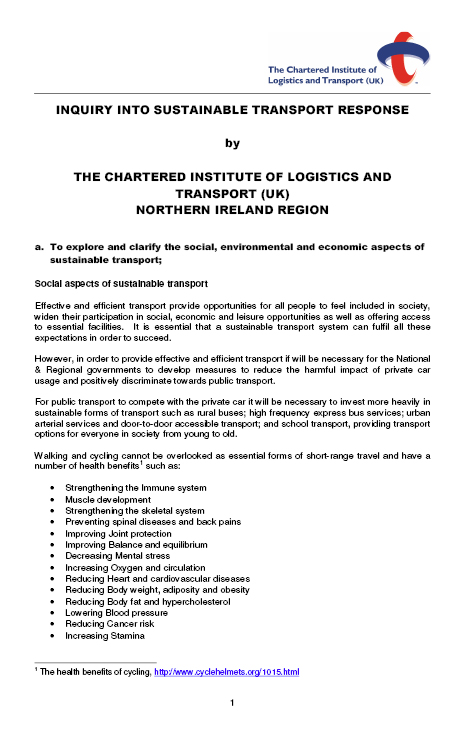
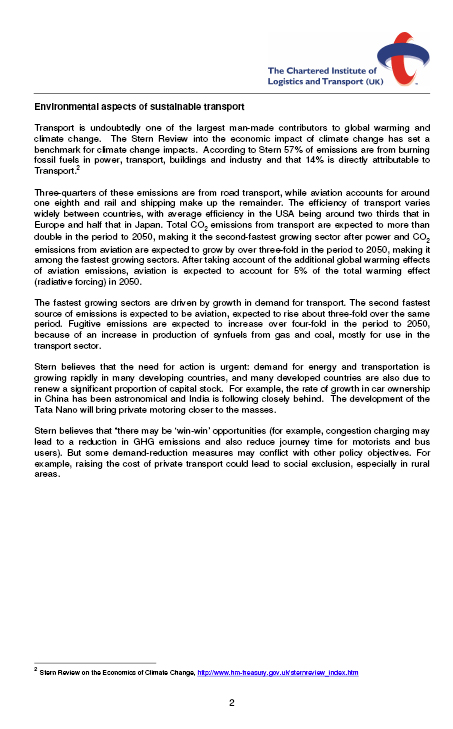




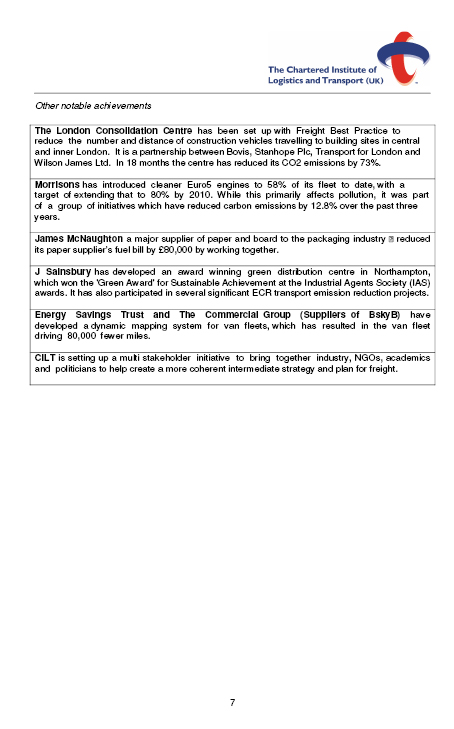

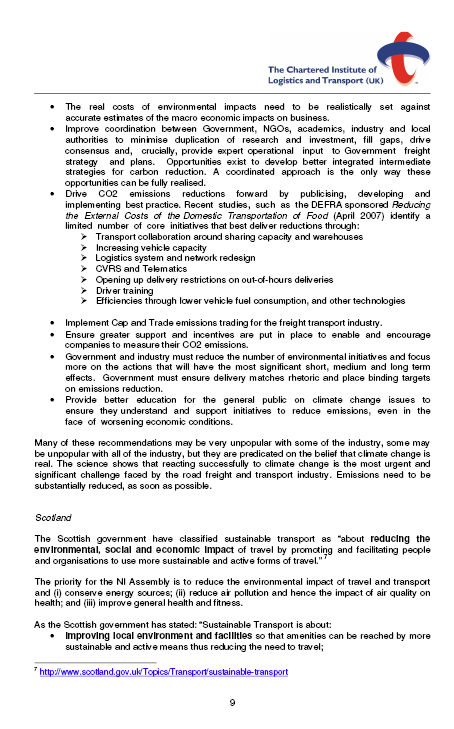

Mr. Mark Nodder
Group Managing Director
The Wright Group
Wrightbus was established in 1946 and is the only major bus manufacturer on the island of Ireland. It is the second largest bus manufacturer in the UK. Having pioneered low floor buses, Wrightbus has continued to innovate and is a market leader in both BRT (Bus Rapid Transit) and hybrid buses. Current production is approximately 900 vehicles per annum and while the majority are destined for the UK and Ireland there are customers as far afield as Hong Kong, Singapore and Las Vegas.
The Wright Group welcomes the decision by the Committee for Regional Development to hold an Inquiry into Sustainable Transport.
The Committee has created a rare opportunity to focus on visions, principles and future direction. We are delighted to be in a position to make a contribution and have focused our attention on those areas where Wrights can offer specialised knowledge and expertise – chiefly buses, Bus Rapid Transit (BRT) and hybrid vehicles.
Committee Terms of Reference
a. To explore and clarify the social, environmental and economic aspects of sustainable transport.
b. To identify the policies, attitudes and technologies likely to underpin a move to a more sustainable transport in Northern Ireland.
c. To make recommendations arising out of the above investigation, and report to the Assembly.
There are many definitions of sustainable transport and two have been selected for inclusion in this paper. A rigorous definition has come from the European Union Council of Ministers of Transport, who defined a sustainable transport system as one that:
A rather more populist definition derives from the Brundtland Report from the World Commission on Environment Development:-
Whatever the preferred definition, it is clear that current transport trends cannot continue without adverse long term consequences.
Growth in all forms of transport has been very substantial in recent years. There are many reasons. As an increasingly affluent society we value greater personal mobility and there is more opportunity for both local and global leisure travel than ever before. As we live longer we enjoy travelling more, as evidenced by the popularity of the "bus pass".
Greater mobility provides improved access to jobs, education, shops and other services. That transport is still relatively affordable means people are often prepared to travel further to access these facilities or to exercise choice.
Many changes in the way we live have also contributed to the increase in personal travel. In recent decades we have witnessed the decline of the traditional family home, and the growth in the proportion of people going out to work. Many former residents of the inner city have decamped to the suburbs almost invariably generating extra travel. Major suburbs have become car owning communities whereas previously when living in the city the same people would have been able to walk to work etc.
While the ability to travel is generally recognised as a good thing, there are downsides. Most notably the deaths and personal injuries on our roads. In this context advocates for public transport will point out the very much greater safety record of all forms of public transport as compared with the private car. You are ten times more likely to be involved in an accident travelling by car than by public transport.
All types of transport, to a greater or lesser degree, create pollution which can be injurious to health. Air pollution from harmful vehicle emissions is widely recognised as contributing to respiratory and cardiovascular disease. Some pollutants are recognised carcinogens. Less well recognised is the effect of noise with the steady increase in ambient sound levels going far beyond causing annoyance and leading to disturbed sleep, hearing impairment and hypertension.
The World Health Organisation has recognised that good health is more than the absence of physical health burdens. It has highlighted the importance of social interaction to human wellbeing and clearly transport can facilitate wider social interaction. However there are many in society for whom the greater mobility conferred by private car is simply not available. That includes the young, many elderly persons and those who do not drive either for health reasons or issues of affordability. For them a good public transport alternative becomes a necessity rather than an option. Good public transport helps bring people together, providing better social inclusion regardless of class or wealth.
One of two widely acknowledged environmental concerns is the excessive use of finite resources, chiefly petroleum. Some 95% of transport energy comes from this source. In global terms the use of alternatives such as gas, biofuels and electric vehicles remains minimal.
Biofuels, once regarded as a hope for the future are now regarded with much more caution. Their growth risks displacing agriculture which could lead to food shortages and/or further deforestation with consequent loss of biodiversity and eco systems.
Apart from use as a fuel, energy is also used in the manufacture of vehicles and is embodied in transport infrastructure such as roads and bridges etc.
Around the world the energy demand for transport has increased fivefold since the 1950s Overall, transport systems are said to account for nearly 25% of the world's energy consumption and this figure rises to 30% in the EU. Transport accounts for 19% of all greenhouse gas emissions in the world, and 74% of all emissions from transport are from road transport.
The second well publicised concern, if not universally acknowledged, is the environmental impact of global warming and climate change which derives from vehicle emissions. Greenhouse gas emissions from transport are rising faster than from any other sector.
Other "green" concerns include the preservation of wildlife habitats, and the hydrological impacts of new road developments and increasing water run-off from more extensive hard surfaces.
The inexorable rise in car ownership is matched only by the increase in the number of lorries on the road. All these lead to traffic congestion which imposes economic costs by wasting peoples time, incurring extra vehicle costs and slowing the delivery of goods and services. The direct cost of congestion is estimated at 2% of GDP.
Urban space is a precious commodity and public transport uses it more efficiently than a car dominant society. Public transport alleviates congestion and can help make our towns and cities more pleasant places to live and work.
In addition to personal transport there are two other major trends influencing the growth in transportation.
First there is the importing by developed countries of finished goods produced in low cost countries. Even when local manufacturing has been retained, manufacturers often source materials, components, sub-assemblies etc on a global basis to reduce overall manufacturing costs.
Secondly, there is the increasing sophisticated palate of a more affluent society. Food, which used to be substantially homegrown, is now imported from all corners of the globe at all seasons of the year. Because the cost of production is usually lower, the addition of transport costs does not make it unaffordable. Similarly, consumption of wine from neighbouring countries such as France and Germany is being rapidly overtaken by the consumption of wines from "New World" countries.
These trends show no sign of diminishing.
There is an important economic argument on the public transport versus car debate which is often overlooked. Improving public transport creates local employment. There are no car factories in Northern Ireland. However, the Wrightbus factory in Ballymena employs some 900 people directly, and many more indirectly.
In summary, Transport makes a very positive contribution to society in many different ways.
The increase in both personal transport, and commercial transport over longer distances, looks set to continue.
Steps can be taken to alleviate some of the adverse consequences of transport, e.g. promotion of road safety, noise reduction measures, air pollution controls etc. However, the over-riding fact is that as things are at present, the continuing growth in transport is not sustainable in the long term. More specifically, we continue to exhaust finite resources and exacerbate global warming.
Clearly, although there has been some progress, current trends still point away from sustainability.
It must be recognised from the outset that old policies to "predict and provide" offer no solution to the current dilemma. Nevertheless, there is difficulty introducing new policies which are seen as limiting freedoms or using a pricing mechanism (aka stealth taxes). Witness the very strong public rejection of congestion charging in Edinburgh and Manchester, despite the general view that it was a success in London. Most politicians want to get re-elected and are naturally very sensitive to what will or will not be acceptable to the general public.
The increase in personal mobility has more than offset the improved fuel performance of the private car. Yet personal mobility is something we all treasure and will not lightly give up. Pricing could have some effect, but the swingeing increases that would be necessary may be as politically unacceptable as they would be socially divisive.
The most realistic opportunity to reduce emissions from cars is to offer a very attractive public transport system as an alternative. To be successful this needs to be high quality and affordable. On average public transport consumes 3.4 times less energy per passenger kilometre than cars, and this ratio is even more favourable in the rush hour
Policies in Northern Ireland should be supportive of public transport systems to make to make them an affordable and attractive alternative to the private car. For example, land use planning can increase urban population densities so that it becomes more economic to provide good public transport. Conversely the containment of urban sprawl will reduce the need for car transport.
Adequate funding is essential for good public transport. In ridership terms the government has seen a good return on its investment in new trains, and the new buses on the Metro services. More investment is overdue for the rural bus network. From time to time the level of funding for public transport in Northern Ireland should be benchmarked with the UK, Ireland and the rest of Europe
Public transport will not be the ideal solution for every individual for every journey, but it could curtail the steady increase in the number of two and three car families.
Many people have based their lifestyle around the private car and this will not be easily changed. However there is a new generation which is very aware of the depletion of the ozone layer and global warming, with its potentially disastrous consequences for much of our planet.
Many of these people are for the first time open to changing the habits of a lifetime.
In the developing and enhancing a public transport network Quality Bus Corridors (QBC), Bus Rapid Transit (BRT), trolleybus, hybrid buses, light rail and heavy rail should all be viewed as possible contenders.
The public transport network should be planned using a system-based approach (treatment of the passengers' whole journey). Passenger demand, system objectives and funding should inform the decision making process.
Where passenger demand is lower than necessary to justify light rail, Bus Rapid Transit systems are particularly worthy of consideration for moving large numbers of people. These can be supported by high quality bus networks feeding the core network.
BRT is a rubber tyred transit service that can provide passengers with a comparable journey experience to Light Rail provided it is afforded similar segregation from traffic, high quality infrastructure and customer focussed delivery.
BRT vehicles have the additional advantage that they are not confined to rails. After enjoying segregation from traffic in town/city centres they can continue on ordinary roads.

The study in Belfast by KPMG and Atkins compared the cost of Light Rail and BRT schemes, summarised as follows :
| Capital cost £m | Annual Operating Costs £m | |
|---|---|---|
| Bus Rapid Transport | 147 |
1.44 |
| Light Rail | 590 |
6.78 |
The result of this study has important implications for other cities.
Following the success of LUAS in Dublin, other cities will want to upgrade their public transport network. For cities such as Lisburn, Newry and Londonderry Bus Rapid Transit can provide an attractive and more affordable alternative.
The two solutions, BRT and Light Rail are not mutually exclusive. If route patronage develops strongly with BRT, conversion to light rail is possible at a later date.
Bus Rapid Transit is now a globally recognised transportation mode with successful projects operating Latin America, North America, Europe and Africa.
BRT, in various forms and to varying degrees, has been proven to both reduce congestion through modal shift and aid regeneration.
Cost of a BRT system is about 25% of a corresponding LRT system although this can vary according to location.
BRT allows nurture and expansion of schemes. Because of the flexibility of rubber wheeled vehicles, schemes can be introduced and readily expanded in phases.
| Physical and Abstract measures | |
| Physical | Abstract |
| * Vehicles | * Image |
| * Infrastructure | * Presence |
| * Priorities | * Step change |
| Introduce and Enforce |
| * Bus priority |
| * Segregation |
| * Traffic light priority |
| * Bus stop clearways |
| Overt and Covert implementation | |
| Overt | Covert |
| * Busways | * Automatic Vehicle Location |
| * Guidance | * Queue relocation |
| * Lanes | * Street parking restrictions |
| * Gates | |
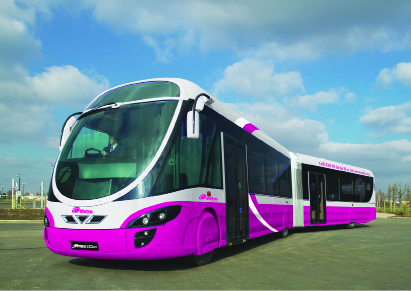
While a conventional city bus relies on a large diesel engine to provide power, a hybrid system couples a much smaller car engine with electric motors and an advanced battery pack. Regenerative braking (energy captured during the braking process) acts as a supplementary power source for the vehicle.
Power to drive the bus therefore derives from electrical energy produced by the very efficient small diesel engine as well as energy captured when the vehicle brakes. This has the positive effect of improving fuel savings, and more importantly reducing emissions.

The environmental benefits from hybrid electric technology are remarkable:
| Pollutant | Percentage Reduction |
|---|---|
| Hydro carbons (HC) | 76.5% |
| Carbon Monoxide (CO) | 97.6% |
| Carbon dioxide (CO2) | 31.0% |
| Nitrous Oxide (NOX) | 12.0% |
| Fuel Consumption | 34% |
| Noise | 50% |
Results are from "Transport for London" trial using Wrightbus hybrid double decker compared with the best conventional diesel bus.

The electric driveline ensures quiet acceleration and lower noise levels, while providing a smoother and comfortable travel experience for passengers. The environmental benefits means those living in towns and cities will enjoy a less polluted atmosphere. Some health professionals suggest important health benefits with less pollutant induced illness, such as childhood asthma.
In London there are already small fleets of hybrid buses with different operators as they gain experience of operating this new technology. There is a commitment to have several hundred hybrid buses operational before the London Olympics in 2012. Dublin took delivery of its first hybrid double decker from Wrightbus in 2008.
1. Bus Rapid Transit can improve the image and experience of public transport, proving an attractive alternative to the private car.
2. BRT can provide an affordable step change in public transport for Belfast and possibly other cities in Northern Ireland. Increasing ridership on a BRT system can help reduce traffic congestion.
3. BRT can provide a natural evolution of existing and successful QBC's, with high capacity vehicles further boosting ridership with minimal additional infrastructure investment.
4. Hybrid electric buses (whether single deck, double deck or BRT) can dramatically reduce fuel consumption and provide major environmental improvements entirely consistent with a vision for sustainable transport
5. Even limited innovation, whether through the introduction of hybrid vehicles or a single BRT scheme, has the potential to uplift the image and perception of the public transport network.
To achieve sustainability in transport will require the early introduction of cleaner technologies such as hybrid electric buses.
This will not by itself be sufficient to offset the effects of the still growing demand for transport. Policies will be needed to actively influence individual travel behaviours and further encourage the use of public transport.
Public transport must itself be made more attractive through innovative projects such as bus rapid transit.
Wrightbus Brochure (Electronic version)
Please respond to:
The Wright Group
Galgorm
Ballymena
County Antrim
Northern Ireland
BT42 1PY
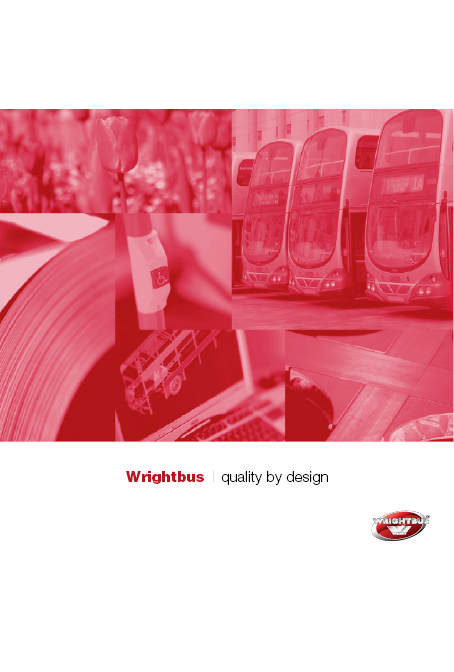


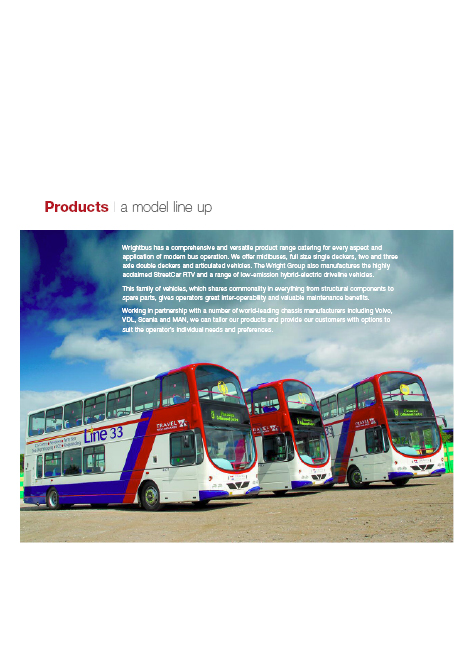
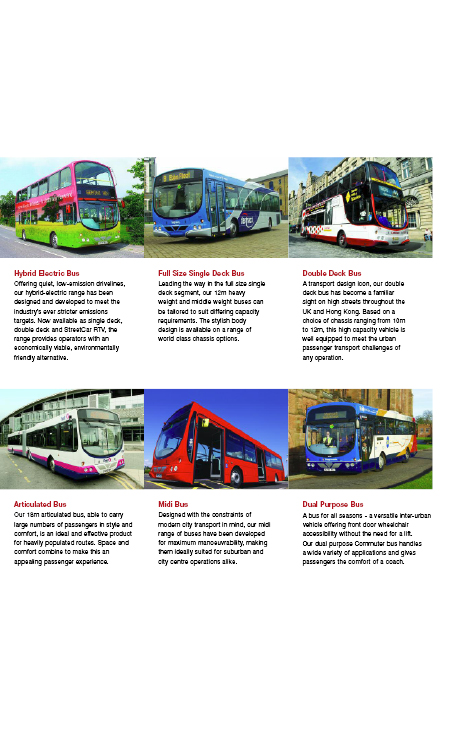
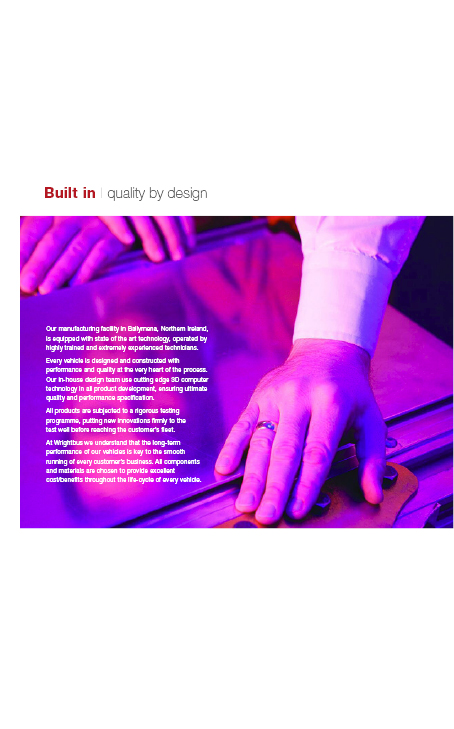
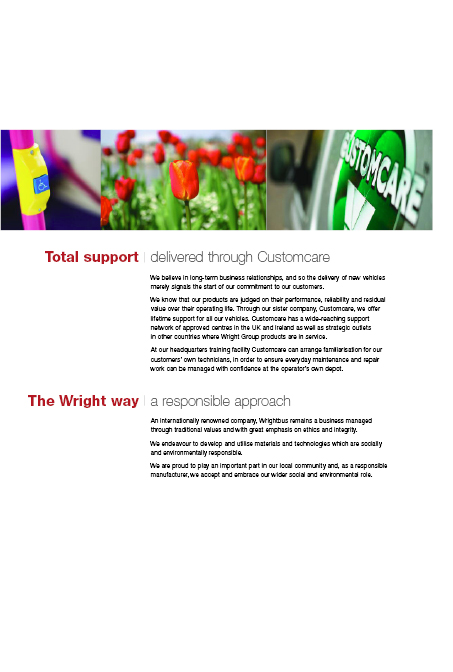
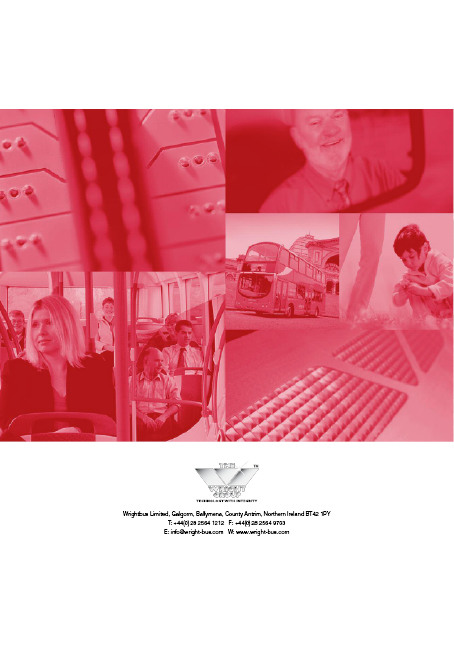
Please find below the Community Transport Association's (CTA) response to the Inquiry into Sustainable Transport. Our response is brief but takes into account the considerations of the providers and passengers of the Community transport network across Northern Ireland.
CTA provides advice support and learning for community organisations providing affordable, accessible and alternative transport solutions for people who are unable to access conventional forms of public transport. CTA are committed to ensuring people have access to the services they need through appropriate transport solutions. We support the community in their endeavours to meet local need.
Sustainable transport is a key to the development of community and business success across Northern Ireland. Transport provides 20% of the Northern Irish economic turnover which is unsupported y the education system. Many people refuse to use public transport preferring the private car option. CTA has submitted this response to the Inquiry into Sustainable Transport to help the Committee for Regional Development make decision regarding the future of Sustainable Transport in Northern Ireland.
CTA supports the improvements that have been made to public transport system through the Regional Transportation Strategy and the Accessible Transportation Strategy actions. While accessibility has improved there still remain a number of actions which need to be completed. CTA would support further strengthening of the ATS to ensure policies and procedures are robustly maintained in order to improve transport solutions for our whole society. The welcomed OFMDFM code to remove the exemptions to provide transport for people with disabilities from private coach providers is a progressive and inclusive step forward. CTA hopes the future review of taxi legislation will encourage more accessible considerations for that industry. CTA supports an inclusive transport strategy which permits all residents to access our public transport system. CTA however are opposed to segregated transport such as the Door-to-Door services provided through the Transport Programme for People with Disabilities. CTA hopes the programme will not be seen as a solution to the transport problems for people living in urban areas. Every Northern Irish resident should be able to use our public transport system. CTA hopes the Door-to-Door programme is an interim attempt to meeting need until such times as the mainstream public transport system is improves. Door-to-Door may help to meet immediate need but in the long term older people and people with disabilities should be able to access mainstream transport rather than being segregated off into 'disabled only' transport.
Community transport provides a solution for people who are unable to access conventional public transport. Often distance from bus stop or train station is the main factor which detracts from using the public transport system. Community transport can be used to provide the link. CTA would like to see a strengthening of the CT sector to ensure the community use this alternative service to help bridge the gap or overcome their problem of using public transport. In order to do this there needs to be an easier, joined up ticketing system; Community Transport needs to be able to access bus depots to ensure people with disabilities and older people can more easily access public transport (at present Translink have refused access) and there needs to be a commitment that support from funds like the Rural Transport Fund will continue post 2012. The Rural Community Transport network which currently provides in excess of 618,000 passenger trips per year is due to end March 2012. There is no guarantee that the Rural Transport Fund will continue post March 2012. By ending this fund the Government will return to a time when older people and people with disabilities living in rural areas will be rurally isolated, social excluded and deprived of the opportunity to access services. There needs to be clarification and confirmation of the future of alternative transport solutions from DRD.
At present there is no general fund to support urban community transport providers. The TPPD fund is used to pay for the Door-to-Door contract in urban areas and nothing else. Not everyone can access TPPD funded Door-to-Door transport as their criteria is extremely limited. More people in urban areas could access public transport if an urban community transport grant was made available. The community could develop its own solutions to enable local people to access mainstream routes. In many other areas across the UK the support for urban community transport organisations has seen an increase in passenger numbers on mainstream public transport routes. The community transport provides a link service to enable people to get to the main routes. Urban community transport has been devastated over the last 5 years to the lack of investment. While this has saved the government money it has seen an increase in isolation and polarisation in some urban communities across Northern Ireland. Community transport through little investment will not only improve commuter numbers but will help build community development and integration.
CTA supports the development of more opportunities to make use of public transport easier. This includes further development and increase of part and ride facilities, tax effective purchasing of tickets (buy tickets through employers the cost of which is deducted from the gross rather than net salary at source), online ticket purchasing with self printed tickets as an acceptable format on buses/trains, review of bus corridors into main cities, fully accessible fleet of buses and trains by 2020, the development of integrated public transport timetables with local services such as GP surgeries, post offices, banks etc. More marketing of public transport options to ensure everyone has ease of access to timetables, routes etc. Ensure all transport providers provide communications in accessible formats. As part of job seekers or employment programmes provision of travel training and access to route planning software linked to the public transport system be made available at job centres, libraries, schools, post offices, banks, bus and train depots etc.
It is time for Northern Ireland to review the public transport system, who delivers it and if the mix of deliverers is appropriate for Northern Ireland. Until the public transport network is openly tendered then we will remain within the constraints of a system installed many decades ago. The procurement system needs to take into account alternative transport providers including private companies, taxi firms and community transport – which provides not-for-profit transport solutions but is excluded from procurement because of tendering conditions – conditions that the Civil Service refuse to review. The Northern Ireland public procurement system needs to take into account how the community can deliver services and remove the self imposed restrictions preventing the community and charitable organisations from applying to provide solutions. The Government needs to take into consideration how it will invest in charitable and non-profit-making, community led solutions as well as investing in private companies.
CTA has concerns of the effects of RPA and potential denigration of transport services should those services be transferred to Councils as part of their new responsibilities. While localism is important CTA has already seen the effects of decentralisation in Scotland. The effect of not 'ring fencing' transport monies has seen the closure of over 40 Community Transport organisations. The effect of this has only caused disruption, increased isolation and social exclusion especially in rural areas across Scotland. Northern Ireland has created an improving transport system which needs centralised policy and management to enable stable control and investment in an area of growing demand. CTA supports the development of a Northern Ireland Public Transport Executive which would include public representatives on its Public Transport Authority. This system would control all policy and procurement of public transport for all government departments within Northern Ireland but retain a local identity through the inclusion of the Authority representatives.
Sustainable transport in Northern Ireland requires Inter-Departmental agreement and cross departmental funding arrangements. There remains a Public transport system operated in isolation from Health transport and separately again from Education transport. Too much money is being invested in a transport system where joined up government department thinking does not exist. The Community and in particular CTA have had a frustrating experience whereby our members can provide transport solutions however as we are pigeon holed as 'belonging' within the responsibilities of one government Dept, namely DRD, we are unable to provide or meet the needs of the Community for Health and Education (both being outside the remit of DRD and DRD supported transport is not permitted to be used to meet the needs of those Depts). Funding streams from other Depts are closed to many community transport providers. The Ni Assembly needs to create a clear transport policy taking into consideration all public transport requirements (general transport, Health, Education etc). Only then will public money be used effectively to not only meet need but do it in an efficient manner.
There needs to be a review of transport and the link from education to the industry. Due to age limits on driving licenses there is no natural career progression from school into transport. If transport provides over 20% of NI 'PLC' turnover then why is there a lack of investment in providing a link from education to the transport industry? Research completed by Go Skills revealed over 30% of career drivers has low levels of essential skills (reading, writing and ICT skills). This raises concerns as the number of drivers on our roads who are illiterate is rising. 30% of all career drivers may not be able to understand legal, health and safety and driving guidelines. The Northern Ireland government needs to accept transport is a major factor of life in this region. Education needs to deliver opportunities for people to gain appropriate qualifications to enter the transport workforce.
Many people use public transport to go to school and then stop. Once they enter the workforce they change to using a private car. There needs to be an improved public awareness campaign directing more people to continue to use public transport after childhood. All too often the PR campaigns highlight intercity travel. Many people who convert to private car use are based in rural areas. The Government needs to better understand why rural commuters do not use public transport and overcome those issues. Using rural commuters and rural scenarios in PR campaigns may do more to reduce the apprehension and negative image of public transport use. Teaching school leavers more about public transport options may help retain their patronage after they leave school.
Educating school children on the environmental benefits and cost savings may help to encourage tomorrow's commuters to maintain their use of the public transport system.
Educating the public on the continued use of public transport should be encouraged whenever possible. There are many opportunities at various key life events where other Government Departments can help to promote the use of public transport (maternity hospital outpatient times linked to the public transport network timetable – time tables provided with appointments, school run – parents provided with alternative public transport options for the school run – or public transport provides new routes to reduce school run congestion).
 British Council Challenge Europe,
British Council Challenge Europe, Promoting Urban Sustainability is one of three projects being taken forward by British Council Challenge Europe participants from Northern Ireland and the Republic of Ireland. The Promoting Urban Sustainability project comprises a programme of research, stakeholder engagement and lobbying aimed at ensuring Governments in Northern Ireland and the Republic of Ireland place sustainable transport options at the heart of their transport policies for cities and urban areas.
The Promoting Urban Sustainability project will run for one year. Project participants are in the initial stage of identifying examples of best practice in sustainable transport from across the globe. This paper overviews the issues participants are currently examining from which they will draft policy recommendations for key political decision makers. We welcome the Regional Development Committee's inquiry into Sustainable Transport and would be keen to present our policy recommendations to the Committee if requested by the Committee Chairperson and Members. We anticipate the research phase of the project will be complete by November 2009, with initial policy recommendations developed by January 2010.
Promoting Urban Sustainability will consider the potential of various options for delivering a modal shift in transport behaviour and an overall reduction in vehicle kilometres travelled. The following options are currently under investigation.
High Occupancy Vehicle (HOV) lanes are lanes on motorways or dual carriageways in which only vehicles with 2 or more occupants are permitted to travel. HOV lanes can be introduced when enlarging existing roads or one existing lane of motorway or dual carriageway can be converted to HOV status. The restrictions on these lanes may be in operation at all times or at peak hours only.
Prioritising the flow of HOVs will have the effect of reducing the travel time for occupants of these vehicles, thus encouraging travellers to car-share. Where existing lanes are converted to HOV status, the increase in traffic density in non-HOV lanes will further discourage single occupancy vehicles and motivate travellers to car-share. Reducing the number of vehicles travelling the same route will result in a decrease in the total number of vehicle kilometres travelled and will yield a reduction in the total level of greenhouse gas emissions.
HOV lanes have been widely implemented in the US and Canada, and more recently have been introduced in GB. HOV lanes operate on the A647 dual carriageway in Leeds, and the A4174 in South Gloucestershire, a dual carriageway orbital route to the North of Bristol. HOV lanes are also being considered for implementation on the A256 in Kent. Where HOV lanes are introduced, local councils have cooperatively launched websites to promote car sharing, similar to the DRD Travelwise Carshare NI scheme. Implementation of the HOV scheme in South Gloucestershire has resulted in a 10% reduction in single occupancy vehicles (from 80% to 70%) and a 10% increase in vehicles with at least 1 passenger (from 20% to 30%) travelling the route[3].
The findings of a UK Highways Agency feasibility study conducted in 2004 recommended that HOV schemes could be successfully introduced at each of four potential GB locations examined[4]. We aim to conduct further research into the potential for introduction of HOV lanes on major arterial routes into Belfast and potentially other cities in Northern Ireland.
Increasing the number of people cycling has many benefits for a modern city. It is an effective method of reducing carbon emissions, it does not pollute or make noise, it reduces congestion on the roads and it's healthy and cheap. Cycling presents benefits which both walking and public transport are unable to. Public transport can reduce private car use and associated greenhouse gas emissions but does not provide the health benefits of cycling. Conversely, walking provides health benefits but is less realistic an option for journeys of three or four miles or more.
In addition to reducing carbon emissions, improving cycling rates will yield health benefits in terms of reduced cases of obesity, coronary heart disease and mental health problems. The economic benefits associated with cycling include improved workforce efficiency and reduced rates of absenteeism[5]. Cycling should be considered a long-term option for sustainable urban transport and we believe there are many examples from which we can learn in order to boost cycling rates in Northern Ireland and turn Belfast into a cycling city.
A socially responsible city should provide its dwellers with the means to commute and have a healthy lifestyle. This is already the case in many cities worldwide. Paris, Barcelona, Copenhagen, Lyon, Vienna, Seville and Montreal all have lowcost bicycle rental schemes. Closer to home Dublin is launching "Dublinbikes" in September 2009 and London is due to introduce a scheme in May 2010.
We propose to look at the examples of international best practice, concentrating on the schemes in Paris and Dublin. These schemes are implemented through a symbiotic partnership of Local Government and modern advertising. The Paris Velib rental scheme is operated by the advertising agency JC Decaux. Paris City Council signed over exclusive control of over 1,628 city owned on-street advertising hoardings to JC Decaux who in return paid for supply and repair of the bicycles and covered all start up costs. Paris City Council receives all the revenue from the programme as well as a fee from JC Decaux of approximately US$4.3 million a year. In the first three months of operation there were 100,000 users daily, traveling a total of 300,000 km. This translates to a 32,330 tonne reduction of carbon dioxide emissions annually[6].
The scheme in Paris is the largest in the world, utilising 20,000 bicycles and employing 285 people in green jobs full time operating the system and repairing the bicycles. A bicycle can be hired from and returned to any of the 1,451 Velib stations. Stations are located approximately every 275 meters throughout the city.
Dublinbikes is primarily based on the Paris scheme. It is funded by JC Decaux and both Dublin and Paris operate the same charging principles. A user of the scheme buys a daily, weekly or yearly pass, priced at €1, €7 or €29 respectively and guarantees a €150 deposit payable by credit card if the bicycle is not returned after a specified period of time. The first 30 minutes of use are free, then the user is charged €1 for each subsequent 30 minutes. The fee structure supports the fundamental principle behind the rental scheme that the bikes are for city commuting and are for use by the whole community.
There are many potential benefits for Belfast from introducing a public rental bicycle scheme. Cycling presents commuters with a "no-carbon" transport option and cycle hire points could be positioned to interconnect with existing bus and rail services and the forthcoming rapid transport system. Public transport passengers would be able to access rental bicycles on disembarking their bus or train, cycle to their destination and leave the bicycle at a nearby rental station. The scheme would also have significant potential to support Belfast's tourism industry and would provide a revenue stream for either Belfast City Council or Central Government, depending on which tier of Government the scheme was operated by. We propose to examine the potential for introducing a bicycle rental scheme in Belfast to provide the people of Belfast with a sustainable form of alternative urban transport that will enhance their lifestyle.
Transport statistics indicate that on average 35.5% of journeys made in Northern Ireland between 2005-2007 were 2 miles or less and 63% of journeys were 5 miles or less. However, cycling on average accounted for only 19 of the 5,999 miles travelled by each person living in Northern Ireland[7]. If even half of all journeys of 5 miles and under were made by bicycle rather than private car this would have a dramatic effect in terms of reducing the level of greenhouse gases emitted in Northern Ireland.
We know that 22% of the population would cycle more if Government invested to improve cycle track networks[8]. We aim to examine international best practice to determine how cycle lane networks can be improved in Northern Ireland's urban centres to increase the number of people commuting by bicycle. We will study the example of Copenhagen where 36% of residents travel to work by bicycle. We will also examine the issue of social inclusion when investigating how cycling infrastructure can be improved across urban areas to ensure equality of access to transport for all citizens.
Promoting Urban Sustainability will also research ways in which Government could help employers to make cycling a viable transport choice for their staff. Potential options include Government grants to cover provision of cycle parking, changing and showering facilities, bicycle maintenance and cycle training. Recommendations will also be developed regarding how train services could better accommodate cyclists during peak travel times to ensure provision of a fully integrated sustainable transport network in Northern Ireland.
Project participants are currently undertaking research regarding the feasibility of introducing the above mentioned transport options in Northern Ireland. Policy recommendations based on the findings of this research will be made available to the Department for Regional Development, the Regional Development Committee and other relevant stakeholders in due course.
Dr Alberto Longo – Lecturer in Urban Land Economics & Management,
Queen's University Belfast.
Claire Martin – Assistant Solicitor, Elliott Duffy Garrett.
Andy McClenaghan – Senior Consumer Affairs Officer, Northern Ireland Consumer Council.
Julie McGee – Consultant, National Energy Assessors.
[1] National Atmospheric Emission Inventory (2008) Greenhouse Gas Inventories for England, Scotland, Wales and Northern Ireland: 1990 - 2006
[2] Maguire, C., Curry, R. and McClenaghan, A. (2008) Northern Visions – Footpaths to Sustainability.
[3] Department for Transport (2006) Traffic Advisory Leaflet: High Occupancy Vehicle Lanes
[4] The four motorway sections pre-selected by the Highways Agency were all on radial routes used by commuters to major cities i.e. M3 junctions 2-3 and M1 junctions 13-7 (both London), M61 junctions 6-3 (Manchester) and M62 junctions 25-27 (Leeds).
[5] SQW (2007) Valuing the Benefits of Cycling: A Report to Cycling England
[6] Calculation based on user figures from 15 July – 11 September 2007, when an average 100,000 users per day cycled 300,000 km per day. This amounts to a CO2 emission reduction of 88.58 tonnes and a projected annual saving of 32,330 tonnes CO2, assuming the modal shift is from car to cycle and 1km driven by car = 0.3kg CO2 emitted and cycling = zero emissions.
[7] DRD Roads Service (2008) Travel Survey for Northern Ireland: 2005-2007
[8] DRD (2009) Public Perceptions of Car Emissions


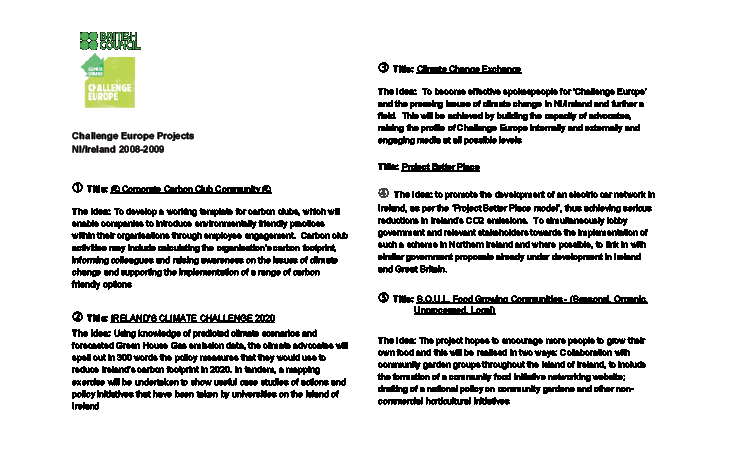

7 September 2009
1. Improved opportunities for social interaction
2. Improved opportunities for physical activity and reduced obesity
3. Improved road safety
4. A fairer system, with transport resources more equitably divided across society
1. Reduced air pollution
2. Tackling climate change and peak oil
1. Investment can bring about savings elsewhere in economy, especially health and social care
2. New economic opportunities can be generated
3. Reduced need for new roads and road maintenance, with spin off savings and benefits
1. Strong high level, cross sectoral leadership is crucial; further planning should be led by a Ministerial Action Group incorporating Ministers responsible for transport, planning and environment, economy, regeneration, health and rural affairs
2. Joined up policy making is key to a successful switch; need to develop common definition, aim and objectives across relevant policies
3. Policy focus should be on the RDS and the RTS, with the planning system, Investing for Health, regeneration and rural policy key supporting policy arenas. Action could be strengthened through a cross Departmental Sustainable Transport Strategy and Action Plan, linked to the RDS and RTS
4. Health and health equity objectives should be incorporated in policy and action; all transport decisions should incorporate assessment of environmental, health and social impact, while cost benefit analysis also should incorporate these aspects
5. Policy and action must work towards clear targets, eg. a 5% reduction in car journeys per annum or increasing the non car share of journeys to 50% by 2020 (baseline 30%, 2007/08);
6. Setting indicators and collecting data to monitor progress is crucial and a key role for the Regional Development Committee; this may require new indicators to be developed or new data to be collected, for example on accessibility and people's transport needs
7. Transport related policy and action must be based on evidence of environmental and social impacts; collaboration with the health sector can help strengthen the evidence base
8. Community engagement must be a vital element of implementation
9. To get the process underway, meet climate change and emissions targets already set in the UK Climate Change Bill and provide sufficient time to prepare for a 'post-oil' society, it is vital that policies incorporate relevant targets and objectives now, rather than waiting for the next review.
Belfast Healthy Cities welcomes the opportunity to make a submission to this very timely Inquiry into Sustainable Transport, which shows crucial leadership to initiate work in this area, which is vital to our future health and wellbeing in social, environmental as well as economic terms. Transport is central to support health and wellbeing, and sustainable transport contains many key elements required of a health improving transport system.
Belfast Healthy Cities is a partnership organization working to improve health and health equity, through intersectoral collaboration. Our key partners include Belfast City Council, Belfast HSC Trust, Bryson Charitable Group, Department of Health, Social Services and Public Safety, East Belfast Partnership, Northern Ireland Housing Executive, Planning Service, Public Health Agency, Queen's University of Belfast and Ulster Cancer Foundation.
Our work aims to support organizations to integrate health and health equity in all local policies, through providing evidence, tools and models of intersectoral working. We have over 20 years' experience of successfully doing this, and have also been at the forefront of introducing new concepts, such as healthy urban planning and healthy ageing, to Northern Ireland. Belfast is a leading member of the WHO European Healthy Cities Network, which has over 90 member cities, and currently provides the secretariat to the Network.
Belfast Healthy Cities has built expertise on the impacts of transport on people's wellbeing in relation to work on healthy urban planning. We have specific expertise on the transport needs of older people, through our work on healthy ageing in Phase IV (2003-08) of the WHO European Healthy Cities Network. Transport was a theme of Healthy Ageing:InterAction, the first intersectoral action plan for older people in the Eastern area. Following this work, Belfast Healthy Cities chaired the Eastern Area Transport Forum, which oversaw a pilot buddying scheme, aimed at improving older people's confidence to use public transport. In October 2008, the Forum hosted a consultation event on transport for older people in Belfast – chaired by Fred Cobain MLA, Chair of the Regional Development Committee – which underpinned an action plan currently being implemented through key public and voluntary sector agencies. The event highlighted quality concerns over public transport, but also emphasised its crucial role in allowing older people to remain independent.
We believe health and health equity is an important goal in its own right, as this serves as a yardstick of how society works for people. Improving health equity is a core aim of the WHO European Healthy Cities Network in Phase V (2009-2013), which draws extensively on the report Closing the Gap by the WHO Commission on Social Determinants of Health, chaired by Professor Sir Michael Marmot of University College London.
However, health is also an integral element of a prosperous society, and indeed a sustainable society; a healthy population is a prerequisite of social, economic as well as environmental wellbeing.
We are making this submission as we believe sustainable transport is closely related to improved health, health equity and wellbeing. Indeed, we see both improved health and sustainable transport as vital preconditions to achieving the overall Programme for Government aim to build 'a peaceful, fair and prosperous society in Northern Ireland … where everyone can enjoy a better quality of life now and in years to come'.
We would be pleased to further develop the themes discussed by giving oral evidence, should the Committee find that helpful.
The Healthy Cities approach defines health as the outcome of social, economic and physical living conditions, and therefore as the responsibility of all sectors.
We define health equity as a situation where resources and goods relevant to health are distributed fairly across all population groups. It builds on a body of research which indicates that there is a social gradient in health across society with risks highest among the lowest social groups. Research indicates that the gradient is linked to differential access to goods and resources, which in turn is determined by income and social status.
Belfast Healthy Cities believes that sustainable transport can significantly support improved health and wellbeing, while it also has other major social, environmental and economic benefits. However, before it is possible to consider the implications of sustainable transport, it is necessary to briefly consider what functions transport serves, how transport systems are affected by other sectors of society, and what a sustainable transport system might look like.
Ultimately, the function of transport is to help people reach desired destinations. A sustainable transport system is concerned with achieving this in a more environmentally sound way, and therefore definitions of sustainable transport focus on public transport, walking and cycling. This would involve a significant modal switch from the current car centred transport system, and is likely to require a combination of policy, technology and measures aimed at changing attitudes.
Evidence shows that people's transport decisions are influenced by a complex set of factors, which often becomes summarised as 'convenience'. Key among these is cost, followed by quality of transport options: people value punctuality, reliability in travel times, cleanliness, safety and courteous behaviour from others. Another key issue is connectivity, which refers to how well key destinations are linked, and how well they are served by different transport modes. Many people need to 'trip chain' journeys within a tight schedule, and therefore clusters of key destinations close to transport interchanges are helpful. It is important to note that transport mode is less important than convenience, therefore, sustainable transport hinges on making public transport and active travel cheaper, better connected, more reliable, more pleasant and safer to use.
However, sustainable transport should also be concerned with travel demand management, or in short reducing the need to travel. In this respect, a transport system is also highly influenced by land use planning, which determines where people live in relation to key destinations (jobs, schools, services), and therefore broadly shapes people's transport needs. Land use planning which focuses on mixed use development, with key destinations centred around public transport hubs is key to limiting the need to travel. This would likely require fewer measures aimed at changing people's behaviour, and could significantly help to make the right choice the easy choice.
All of these elements are incorporated in the concept of accessibility, which is a transport planning concept increasingly used for example in Britain. Its key advantage is that it enables analysis of why and how people travel, which helps highlight key areas for action. Therefore, Belfast Healthy Cities would suggest that it is particularly well suited to underpin a sustainable transport system.
From a health perspective, Belfast Healthy Cities would identify a sustainable transport system as one that is based on the concept of accessibility, and consists of three key elements: 1) reducing the need to travel; 2) putting in place and maintaining improved infrastructure for more affordable public transport, walking and cycling and 3) promoting public transport and active travel. The priority order is important, as people cannot be expected to change their behaviour (and attitudes) until the appropriate infrastructure is in place. Making the right choice an easier choice is also important to build and maintain public support, and minimise the need for measures such as road pricing, that might be considered coercive and are likely to be highly unpopular.
However, Belfast Healthy Cities would recommend that a common definition of sustainable transport is agreed in Northern Ireland, to provide a clear basis for further debate and planning.
Defined in the above terms, and compared to the current car centred transport system in Northern Ireland, sustainable transport offers considerable benefits, in social, environmental as well as economic terms. Importantly, these benefits are interrelated and can therefore add to more than the sum of their parts.
In social terms, mixed use development, improved public transport and improved opportunities to walk and cycle can:
This supports mental wellbeing for individuals and can translate into improved social cohesion at a societal level. This, in turn, may reduce problems with anti social behaviour, and bring about savings for policing and public realm maintenance.
Positive impacts can be achieved without significant direct communication; for example, intergenerational relations can improve if both older and young people become used to seeing each other. This can, among other things, reduce fear of crime among older people. It can also reduce social isolation, which is a risk factor for deteriorating mental wellbeing, and thus reduce costs to health and social services.
Walking or cycling for transport is easier to incorporate in the daily routine than more formal exercise, and can therefore be easier to sustain. Mixed use development tends to encourage active travel, as it provides key destinations and destinations of interest within reasonable distance. Taking public transport can support this, as the journey usually involves a walk to and from the transit stop. Tackling obesity has major economic implications; if obesity continues to grow at the current rate, the cost to the UK economy has been estimated to reach £50billion per year by 2050.
Less traffic is likely to mean fewer collisions, and fewer casualties. Road traffic deaths and injuries are a major cause of distress and disability for individuals and families, but also have major costs for the economy. In 2007, the Department of Transport in England estimated that preventing all casualties would have had a total value of £19,104million (with human costs valued at £9.740m). Each traffic death has been valued at almost £1,7million. Importantly, research shows that as the number of pedestrians and cyclists increases, the risks decrease, primarily because drivers become more cautious.
With less traffic, children may have more opportunities to walk and cycle to school, and play outdoors. This will boost their activity levels and can also support their development. Research indicates that concerns about traffic are a major reason why parents are reluctant to allow their children this kind of independence, and there is evidence that lack of opportunities can impair children's emotional and social development as well as their ability to assess and handle risk.
Road safety also has an equity aspect; busy traffic disproportionately affects more deprived people and neighbourhoods. A child from a family with unskilled parents is five times more likely to die in a traffic incident than a child of professional parents. This is primarily because more deprived areas are more likely to be located near busy roads; people from lower social groups are much less likely than the general population to own a car. For example in Belfast, at the time of the last Census in 2001, 40% of households had no access to a car, but this rose to over 60% in many of the region's most deprived wards in inner north and west Belfast. Therefore, reduced traffic in itself can support mental wellbeing in deprived communities, through reducing traffic related concerns.
A key issue with the current car centred transport system is that it tends to favour people who are relatively wealthy and can afford a car. This is a major health equity issue, since 'transport poverty' tends to concentrate among people in lower social groups and among older people, all of whom are generally disadvantaged and at greater risk of ill health. Lack of transport compounds these disadvantages, by limiting access to essential opportunities such as jobs, affordable healthy food and participating in society.
As an example, as far back as 1992, research in Belfast found that carless households had 25% of the job opportunities available to neighbours who had a car. Indeed, many low income households find a car is a necessity and may have to limit other activities to meet the maintenance costs, which can be 10% of income or more. For others, meanwhile, the cost and availability of transport may become a too high barrier: transport issues contribute to economic inactivity, social isolation and social exclusion especially among lone parents, but also lower skilled groups and rural populations.
Sustainable transport can in particular help improve 'transport equity', insofar as it offers cheaper fares and better connectivity. Both can open up new opportunities: cheaper fares and fewer journeys mean more disposable income to spend elsewhere. Better connectivity, in turn, can widen the realistic job search or training area, with associated health and social wellbeing benefits.
Sustainable transport is fundamentally intended to reduce reliance on the private car, and thus tackle the core environmental problems, air pollution, climate change and peak oil. These issues also have a health dimension, and key benefits of more sustainable transport include:
Air pollution harms the ecosystem in many ways and remains an issue, although pollution levels in Northern Ireland have fallen and now in most places comply with UK standards. Reduced traffic combined with potential new technologies can further reduce pollution and protect the environment. In addition, this will support health and wellbeing, as air pollution is associated with health problems including an increased risk for respiratory infections, worsening of asthma and complications in cardiovascular disease. Particulate matter pollution alone has been estimated to cut average life expectancy in the UK by eight months. Reduced air pollution thus has significant potential for monetary savings, in particular for healthcare services.
Congestion is associated with high air pollution in localized spots; for example, all four Air Quality Management Areas in Belfast are by major roads (local authorities in the UK are required to declare AQMAs where air quality targets are unlikely to be met) Easing congestion will reduce this problem, and will also reduce stress among drivers.
Transport contributes about a fifth of CO2 emissions in the UK as well as worldwide, and uses significant amounts of oil for fuel. It therefore significantly contributes to climate change, which has been characterized as the most urgent issue of our time. More sustainable transport is essential to cut transport emissions and tackle the core problem, while it will also help preserve dwindling fossil fuel reserves.
Climate change is a major health as well as environmental risk, and therefore sustainable transport can also help limit the health related risks. In Northern Ireland, these include an increase in infectious (tick borne) disease and especially mental, but also physical health problems following flooding, which is projected to become more common. Food is likely to become more expensive, and some foods may become increasingly scarce. Meanwhile, the depletion of fossil fuel reserves will drive up energy prices, which is likely to worsen fuel poverty, already a major concern in Northern Ireland where at least 34% of households are fuel poor.
Climate change is also another major health equity issue, as people in the lower social groups will be first and most affected by rising costs. If not tackled, climate change may therefore exacerbate disadvantage and ill health, which in turn may lead to growing cost pressures on the social security system and health services.
It is clear that sustainable transport will require considerable initial investment. However, these costs can be counterbalanced against savings and new economic opportunities. Key economic considerations include the following:
As a recap of previous comments, investment in a sustainable transport can be offset against potentially significant savings in healthcare, benefits and even policing. In Copenhagen, where about 30% of the population commute by bike, it has been found that frequent cyclists have about 30% lower mortality than people with otherwise similar health and living conditions, which has resulted in significant healthcare savings. Where improved access to transport enables previously unemployed people to take up jobs, this will further boost tax revenues.
In particular mixed land use, combined with walking and cycling infrastructure, could contribute to economic vibrancy of local village and neighbourhood centres, and a renaissance of town centres. This is primarily because it helps create places, where people are willing to spend time and consequently money. Such places, particularly those where the traditional scale and style has been retained, are also very inviting for visitors. Evidence for this exists from elsewhere; in Groningen in the Netherlands, the city centre economy has grown rapidly since car traffic was limited (http://www.globalideasbank.org/site/bank/idea.php?ideaId=378). Copenhagen, the world's self proclaimed 'cycling capital', has a vibrant economy and a thriving , inclusive evening economy in the city centre. However, it is important to focus on a network of local centres, rather than concentrating on the town centre alone, as this could indeed reduce accessibility and walkability.
Other economic opportunities could be in tourism, such as bike tours, and directly in transport, for example additional community transport services. There are also opportunities in the biofuel sector, as outlined in the DETI Bioenergy action plan currently out for consultation. For example in Sweden, experiments with buses fuelled by biogas have yielded positive results and Stockholm is currently in the process of expanding its biogas bus fleet.
This would also have environmental as well as social benefits, as greenfield land in rural areas would be preserved for agriculture, wildlife and recreation. In urban areas, reduced need for multi lane roads would allow for a safer and more aesthetically pleasing environment. This could attract more people to use facilities and services, which could improve social cohesion, and boost economic benefits. For operators of necessary road freight, reduced traffic would bring improved certainty in journey times and savings in fuel, thus supporting profitability.
To summarise the above analysis, a more sustainable transport system can generate potentially very significant health improvements, and benefits to society overall. Its key advantage is that it allows a people focus, which allows for more holistic and long term planning than planning focused on transport per se. However, it is clear that this requires in particular considerable policy leadership, as well as investment in infrastructure and technology. This is a central role for the Regional Development Committee and has been initiated through this Inquiry.
Examples of successful moves towards more sustainable transport can be found both within the UK and further afield, in particular Copenhagen, Dutch cities and also southern European cities such as Barcelona or Porto. Building on the experience of these cities appears a potentially useful approach; it can help avoid pitfalls, while providing clear examples of achieved results and benefits.
Evidence from cities which have made a switch towards more sustainable transport indicates that the key policy measures required to underpin a move to more sustainable and healthy transport involve prioritising the following :
The key policies required to implement these measures and thus underpin more sustainable transport are the Regional Development Strategy and the Regional Transportation Strategy. The planning system, incorporating Planning Policy Statements and Area Plans (to become Local Development Frameworks when this function is transferred to councils), is also important for implementing strategic guidance. Regeneration policy within DSD and rural policy within DARD also influence transport, and must integrate sustainable transport principles to achieve a coherent policy context. There is now an unprecedented opportunity for joined up policy making, as both the RDS and RTS are under review, while the planning reform is also still underway and a Rural White Paper is forthcoming.
In addition, there is now an opportunity to integrate the sustainable transport and health improvement agendas, as the cross Departmental public health strategy Investing for Health is also under review. A key advantage of this would be that incorporating health and health equity objectives could help maintain focus on the core functions and impacts of transport, thus providing a catalyst for people centred action. There could also be an opportunity to improve integration of services, such as the use of community transport to access health care (currently not permitted). Health policy is also based on strong evidence and indicator sets, and collaboration could help strengthen the evidence base and monitoring systems for the overall project.
The health sector can also provide support in assessing the impacts of transport policy and proposals. Health Impact Assessment (HIA) is a concept and methodology that offers a systematic, evidence based way to consider how proposals will affect health, wellbeing and quality of life, and make recommendations for how it can best support these aims. HIA was developed to complement Environmental Impact Assessment (EIA), but uniquely, it gives particular attention to vulnerable groups and potential differential impacts. This is further emphasised in Health Equity Impact Assessment tools, which are specifically intended to consider equity impacts and ways of tackling inequalities. The WHO European Healthy Cities Network has focused on HIA for a number of years, and will continue this work to develop Health Equity Impact Assessment tools in Phase V (2009-2013), as recommended by the WHO Commission on Social Determinants of Health. Belfast Healthy Cities has pioneered HIA in Northern Ireland and would be happy to assist with further information and advice on transport related HIAs.
Technology can help support a move to more sustainable transport in many ways. For example, some key, much discussed technological solutions such as integrated ticketing and audiovisual announcements on public transport are important quality improvements, which can help make using public transport a smoother, more pleasant and therefore more attractive travel option. Indeed, audiovisual announcements are vital to allow older people and people with disabilities to use public transport safely and with confidence. Improved online transport information can help improve passenger confidence and convenience, while preferential treatment for buses and cycles in traffic lights can help them make speedier and more convenient alternatives in cities. Finally, technological mobility substitutes, such as telecommuting, online service facilities and online shopping with delivery, can reduce the need to travel. However, it is important that technology is considered complementary to infrastructure improvements and policy leadership.
Potential new renewable fuel or electric vehicle technologies may also have a role in supporting a more sustainable transport system, by displacing fossil fuels. Each of these should be considered on their merits; for example, biogas as bus fuel has yielded positive results in Sweden, and Stockholm is currently expanding its fleet of buses running on biogas. However, it is important that such new technologies are seen as ways of further reducing the environmental impact of a sustainable transport system focused on minimizing essential travel, rather than solutions reducing the need to change current transport trends.
Ultimately, a successful move towards more sustainable transport requires people to change their behaviour (and attitudes); this applies both to the public and policy makers, who must shift from a mobility focus to an accessibility based planning approach. Again, evidence from successful cities indicates that the best route to sustainable behaviour change is providing the infrastructure and facilities to make the right choice the easy choice. Copenhagen has consistently invested in cycling infrastructure since the 1970s. Curitiba in Brazil has similarly invested in public transport over 30 years, and the Netherlands has supported cycling infrastructure alongside roads. Community engagement is also important, to help people feel part of the change and therefore embrace it more easily.
A potentially very useful approach would be to develop a series of demonstration projects, which would allow testing and refinement of different models for sustainable transport, potentially at different scales. Existing examples include workplace travel plans and carshare schemes, but larger scale schemes can also be developed in this way. One example is the Connswater Community Greenway being developed in east Belfast, where the local community, through East Belfast Partnership, is leading a broad partnership which includes public sector agencies as well as academia. The Greenway is a major regeneration initiative, but its aims include improved opportunities to commute on foot or by bike, to improve health and displace traffic, which will further benefit the health and wellbeing of local people and communities.
This approach would have a number of benefits: it would enable local community involvement and innovation, encourage intersectoral collaboration, and also allow lessons to be learnt, without the level of financial risk involved in regional approaches. Minimising risk in this way would, in turn, also support longer term strategy and action planning, as only successful models could be considered for regional adoption.
However, there may also be a role for more traditional measures aimed at attitude and behaviour change. These could include incentives and rewards for sustainable transport use, which could build on and expand existing Travelwise initiatives, such as the bike purchase scheme and salary sacrifice scheme, which offers a discount on annual public transport tickets. Health related or environmental social marketing campaigns can help alter behaviour, although they tend to be most effective among already motivated individuals.
Finally, there are a number of more coercive options, such as congestion charging, road pricing and reducing parking or substantially increasing parking charges in town centres. Belfast Healthy Cities believes these are best avoided, primarily as they may have a disproportionate impact on people in lower or vulnerable social groups (eg. shift workers in manual jobs such as cleaning or delivery, or people with disabilities, who have little option but to park in town) and thus harm equity aims. They are also likely to be highly unpopular, and reduce public support for the overall aim. The exception may be higher parking charges, which may be appropriate to discourage private car use when improved public transport coverage is in place (with appropriate provision made for people with disabilities). Similarly, alternatives could be sought for the car parking benefit common among public sector workers, which is costly and in many ways amounts to a public subsidy to a relatively well off population group. For example, staff not taking up a space could be paid a bonus, or the benefit could be converted to taxi vouchers, etc. The NI Environment Agency has already begun prioritising car sharers when allocating car parking spaces, which is another alternative. Strong enforcement of parking regulations is crucial and appropriate at all times.
Belfast Healthy Cities recognises that a wide range of recommendations on sustainable transport have been published very recently; publications include the Consumer Council's survey report Public Transport – on the right track? (July 2009), Northern Ireland Environment Link's article collection Sustainable Transport (June 2009), which provides a range of viewpoints, and PricewaterhouseCooper's report Bridging the Gap – Transforming Public Transport in Northern Ireland (June 2009), published as part of the call for evidence for this Inquiry. It is not necessary to repeat key conclusions and recommendations here, but they should be considered as valuable evidence for the Inquiry.
Belfast Healthy Cities broadly supports the recommendations made in the above publications, in particular those made in the NIEL report. Here, we would simply like to highlight a series of recommendations, which are based on the above analysis and which we believe are particularly important to ensure that a move towards more sustainable transport also is a move towards a more health improving and equitable transport.
As noted in the Introduction, the current work of the WHO European Healthy Cities builds on the WHO Commission on Social Determinants of Health. We would also like to highlight its key recommendations, which we believe are vital areas for action to develop a healthy, equitable and sustainable society, and could provide useful principles also for developing sustainable transport. These are to 1) improve daily living conditions for all, 2) tackle the inequitable distribution of power, money and resources and 3) measure and understand the problem and assess the impact of action.
1. Strong high level, cross sectoral leadership is crucial; further planning should be led by a Ministerial Action Group incorporating Ministers responsible for transport, planning and environment, economy, regeneration, health and rural affairs; the Regional Development Committee should take leadership in garnering support for sustainable transport throughout the Assembly
2. Joined up policy making is key to a successful switch; further policy and action must be based on common definitions and a common vision or aim, which should emphasise reducing the need to travel as much as modal switch to public transport, walking and cycling
3. Policy focus should be on the RDS and the RTS, with the planning system, Investing for Health, regeneration and rural policy key supporting policy arenas. Action could be strengthened through a cross Departmental Sustainable Transport Strategy and Action Plan, linked to the RDS and RTS
4. Health and health equity objectives should be incorporated in policy and action to maximise the health benefits of sustainable transport; all transport decisions should incorporate assessment of environmental, health and social impact, while cost benefit analysis also should incorporate these aspects
5. Policy and action must work towards clear targets, eg. a 5% reduction in car journeys per annum or increasing the non car share of journeys to 50% by 2020 (baseline 30%, 2007/08);
6. Setting indicators and collecting data to monitor progress is crucial and a key role for the Regional Development Committee; this may require new indicators to be developed or new data to be collected
7. Transport related policy and action must be based on evidence of environmental and social impacts; collaboration with the health sector can help strengthen the evidence base
8. Community engagement must be a vital element of implementation
Sustainable transport is an essential element of a resilient society capable of adjusting to and prospering in a 'post-oil' world, where fossil fuel resources are increasingly scarce and therefore command high price premiums. It is also a prerequisite of a healthy and fair society, which in turn is both a vital goal in its own right, and necessary to develop resilience in the face of this unparalleled challenge.
This Inquiry is very timely, as all the key policies required to underpin a move to more sustainable transport are currently under review. This situation provides an unprecedented opportunity for joined up policy making, and this Inquiry is particularly well placed to draw up a common framework for this. To get the process underway, meet climate change and emissions targets already set in the UK Climate Change Bill and provide sufficient time to prepare for a 'post-oil' society, it is vital that policies incorporate relevant targets and objectives now, rather than waiting for the next review.
Committee Inquiry into Sustainable Transport
2nd September 2009

The Institute of Public Health in Ireland
www.publichealth.ie
Dublin Office: Belfast Office:
5th Floor Bishops Square Forestview
Redmond's Hill Purdy's Lane
Dublin 2 Belfast BT8 7ZX
Ph: Ph:
The Institute of Public Health in Ireland (IPH) aims to improve health on the island of Ireland by working to combat health inequalities and influence public policies in favour of health. The Institute promotes cooperation between Northern Ireland and the Republic of Ireland in public health research, training and policy advice.
IPH commends the Regional Development Committee on selecting sustainable transport as its subject for inquiry and welcomes the inquiry's focus on identifying a move to more sustainable transport in Northern Ireland. IPH thanks the Committee for the opportunity to contribute views and experience.
Transport provides a significant contribution to population health because of its impact on travel patterns, access to services, exercise and social connectedness
A sustainable transport system can influence population health outcomes as it provides opportunities to increase levels of physical activity, improve air quality and enhance social interaction.
Increasing levels of physical activity in the population contributes to reducing coronary heart disease, diabetes, some cancers and obesity. It also improves mental health. The World Health Organization recommends adults undertake 30 minutes of physical activity everyday and evidence shows that only 30% of people take the recommended daily amount in Northern Ireland[1].
In Northern Ireland, obesity is a major concern and in 2005/06, 59% of adults were identified as either overweight or obese and 10% of children were obese. Physical activity can contribute to obesity which is identified as an important risk factor for a wide range of serious conditions including heart disease, cancer, hypertension and diabetes. If the current trend continues, IPH forecasts that over the period 2005 to 2015 there will be a 26% increase in the proportion of people with Type 2 diabetes. This has major consequences for Northern Ireland due to the loss of productivity and the costs of care. Treatment of obesity and related conditions have serious effects on the economy and threaten to engulf the health service. Obesity is estimated to cause 450 deaths per year, cost £14.2 million in lost productivity and £90 million in health and social care costs.
Current transport patterns have contributed to an increase in obesity. Urban sprawl, where land use spreads out into areas adjoining the edge of the city can increase car dependency and evidence shows that those living in such areas drive three to four times more than those who live in efficient, well-planned areas. It has also been shown that each additional hour spent in a car a day can be associated with a 6% increase in the likelihood of obesity. Sustainable transportation methods contribute to increased physical activity which in turn impacts on levels of obesity. Public transport can impact positively on physical activity levels as most trips begin and end with some form of physical activity with one study quantifying this as 19 minutes a day.
IPH recognise and support a move to a more sustainable transport system in Northern Ireland which would be beneficial for both individuals and the general population. Attractive and accessible features of transport design are essential in promoting exercise. Recent guidance from the National Institute for Clinical and Health Evidence (NICE) states that transport planners should 'ensure pedestrians, cyclists and users of other modes of transport that involve physical activity are given the highest priority when developing or maintaining streets and roads which can be achieved by widening pavements and introducing more cycle lanes'.[2]
IPH also recommend adopting a lifecourse approach which would consider the needs of young children through to elderly people. The number of children walking or cycling to school is rapidly decreasing which is a worrying trend as exercise habits established in childhood are a key indicator of physical activity in adulthood. Older people must also be catered for as exercise and social connectedness are critical aspects of a healthier older age. There is a need to review the travel patterns of all users to make sustainable transportation more attractive in terms of travel times, convenience and financial cost.
Health inequalities are the differences in outcomes between different population groups. There are a number of inequalities in Northern Ireland's current transport system. Children from deprived communities are more likely to die as a result of a traffic collision. In Belfast, areas which exceeded air quality limits as a result of commuting traffic were all identified as deprived communities. Deprived communities are least likely to have access to private vehicles.
IPH recommend a sustainable transport system which ensures equity for all users.
Alongside physical activity, a sustainable transport system contributes to improved mental health. A well planned transport system can facilitate social connections which are important for mental health. Neighbourhood designs most likely to promote social networks are those that are mixed use and pedestrian orientated, enabling residents to perform daily activities without the use of a car. As traffic volumes increase, people's sense of neighbourliness decreases which results in decreased social connections.
IPH recommend a multi-sectoral approach to ensure sustainable transport systems are a key element of any new development or neighbourhood.
Climate change is identified as one of the biggest public health issues of the 21st Century. Northern Ireland has higher greenhouse emissions than the UK which can be attributed to our transport (and agriculture) emissions.
Urban areas are particularly affected by vehicle-related air pollution which can contribute to respiratory disease especially amongst vulnerable groups such as the elderly. Disadvantaged urban areas tend to be characterised by high traffic volume, with residents at increased risk of road traffic accidents.
IPH recommend DRD, through a sustainable transport approach, to reduce dependency on private transport by encouraging a modal shift to more sustainable travel patterns such as public transport, walking and cycling which can help to reduce greenhouse emissions and also improve overall air quality.
The Regional Transportation Strategy in Northern Ireland is due for review in 2012. This presents a great opportunity to change the focus of the current strategy from private road users to a more sustained transport system.
IPH recommend that sustainable methods of travel are central to the new Regional Transport Strategy. This requires a commitment to investing in public transport alongside cycling and walking routes. There is also a need to ensure that other government departments and sectors have shared responsibility for the strategy which will assist to create more sustainable neighbourhoods in Northern Ireland.
The recent 'Bridging the Gap' publication by PricewaterhouseCoopers looked at transforming public transport in Northern Ireland and highlighted the lack of investment in public transport in Northern Ireland compared to the rest of the UK and Ireland.[3] This publication highlighted the environmental, social and economic implications but gave no consideration to health implications.
The Department for Transport in the Republic of Ireland recently published 'Smarter Travel: A Sustainable Transport Future'[4]. This strategy strongly recognizes the potential health benefits of a sustainable transport system which includes playing a central role in combating obesity.
IPH recommend DRD take a similar approach to that adopted by the Republic of Ireland to ensure health is a central component of any sustainable transport strategy.
It is recognised that many of the actions required for a healthier society lie outside the remit of the health sector. A cross government response is required to improve health. DRD have a responsibility to create an environment conducive to enhancing physical activity and also ensuring active participation in the Department of Health, Social Services and Public Safety, Obesity Prevention Steering Group (OPSG).
Northern Ireland's broad based and cross government public health strategy Investing for Health recommended that all government policies should consider their impact on health. IPH has produced guidelines on Health Impact Assessment (HIA) and many policy-makers and practitioners have been trained in HIA. The Regional Development Committee could play a significant role by undertaking a HIA on sustainable transport policies and ensuring there is particular focus on health inequalities.
For further information on this submission, please contact
Public Health Development Officer
Institute of Public Health in Ireland
Forestview
Purdy's Lane
Belfast
BT8 7ZX
Tel:
Email:
Chief Executive
Institute of Public Health in Ireland
Forestview
Purdy's Lane
Belfast
BT8 7ZX
Tel:
Email:
[1]Northern Ireland Health and Wellbeing Survey, 2005/06, available at http://archive.nics.gov.uk/dfp/070129b-dfp.htm
[2] National Institute for Clinical and Health Evidence (NICE), (2008) Promoting and creating built or natural environments that encourage and support physical activity.
[3] PricewaterhouseCoopers (2009) Bridging the Gap: Transforming Public Transport in Northern Ireland.
[4] Department of Transport (2009) Smarter Travel: A Sustainable Transport Future. A New Transport Policy for Ireland 2009-2020.
To explore and clarify the social, environmental and economic aspects of sustainable transport.
The need for Sustainable Transport has been established for many years, and is part of the vision of the Regional Transportation Strategy for Northern Ireland, but in practice has been largely ignored.
In 1994, the Royal Commission on Environmental Pollution published a report on Transport and the Environment. Sir John Houghton the then Chair said "Ways must be found to make the longer term development of transport environmentally sustainable."
In 2007, the same Commission published a report on the Urban Environment which highlighted the web of externalities and connections between increased car use and environmental and social outcomes and deficits.
The Energy Saving Trust in its 2007 Green Barometer showed Northern Ireland, after the inclusion of transport, to have the highest index of CO2 emissions in the UK despite having the highest levels of economic inactivity in the UK.
The Institute of Public Health in Ireland, in March 2005, published a Review of the Health Impacts of Transport. The review concluded "Transport policy makers are in a powerful position to promote the positive and mitigate the negative effects which their decisions may have on the public's health."
The International Energy Authority in its 2008 World Energy Outlook stated that "The era of cheap oil is over".
The Committee for Regional Development responding to the Northern Ireland Assembly Committee for the Environment Inquiry into Climate Change clearly catalogued:
1. The lack of linkage between Northern Ireland Transport Policy and Emission Reduction.
2. The understanding that tackling Climate Change is a Pro-Growth Strategy as the effects of Climate Change will ultimately damage and constrain economic growth. (Stern)
3. The complexities of Transport Emission Reduction (Eddington).
4. The imbalance between Road and Public Transport Spending in Northern Ireland.
To identify the policies, attitudes and technologies likely to underpin a move to more Sustainable Transport in Northern Ireland
Elevate the Northern Ireland political debate from the populist to the informed level. For example Bairbre de Brun who has knowledge of best European practice and is a Member of the European Parliament's Climate Change Committee speaking in Lurgan in Feb 2009 said:
"In transport there area number of necessary shifts in policy which we need to get to grips with. Decades of underinvestment in our transport services mean a culture of car dependency has evolved in our country. This dependency must be broken by providing efficient and sustainable public transport networks in cities, towns and rural areas. By arguing for decent and sufficient public investment in our public, and I stress public, transport services we remove the excuse for excessive car usage in every day life
"There needs to be detail in the Programme for Government with regard to how we are going to meet carbon emission targets and how this will affect policy in different departments such as DRD".
Yet the local DRD Minister was quoted recently by Local Transport Today,
"Murphy, 46, took the regional development portfolio in 2007 (after a renewed period of direct rule between 2002 and 2007). He is currently leading a review of the RDS and RTS but seems satisfied that the overall pattern of expenditure between roads and public transport is appropriate. The ten-year investment strategy (2008/09-2017/18) actually envisages £725m being spent on public transport – including new vehicles and the Belfast rapid transit scheme – though this is dwarfed by the £3.1bn earmarked for roads."
The above exemplifies the need to educate and inform local politicians and the public at large about the externalised costs of a transport system which is car dependent and clearly identifying the features and benefits of a transport system built on sustainability.
Introduce policies which properly link health, environment, wellbeing, inclusion and economic activity.
Undertake an immediate review of cost-benefit methodology of road building appraisal. The current methodology gives more weighting to an obese man, driving a single occupancy 4x4 to a hot food bar for a gravy chip than a young mum cycling with her children to school and work.
63% of all journeys within Northern Ireland are 5 miles or less. (Travel Survey 2005-2007).
Promote walking for the one mile or less journey and cycling for the journeys up to and around 5 miles. 97% of all rural dwellers live within 5 miles of amenities.
see http://www.foe.co.uk/resource/reports/ni_pps14_report_qub.pdf
Introduce policies which make cycling and walking safer and a more attractive option than taking a car, including, to discourage car use, segmenting urban areas, restraining parking and introduce parking charges which reflect the full external costs. This should include suburban and out of town retail centres which currently offer free parking.
Prioritise cycling and walking over the car and acknowledge sustainable transport hierarchy at all times.
Introduce soft measures, based on psychological and sociological research, which have been shown to achieve behaviour change and modal shift
Introduce a National Standard on Road Cycle Training for all primary 6 pupils and all learner drivers. The recent cycle training scheme in the Merseyside LTA can be used as an exemplar.
Research and apply the economic benefits of sustainable transport. "Towards a Healthier Economy" published by Transform Scotland has a model.
Economic research published by Cycling England shows that moving 109 people from sedentary travelling to cycling saves £1million. The CTC's "A new vision for cycling" and "Safety in Numbers" gives another model that can be easily modified to the requirements of Northern Ireland.
The Good News of moving from a car based system of transport to one based on active travel and public transport are:
1. A reduction in Health Costs,
a. Obesity and road traffic collisions in NI cost £one billion per annum
2. Enhanced levels of well being of children,
a. See UN report which ranked the UK 24th out of 25 countries.
3. Social Inclusion
4. Cycling and walking policies are the cheapest public health and transport buys.
5. Cycling schemes show cost-benefits of up to 1:30 when most road construction schemes rarely achieve 1:2.
6. Reduce dependence on fossil fuels which are imported from politically unstable regions of the world and are subject to increasing levels of economic nationalism and price increase.
7. Northern Ireland does not have any major car manufacturing plants. Spending money on imported cars and imported fuel displaces spending that would otherwise be put directly into the Northern Ireland Economy.
Electric cars are seen by some as the answer to emission reduction. Moving to battery technology will require a huge increase in generating capacity and grid enhancement and will not solve the problem of congestion and inefficient use of urban space
To make recommendations arising out of the above investigations and report to the Assembly.
This final term of reference applies to the Committee itself.
Comments prepared by

9 September 2009
Northern Ireland Environment Link (NIEL) is the networking and forum body for non-statutory organisations concerned with the environment of Northern Ireland. Its 55 Full Members represent over 90,000 individuals, 262 subsidiary groups, have an annual turnover of £70 million and manage over 314,000 acres of land. Members are involved in environmental issues of all types and at all levels from the local community to the global environment.
These comments are agreed by Members, but some members may be providing independent comments as well. If you would like to discuss these comments we would be delighted to do so.
Northern Ireland Environment Link
89 Loopland Drive
Belfast, BT6 9DW
W: www.nienvironmentlink.org
Northern Ireland Environment Link is a Company limited by guarantee No NI034988 and a Charity registered with Inland Revenue No XR19598
1.1 With the upcoming review of the Regional Transportation Strategy and the Regional Development Strategy and the continued implementation of the Programme for Government 2009-2012 (and the associated Budget) the decisions that are made in the coming year will have a significant influence on the transport systems we have for the next 20 years and beyond.
1.2 The Programme for Government and Investment Strategy, which were released in 2008, commit Northern Ireland to a continuing unsustainable transport system; highway measures have been allocated 80% of the transport spend.
1.3 The PricewaterhouseCoopers Bridging the Gap report confirms that investment in public transport on a per capita basis in England, Scotland, Wales and the Republic of Ireland is at least twice that of Northern Ireland.
1.4 The Committee is right to analyse the impacts of transport in the widest sense and also to investigate the context in which transport policy must now be made.
1.5 While domestic transport emissions in the UK increased by 9% from 1990 to 2006, in Northern Ireland they increased by a staggering 51%. The transport sector now accounts for 25% of Northern Ireland's total GHG emissions.
1.6 Travelwise reports that a 10% increase in the number of frequent cyclists would result in a cost saving of £200 million per year for the NHS. Moreover, a frequent cyclist is expected to be as fit as a non-cyclist who is 10 years younger.
1.7 A move away from hydrocarbon fuelled private cars may soon become an economic necessity. There is no other sector which is so utterly reliant on a single source of primary energy.
1.8 Reducing the energy used for transport has obvious economic (and environmental) benefits; this should become a central aim of new transport policy.
1.9 Recent Investment in public transport in Northern Ireland has produced results. There has been a 31% increase in Metro passengers since 2005 while rail passengers (excluding cross border journeys) for 2007/08 are up by 53% on 2001/02.
1.10 Most key Northern Ireland transport investments are based on their economic case. Other impacts such as social and environmental issues are sometimes considered but rarely used as deciding factors.
1.11 Climate Change must now be a key consideration when determining transport policy.
1.12 The emissions reductions required in Northern Ireland can only be achieved by promoting active and public transport and in the longer term through major changes to land-use policies.
1.13 We support a default 20mph or lower speed limit in all residential areas, as slower speeds help to improve road safety, encourage walking, cycling and public transport use, reduce fuel consumption and CO2 emissions and reduce noise.
1.14 Spatial planning plays a particularly important role in shaping individuals' behaviour with regard to travel and transport. It is, therefore, imperative that a co-ordinated approach be taken when considering land-use and transport.
1.15 A well planned transport system can facilitate social connections which are important for mental health. Neighbourhood designs most likely to promote social networks are those that are mixed use and pedestrian orientated, enabling residents to perform daily activities without the use of a car.
1.16 A new rural transport policy is needed which ensures that the problems of the immobile and socially excluded are not analysed or tackled in isolation from the mobile and included within a wider canvass of growing sustainable rural communities that balances environmental, social and economic sustainability and which encourages rural dwellers to use viable alternatives to the car.
1.17 Government should lead on implementation of public and active transport for all public employees.
1.18 The indicative spend figures for transport modes should be revised to ensure that at least 50% of Government investment goes to sustainable transport measures.
1.19 Northern Ireland's transport policy requires revolution not evolution if we are to meet the challenges of the 21st Century. The Assembly must show Leadership, reconsider their Investment priorities, embrace new Technology and promote Behaviour Change in a serious way. See section 3.3 and Annex 1 for specific recommendations.
2.1 NIEL welcomes the Regional Development Committee's decision to conduct an Inquiry into Sustainable Transport.
2.2 With the upcoming review of the Regional Transportation Strategy and the Regional Development Strategy and the continued implementation of the Programme for Government 2009-2012 (and the associated Budget) the decisions that are made in the coming year will have a significant influence on the transport systems we have for the next 20 years and beyond.
2.3 In 2002 the Department of Regional Development launched the RTS with a vision for:
a modern, sustainable, safe transportation system which benefits society, the economy and the environment and which actively contributes to social inclusion and everyone's quality of life.
The RTS acknowledged that Northern Ireland suffered decades of underinvestment in public transport. Despite this, it allocated two-thirds of its investment to roads infrastructure while just one-third was allocated to improving Northern Ireland's public transport. The RTS aimed for a modal shift from car-use to public transport-use, walking and cycling. Unfortunately, but unsurprisingly, this aim is unlikely to be realised. In fact, Travel Survey and emissions figures suggest we are heading in the opposite direction (see Section 3).
2.4 The Programme for Government and Investment Strategy, which were released in 2008, commit Northern Ireland to a continuing unsustainable transport system; highway measures have been allocated 80% of the transport spend. Although highway improvements can have positive effects on the other transport modes and the environmental impact of road transport in particular areas (improving local air quality at traffic bottlenecks) they also have the effect of reinforcing car-use. Northern Ireland's indicative expenditure figures for transport modes need to be revised significantly if we are to move away from a transport system which is dominated by the car. It is generally accepted that the construction of new roads generates more traffic; therefore, the emphasis for roads should be on efficiency rather than capacity. Only by increasing the share of the budget for other transport modes will significant strides be taken towards ending the reliance on private car-based transport.
2.5 The PricewaterhouseCoopers Bridging the Gap report confirms that investment in public transport on a per capita basis in England, Scotland, Wales and the Republic of Ireland is at least twice that of Northern Ireland.
2.6 The Northern Ireland Transport Survey (2005-2007) includes the following statistics:
2.7 The continuation of recent transport policies is not sustainable. Unless tackled, our over-reliance on the private car will have a continuing and worsening impact on Northern Ireland's economic, societal and environmental wellbeing.
2.8 The Committee is right to analyse the impacts of transport in the widest sense and also to investigate the context in which transport policy must now be made.
2.9 The call for submissions allowed interested parties only a short response time. NIEL understands the urgency for action and commends the Committee in its efforts to publish its findings quickly. Therefore, NIEL believes that written submissions should be considered as initial thoughts which can be added to and developed throughout the inquiry.
2.10 NIEL would welcome the opportunity to make an oral presentation to the Committee Inquiry.
3.1. To explore and clarify the social, environmental and economic aspects of sustainable transport.
3.1.1 The choices that we have made in the past have resulted in a transport network that is not fit for purpose in 2009 and beyond. The following statistics paint a picture of a transport network that is at odds with emerging regional, national and international targets and regulations.
3.1.2 The Intergovernmental Panel on Climate Change (IPCC), a group containing over 2500 scientists, reported in 2007 that 'warming of the climate is unequivocal' and that 'most of the observed increase in temperature is very likely (90%) due to human activity'. The findings of the IPCC are also supported by the Academies of Science of the 11 largest countries in the world, including the Royal Society of London.
3.1.3 Northern Ireland's per capita greenhouse gas (GHG) emissions of 12.83 tonnes per annum compares badly with the UK average of 10.48 tonnes. While the UK as a whole has achieved a greenhouse gas emissions decrease of 15.7% since 1990, Northern Ireland's total has decreased by only 5.8% despite major expansion of the use of natural gas. Much of the difference between the UK and Northern Ireland averages is due to our transport emissions (agricultural emissions are also high in Northern Ireland).
3.1.4 While domestic transport emissions in the UK increased by 9% from 1990 to 2006, in Northern Ireland they increased by a staggering 51%. The transport sector now accounts for 25% of Northern Ireland's total GHG emissions.
3.1.5 The UK has introduced a legally binding target to reduce emissions by 80% of the 1990 level by 2050, with an interim target of 34% reduction by 2020. However, the UK Act does not set specific legally binding emission reduction targets for the devolved administrations.
3.1.6 The target set in the Northern Ireland Sustainable Development Strategy, to reduce GHG emissions by 25% by 2025, is no longer ambitious enough based on recent scientific evidence and evolving international targets. In the recent Environment Committee Climate Change Inquiry most sectors, including representatives of the business community, advocated for a target for Northern Ireland in line with that set for the UK.
3.1.7 Currently, over half of all women and two-thirds of men are either overweight or obese. Obesity lowers life expectancy, results in approximately 450 deaths per year in Northern Ireland and can lead to other associated health conditions such as heart disease, cancer and type-2 diabetes. This leads to significant costs for the health service as well as increased human suffering.
3.1.8 Travelwise reports that a 10% increase in the number of frequent cyclists would result in a cost saving of £200 million per year for the NHS. Moreover, a frequent cyclist is expected to be as fit as a non-cyclist who is 10 years younger.
3.1.9 The cost of physical inactivity and obesity to the Northern Ireland economy in 2010 is likely to exceed £500 million.
3.1.10 There are important social equity issues around transport. There are now 900,000 vehicles registered in Northern Ireland for a population of 1.7 million yet 50% of households in areas of Belfast and 20.5% of rural residents do not have access to a motor vehicle. 39% of women in Northern Ireland do not have a full driving licence.
3.1.11 Urban areas are affected by vehicle-related air pollution which can contribute to respiratory disease, especially amongst vulnerable groups such as the elderly. Disadvantaged urban areas tend to be characterised by high traffic volume, with residents at increased risk of road traffic accidents.
3.1.12 A move away from hydrocarbon fuelled private cars may soon become an economic necessity. In July 2008 a barrel of oil cost nearly $150, a price that was passed on to the disgruntled consumers at the pumps. The price has reduced since, but it is only a matter of time before this price level becomes the norm. The International Energy Agency has predicted that oil will cost $200 per barrel by 2030.
3.1.13 Liquid hydrocarbon fuels derived from crude oil provide 95% of the primary energy consumed in the transport sector worldwide. There is no other sector which is so utterly reliant on a single source of primary energy.
3.1.14 Reducing the energy used for transport, by reducing the number of private vehicle journey miles and increasing the efficiency of vehicles, has obvious economic (and environmental) benefits and should become a central aim of new transport policy.
3.1.15 Alternative transport fuels may also contribute to lower emissions and improve the market performance of renewable fuels such as biogas and electricity produced from wind energy. For example, electric vehicles could be charged from wind turbines at non-peak times providing advantages to the generating sector in dealing with irregular production. However, a policy based solely on encouraging new fuels will not address the wider consequences (congestion, obesity, etc) of private car use.
3.1.16 Sustainable transport may help secure jobs. In April 2009, Ireland's Energy Minister, Eamon Ryan, announced the Irish Government had signed a Memorandum of Understanding with the Electricity Service Board (ESB) and Renault and Nissan which will help Ireland not only realise, but surpass, the target of having 10% of Irish cars (approximately 230,000) fully electric by 2020. The ESB subsequently announced that up to 3,700 new jobs will be created (600 of them directly as a result of the development of the infrastructure for electric cars) and 1,300 outside the company, sustained by ESB, in Ireland because of this commitment.
3.1.17 The UK government has also committed to promoting 'green' cars, as part of a £250 million plan to promote low carbon transport over the next five years. Though Ministers do not expect eligible cars to hit the showrooms until 2011, the strategy includes plans to provide £20 million for charging points and other necessary infrastructure.
3.1.18 Recent Investment in public transport in Northern Ireland has produced results. Public funding has allowed Translink to convert Citybus to Metro; to carry out a Strategic Review to introduce additional Ulsterbus services; and to purchase over 194 new buses and 23 new trains. All this has resulted in a 31% increase in Metro passengers since 2005 while rail passengers (excluding cross border journeys) for 2007/08 are up by 53% on 2001/02.
3.1.19 Most key Northern Ireland transport investments are based on their economic case. Other impacts such as social and environmental issues are sometimes considered but rarely used as deciding factors. The economic case is usually based mainly on enhanced productivity through 'time savings.' Other direct economic factors, such as increased productivity from improved health, are rarely given the same prominence despite their very real impacts. While the economic benefits are likely to be significant, when these other factors are considered the arguments supporting enhanced investment in public transport become overwhelming
3.2. To identify the policies, attitudes and technologies likely to underpin a move to more sustainable transport in Northern Ireland.
3.2.1 Climate Change must now be a key consideration when determining transport policy.
3.2.2 The Stern Review calculated that the dangers of unabated climate change would be equivalent to at least 5% of GDP each year. However, when more recent scientific evidence is included in the models, the Review estimates that the dangers could be equivalent to 20% of GDP or more. In contrast, the costs of action to reduce greenhouse gas emissions to avoid the worst impacts of climate change can be limited to around 1% of global GDP each year. The central message is that reducing emissions today will make us better off in the future: one model predicts benefits of up to $2.5 trillion each year if the world shifts to a low carbon path.
3.2.3 The people of Northern Ireland are asking for leadership from the Assembly. A survey conducted in 2008 by Sustainable Northern Ireland for the Northern Ireland Climate Change Impacts Programme revealed that, "92% of respondents were willing to make changes to their lifestyles, especially if encouraged to do so by strong government leadership."
3.2.4 The Committee on Climate Change, the UK and devolved Governments' advisor on climate change, predicted that more efficient vehicles and new transport fuels could deliver reductions of up to one million tonnes of CO2 in 2020. This would represent an 18% reduction in transport emissions, but greater reductions are required by 2020 and even more by 2050.
3.2.5 The emissions reductions required from transport in Northern Ireland can only be achieved by reducing our dependence on the private car by promoting active and public transport and in the longer term through major changes to land-use policies.
3.2.6 The significant emissions reductions proposed for the UK in the Committee on Climate Change's first report can be achieved without harming the economy and at a cost of less than 1% of GDP in 2020. In other words, an economy that might grow by 30% in the period to 2020 would instead grow by 29%. The Committee on Climate Change advises that this is a price worth paying, given the long-term significant costs of inaction on climate change.
3.2.7 The SNIFFER report on the impacts of climate change on Northern Ireland identified a number of direct effects, mostly negative, on human health, the economy, natural habitats and water resources. For example, the extent of flood risk to existing infrastructure (including transport infrastructure) remains unquantified compared with the situation in Great Britain.
3.2.8 A Strategic Energy Framework sets a target of sourcing 15% of all our energy (electricity, transport and heat) from renewable sources by 2020. This is the target set for the UK in the EU Climate and Energy Package and will act as the driving force towards a low carbon society.
3.2.9 The European Union has set a binding target for the average emissions across a producer's range of 130g CO2/km for new cars sold in the EU to be achieved by 2015. We believe fleet-average energy efficiency of new cars sold within the European Union should smoothly increase year-on-year, so as to achieve continuous improvements corresponding to 120g CO2/km by 2012, 80g CO2/km by 2020 and 60g CO2/km by 2025.
3.2.10 The use of zero or low carbon fuels, including electricity and hydrogen, could help reduce transport emissions, especially if generated from a renewable source, such as wind power, thereby offering a completely green cycle for the fuel. As electric vehicles make use of up to 75% of electricity taken from the grid, they are up to four times more efficient than conventional mechanical vehicles where only 18-23% of the energy contained in the fuel is converted into motion. Spain (1 million by 2014), Japan (50% by 2020) and the Republic of Ireland (10% by 2020) have already set targets for more electric vehicles.
3.2.11 In the light of widespread concern about the sustainability of biofuels, both in terms of their greenhouse gas savings and their impact on the environment and global food supply and prices, we welcome the UK Government's leading role in calling for the review of the 10% target and the need for robust sustainability criteria for biofuel use. We believe it is unacceptable to continue to promote biofuels which cannot be reasonably shown to offer genuine carbon savings (based on complete life cycle costings) and which do not meet sustainability criteria.
3.2.12 Broadly speaking, we feel that second generation biofuels are the most likely to satisfy sustainability criteria. If possible, biofuels should be produced from the 'waste' of food crops; thus causing less disruption to existing land use, food supply, natural habitats and water availability. Great care must be taken to ensure that increasing demand in the developed world does not cause unacceptable impacts on biodiversity and people in developing countries.
3.2.13 Research by the Consumer Council suggests that only three in ten people here use bus services regularly, and fewer than one in ten uses train services. The Survey suggested that cost, frequency, choice, safety and reliability should be the priorities for public transport here.
3.2.14 There is significant potential for change in travel behaviour. Research by the Department for Transport showed that:
3.2.15 In Northern Ireland 20% of cars in peak time are taking children to school. We know around 40% of young people would prefer to cycle to school but only 3% do so.
3.2.16 A major concern, which leads to people not cycling, is a perception that roads, particularly arterial roads, are unsafe. We support a default 20mph or lower speed limit in all residential areas, as slower speeds help to improve road safety, encourage walking, cycling and public transport use, reduce fuel consumption and CO2 emissions and reduce noise.
3.2.17 The introduction of 20mph limits could reduce all casualties by 60% and child casualties by 70%.
3.2.18 Footpaths to Sustainability estimated that if the number of short journeys made by walking was increased by 20% (on 2002 levels) by 2012 (the target for the Northern Ireland Walking Action Plan), a 5% reduction in the carbon footprint of transport would be delivered. If every short journey was made on foot or bike the ecological and carbon footprints of transport would reduce by 16% by 2024.
3.2.19 Spatial planning plays a particularly important role in shaping individuals' behaviour with regard to travel and transport. It is, therefore, imperative that a co-ordinated approach be taken when considering land-use and transport. Planners should only make decisions after they have considered how the development will contribute to mitigation efforts and whether the site and design is appropriate given the predicted impacts of climate change in Northern Ireland.
3.2.20 A review of the planning system in Northern Ireland is currently being conducted while a revised policy for development in rural areas was recently released. We must increase the density of housing in major settlements and concentrate future rural development in established settlements to reduce individuals' need to travel by car and to provide a larger customer base for public transport operators. Public transport links should be incorporated into new developments, with new bus stops and services provided in growing villages and towns in a pro-active and innovative manner.
3.2.21 There are now numerous examples of policies aimed at improving travel choice and reducing car use. Invariably these include a mixture of 'carrots' (public transport improvements, park and ride, and improvements to pedestrian and cycling networks), and 'sticks' (parking policy, re-allocation of road space and controls on vehicle access). Nottingham (-1.8%), Perth (Australia) (-4%) and Rome (-7%) are examples of cities where car use has been reduced.
3.2.22 Each of these cities has implemented traffic restraint policies, including those aimed at reducing urban sprawl, and invested in new public transport and service enhancements with transit orientated development, including the focusing of new development around suburban stations. Perth has also implemented a workplace parking levy while Nottingham and Rome have implemented travel plans. In addition, Rome has reduced city parking and re-allocated these spaces as park and ride sites in combination with access controls.
3.2.23 A well planned transport system can facilitate social connections which are important for mental health. Neighbourhood designs most likely to promote social networks are those that are mixed use and pedestrian orientated, enabling residents to perform daily activities without the use of a car. As traffic volumes increase, people's sense of neighbourliness decreases.
3.2.24 A new rural transport policy is needed which ensures that the problems of the immobile and socially excluded are not analysed or tackled in isolation from the mobile and included within a wider canvass of growing sustainable rural communities that balances environmental, social and economic sustainability and which encourages rural dwellers to use viable alternatives to the car.
3.2.25 Government should lead on implementation of public and active transport for all public employees. This should be integrated with Sustainable Development Strategy implementation plans and the review of government estate and jobs.
3.2.26 Incentive and practical schemes are needed for businesses to encourage their employees to use public and active transport Schemes such as providing company pool cars for employees who do not drive to work and ensuring that employees are financially encouraged to take public transport or walk on work related trips should be developed.
3.3. To make recommendations arising out of the above investigations, and report to the Assembly.
3.3.1 Policy Priorities for Northern Ireland's Environment - The Way Ahead 2009 identifies the policy changes that NIEL members feel are important if Northern Ireland is not only to improve environmental performance, but also to address the economic and social challenges we currently face. Recommendations cover a wide range of strategic issues, including transport policy. Members recommend that:
3.3.2 If adopted, these strategic priorities will enable more specific actions to be delivered. Northern Ireland's transport policy requires revolution not evolution if we are to meet the challenges of the 21st Century. The Assembly must show Leadership, reconsider their Investment priorities, embrace new Technology and promote Behaviour Change in a serious way.
3.3.3 Leadership:
3.3.4 Investment:
3.3.5 Technology:
3.3.6 Behaviour Change:
Short term; practical; inexpensive 2010 |
Medium term |
Long term; ideal; visionary – 2030 |
|
|---|---|---|---|
| Strategic Planning and Costings | Develop new costing and policy programmes designed to deliver sustainable transport for long term Devise new cost/benefit analysis based on carbon reduction and plan to halt fossil fuel use for transport by 2030 Prioritise measures at disadvantaged areas first Major campaign to enforce speed limits (reducing carbon as well as improving safety) Government should take a lead in promoting public and active transport for its employees | Reduce speed limits across road network Support research and development of alternative and new technologies which incorporate climate change, safety and health as key drivers Develop taxation schemes that encourage active and public transport and discourage (incrementally more so) use of private cars, and those less efficient proportionately more so | No fossil fuels used for transport The infrastructure should be in place so all journeys can be made by active and/or public transport |
| Active Transport – walking & cycling | Link up all cycle ways to provide connected web around Belfast PR campaign to promote active transport, health etc. Increase the safety of active transport through driver and cyclist education Promote Safe Routes to School | Expand active transport network to make it the focus and priority of all transport, not cars Majority of journeys to school not by private car | Most journeys < 5 km by active transport Infrastructure fully in place to allow this |
| Public Transport | Bus (and taxi) priority lanes and signalling in all major towns and cities 100% of time Continuing upgrading the fleet to make public transport affordable, regular and reliable Enforcement measures to ensure compliance and clear flow Expanded 'Park & Ride' and 'Park & Share' systems, improving the service to make them preferable to driving for all long journeys | Public transport vehicles of a variety of sizes extend accessibility beyond major cities (rural post buses, large taxis on scheduled runs, etc.) Public transport to be seen as the preferred method of travel. | Public transport available for all journeys over 5 km 'Nodes' linked by fast, frequent, accessible and affordable public transport All public transport fuelled by renewable energy |
| Vehicles | PR campaign on energy efficient and safe driving Develop standards for vehicle efficiency Promotion of non-petrol based fuel for public & fleet vehicles Alternative systems such as pool cars for 'at work' journeys Promotion of 'teleconferencing' and similar to avoid journeys | All vehicles sized, powered as required and driven efficiently Provide necessary infrastructure for electric (or other) vehicles for public transport | Private transport rarely needed; alternatives in place for all but minority of journeys and 'socially unacceptable' to drive. All vehicles powered by renewables 'Guided Intelligent' vehicles and roadways |
| Freight | Restrictions on parking/blocking public transport and cycle lanes (deliveries restricted to specific times to clear lanes for transport) Encourage shift to smaller, electric freight vehicles | Much more locally produced goods and services reducing need to drive 'Rail' freight for major distances Electric distribution by smaller vehicles in town | System in place which minimises transport and fuel used for distribution. |
| Planning/ Settlement pattern | All new developments to include public transport, active transport facilities and their promotion | Plans in place to change settlement patterns and design all new developments around minimising transport needs | Settlements designed around sustainable transport; local services, etc. |
| Avoiding Travel | Promotion of teleconferencing, working from home, local goods and services | Reorganisation of public sector to allow more people to work near their homes Local food production, goods and services locally available | Technical solutions avoid need for most business travel |
| Long Distance Travel | Promotion of teleconferencing and local holidays | Support decrease in plane use through taxation and other costing mechanisms Encourage development of alternative fuels and more efficient planes | Northern Ireland with 'appropriate' links to GB network designed to eliminate local flights through fast trains |

7 September 2009
Rural Community Network (RCN) is a regional voluntary organisation established by community groups from rural areas in 1991 to articulate the voice of rural communities on issues relating to poverty, disadvantage and equality. We have a membership of over 450 across Northern Ireland.
RCN is committed to a rural community and networking approach to the planning and development of sustainable rural communities in order to address poverty, social exclusion and equality and to support work towards a shared future.
Rural Community Network
38a Oldtown Street
Cookstown
BT80 8EF
W: www.ruralcommunitynetwork.org
If we can address the rural transport issues for the most vulnerable within rural society then we will all stand to benefit
1.1 Rural transport is often a highly charged issue in many rural areas, whether it's about the impact of rising fuel costs, un-gritted roads, poor quality roads, or the lack of public transport.
1.2 The core issue that communities and policy makers face is that the car is an absolute necessity in ensuring the mobility of rural dwellers and their accessibility to key services and employment. Up to now, rural transport policy has tended to focus on those who don't have access to a car. A new rural transport policy is needed which ensures that the problems of the immobile socially excluded are not analysed or tackled in isolation from the mobile included within a wider canvass of growing sustainable rural communities that balances environmental, social and economic sustainability.
1.3 For those who own or have access to a car in a rural communities, the issues and challenges can be very different to the 20.5% who don't[1]. If you own a car, rural transport challenges are around keeping mobile which might include the price of running a car, the price of fuel and safety on the roads. If you don't own a car, rural transport is about how to access vital and often disappearing services. As Preston and Ragie have argued "the problems of the immobile socially excluded should not be analysed in isolation from the mobile included"[2] as there is often a vicious cycle in operation between increased car ownership, greater commuting distances and a decline in services with key groups who don't have access to a car, such as those on low income, young people and older people, losing out.
The following diagram adapted from Brake and Nelson (2007) in a recent report[3] by the Commission for Rural Communities summarises the complexity of the rural transport system and its impact on sustainable rural communities.
![The following diagram adapted from Brake and Nelson (2007) in a recent report[3] by the Commission for Rural Communities summarises the complexity of the rural transport system and its impact on sustainable rural communities](6156-web-images/Rural_Community_Netwo_fmt1.jpeg)
According to Comhar Sustainable Development Commission "if Irish transport is to become more sustainable then it will be necessary to improve the sustainability of rural transport by reducing the amount of individual vehicle kilometers driven while improving mobility and accessibility to services." ."[4] Replacing the vicious cycle with a virtuous one will require 'decreasing car ownership', 'decreasing individual miles driven' and most importantly, 'increasing accessibility and mobility to local services.
2.1 To explore and clarity the social, environmental and economic aspects of sustainable transport.
2.11 Using the Inter-Departmental Urban-Rural Definition Group's definition of rural [population of 4500 and below] 34.7% of the total NI population lives in a rural area, with over one third of these living in settlements with populations ranging from 50 to 5000 people. [2001 Census] The remaining two thirds of rural dwellers live in settlements with populations of less than 50 people or in the open countryside. According to Sub-Regional Transport Plan [2007]:
"This means that there is a sizeable proportion of the rural population who live beyond walking range to a number of key services such as schools and food shops. Therefore these people need to use motorised modes of transport."[5]
| Area | Population Band | Households without a car (%) | Working population who walk or cycle to work (%) | Working population who use public transport to work (%) |
|---|---|---|---|---|
| Small Towns | 4500 - 5000 |
24.1 |
9.4 |
4.4 |
| Intermediate Settlements | 2250 – 4499 |
20.0 |
8.5 |
4.8 |
| Villages | 1000-2249 |
23.8 |
16.3 |
4.9 |
| Small Villages | 500 – 999 |
21.4 |
16.6 |
4.4 |
| Hamlets | 50 – 499 |
10.9 |
4.0 |
2.7 |
| Open Countryside | <50 |
14.9 |
5.5 |
3.3 |
| Rural | 20.5 |
10.7 |
4.2 |
|
| Other Urban Areas | 28.6 |
14.8 |
4.9 |
|
| Northern Ireland | 26.3 |
10.6 |
6.9 |
2.12 The Sub-Regional Transport Plan also notes that:
"In much of rural Northern Ireland, especially in the north and west, the majority of people do not live within easy reach of an existing bus service." [p.46]
The Roads Service most recent Travel Survey for Northern Ireland [2005-2007] shows just over a half (52%) of households in Belfast had access to one or more cars compared to 79% and 76% in the East and West of Northern Ireland.[6] Thirty percent of households in Northern Ireland had access to two or more cars. However, only 14% of Belfast households had access to two or more cars, compared to 34% of households in the East and 31% in the West. The Survey comments that the average number of cars per household remained fairly constant over the 2002-2007 year period.[7]
The high level of car ownership is due to a number of factors including declining services, poor public transport, and poor integration between land use and spatial planning. The rise in the rural population and projected rise clearly has a critical role to play as well.
The graph below indicates that the population of rural areas is steadily increasing and is projected to do so until 2017. In comparison, urban populations remain relatively stable and are projected to do so in the future.
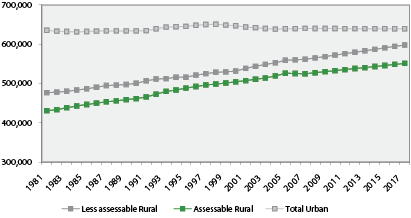
(Source: NISRA - NINIS website: http://www.ninis.nisra.gov.uk/)
2.13 The high levels of car ownership has clear implications for the sustainability of rural areas: environmentally, the government has a legal obligation to cut carbon emissions; economically, there are, for example, significant individual costs in terms of fuel prices, maintenance and longer distances travelled; socially, declining services undermines the fabric and viability of rural communities coupled with a growing trend of migration from urban areas and an aging profile. If transport is to contribute to sustainable rural communities, then the challenges need understood and tackled through the three lenses, not just the environmental.
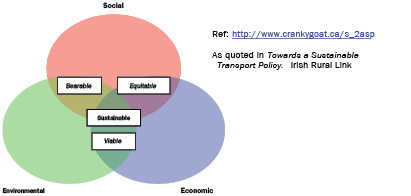
2.14 In summary the reality of rural transport in Northern Ireland as experienced by many rural people on a daily basis is as follows:
2.15 We offer three case studies below to illustrate some of the issues facing rural dwellers in accessing transport.
Pearse Boyle – Community Worker in Ballymoney
As a person with a disability living in rural South Derry and working in Ballymoney Pearse has direct experience of the problems linked to rural transport. Pearse used his car to commute everyday but due to an accident last year was unable to drive to work. This posed a serious barrier in that the only option open to Pearse if he wanted to maintain his job was a daily return taxi journey which cost £75, the cost of which Pearse met himself until he could no longer afford it. There was no rural accessible transport option for Pearse to utilise and given the cost of taxis he was forced to give up his job. Recently Pearse has moved to Magherafelt and has found suitable employment. The fact remains however that if Pearse wanted to be able to work and maintain a social life he had no other option than to move to Magherafelt due to the lack of a rural accessible transport system.
Gerry Maguire – Maguiresbridge Fermanagh
Gerry Maguire had organised a training event in Limavady for a group of Fermanagh based people with disabilities. The group obviously had to travel to access their training and left Enniskillen early in the morning on a translink bus that was not fully accessible. Rather than being able to travel direct they had to change in Derry, but thankfully the bus from Derry to Limavady was fully accessible. One of the participants revealed that "It was the most accessible bus I was ever on, it was great" However all of the buses used on the return journey were not accessible and this made the journey far from ideal. The random nature of the experience was the key learning in that the journey and experience could vary so greatly with one provider over such a relatively short distance.
Connor and Brid – young people living on the Ards peninsula
Connor and Brid are two young people living in the Ards Peninsula and belong to the TRASH Youth Council. Connor is still at school and Brid is studying in Belfast with a part-time shop in Portaferry. Both struggle with accessing education, employment opportunities and social opportunities due to the lack of public transport and the cost of alternatives such as taxis.
It costs Brid £10 for a return fare on the bus from Portaferry to Belfast where she studies at the college. She has to pay full adult price for a ticket as she is not eligible yet for a student fare. Due to the low number of buses on that route, she has to leave her class early each time in order to catch the bus back to Portaferry to start work.
Connor is still at school but finds that there is little to do in Kircubbin for young people as there is no public transport in the evenings for them to go to Newtownards, for example. He and his friends would walk round and round the village on a loop system until someone gets bored and they all go home.
2.2 To identify the policies, attitudes and technologies likely to underpin a move to more sustainable transport in Northern Ireland
2.21 Accessible Transport has undoubtedly improved over the past 20 years but mainly in urban Northern Ireland. Door to door transport has been extended for urban areas of Belfast and Derry to cover populations of cities and towns of over 10,000 (and would roughly cover a 5-7 mile radius from the centre of each location). This has provided an accessible and affordable transport solution for both the elderly and people with disabilities within urban areas.
Many of the main bus and rail routes are fully accessible for people with disabilities e.g. introduction of low floor buses and if contacted Translink will try and ensure that an accessible bus is on the route a person with a disability is planning to use.
2.22 The Rural Transport Fund supports transport services in rural areas through the Sub-Regional Transport Plan. The Fund subsidises socially necessary rural services provided by Translink which otherwise would be economically unviable; and provides funding for Rural Community Transport Partnerships that offer a range of complementary services to the public transport network for their members.
Currently the Fund supports 43 rural bus routes and 18 Rural Community Transport Partnerships. In 2007/2008 635,000 passenger trips were made on Rural Community Transport Partnership vehicles.
"In 2005/06 the Rural Transport Fund generated over 180,000 passenger journeys for Translink, representing a 13% increase on the previous year. To date, a total of nine RTF services have successfully grown sufficiently to become commercially self-sustainable. Innovative flexible transport schemes have also been initiated in the Newcastle and Enniskillen areas with the support of the RTF. In November 2006, the Fermanagh Rural Rover demand responsive service was improved and extended. Translink also assists the rural community transport sector by the provision, maintenance and administration of 32 minibuses under the Rural Transport Fund. Improvements to public transport information provision, infrastructure and waiting facilities have also been initiated under this scheme." [Translink]
2.23 Some of the challenges facing sustainable rural transport include:
"The yellow bus (ELB) comes in with a few kids on it, the white bus (HSS) comes in with some older people, the blue bus (Ulsterbus) has no one on it and then in comes the community transport bus in the middle of it all."
[Community Transport Worker –
as quote in the Rural Childcare Report for DARD, 2008)
2.3 To make recommendations arising out of the above investigations, and report to the Assembly.
The data shows that the primary mode of transport in rural areas is the car and that this is not a luxury but a life-line in terms of ensuring the viability of rural areas and rural communities. If the environmental imperative is to decrease rural dwellers' dependence on the car, then government policy needs to invest on efficient and effective alternatives for all in rural areas, not just those who cannot access a car, and in ensuring balanced regional development.
[1] 2001 Census
[2] Preston, J.M., Ragie, F., (2007) Accessibility, Mobility and Transport Related Social Exclusion, Journal of Transport Geography, 15(3), 151-160 – As quoted in Irish Rural Link Report (2009)
[3] Commission for Rural Communities, (2008) Thinking about rural transport – Sustainable rural accessibility – is it really possible? , p.5
[4] Comhar SDC (2008) Sustainable Travel and Transport Action Plan: Response to Public Consultation, Dublin: Comhar SDC, available at http://www.comharsdc.ie/_files/Comhar_STTAP_report.pdf
[5] DRD Sub-Regional Transport Plan, p.43
[6] Defining rural is problematic with different government departments using different definitions. In this instance, the East of Northern Ireland covers the Local Government Districts of Antrim, Ards, Ballymena, Banbridge, Carrickfergus, Castlereagh, Craigavon, Down, Larne, Lisburn, Newtownabbey, North Down. The West of Northern Ireland covers the Local Government Districts of Armagh, Ballymoney, Coleraine, Cookstown, Dungannon, Fermanagh, Limavady, Derry, Magherafelt, Moyle, Newry & Mourne, Omagh and Strabane.
[7] Roads Service [2008] Travel Survey for Northern Ireland – 2005-2007, p.10

September 2009
This document is also available on alternative formats. To request a copy in an alternative format or for any other queries please see the "Contact Us" section of this response or visit our website at www.imtac.org.uk.
1 Imtac is a committee of disabled people and older people as well as others including key transport professionals. Our role is to advise Government and others in Northern Ireland on issues that affect the mobility of older people and disabled people.
2 Our aim is to ensure that older people and disabled people have the same opportunities as everyone else to travel when and where they want.
3 Imtac receives support from the Department for Regional Development.
4 Imtac welcomes the opportunity to contribute to the inquiry on sustainable transport. Given other projects such as the review of the Regional Transport Strategy, Public Transport Reform and Local Government reform it is important that we all consider the future direction of transport policy.
5 Any future transport policy must be sustainable in that it meets the needs of all the people of Northern Ireland. Debate to date around sustainable transport has tended to focus on key environmental and economic drivers. This has been reflected in the priorities of the Regional Transport Strategy and subsequent transport plans. Clearly economic factors are crucial to the general prosperity of everyone in society. Given the reality of climate change environmental issues must be given a much greater priority than in the past. However for Imtac the key issue is how a future sustainable transport policy can contribute to a fairer society and reduce inequality by increasing accessibility.
6 Travel is a necessity in the modern world – it enables access to employment, education and training opportunities, to health services and to a social life. For travel to be accessible people need to be able to get where they want to go at a reasonable cost, in reasonable time and with reasonable ease. For too many, including many disabled people and older people, the design of the current transport system does not work. Poor access to transport has major negative impact on the life chances of many in our society.
7 Research has clearly demonstrated the links between social exclusion and transport[1]. It is clear from this research that the unsustainable transport policies of the past 50 years that has made car use easy and convenient has also increased inequality in society. The car has revolutionised mobility for many in this time. As a society we travel further and more often than ever, most of us have choices about how and where we can live and work. Planning policies have adapted to suit car use and travel patterns. Everyday services and activities have been centralised and concentrated and people have to travel further and longer to access them. Long term rises in car usage has been mirrored by and reduction in usage of public transport with a reduction in provision of, and rise in costs of, services. All these developments make travel much more difficult for people without access to a car than for those who have and contributes greatly to inequality in our society.
8 Research clearly shows the link between poor access to a car and inequality for both individuals and entire communities. Impacts include:
9 Research has also identified the barriers that prevent people from travelling. These include:
10 Substantial numbers of people in Northern Ireland have no access to a car. The most recent census figures indicate that 25% of households across Northern Ireland have no access to car. In parts of Northern Ireland, including parts of Belfast, this figure rises to above 50%. Statistics also show that access to a car reduces drastically as people get older.
11 Work undertaken during the development of the Accessible Transport Strategy (ATS)[2] here clearly establishes that disabled people and older people are particularly affected by the design of an unsustainable transport system. The ATS also identified many of barriers listed above as the key barriers to travel for disabled people and older people.
12 Over the past decade policy here has begun to recognise the importance of transport in reducing social inclusion. It has done so without fully understanding the extent or the complexity of the difficulties involved or giving it the priority required. Part of the reason for this is that transport policy alone cannot guarantee people access to key services. Tackling social issues around transport requires a multi-agency approach including those who design and deliver services. Transport services as a whole are fragmented, still delivered by numerous agencies including the education, social service and health sector with little thought to how services join up. Land use planning policies still make access to services much more difficult for those without a car. Finally the sort of flexible transport solutions required to make the transport system more accessible have been limited by a lack of understanding and expertise as well as issues such as an outdated regulatory framework.
13 Despite the weaknesses there have been major improvements since the publication of the Regional Transportation Strategy in 2002 mainly with regard to the substantial investment in frontline services. In terms of physical accessibility the past 10 years has revolutionised our bus and rail services. It is not beyond the realms of possibility that our public transport network will meet current accessibility standards by 2012. However there has been no significant change to the level of services (other than frequency) in the same period. Given that there are other barriers to access apart from physical access mainstream public transport remains out of reach for many (we have the Olympic swimming pool - someone needs to put in the water!).
14 More money than ever has been invested in alternative services aimed at improving access to transport for amongst others older people and disabled people. These services include door2door, rural transport, concessionary fares and Shopmobility. Door2door is a vital service, providing a safety net for many with no other travel option. However Imtac is increasingly concerned about the unrealistic role envisaged for the service by policy makers – it is far from being the solution to the travel needs of disabled people and older people. Door2door is a rationed service based on a first come first served basis. Because of demand trips cannot be guaranteed therefore using it to travel to for instance to work or education is nearly impossible. Other restrictions limit its use for health appointments.
15 As a parallel transport service it is difficult to integrate door2door with mainstream public transport. From an economic perspective it remains an expensive and inefficient way to organise transport. Northern Ireland introduced this type of service at a later date than many other areas of the United Kingdom. When we were introducing door2door many UK local authorities were looking at this type of service in light of broader improvements to public transport recognising the social and economic benefits of encouraging those that can to use mainstream public transport or providing more targeted flexible services. Whilst door2door is a valuable service it is not the foundation for a future sustainable transport policy.
16 People in rural areas without access to a car find travel particularly difficult. The RTS indicated that resources would be directed to looking at a series of demand responsive transport pilots. To date progress has been modest culminating in the pilot of Dial-a-lift services by three Rural Community Transport Partnerships in the past year. Dial-a-lift uses a similar model to that of urban door2door and runs largely in parallel to rather integrated with mainstream public transport. Whilst the service is a welcome development Imtac has doubts about how the model that is currently being used can be part of a longer term sustainable transport policy. Research has previously been undertaken to look at rural transport need in Northern Ireland and the type and level of services that may be achievable here.[3]
17 Concessionary Fares is the other key programme around social inclusion where significant investment has taken place. All older people over 60 have free travel on public transport, as do some disabled people. Other disabled people have half-fare concessions. The cost of travel is a key barrier for people accessing transport. In this regard concessionary fares make a contribution to reducing this barrier. However to avail of the concession people must be able to access the public transport. Statistics show that over 50% of older people do not use the concession, only around 10% of eligible disabled people take up the half-fare concession[4]. Figures obtained by Imtac indicate that only around 20% of pass holders use their pass once a week or more[5]. All the statistics indicate that many older people and disabled people cannot avail of the concessions available because of other issues around accessing public transport. This limits the impact of the programme in reducing social exclusion.
18 Whilst many disabled people and older people still find travel too difficult investment made here in the past 10 years has provided a very solid foundation for moving forward. However if we are to move things forward and maximise the opportunity presented by investment then approaches must change. The current Review of the RDS, RTS, Public Transport and Local Government reform all mean that we have a unique opportunity to do this.
19 The priority for Imtac in developing a future sustainable transport policy is reducing social exclusion. However many of the measures we advocate will make using public transport more attractive for others and will meet both economic and environmental priorities as well. Imtac sees the following as priorities:
20 Physical access to public transport has improved hugely over the past 10 years. The focus in the next 10 years should be making it easier people to get access to these services. Debate on this topic has tended to focus on how we can encourage people move from cars to public transport and measures to achieve this include faster, more frequent services, bus priority measures and better park and ride facilities. However a sustainable transport policy should also consider how access to public transport services can be improved for individuals and communities who have traditionally found access difficult. One way of doing this is to increase the public transport network to include more flexible localised services in areas with poor public transport provision. Flexible services then link to key public transport routes whilst improving access to local services. Rural areas are particularly affected but some urban areas including many communities in Belfast have poor access to public transport.
21 There are a number of examples of this approach from across the UK. In Manchester for example Local Link is a service for communities with poor public transport provision. The service is door-to-door and open to everyone living in the area. It provides access to local facilities but also links to key public transport facilities nearby such as bus corridors, railway stations and tram halt. This enables people from the local area to link into the wider transport system. Hampshire County Council has looked at a number of flexible transport options for rural communities. Cango is a flexible bus service that services villages around towns such as Andover. The service runs at set times but people can phone in advance to arrange a pick up from an agreed point or in cases where people can't reach the route the bus will divert to pick up passengers. Once in the town the bus stops at key local facilities such as the hospital, supermarket and wider public transport links.
22 Flexible services represent an opportunity to maximise the wider investment in bus and rail services by ensuring that more people have access to services. These services also represent a more efficient, integrated and inclusive way of travel than traditional door-to-door services. Even with improved services some disabled people will still require the traditional door-to-door services but demand for this service should reduce significantly.
23 As well as improved access to services much more needs to be done in future to support and encourage people to travel more. Better and more accessible information about transport is a vital component of this. Individual support may also be required. With regard to disabled people there are numerous examples of travel training programmes designed to help build people's confidence to use public transport. Other initiatives that can encourage people to use services include better training for staff providing services. Despite many of these issues being recognised by the ATS to date little has been done to progress actions in these areas.
24 Again there are examples from Great Britain of initiatives aimed at supporting people to use public transport. For example Merseytravel has created a number of travel centres across Liverpool where people can access information and advice about travel. Travel centres are not only available in the city centre but have also been targeted at areas of deprivation in the city recognising the link between transport and social exclusion. After a review of London Dial-a-Ride Transport for London decided to increase funding for programmes designed to give disabled people the confidence to use public transport. By using a small amount of investment TfL hope to maximise substantial investment made in accessible public transport as well as reducing demand on an overstretched Dial-a-ride service.
25 Much work has been done here in recent years improving safety and security on public transport and around stations. This work needs to continue with priority given to providing safe and accessible pedestrian routes to and from stops and stations. Road Safety programmes must also focus on reducing the impact of traffic on communities which will again make it safer for people wanting to use public transport.
26 Improving access to public transport should improve access to the concessionary fares scheme. Opportunities to extend the scheme to include free travel for eligible disabled people should be explored. However thought should also be given to other measures aimed at reducing the cost of travel. In some parts of the UK local authorities offer travel vouchers to people who cannot access public transport. Travel vouchers can be used to help pay the cost of local taxi services for instance[6]. Wider measures to look at reducing the cost of public transport should be looked at including integrated ticketing for all services - an Oyster Card for Northern Ireland?
27 Complementing all the measures listed above in developing a sustainable transport policy we must also focus on reducing the need to travel. Reducing the need to travel requires a cross departmental approach as transport policy alone cannot change how services are delivered. The following a key to reducing the need to travel:
28 Whilst Imtac supports measures to develop sustainable transport including encouraging a shift from car use to use of public transport, walking or cycling there needs to be recognition that this represents a greater challenge for many disabled people and older people. Many disabled people and older people currently rely on the car for mobility and even with improvements to the wider transport system this is likely to continue into the future. When Government is considering future measures to kerb use of the private car consideration must be made of those disabled people and older people who have no other choice but to use a car.
29 It is clear to Imtac that developing a sustainable transport policy will require a change in approach by Government as a whole here. Firstly as well as traditional economic and environmental debates around transport we must add a greater social element to transport planning. Accessibility for people who have difficulty accessing transport must be built in to future sustainable transport planning. Secondly planning must become more sophisticated and detailed in the future perhaps looking at the Local Transport Planning model used in GB. Finally other Government Departments must give a greater emphasis to transport when planning, designing and delivering services. We must also look at using existing transport resources more efficiently including those currently provided by health, education and social services.
30 On a final point the current and future financial situation means that investment by Government will be much more limited than in previous years. Not only does this mean that we must use existing resources more wisely, it means we must also look at current services and assess whether they represent an efficient use of a limited resource. This will mean difficult choices for both Government but also key stakeholders such as Imtac. For example with the introduction of accessible public transport and more flexible services would we have to change the eligibility of schemes like door2door and the Blue Badge to ensure only those that need it most can access them. With regard to concessionary fares can we afford to pay for peoples travel to and from work every day or do we have to look at measures such as means testing or a 9.30am start time to ensure the concession is targeted at people that need it most.
31 Imtac welcomes the opportunity to contribute to the Regional Development Committee inquiry into sustainable transport. We recognise the importance of developing more sustainable travel in our society reducing dependency on the car and encouraging greater use of sustainable modes of travel such as public transport, walking and cycling. However we must also make improving accessibility for people and communities who find travel difficult a key priority in any future sustainable transport plan.
32 If you have a query about this document or would like it in another format you can contact us at:
Enterprise House
55-59 Adelaide Street
Belfast
BT2 8FE
Telephone: 028 9072 6020
Textphone: 028 9072 6016
Fax: 028 9024 5500
Email: info@imtac.org.uk
Website: www.imtac.org.uk
[1] A good summary of research into this area is provided by "Making the connections: Final report on transport and social exclusion 2003" published by the Social Exclusion Unit
[2] Accessible Transport Strategy for Northern Ireland – DRD 2005
[3] "Regional Transportation Strategy – Issues of Rural Transport Need" prepared for DRD by TAS Partnership
[4] Policy Review of the Northern Ireland Concessionary Fares Scheme – DRD Jan 2007
[5] Figures pre-date the extension to people aged between 60-64
[6] For information on travel vouchers in Greater Manchester visit
http://www.gmpte.com/journey_planning/tickets_travel_vouchers.cfm?submenuheader=1
Committee Clerk
Parliament Buildings
Belfast
BT4 3XX
10 September 2009
Dear Roisin,
Given the Energy Saving Trust's interest in sustainable transport, we would welcome the opportunity to give oral evidence to the committee. We appreciate that the deadline has passed, nevertheless we feel that the Energy Saving Trust has an important contribution to the inquiry.
Going forward, the aim of the Energy Saving Trust is to help encourage Government to increase funding for consumer transport advice and information; help encourage car forecourts and manufacturers to clearly sell the benefits of more efficient cars; and to sign-post drivers to the Energy Saving Trust advice centre.
Choosing the lowest carbon car in the class could save CO2 by 25%. Driving more efficiently can save up to 16% of CO2, and car sharing at least 50%. Policies that reduce the need to travel will reduce energy use and reduce the demand for all fuel sources and therefore should be prioritised.
In this context it is essential that independent, authoritative advice about reducing emissions from transport use is widely available to fleet operators and individual consumers.
That's where the Energy Saving Trust comes in. As the leading non-profit organisation set up to address the damaging effects of climate change, the Energy Saving Trust provides advice on the efficient use of energy for the transport sector, as well as energy efficiency and renewables.
The recent paper published by the Department for Regional Development (July 2009), on reducing greenhouse gases from road transport, acknowledged that transport is one of the largest sources of carbon dioxide emissions, and likely to increase.
I hope this inquiry will be able to find a slot for the Energy Saving Trust to provide oral evidence.
I look forward to a positive response from you in the near future.
Yours sincerely

Head of Energy Saving Trust
Northern Ireland

September 2009
Submitted by:
Steven Paterson
Director Sustrans Northern Ireland
Ground Floor
Premier Business Centres
20 Adelaide Street
Belfast BT2 8GD
Our vision is a world in which people choose to travel in ways that benefit their health and the environment. We work on practical, innovative solutions to the transport challenges facing us all. Sustrans is the charity behind the award winning National Cycle Network, Safe Routes to Schools, Bike It, TravelSmart, Active Travel, Connect2 and Liveable Neighbourhoods, all projects that are changing our world one mile at a time.
To find out more visit or call: www.sustrans.org.uk 0845 113 00 65
Sustrans Northern Ireland
Ground Floor
Premier Business Centres
20 Adelaide Street
Belfast
BT2 8GD
© Sustrans, September 2009
Registered Charity No. 326550 (England and Wales) SCO39263 (Scotland)
VAT Registration No. 416740656
Sustrans is pleased to be able make a submission to the Northern Ireland Assembly Committee for Regional Development Inquiry into Sustainable Transport. We have thirty years' experience of practical promotion of walking and cycling across the UK, and in Northern Ireland we have worked closely for more than a decade with several government departments and communities in the practical delivery of projects that change travel behaviour and advance understanding of the role of active travel in healthy living, to inform policy making and establish effective programmes.
1. To explore and clarify the social, environmental and economic aspects of sustainable transport;
2. To identify the policies, attitudes and technologies likely to underpin a move to more sustainable transport in Northern Ireland; and
3. To make recommendations arising out of the above investigations, and report to the Assembly.
1.1 We are now seven years into the NI Government's Regional Transportation Strategy for 2002-2012, with its intention to create a modern, safe and efficient transport system. However, currently public transport usage is the lowest in the UK, while the share of trips made by car is the highest in the UK and levels of walking and cycling for local journeys are lower than in the rest of the UK. Traffic levels and resulting congestion have now reached unprecedented levels and are estimated to cost the NI economy £250 million per year[1].
1.2 In Northern Ireland the cost attributable to lack of physical activity includes over 2,100 deaths per annum, equivalent to over 18,000 life years lost, and 1.2 million working days lost each year. The cost of physical activity and obesity to the NI Economy in 2010 is likely to exceed £500m.[2]
1.3 The Northern Ireland Assembly seems to be focussed on tackling congestion on our strategic roads – the motorways and 'A' roads – but this misses the bigger picture. Research by the UK government has revealed that almost 90% of congestion is in towns and cities[3], making the motorways and 'A' roads wider just moves traffic into alreadycongested urban areas just that little bit faster. The planned £3.1 billion investment programme to improve and expand Northern Ireland's road network will do little to address the growing concerns of congestion, worsening health, transport inequalities and climate change.
1.4 In Northern Ireland 63% of all journeys are less than five miles (a 30 minute bike ride) yet investment in cycling is very low.
1.5 UK Government studies show that people are far more annoyed by urban traffic than by hold-ups on the motorways[4]. Sustainable transport solutions should be made in cities, towns and villages.
1.6 There are important social equity issues around transport. There are now 900,000 vehicles registered in NI for a population of 1.7 million yet 50% of households in areas of Belfast and 20% of rural households do not have access to a motor vehicle. 39% of women in NI do not have a full driving licence.
1.7 Amongst the poorest fifth of households, those who do own cars spend nearly a quarter of their income on the cost of motoring.[5] A family is officially defined as suffering 'fuel poverty' if heating their house costs more than 10% of their income[6]. Although there is no similar official definition of 'transport poverty', that is what these families are experiencing.
1.8 Despite owning the fewest cars, the poorest households are the most exposed to death or injury by cars, and this is especially true of children[7].
1.9 "Doing nothing is no longer an option", according to the Chairman of the Royal Commission on Environmental Pollution[8]. Professor Sir John Lawton says that technological improvements alone will not be enough to deliver the scale of emissions reductions we need to see from the transport sector. "Behaviour change is vital", he stresses, "and that means all of us travelling less far, in more energy efficient ways and at slower speeds".
1.10 Northern Ireland's per capita greenhouse gas (GHG) emissions of 12.83 tonnes per annum compares badly with the UK average of 10.48 tonnes. While the UK as a whole has achieved a greenhouse gas emissions decrease of 15.7% since 1990, Northern Ireland's total has decreased by only 5.8%. Much of the differences between the UK and Northern Ireland averages are down to our transport (and agriculture) emissions.
1.11 While domestic transport emissions in the UK increased by 9% from 1990 to 2006, in Northern Ireland they increased by a staggering 51%. The transport sector now accounts for 25% of Northern Ireland's total GHG emissions, much to do with increasing car use. The proposed massive road building programme will contribute to more, longer distance journeys so raising GHG emissions.
1.12 One main reason transport emissions are growing is because we're travelling longer distances. For example, between 1985 and 2005 average annual mileage per head (excluding foreign travel) increased by 35%, though the number of trips was broadly unchanged. This is the result of the interaction of transport policies with land use planning. Tackling small journeys will bring big rewards. Car journeys under five miles account for 20% of passenger transport CO2 – shifting some of these to walking and cycling will also help cut congestion and obesity and improve health too.
1.13 The 2007 Foresight Tackling Obesities report highlighted the scale of our obesity problem. Unless we act decisively and immediately, by 2050 almost 60% of the UK population could be obese, with the economic cost of overweight and obesity reaching £49.9 billion at today's prices. Obesity alone justifies a shift in transport policy from sedentary to active travel, but the benefits of physical activity go much wider.
1.14 The Health and Social Wellbeing Survey 2005-06 found that a quarter of all men and 23% of women in Northern Ireland were obese. The survey findings also show that this represents an overall increase of 26% in adult obesity since 1997.
1.15 The World Health Organisation recommends adults undertake 30 minutes of physical activity everyday and evidence shows that only 30% of people take the recommended daily amount in Northern Ireland[9]. The Chief Medical officer for England says "For most people, the easiest and most acceptable forms of physical activity are those that can be incorporated into everyday life. Examples include walking or cycling instead of travelling by car….."[10]
1.16 In our view, a key document from within the UK is the guidance published in 2007 by the National Institute for Health and Clinical Excellence (NICE) on physical activity and the environment. NICE acknowledged the crucial role of the physical environment in supporting or deterring physical activity, and in a typically thorough evidence review looked at over 94,000 published papers. The strongest evidence base NICE could find came from active travel – walking and cycling – and as a result the majority of the recommendations in their guidance relate to intervention in this area.[11]
1.17 While road transport plays a crucial role in delivering economic prosperity to the UK economy it is now widely recognised that the building of roads generates extra traffic with resulting negative congestion, health, social and environmental effects. Sustainable transport solutions lay in improving transport choice and creating local environments that encourage walking, cycling and the use of public transport.
1.18 Making improvements to walking and cycling networks and of behavioural programmes to encourage increased uptake of walking, cycling and public transport are highly cost efficient, providing significantly better cost benefit ratios than road building schemes.
1.19 The three English Sustainable Travel Demonstration Towns of Darlington, Peterborough and Worcestershire shared a £10 million fund established by the Department for Transport 2004-2008 to tackle car use and traffic congestion. At the end of the five-year project, car use had fallen by up to 9 per cent across the three towns, As car travel fell, use of more active and sustainable forms of transport has increased across all three demonstration towns.[12]
1.20 Furthermore Sustrans has carried out research with the English Universities of Bolton and Leeds on the Safe Routes to Schools programme which shows a typical benefit to cost ratio of upto 38:1 compared to a typical ratio of 3:1 for other transport schemes such as road or rail[13].
1.21 The above demonstrates the value of investment in walking and cycling schemes and behavioural programmes in comparison to other forms of transport investment.
sustainable transport in Northern Ireland.
2.1 Modal shift away from car use to walking, cycling and public transport has been proven in a number of projects in the UK. For example:
2.2 The Sustrans Rural Safe routes to Schools project worked with 18 schools to encourage walking and cycling. The results are very impressive with:
2.3 Sustrans Bike it programme in schools sees pupils cycling at least once a week rise in one year from 14% to 26% and cycling everyday rise from 4% to 8%. Sustrans recommend every child has a Safe Route to School so they can chose to walk and cycle.
2.4 Sustrans TravelSmart programmes have achieved reductions in car trips averaging more than 10% together with significant increases in levels of walking, cycling and public transport use. The programmes are based on a process known as Individualised Travel Marketing (ITM) and works with households offering tailor-made information and support, enabling people to walk, cycle and use public transport more often. It delivers measurable and sustained reductions in car use by encouraging people to make a few changes to their daily travel choices when and where it suits them best.
2.5 On road cycle training amongst young people encourages more cycling. Bikeability is the brand name for the UK National Cycle Training Standard. It involves 3 levels of cycle training including "on road" training whereas in NI Cycle Proficiency is usually carried out in playgrounds. The results of Bikeability are most encouraging[14]:
2.6 Climate Change should now be considered as a key consideration when determining transport policy. The UK Government's Stern Review calculated that the dangers of unabated climate change would be equivalent to at least 5% of GDP each year. However, when more recent scientific evidence is included in the models, the Review estimates that the dangers could be equivalent to 20% of GDP or more. In contrast, the costs of action to reduce greenhouse gas emissions to avoid the worst impacts of climate change can be limited to around 1% of global GDP each year. The central message is that reducing emissions today will make us better off in the future: one model predicts benefits of up to $2.5 trillion each year if the world shifts to a low carbon path.
2.7 A review of the planning system in Northern Ireland is currently being conducted while a revised policy for development in rural areas was recently released. We must increase the density of housing in major settlements and concentrate future rural development in established settlements to reduce individuals' need to travel by car and to provide a larger customer base for public transport operators. Environments that encourage walking and cycling must be created and public transport links should be incorporated into new developments, with new bus stops and services provided in growing villages and towns in a pro-active and innovative manner.
We would recommend the Inquiry ensures the DRD Regional Transportation Strategy:
3.1 Sets targets for the percentage of trips made by each travel mode, specifically aiming to reduce car use, set ambitious targets for a growth in walking and cycling and public transport – and ensure they are met.
3.2 Publishes a coherent strategy for growth in walking and cycling, based on experience of what works; monitor and performance-manage progress; give transport departments a clear public health objective, and make clear the roles of other government departments and other partners.
3.3 Commits 10% of transport budgets to walking and cycling immediately, and in future ensure that transport funds are allocated proportionate to the new, ambitious target levels.
3.4 Sets targets to reduce CO2 emissions from transport, starting immediately and increasing over time, with measures identified to ensure meeting these targets.
3.5 Delivers land use planning that discourages car use and facilitates sustainable travel.
3.6 Reappraises our road network setting a hierarchy of roads users, with active and public transport at the top and single occupancy private car use at the bottom. Roads need to be redesigned to reflect this.
3.7 Creates safe, attractive walking and cycling conditions, with coherent high quality networks linking all everyday destinations, so that walking and cycling are faster and more convenient than motor travel, backed up by individualised travel marketing, school and workplace travel plans, practical walking promotion programmes and high quality cycle training
3.8 Completes the National Cycle Network. The National Cycle Network consists of over 12,000 miles of routes across the UK, a third of which is traffic-free. 55% of people now live within a mile of the Network with many parts of the network extending into the heart of communities throughout the UK, giving people the choice of healthy, environmentally friendly travel for many more of their everyday journeys. 2008 was the ninth consecutive year that the number of trips across the National Cycle Network had increased.
3.9 Makes 20mph or lower speed limits the norm for residential streets and those used by shoppers, tourists and others, close to schools or public buildings, or important for walking and cycling or children's play. In urban areas only the busiest strategic traffic routes should now qualify for higher speed limits
3.10 Offers Bikeability on road cycle training to every child in Northern Ireland.
3.11 Tackles bad driving, through improved driver training and awareness campaigns, backed by stronger and better enforced traffic laws
3.12 Works with DOE to ensure reduced road casualties rates are linked to increases in walking and cycling.
3.13 'Health checks' every transport and land use decision, focusing on the potential impact on levels of walking and cycling and other aspects of health; invest public money to the benefit of public health, and reject proposals whose impact on walking and cycling will not be positive
3.14 Invests in a national 'smarter choices' programme. Smarter choices are proven successful techniques for influencing people's travel behaviour towards more sustainable options such as encouraging school, workplace and individualised travel planning. They also seek to improve public transport and marketing services such as travel awareness campaigns, setting up websites for car share schemes, supporting car clubs and encouraging teleworking.
3.15 Encourages a partnership approach (both cross-departmental and linking to communities, NGO's, private sector) to facilitate active travel.
3.16 Sustrans feels that active travel should be included as a key policy goal to ensure that all investments support rather than undermine it. Sustrans has joined over 100 organisations in the 'Promote Public Health: Take Action on Active Travel' policy call[15].
Sustrans views transport as a crucial issue as the NI Assembly aims to deliver a prosperous, healthy, safe, inclusive Northern Ireland. We think there is a major change necessary in the priorities for transport and we would be pleased to offer oral evidence to the Committee's Inquiry.
[1] PA Consulting, 2008. "Northern Ireland economy burns £250m per year in roads "slow lane""
[2] Investing for Health, DHSSPS, 2002
[3] Eddington, R. (2006) The Eddington Transport Study, page 79. Department for Transport, London.
[4] Lyons, G., Goodwin, P., Hanly, M., Dudley, G., Chatterjee, K., Anable, J., Wiltshire, P. and Susilo, Y. (2008). Public attitudes to transport: Knowledge review of existing evidence. Department for Transport, London, July. Available online at http://www.dft.gov.uk/pgr/scienceresearch/social/evidence.pdf
[5] Social Exclusion Unit, 2003, Making the Connections: Final Report on Transport and Social Exclusion, 145pp, p.3
[6] Scottish Government, 2002, The Scottish Fuel Poverty Statement, at
http://www.scotland.gov.uk/Publications/2002/08/15258/9955, accessed 30/10/2007
[7] Institute for Public Policy Research, 2002, Streets ahead: Safe and liveable streets for children
[8] Quoted in Sustrans Low Carbon Information sheet: http://www.sustrans.org.uk/webfiles/Info_sheets/ff44.pdf
[9]Northern Ireland Health and Wellbeing Survey, 2005/06, available at http://archive.nics.gov.uk/dfp/070129b-dfp.htm
[10] At least five a week; the Chief Medical Officer's report on physical activity, 2004
[11] National Institute for Health and Clinical Excellence. Promoting and creating built or natural environments that encourage and support physical activity. London. NICE 2007 http://www.nice.org.uk/Guidance/PH8/QuickRefGuide/pdf/English
[12]Sustrans press release http://www.sustrans.org.uk/about-sustrans/media/news-releases/car-use-down-in-english-towns
[14] http://www.letstravelwise.org/newsarticle.php?articleID=1078
[15] Take Action on Active Travel http://www.adph.org.uk/downloads/policies/Take_action_on_active_travel.pdf

Clerk
Committee for Regional Development
Parliament Buildings
Belfast
BT4 3XX
Committee Office
Parliament Buildings
Stormont
Belfast
BT4 3XX
committee.ofmdfm@niassembly.gov.uk
Tel:
Fax:
Date: 19 November 2009
Dear [Committee Clerk]
At its meeting on 18 November 2009, the Committee for the Office of the First Minister and deputy First Minister considered your invitation to make a submission in relation to your inquiry into sustainable transport.
The Committee agreed that although they would not be making a response they wished to highlight to your Committee that the Strategic Investment Board should be asked to provide a written submission as part of your current inquiry into the issue of sustainable transport.
Yours sincerely
Clerk to the Committee

Room 412, Parliament Buildings, Stormont, Belfast BT4 3XX
To: [Clerk to the Committee for Regional Development]
From: [Clerk to the Committee for Social Development]
Date: 25 November 2009
Subject: Sustainable Transport Inquiry
At its meeting of 19 November 2009, the Committee for Social Development considered a memo dated 4 November 2009 in relation to the Committee for Regional Development in relation to the Sustainable Transport Inquiry.
The Committee agreed that it would forward this correspondence to the Department and request that the Committee be copied into the Department's submission to the Inquiry.
The Committee also agreed that the Clerk should forward a copy of the Inquiry Report into Town Centre Regeneration[1] to the Committee for Regional Development for consideration as part of their Inquiry.
Committee Clerk
ENC
[1] http://archive.niassembly.gov.uk/social/2007mandate/reports/report_14_09_10R.htm

Parliament Buildings
Tel:
Fax:
To: Clerk to the Committee for Regional Development
From: Clerk to the Committee for Education
Date: 26 November 2009
Subject: Sustainable Transport Inquiry
Ref: 521/09/I/04
Please see attached the response from the Department of Education with regard to your correspondence of 4 November 2009 on sustainable transport in education.
The Committee for Education noted this response at its meeting on 25 November 2009.
Regards
Committee Clerk
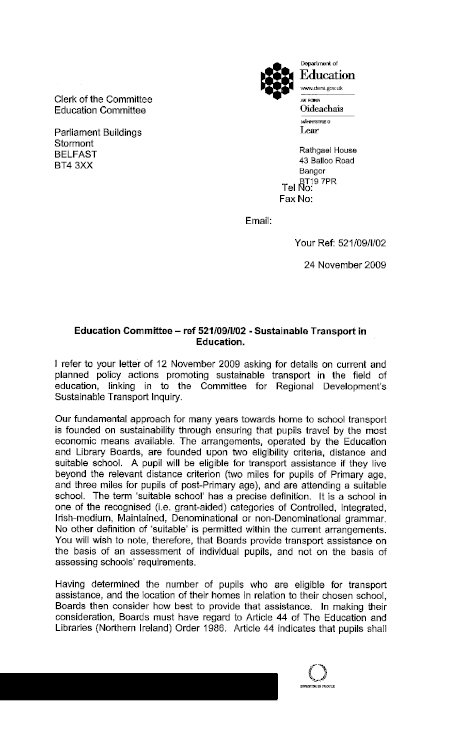
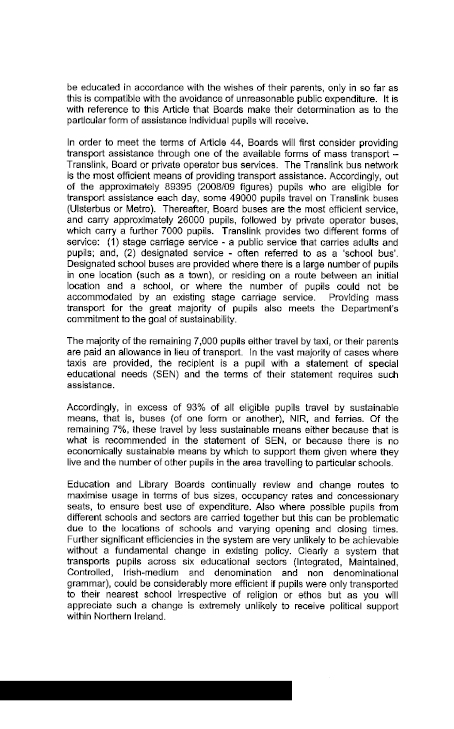
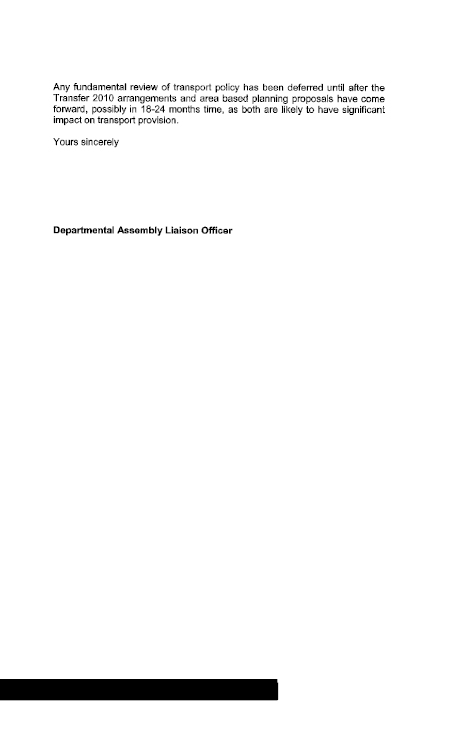

WWF Northern Ireland
2nd Floor, 7 Exchange Place
Belfast, Northern Ireland
BT1 2NA
tel: 028 9033 2869
fax: 028 9033 3401
northernireland@wwf.org.uk
wwf.org.uk/northernireland
Parliament Buildings,
Stormont,
Belfast,
BT4 3XX
2 September 2009
Dear
WWF Northern Ireland welcomes the Regional Development Committee's inquiry into Sustainable Transport and appreciates the opportunity to comment on this very important piece of work.
WWF Northern Ireland is part of the largest independent conservation organisation in the world which operates in over 90 countries. WWF is a challenging, constructive, science-based organisation that addresses issues from the survival of species and habitats to climate change, sustainable business and environmental education. WWF has some five million supporters worldwide and approximately 90% of our income derives from voluntary sources such as people and the business community.
WWF works to
for the benefit of people and nature.
If you have a further queries on this submission please do not hesitate to contact me.
Yours sincerely
Policy Officer WWF Northern Ireland
It is important to point out that there will be some overlap between the different aspects highlighted (social, environmental and economic) of sustainable transport, and WWF Northern Ireland regards it as important that the additional benefits of moving to a much more sustainable transport system be fully considered, in the round, as they will likely be felt by more than one department. In this context a narrow approach, limited in terms of departmental responsibilities, is not the best way of looking at this issue.
If everyone in the world consumed natural resources and generated Carbon Dioxide (CO2) at the rate we do in Europe/UK/Ireland/Northern Ireland, we would need three planets to support us. The impacts of this unsustainable consumption, which include climate change, deforestation and biodiversity loss, will have potentially devastating consequences on both humans and the natural world. WWF has a vision for a One Planet Future - a world in which people and nature thrive within their fair share of the Earth's natural resources. In order to achieve this, amongst other things, we need to reduce our consumption of fossil fuels through a combination of reducing demand, greater energy efficiency and ensuring greater use of renewable energy sources.
The trend of declining reserves coupled with increasing demand for oil, and all the economic, social and environmental implications that result, should ensure this shift is achieved as a matter of urgency, though there is little sign of it yet, even though the International Energy Agency[1] have said
"The world's energy system is at a crossroads. Current global trends in energy supply and consumption are patently unsustainable – environmentally, economically and socially. But that can – and must – be altered; there's still time to change the road were on"
In the EU, transport is the sector with the largest demand for energy, accounting for 31% of total final energy consumption, of which road transport accounts for 85%[2]. Emissions from road transport represented 29.4% of Northern Ireland's CO2 emissions in 2006, an increase of 49.5% since 1990, and second only to energy production (35%)[3]. By contrast, road transport represents only 21% of the UK's total CO2 emissions and grew by only 10% since 1990, so there is clearly a disproportionate problem in Northern Ireland.(3) Passenger cars account for around half of all transport-related carbon emissions and at both a UK level and a Northern Ireland level, around 15% of an individual's ecological footprint is attributable to personal transport[4]. Clearly we need to change our travel patterns, if we are to achieve a One Planet Future[5].
Generally, Northern Ireland's current system of energy production and consumption is wholly unsustainable, not least because of the volatility in oil prices, but also because of our over reliance on imported fossil fuels - with approximately 99% of our primary energy needs met from imports[6] - and the issues surrounding peak oil, diminishing oil resources and increasing demand. This is particularly the case in the transport sector, where liquid hydrocarbon fuels derived from crude oil provide 95% of the primary energy consumed in the transport sector worldwide[7]. There is no other sector which is so utterly reliant on a single source of primary energy. Accounting for the volatility in the price of oil, as illustrated by the variation in oil price in 2008 from $147 a barrel in July to approximately $40 a barrel by the end of 2008, as well as the issues surrounding peak oil, most notable the trend for increasing demand and decreasing availability, this position is clearly unsustainable.
The Department of Finance and Personnel has a very important role, particularly in relation to the strategic investment plans for Northern Ireland's transport system which are exacerbating rather than ameliorating the existing problems. The draft Investment Strategy says (page 12) that there will be £195.3 million spent on public transport 2008-11 and £611.8 million spent on roads 2008-11. According to the indicative budgets for the period 2011/12-2017/18 a total of £3,095 million will be spent on roads and £725 million on public transport. WWF Northern Ireland views this balance, whereby approximately three quarters of all of money is allocated for road building and approximately one third allocated for public transport as, at best, inappropriate as it compounds an existing problem, namely the inadequate provision of alternatives to car use, and is likely to make the achievement of Northern Ireland's target to reduce GHG emissions by 25% by 2025 much more difficult to achieve.
This contrasts with the higher priority given to public transport in the Republic of Ireland which in the 2007-2013 National Development Plan (NDP) pledged just under €13 billion for public transport out of a total of €33 billion on infrastructure. There is an even sharper contrast with the plans announced by the Danish government in December 2008 of a "green traffic initiative" featuring infrastructure investments and transport measures costing DKr150bn (€20bn) over the next decade. According to the Danish plan, about two-thirds of the total will be spent on "renovating, improving and developing the railway network" with the aim of converting motorists to public transport. High emissions charges, road pricing, and financial incentives for fuel-efficiency are among a raft of additional measures. Similar strategic thinking and investment in greater public transport would be welcome in Northern Ireland.
WWF Northern Ireland recommends that at least 50% of future transport budgets be spent on public transport. This increased spending needs to be accounted for not only in the next Programme For Government but also the Regional Transportation Strategy (RTS) and the Regional Development Strategy (RDS). With the upcoming review of the RTS and RDS and the continued implementation of the Programme for Government 2009-2012 there is a clear and urgent need for more integrated decision making and co-operation as decisions likely to be made in the coming year will have a significant influence on Northern Ireland's transport system for many years to come.
It is important to note that the shortcomings in our transport system also cost us money, as was illustrated by PA Consulting, who claimed that congestion costs the Northern Ireland economy over £250 million a year[8].
It seems clear therefore that avoiding and/or reducing some of the costs of unsustainable transport (including congestion, pollution and negative health impacts) while also saving money, and creating jobs by investing in the move to a more sustainable transport system, offers a number of potential win-win opportunities.
The need for and benefits of greater investment in public transport was also highlighted by the PricewaterhouseCoopers report "Bridging the Gap"[9] which found that the £80 million investment in new rolling stock and station refurbishment for Northern Ireland Railways
"helped to drive a 60% increase in usage since 2002"
and that the change to Metro was
"the catalyst for a 15% increase in bus ridership in Greater Belfast".
It seems clear, therefore, that increasing investment in public transport works - a very significant point given that the report also found that
"On a per capita basis, England, Scotland, Wales and the Republic of Ireland have been investing at least twice as much as Northern Ireland in public transport (and in the case of Scotland five times as much)."
Climate change has often been described as the greatest threat we face. The Secretary General of the United Nations Ban Ki-moon said[10]
"Climate change threatens the entire human family. Yet it also provides an economic opportunity to come together and forge a collective response to a global problem."
In introducing the legislative consent motion dealing with Northern Ireland's involvement in the UK Climate Change Bill in the Assembly on Monday 10th December 2007 the former Environment Minister Arlene Foster said
"it is now accepted that climate change is the greatest environmental challenge faced by the world today."
Some of the most compelling evidence of climate change has come from the work of the UN Intergovernmental Panel on Climate Change (IPCC). The IPCC Fourth Assessment Report in 2007 which involved over 3,800 scientists and six years of work found that
"Warming of the climate is unequivocal"
and that
"Most of the observed increase in global average temperatures since the mid-20th century is very likely due to the observed increase in anthropogenic GHG concentrations".[11]
Many scientific umbrella bodies have accepted the IPCC's position (that most of the observed warming in the last 50 years is likely to have been due to the increase in GHG emissions) including the Science Academies of Brazil, Canada, China, France, Germany, India, Italy, Japan, Russia, the United Kingdom and USA, as well as the US National Academy of Sciences, the American Meteorological Society, the American Geophysical Union and the American Association for the Advancement of Science (AAAS).
Northern Ireland's per capita greenhouse gas (GHG) emissions of 12.83 tonnes per annum compares badly with the UK average of 10.48 tonnes[12]. While the UK as a whole has achieved a greenhouse gas emissions decrease of 15.7% since 1990, Northern Ireland's total has decreased by only 5.8%[13], in part it seems because of the high level of emissions in Northern Ireland from transport and agriculture.
On average between 2005 and 2007 70% of all journeys in Northern Ireland were made by car, with public transport accounting for only 5.5% of all journeys made in the same period[14]
Emissions from road transport represented 29.4% of Northern Ireland's CO2 emissions in 2006, an increase of 49.5% since 1990, and second only to energy production (35%)[15]. By comparison transport emissions in England increased by only 10% since 1990. It therefore seems clear that Northern Ireland has a disproportionate problem in relation to transport which urgently needs to be tackled.
It is worth noting that the Committee on Climate Change's first report, released in December 2008, also includes an analysis of what opportunities exist for making emission reductions in Northern Ireland. It states in Northern Ireland more efficient vehicles and new transport fuels could deliver reductions of up to 1 MTCO2e (Million tonnes of carbon dioxide equivalent) in 2020, so there is potential for significant reductions in transport emissions. For example, research by the Tyndall Centre for Climate Change suggests that if we were to enforce the current 70 mph speed limit there would be a 3% reduction in greenhouse gas emissions from road transport.
The use of alternative fuel sources, electricity in particular, for vehicles could also help reduce these emissions, especially if the electricity were generated from a renewable source, such as wind power, thereby offering a completely green cycle for the fuel. WWF's book "Plugged In:The End of the Oil Age" focuses on solutions to our reliance on oil for transportation needs, in particular the electrification of transport. As electric vehicles make use of up to 75% of electricity taken from the grid, they are up to 4 times more efficient than conventional mechanical vehicles where only 18-23% of the energy contained in the fuel is converted into motion.
Some of the other issues surrounding the greater use of electric cars, including the potential implications for the supply network at a UK level, were highlighted in the WWF UK report "Managing Variability"[16]. Amongst other things, the report found that wind power does not need large amounts of extra conventional energy backup to stop the lights going out and that the national grid is able to manage variable input from wind power - the electricity system is already designed to manage fluctuations in supply and demand, as the variations in wind are actually considerably less than the variations in consumer demand for electricity. In both cases, more widespread availability and use of wind actually reduces and smoothes out the problem. The report also found there is a potential added advantage, from the industry's point of view, that greater use of electric cars would enable the more efficient use of electricity as most charging of electric cars is likely to take place during the night when generation generally exceeds demand. Another potential benefit of electric cars is as a form of electrical storage, which can feed back into the grid when needed, though the costs of reversible circuitry would be higher than those of simple 'charging' circuitry. Significantly the report also found that if wind provides around 22% of electricity by 2020 (as modelling for Government suggests) variability costs would increase the domestic electricity price by only about 2%.
The nature of the energy supply system is also an important consideration here as a much higher degree of decentralisation, which is particularly suitable for renewable generation, should enable a more widely distributed renewably powered, recharging network, especially as most of Northern Ireland's wind farms are currently in rural locations.
Support for the electrification of vehicles is growing, for example, the Presidency Conclusions of the Brussels European Council in June 2008[17] supported the greater use of electric cars – see paragraph 39 which said
"Other measures should be rapidly examined, in particular to promote competition in energy markets, promote modernisation of transport systems including the development of alternative technologies, inter alia electric cars"
In April 2009, Ireland's Energy Minister, Eamon Ryan, announced the Irish Government had signed a Memorandum of Understanding with the Electricity Service Board (ESB) and Renault and Nissan which will help Ireland not only realise, but surpass, the target of having 10% of Irish cars (approximately 230,000) fully electric by 2020. The ESB subsequently announced that up to 3,700 new jobs will be created (600 of them directly as a result of the development of the infrastructure for electric cars) and 1,300 outside the company, sustained by ESB, in Ireland because of this commitment.
The UK government has also committed to promoting green cars, as part of a £250 million plan to promote low carbon transport over the next five years. Though Ministers do not expect eligible cars to hit the showrooms until 2011, the strategy includes plans to provide £20 million for charging points and other necessary infrastructure. Gordon Brown has outlined his intention to have all new cars sold in Britain to be electric or hybrid vehicles producing less than 100 g/km of CO2 by 2020. In light of this push for more electric vehicles and the huge potential that exists in Northern Ireland for wind power, Northern Ireland really needs to grasp the opportunity offered by the electrification of the transport network as a matter of urgency and the development of an appropriate recharging network will be fundamental to any such expansion. Other countries have also set targets for either the number or percentage of electric cars including Spain, which aims to have 1 million electric cars by 2014, and Japan which aims to have 50% of cars electrified by 2020.
Hydrogen is another alternative fuel. Though hydrogen powered vehicles that use fuel cells have a lower efficiency (of approximately 40%) they emit only water. Hydrogen buses have been running in Chicago since the mid 1990s.
On top of that, sustainably produced and sourced biofuels offer another potential alternative means of tackling climate change, meeting energy and emissions reduction targets and providing opportunities for the rural and agricultural communities. While WWF Northern Ireland recognises the potential for renewable bioenergy sources to be grown in Northern Ireland it believes the broader impact of their production must be considered and acceptable levels of social and environmental performance in the production of bioenergy among supply chain actors, from growers to end users should all be factored in. For example, there is a risk, especially on a small island, that a biofuel processing plant would create a market demand that cannot be met locally and this would increase pressure for biofuel to be imported.
This risks creating a demand for importing biofuels that may not have been produced sustainably and this could have significant, long term detrimental consequences for people and nature, as exemplified by the biofuels produced from the palm oil plantations that have been planted on former rainforest in Indonesia. The changes in land use for biofuel production in the US and subsequent changes in wheat prices demonstrates how global changes in policy and demand can affect commodity prices.
In WWF's view, the following environmental principles need to be addressed by any standard as a minimum both for crops produced in Northern Ireland and as a requirement for imported fuel sources
The European Union has set a binding target for the average emissions across a producer's range of 130g CO2/km for new cars sold in the EU to be achieved by 2015. WWF believes fleet-average energy efficiency of new cars sold within the European Union should smoothly increase year-on-year, so as to achieve continuous improvements corresponding to 120g CO2/km by 2012, 80g CO2/km by 2020 and 60g CO2/km by 2025.
While the transport issue is a multi-faceted one, with many problems to be solved, it seems clear that, as a minimum, the potential exists to significantly reduce, if not eliminate, our over-reliance on oil for transport needs, while also addressing some of the other negative impacts including poor air quality, while also helping meet other targets most notably those for emissions reductions, resulting from our current unsustainable system. However, there is still a long way to go to reduce the overall ecological footprint and cost of our currently unsustainable transport system, and the first issue that should be tackled is the need to reduce the need to travel, so the total distance travelled by cars, vans and lorries in Northern Ireland is reduced.
It appears likely that there will be additional impacts and costs from climate change across a range of sectors including, but not limited to public health, biodiversity and loss of ecosystem goods and services, increased cost of extreme weather, including flooding and other associated insurance losses and impacts on agricultural production.
Some of the more serious potential consequences arise from the implication for human health. There are the obvious health implications of air pollution, as illustrated by a European Commission impact assessment which estimated that currently every year 369,000 people die prematurely in Europe due to air pollution and that premature deaths, health care and medication associated with air pollution amount to 3-9% of EU GDP[18].
Similarly a recent report for the Netherlands Environment Agency[19] said that measures to reduce emissions of greenhouse gases to 50% of 2005 levels, by 2050, can reduce the number of premature deaths from the chronic exposure to air pollution by 20 to 40%, estimated by some to entail 100 million early deaths could be prevented in this way.
At a more local level, according to Northern Ireland's Chief Medical Officer Michael McBride,
"Current predictions on climate change suggest greater long-term impacts on health than any current public health priority" (17)[20]
Reducing the impact of extreme weather events and pollution could also help save lives. The European heatwave of 2003 was responsible for 35,000 extra deaths across Europe as a result of heat stress, bad air quality, and high levels of air pollutants such as ozone. A report commissioned by the Health and Environment Alliance (HEAL), Climate Action Network Europe (CAN-E) and WWF claims that health savings of up to €25 billion could be achieved every year in Europe if the EU raised its 2020 target for domestic greenhouse gas emissions from 20 to 30%, based on economic evaluations of loss of life and health, working days lots and hospital costs: they show reductions in hospital admissions of 8,000 per year and 2 million fewer work days lost per year by raising the target to 30%.[21]
There are also potentially positive implications for general health and fitness if people drove less and walked and/or cycled more instead. For example, currently over half of all women and two-thirds of men are either overweight or obese. Lower life expectancy, from obesity, results in approximately 450 deaths per year in Northern Ireland and can lead to other associated health conditions such as heart disease, cancer and type-2 diabetes. There are also costs associated with physical inactivity and obesity, estimated to exceed £500 million to the Northern Ireland economy in 2010.
Travelwise reports that a 10% increase in the number of frequent cyclists would result in a cost saving of £200 million per year for the NHS. Moreover, a frequent cyclist is expected to be as fit as a non-cyclist who is 10 years younger.
There are important social equity issues around transport. There are now 900,000 vehicles registered in Northern Ireland for a population of 1.7 million yet 50% of households in areas of Belfast and 20.5% of rural residents do not have access to a motor vehicle. Thirty-nine percent of women in Northern Ireland do not have a full driving licence.
Urban areas are affected by vehicle related air pollution which can contribute to respiratory disease especially amongst vulnerable groups such as the elderly. Disadvantaged urban areas tend to be characterised by high traffic volume, with residents at increased risk of road traffic accidents.
Climate Change should now be considered as a key consideration when determining transport policy. The externalities of transport e.g. health and pollution costs should also be fully considered and accounted for i.e. become internalised, so that the real 'cost' of unsustainable transport is made much clearer.
The Stern Review calculated that the dangers of unabated climate change would be equivalent to at least 5% of GDP each year. However, when more recent scientific evidence is included in the models, the Review estimates that the dangers could be equivalent to 20% of GDP or more. In contrast, the costs of action to reduce greenhouse gas emissions to avoid the worst impacts of climate change can be limited to around 1% of global GDP each year. The central message is that reducing emissions today will make us better off in the future: one model predicts benefits of up to $2.5 trillion each year if the world shifts to a low carbon path.
The people of Northern Ireland are asking for leadership from the Assembly. A survey conducted in 2008 by Sustainable Northern Ireland for the Northern Ireland Climate Change Impacts Programme revealed that,
"92% of respondents were willing to make changes to their lifestyles, especially if encouraged to do so by strong government leadership."
According to the Northern Ireland Environmental Statistics Report of 2009 (11) in a Northern Ireland survey in 2007/08, the top environmental concern for Northern Ireland residents was climate change (39%), followed by waste (34%) and traffic fumes and urban smog (31%). This high level of concern suggests that the public already wants this issue tackled.
The SNIFFER report on the impacts of climate change on Northern Ireland identified a number of direct effects, mostly negative, on human health, the economy, natural habitats and water resources, for example, the extent of flood risk to existing infrastructure (including transport infrastructure) remains unquantified compared with the situation in Great Britain.
A Strategic Energy Framework target to match the target set for the UK in the EU Climate and Energy Package to source 15% of all our energy (electricity, transport and heat) from renewable sources by 2020 should act as a strong driving force towards a low carbon society.
Research by the Consumer Council suggests that only three in ten people here use bus services regularly, and less than one in ten uses train services. The Survey suggested that cost, frequency, choice, safety and reliability should be the priorities for public transport here.
Spatial planning plays a particularly important role in shaping individuals' behaviour with regard to travel and transport. It is, therefore, imperative that a co-ordinated approach be taken when considering land-use and transport. Planners should only make decisions after they have considered how the development will contribute to mitigation efforts and whether the site and design is appropriate given the predicted impacts of climate change in Northern Ireland. Provision of public transport links should be made mandatory with new connections and stops provided before any new residential developments are completed/opened, as has been the case in Vienna and Frieburg in Germany for example.
A review of the planning system in Northern Ireland is currently being conducted while a revised policy for development in rural areas was recently released. Better, more integrated planning which concentrates future rural development in established settlements to reduce individuals' need to travel by car is needed.
There are now numerous examples of policies aimed at improving travel choice and reducing car use. Invariably these include a mixture of 'carrots' (public transport improvements, park and ride, and improvements to pedestrian and cycling networks), and 'sticks' (parking policy, re-allocation of road space and controls on vehicle access). Nottingham (-1.8%), Perth (Australia) (-4%) and Rome (-7%) are examples of cities where car use has been reduced. Each of these cities have implemented traffic restraint policies including those aimed at reducing urban sprawl and invested in new public transport and service enhancements with transit orientated development, including the focusing of new development around suburban stations. Perth has also implemented a work-place parking levy while Nottingham and Rome have implemented travel plans. In addition Rome has reduced city parking and re-allocated these spaces at park and ride sites in combination with access controls.
A well planned transport system can facilitate social connections which are important for mental health. Neighbourhood designs most likely to promote social networks are those that are mixed use and pedestrian orientated, enabling residents to perform daily activities without the use of a car. As traffic volumes increase, people's sense of neighbourliness decreases.
A new rural transport policy is needed which ensures that the problems of the immobile socially excluded are not analysed or tackled in isolation from the mobile included within a wider canvass of growing sustainable rural communities that balances environmental, social and economic sustainability and which encourages rural dwellers to use viable alternatives to the car.
WWF Northern Ireland see the development of a more sustainable transport system in Northern Ireland as a key component of a move to a much more sustainable lifestyle as part of an overall low carbon economy.
WWF Northern Ireland believes that the policy priorities for developing a more sustainable transport system should include the following:
If adopted, these strategic priorities will enable more specific actions to be delivered. Northern Ireland's transport policy requires revolution not evolution if we are to meet the challenges of the 21st Century. The Assembly must show leadership, reconsider their investment priorities, embrace new technology and promote and achieve widespread behaviour change if Northern Ireland's transport system is to become more sustainable.
-ENDS-
[1] International Energy Agency, World Energy Outlook 2008
[2] Eurostat 2007:Panorama of Transport, Eurostat Statistical Books, Eurostat/Ec Luxembourg
[3] AEA Greenhouse Gas Inventories for England, Scotland Wales and Northern Ireland 1990-2006
[4] Counting Consumption WWF 2006
[5] One Planet Mobility WWF, CSCP and C4S www.wwf.org.uk/oneplanetmobilty
[6] DETI Executive Summary of a report on the assessment of the potential for bioenergy development in Northern Ireland 2008
[7] World Energy Outlook 2006
[8] PA Consulting "Northern Ireland economy burns £250 million a year in roads slow lane" (2008)
[9] PricewaterhouseCoopers Bridging the Gap Transforming Public Transport in Northern Ireland June 2009
[10] World Development Report 2007/2008 Fighting Climate Change: Human solidarity in a divided world United Nations Development programme
[11] The IPCC define very likely as having a probability of greater than 90%
[12] Northern Ireland Environmental Statistics Report January 2009 Northern Ireland Statistics & Research Agency and NIEA
[13]Northern Ireland Environmental Statistics Report January 2009 Northern Ireland Statistics & Research Agency and NIEA
[14]Northern Ireland Environmental Statistics Report January 2009 Northern Ireland Statistics & Research Agency and NIEA
[15] AEA Greenhouse Gas Inventories for England Scotland Wales and Northern Ireland 1990-2006
[16] Managing Variability David Millibrow June 2009 A report to WWF-UK, RSPB, Greenpeace UK and FoE EWNI
[17] Presidency Conclusions of the Brussels European Council 19/20 June 2008
[18] Holland, M. "The co-benefits to health of a strong EU climate change policy" October 2008 HEAL, CAN-E WWF
[19] Bollen, J.C., Brink. C.J., Eerens, H.C., Manders, A.J.G. Co-benefits of climate policy Netherlands Environmental Assessment Agency
[20] Department of Health press release
[21] Holland, M. "The co-benefits to health of a strong EU climate change policy" October 2008 HEAL, CAN-E WWF

Committee for Enterprise, Trade & Investment
Parliament Buildings
Tel:
Fax:
To: Clerk to the Committee for Regional Development
From: Clerk to the Committee for Enterprise, Trade & Investment
Date: 26th November 2009
Subject: Committee for Regional Development Sustainable Transport Inquiry
1. Thank you for your correspondence in relation to the Regional Development Committee's Inquiry into sustainable transport. There are two areas on which the Enterprise, Trade & Investment Committee has asked me to respond. Firstly, in relation to the Renewable Transport Fuel Obligation (RTFO) and secondly, in relation to a recent Committee visit to Wright Group in Ballymena.
2. The ETI Committee received an oral briefing from DETI officials on 11th December 2008 in relation to the RTFO. This is the UK's main mechanism to address EU targets for the increased use of biofuels. The Committee noted the current RTFO target of 5% biofuels by 2010-11 to 2013-14, proposals in the EU Renewable Energy Directive for a mandatory 10% of renewable transport fuel by 2020 and proposals in the EU Fuel Quality Directive for a 10% reduction in the lifecycle greenhouse gases emissions of road transport fuels by 2010. Members had concerns at the time, following the findings of the review by Prof. Gallagher of the Renewable Fuels Agency which administers the RTFO. The Committee's concerns were in relation to the Review's findings on the possible impact of biofuels on rising food prices and the possible link between biofuel production and increases in greenhouse gases. The ETI Committee has agreed to forward the attached briefing paper on the subject to the RD Committee.
3. At a recent visit to Wright Group in Ballymena, ETI Committee members were impressed with the degree of development undertaken by the Company in relation to Hybrid vehicles. Members noted that Wright Group is among the organisations which have provided written submissions to the Inquiry and urges that the RD Committee engages with Wright Group as it should be an invaluable source of information on the topic of the Inquiry.
Please do not hesitate to contact me if you feel I can be of further assistance.
1. This paper sets out, for the information of the Assembly's Enterprise Trade and Investment Committee, the background to the UK wide RTFO, the current Department for Transport (DfT) consultation proposals for changes to the RTFO legislation and the implications for Northern Ireland. The paper includes the DfT consultation document and the draft Statutory Instrument.
2. DfT 's timetable has not allowed sufficient time for DETI to consult with the ETI Committee in advance of the public consultation on this issue as would have been the case, had this been NI subordinate legislation. The DETI Minister has written to DfT noting this and also to the Chair of the ETI Committee explaining the position and undertaking to provide the Committee with a paper on publication of the consultation documents. The documents were issued by DfT on 15 October and the consultation will remain open until 17 December 2008.
3. The Energy Act 2004 provides for the primary legislation framework for the introduction of the RTFO. During the period of suspension of the NI Assembly, the then Secretary of State decided that, although energy is a transferred matter, Northern Ireland would be included in the UK wide coverage of the legislation for practical and operational reasons.
4. In 2007, DfT's work in developing the RTFO detail identified a number of areas where changes to the primary provisions in the Energy Act would be required. By this stage the Assembly was again in operation and a Legislative Consent Motion ( LCM ) was required to seek the Assembly's permission for DfT to make changes to the Energy Act involving a transferred matter. The Committee received papers in August and November 2007 on the RTFO and on the need for the LCM. The subsequent RTFO Order, which contained the detailed operational arrangements, did not require Assembly approval as it was subordinate legislation.
5. The RTFO came into operation in April 2008 and is the UK's main mechanism to address current EU targets for the increased use of biofuels. It places an obligation on UK road transport fuel suppliers to produce evidence that an increasing amount of renewable transport fuel has been supplied, evidence of compliance is by way of a system of RTFO certificates. Suppliers have the alternative of complying by payment of a 'Buy-Out' price. Obligation levels are currently 5% by 2010/2011.
6. Of the 20 or so UK road transport fuel obligated companies, only one is from Northern Ireland. LSS Ltd at Londonderry, a subsidiary of Lissan Coal and Statoil of Norway, will be importing biofuels and blending them at their plant for distribution within Northern Ireland and the ROI. It is a relatively small player compared to other obligated companies such as Shell and BP who will cover the NI market from their GB refineries. The main impact on Northern Ireland of the RTFO will be, over time, the increased availability of biofuel blends on the forecourts.
7. The purpose of the RTFO is to help deliver significant greenhouse gas (ghg) reductions from the transport sector. However, new scientific evidence has emerged which suggests that the ghg savings may have been over-estimated and that there is a risk that biofuel production, in some circumstances, could lead to in increase in ghgs. Concerns have also been expressed about some of the wider environmental and social impacts of biofuels, including their possible impact on food.
8. In response to these concerns, DfT commissioned a review on the wider impacts of biofuels production by Professor Gallagher of the Renewable Fuels Agency which administers the RTFO. The Gallagher review concluded that biofuels have the potential to reduce ghgs, that they should be supported but that a degree of caution was required in setting future targets due to the fact that biofuel production could cause indirect land use change and have adverse environmental impacts. It recommended that the rate of introduction through the RTFO should be slowed down, until adequate controls to address displacement effects are implemented and demonstrated to be effective.
9. On foot of the review, DfT is now consulting on proposals to slow down the rate of the introduction of biofuels in the UK pending greater understanding of indirect impacts and implementation of effective systems to manage the risks. The consultation document seeks views on a range of options and puts forward DfT's proposals to push back the current RTFO target of 5% biofuels by 2010-11 to 2013-14, with a review in 2011-2012. The changes to the subordinate legislation are required to be consulted on and made before the next obligation period commences in April 2009.
10. In addition to these short term changes, the consultation document also seeks views on longer term issues which will need to be taken into account for example in relation to the UK transposition of the EU Renewable Energy Directive (RED ) and the Fuel Quality Directive (FQD) which will have an impact on biofuel targets. The RED includes a proposed mandatory 10% by 2020 renewable transport fuel target whilst the FQD proposes a 10% reduction in the lifecycle ghg emissions of road transport fuels between 2010 and 2010. The UK position is that FQD target should not have the effect of requiring the supply of more biofuels than is mandated by the RED 10% target and that sustainablity criteria under both Directives should be consistent.
11. DETI is drawing this consultation to the attention of a number of interested stakeholders in Northern Ireland but, as noted above, with only one obligated company, the operational implications will be limited.
12. From a legislative point of view, this is an amendment to UK wide subordinate legislation and an LCM is not required. The issue does not directly involve other Departments and does not need to go to the Executive. The Inter Departmental Group on bioenergy, which includes DOE, DRD, DFP, DARD and Invest NI, has been updated on the proposed revisions to the RTFO. As noted above in paragraph 2, DETI had insufficient time to bring this to the Committee's attention in advance of the issue of the consultation documents.
13. DETI would plan to bring the findings of the study commissioned by the Inter Departmental Group into bioenergy to the Committee within the next month. In essence, the study acknowledged the potential for bioenergy to make a limited contribution to Northern Ireland's renewable energy needs and help reduce ghgs. This was, however, conditional on the implementation of a range of actions including very significant levels of financial support. It confirmed that, in Northern Ireland, the focus should be on the use of biomass for heat and electricity rather than for transport fuels.
14. The Enterprise, Trade and Investment Committee is invited to note:
(i) the outcome of the Gallagher Review on biofuels,
(ii) the DfT proposals to slow down the rate of increase in the RTFO targets in the short term and also the longer term issues for the RTFO,
(iii) the limited impact both operationally and legislatively on Northern Ireland,
(iv) the DETI proposal to circulate the consultation document to stakeholders for any comments and
(v) the opportunity for the ETI Committee to offer comments on the DfT proposals.
15. DETI will be available to discuss this submission with the Committee, if required.
DETI October 2008
The House of Lords
London SW1A 0PW
Phone 020 7219 3000
Email: lairdj@parliament.uk
Clerk to the Committee for Regional Development,
Northern Ireland Assembly,
Parliament Buildings,
Stormont,
Belfast BT4 3LR
30th November 2009
Dear
Please find enclosed a Submission to the Regional Development Committee as part of its Inquiry into Sustainable Transport in Northern Ireland.
This Submission focuses on the role of Rail as a key component of Sustainable Transport policy and is in two parts; the first sets out key points about the Rail mode and makes some policy Recommendations, and the second is a re-print of major rail investment proposal made to Translink in 2008 which Committee Members may find useful.
We hope you find the Submission useful - many thanks for your assistance.
Yours faithfully
Brian Guckian
Rail & Integrated Transport Researcher
[1] Based on data from 2004 Energy Balance, Sustainable Energy Ireland (SEI);
[2] Based on data from the UK Office of Rail Regulation (ORR) Rolling National Rail Trends 2008/09 in The Climate is Right for Trains, Bombardier Transportation, 2009 (www.theclimateisrightfortrains.com) and Baseline Energy Statement – Energy Consumption and Carbon Dioxide Emissions on the Railway, UK Association of Train Operating Companies (ATOC), March 2007
[3] Based on 40m typical motorway mainline footprint compared to 5m footprint for single track Rail
[4] In a recent address to the Railway Study Association, Stephen Joseph, Executive Director of the Campaign for Better Transport stated : "The Government needs to make rail a core part of a low-carbon transport strategy" (Modern Railways December 2009 pp 56-59)
The following document is for Committee Members' reference and provides additional useful information, as well as setting out a coherent Vision for the development of Rail in Northern Ireland

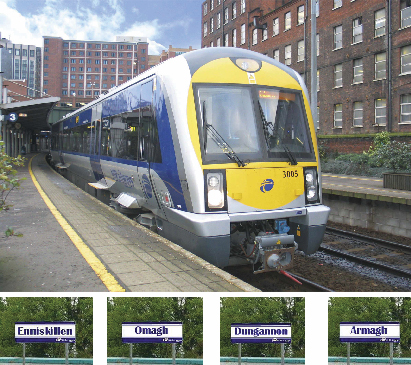
T R A N S L I N K C U S T O M E R S U B M I S S I O N
By: Brian Guckian, Rail & Integrated Transport Researcher, 40 Brewery Road
Stillorgan, Blackrock, Co. Dublin, Ireland
Tel. 00 353 87 9140105, Landline 00 353 1 2109070, Email railprojects@eircom.net
NINE is an ambitious rail development programme proposal. It is being made by the author to Translink in his capacity as a regular Translink Customer.
It places particular emphasis on new methodologies in Cost-Benefit analysis (CBA) and addresses several common myths about rail economics.
The proposal was mentioned briefly in an Appendix to a Submission made by the author to the Railways Review Group in 2004. Some material has been repeated from that Submission in this document, but the welcome significant upgrade to the NI Railways network in the intervening period has made much of the previous text redundant.
It is important to note that this document is a Submission, and not a Report or a Study. Rather, it is intended to stimulate ideas and debate, and calls for further feasibility work going forward.
Comments and ideas outlined in this document are framed within the context of key developments in current Rail Transport Strategy. There are many models now available worldwide for sustainable and viable regional rail development, which could be applied in the NI context. Recent work carried out in other parts of the UK, such as Scotland, is particularly relevant1.
The Submission builds upon the increasing awareness of rail transport as a viable and sustainable resource and as a significant contributor to balanced regional development, emissions reduction and energy conservation. This is also commendably reflected in the Regional Transportation Strategy.
Key innovations apparent in 2008 are;
Rail has traditionally been accounted for using crude income and expenditure-based analyses. At best, these are highly subjective and have ignored the enormous indirect benefits of the mode. More sophisticated tools are now available that radically enhance the viability of many rail schemes by analysing their cost / benefits with better regard to their positive external environmental and social benefits.
Innovations such as "smartcard" ticketing provide seamless integration between transport modes and dramatically increases travel convenience, thus stimulating patronage to a high degree. This has been seen to significant extent in London with the Oyster Card.
Additionally, increasingly sophisticated train management methods and signalling practices have permitted the introduction of "clockface timetabling", which also transforms the "user-friendliness" of rail.
The threat posed by climate change, the costs of road traffic congestion, health problems caused by air pollution, and newly-emerging concerns regarding energy demand and supply have created powerful new conditions for rail development - and new economic analyses addressing these issues make such development possible.
Tax incentives for the construction of new railfreight facilities or for logistics operators and their customers to incorporate the rail mode into their transport chains have been available in the UK for many years. Two other highly significant advances in Railfreight are firstly, the Minimodal® system which uses techniques adapted from aviation cargo; a low-cost, extremely versatile road / rail freight handling solution which has had a dramatic effect in reducing lorry movements where it has been used the UK, without compromising the economics of the supply chain2.
The second innovation is the development of new types of ISO container, ranging from refrigerators to oil tanks and car-carriers. This brings a dramatic new versatility to traditional inter-modal freight handling and transfer techniques.
The Association of Community Rail partnerships (ACoRP) has done outstanding work in the UK in getting communities actively involved in the running of their local rail services, and strengthening integration via feeder bus services, cycle accommodation, pedestrian access etc. Some Community Rail Partnerships have boosted patronage by up to 120%3.
Several rail development projects have been drawn up around the country. The majority of these provide strong links to and from towns not catered for by the existing network, which suffers from being focussed on radial routes emanating from Belfast. The main advantage of these projects is high connectivity, both with other parts of the rail network, and with other transport modes such as road, bus and air. Innovative features are use of low-cost construction methods and operating systems, integration, ease of use, reliability and faster journey times.
These outline projects have now been collected together into a single proposed development package and are detailed in this Submission.
Northern Ireland has a rich railway heritage, with the network reaching its maximum extent of over 1000 route miles in the early 1900s. Extensive closures, between 1950 and 1970, have reduced this to approximately 207 route miles.
From the onset of road transport in the 1930s, the rail mode has suffered from a limited economic approach. When rail was the dominant form of transport, and privately owned and operated, there were very large volumes of passengers and freight carried. This allowed companies to make clearly-defined profits or losses, determined by direct receipts set against direct operating costs. However, this masked the substantial indirect benefits of the mode, which in the first hundred years of operation related to economic and social development.
As rail lost its pre-eminent position in the first half of the 20th century the privately-owned ownership model, with its requirements for basic calculation of profit / loss, and responsibility to shareholders, was no longer valid. The state began to be involved in the financing of rail, as a way of "bailing out" transport concerns that on paper were beginning to make very heavy financial losses.
Yet the state continued to apply the outmoded accounting model that completely ignored the indirect benefits of rail, and the early 1950s onwards saw attempts to make the railways profitable again in the limited direct receipts / direct costs sense. However, the strategy adopted, of wholesale route closure and rationalisation, incurred heavy direct and indirect costs and is widely criticised today. At the time it was not realised that closure of branch and cross-country lines had a disproportionate effect on the longer routes, in that people tended to transfer to the car mode for their entire journey, rather than drive to the nearest mainline railhead in place of their local service, as was originally envisaged4.
The early 1970s saw a change in attitudes due to a growing awareness of the impact of traffic congestion, and a recognition to some extent of the indirect benefit of rail, which was framed in terms of the social role the mode had to play. Accordingly, there was much-needed investment, new operating practices and new rolling stock, which brought stability to the network, increased patronage and prevented further contraction.
In NI, the further stabilising of the internal political situation in the mid-1990s made way for a sharp increase in growth in the Region, which allowed NIR to consolidate and enhance its legacy network, with the much-lauded Cross-Harbour Rail Link and Great Victoria St. Station projects coming on stream. This was further boosted by more recent the Bangor Line relay, the re-building of the Bleach Green Junction – Antrim section of the Londonderry line and the introduction of the high-quality C3K rolling stock.
Encouraging though these developments have been, the context in which rail operates and is evaluated has continued to be viewed using a restrictive economic paradigm. The difficulty has been that;
The Indirect Benefits of the rail mode have often been framed solely in vague environmental and social terms, out of kilter in today's global marketplace
This is a vital distinction, and explains why network expansion or enhancement is not often considered. And, the neutral nature of economics is often overlooked by commentators who frequently politicise the debate into left versus right, or capitalist versus socialist, etc.
What is highly encouraging is that a more sophisticated economic analysis of the indirect benefits of rail, arising out of proven cost-benefit techniques, is now available. It takes into account such factors as time savings, reduction in emissions, road accidents prevented, road construction savings, wear and tear on vehicles, and so on. This gives a totally new and much truer picture of rail economics. An example of how this, taken with other factors, can transform the financial performance of a rail network is given below.
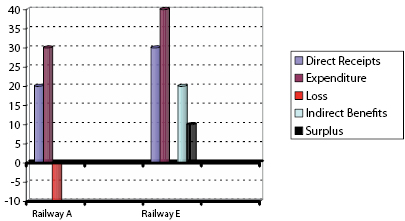
Fig 1 – Railway A is a passenger-only network accounted for purely on operating income and expenditure. It runs high-quality services based on deep local knowledge of customer need, using modern rolling stock and new technology such as integrated "smartcard" ticketing. The network makes a loss, subsidised by the state in the form of a PSO grant. Extensions to the network are resisted, as these are made dependent solely on high levels of fare revenue for justification, and therefore high levels of "population density". Since settlement patterns rarely occur like this, the network is never extended.
Railway E, (the Enhanced Network) on the other hand, has a larger network with higher receipts and expenditure than Railway A, and also carries freight using the most modern techniques. However, the indirect benefits of the rail mode are also accounted for, allowing for network extension that is not dependent on high "population density" values. The PSO grant can be re-positioned as a dividend and the network makes a surplus, permitting further investment and expansion.
The indirect benefits of rail are augmented by the contribution of the mode to combatting Climate Change. Reductions specifically in greenhouse gas emissions generate increasingly significant financial savings. In that regard, it is important to note that figures quantifying the indirect benefit of rail used in this document must at this time be taken to be highly conservative in nature.
A second key driver of rail development in a new economic context is the ability of new technologies to substantially raise passenger ridership and bring freight back onto the railways. Innovations such as the Oyster Card in London represent the application of consumer convenience concepts to transport, dramatically boosting "user-friendliness" and very importantly, facilitating seamless integration across bus, train, tube and light rail modes. In this way, the passenger is presented with a "menu" of travel options in which to carry out a "door-to-door" journey by public transport. Likewise on the freight side, engineering advances have re-introduced flexibility and cost-effectiveness back into physical handling and transfer of cargo – most important in getting businesses to seriously look at incorporating the rail mode back into their purchasing and supply chains.
These key influencers on rail development are now discussed in more detail;
Climate change, brought about primarily by the continued build-up of Carbon Dioxide (CO2) gas in the atmosphere, is underway. The effects of this are difficult to predict, but it is generally held that continued polar icecap melting will lead to an increase in mean sea level and disrupt ocean currents. Coupled with changing weather patterns (increased number and strength of storms for example), the result could be widespread flooding and inundation of low-lying land areas. This in turn has serious social and economic implications, with population displacement, disruption to services, reduced industrial output, contraction of markets for goods and services, and so on.
Since the process has already begun, the task must be to reduce its extent and impact, and a package of measures that could be implemented includes:
A carbon-efficient transportation model is given below;
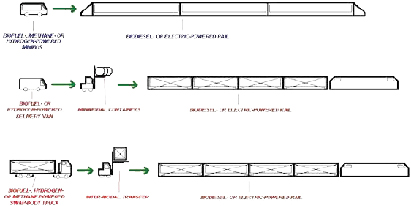
Fig 2 – Passenger and Freight carbon-efficient transportation chains using available or near-available technologies
The principal reason the car and lorry has dominated modern land transport is convenience. These provide "door-to-door" travel capability, whereas other modes have lagged far behind in this regard.
Principle barriers in many countries to door-to-door passenger travel by say, bus and rail, have been as follows;
However, technology now provides the following solutions;
It can be seen that a cashless ticketing system, fully integrated across all modes, plus frequent minibuses serving rail links with regular-interval services, and clear unobstructed access at both ends, provide an almost seamless "door-to-door" transport system, thus offering a strong alternative to the car.
There are some other factors that need to be taken into account also;
These are more difficult to apply in a group travel situation. However there are successful strategies available;
It must be said that Northern Ireland has had a very high awareness of the importance and benefits of integrated transport, much more so than several other countries, including the Republic of Ireland. The current programme of building Integrated Travel Centres across the Region, plus numerous other schemes to promote greater accessibility to rail and bus services, plus encouragement of cycling and walking, is proof of an active commitment to this integration, and is very welcome.
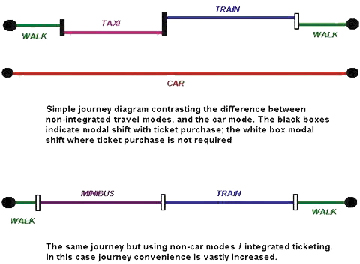
Fig 3 – "Smartcard" ticketing makes "door-to-door" public transport realistic
On the freight side of rail, historic problems have been costs of physical labour and time delays involved in cargo handling and transhipment. As with passenger journeys, the articulated truck or small and medium heavy goods vehicle (HGV) have dominated the scene because of their ability to offer "door-to-door" service and convenience.
Until recently, railfreight has had to confine itself to bulk or dangerous loads that cannot be moved economically or safely by road. Containerisation offered a way forward for many railways in the 1960s and 1970s, but this historically involved very heavy and costly freight handling equipment and large, dedicated freight yards.
Again, new technology makes it possible for railfreight to once more offer a viable alternative to road freight, and makes the most of inherent advantages such as predictable journey times. Moreover, the reach of rail is extended by incorporating the road mode in a highly efficient and cost-effective manner.
The two main railfreight innovations are:
New freight tracking and management software, with built-in web access, can be used in railfreight with the same effectiveness and value to the customer as it has in air and road freight. Again, railfreight can benefit significantly from the same principles of customer convenience and transferability between modes as applied to the passenger side of rail operations.
It's worth noting that in spite of an enlightened approach to modal integration there still persists in some quarters an unhelpful perception that road and rail are not complementary transport modes, but adversarial ones, with debate being framed within an "either / or" context.
Thankfully, road-building in NI has moved away from the "predict and provide" policy approach that assumes an inexorable rise in car ownership and use. As shown above, new modal switch technologies offer a powerful alternative to car journeys, and this has a moderating influence on car ownership. It is possible to illustrate the difference between the essentially passive model of car ownership as used in the past, and a newer "active" model showing how car use can be influenced externally (e.g. by modal switch technologies);

Fig 4 – Previous model (typical, above) assumed continuous growth without external influences

Fig 5 – Revised model showing ownership peak followed by decline due to external influences
It is also now very well known that congestion cannot be eased by road-building, and that the cost-benefit of spending millions to save relatively little on journey times - which are often calculated assuming less than full capacity traffic loadings - has been questioned7. Further, the environmental effects of such policy are not confined to emissions, but also involve loss of agricultural land, community severance, and light and noise pollution.
What is also clear is that funding decisions in the past have been made on the basis of a circular argument – that the public and business need more roads at the expense of rail / bus etc. because they largely use the road mode (hence the model described in Fig. 4 above); when in fact they largely use roads precisely because there has been lesser pro-rata investment in rail, bus and the other modes. Another important point is that rail development paradoxically benefits road users by freeing up space on main routes, thus making driving safer, more reliable and less stressful, and benefiting Translink and private coach operators.
Extensions to the rail network are routinely dismissed using the mantra-like assertion that "population densities" are not high enough. (Oddly, this argument is never used against road schemes nor water or electricity provision, for example).
Moreover, the "received wisdom" regarding rail investment generally is as follows:
As we shall see, none of these assertions are actually true. Unfortunately they are remarkably potent and have been highly successful in stopping even the most cursory evaluation of rail development schemes. This false thinking must now be robustly challenged.
Firstly, a purely passenger-focussed route that does not pursue railfreight opportunities is compromised in terms of how much direct revenue it can raise. This is particularly relevant in Northern Ireland, which has very significant freight potential given its connectedness to major trade centres and seaports, and the ever-increasing costs and impacts of road-based freight.
An "all-purpose railway" approach thereby maximises potential revenue because it can cater for a wide range of passenger and freight services and also lessens the need for the railway to rely on very heavy passenger loadings, and ergo high "population densities".
Secondly, as touched on previously, the perceived "requirement" for "high population densities" is an outcome of a completely wrong understanding of rail economics that is based on a simplistic fare-dependent model for income. Yet if accounted for correctly – that is, in a holistic manner, including increasing environmental, economic and social benefits – then the financial picture radically changes.
This false argument also cannot account for the course of existing rail lines, which may connect places of high population density, yet pass through areas of very low population density en route. This is true of the Belfast – Dublin, Belfast Londonderry, Belfast – Larne and Belfast - Bangor lines. Thus it is dangerous to make general assertions regarding population densities at particular points on a rail corridor, and then use these to determine whether investment should be made, and to what extent.
Further, average passenger loadings in a given area could be compensated for by higher freight carryings in the same area. Again, it is important to re-state the fact that the "all-purpose" railway, that carries freight as well as passengers, is much less reliant on high passenger loadings (which are in turn dependent on high "population densities") for viability.
In short, population density is an unreliable and inaccurate tool for measuring the viability of investment in any given rail development project. This is why such a criterion is not used in, for example, road project evaluation.
Thirdly, the perceived expense of rail development is also important, even though the per-km cost of re-opening railways is around one-third that of equivalent road development8. A standardised and well-managed design and engineering approach, using low-cost technologies and modular construction techniques, makes rail development wholly realistic.
The common (mis)perception of expense is due to a lack of consideration of the Indirect Benefits of the rail mode and hence an inability to see its value.
Fourthly, it is imperative that the indirect, or external, benefits of the rail mode be accounted for in cost-benefit analysis (CBA) in rail development projects. Failure to do so leads to negative Net Present Values (NPV) and project rejection. It is significant that no major road projects can be justified on direct income grounds alone (e.g. from tolls) and wider criteria are always used in their CBA.
Significantly, the Republic of Ireland Strategic Rail Review of 2003, carried out by Booz Allen Hamilton on behalf of the ROI Department of Transport quantified and valued the external benefits of the ROI rail network at € 18 billion over the period 2003 to 2022 (or € 900 M, unadjusted, per annum). This valuation was developed into a metric by the author for "scoring" rail development projects and was used in the previous Railways Review Group Submission. It is employed again here to roughly calculate benefits from specific proposed network extensions.
Quantifying the Indirect Benefits of rail can transform an incorrect and negative attitude to rail investment into a positive, correct one
Finally, one examines the assertion that rail only works over long distances. This assumes that short to medium trips are made by car or bus and that somehow, rail cannot cater for this kind of traffic. But as demonstrated earlier, short to medium rail trips can be made possible by regular interval schedules and integrated "smartcard" ticketing.
"Why re-open former rail lines when there is a perfectly good bus network in place?"
This flawed question, sometimes asked, originates in a fundamental misunderstanding of the role of different modes of transport. Coach and rail are not oppositional transport modes, but rather are complementary.
In fact, one can have competition with integration – that is, rail and coach operating on the same route, together providing significant sustainable transport capacity against the unsustainable private car mode. Passengers who miss trains can catch a bus, and vice versa, and such practices are common on the European continent.
There is ample room for expansion of both rail and coach modes in an environment where car dependency is high, implying a very large potential market for a switch to public transport. For example, the most recent transport statistics show that in 2006, public transport (non-car modes) in Northern Ireland accounted for just 13.4% of all trips to work9, implying major potential for taking trip share from the car
This thinking is counter-intuitive, and engagement with it is required in order to free policy-making from a restrictive and debilitating mindset. The "rail versus bus" argument is also a fallacy in that its logical conclusion must entail total closure of the rail network.
Rail also has the following significant advantages:
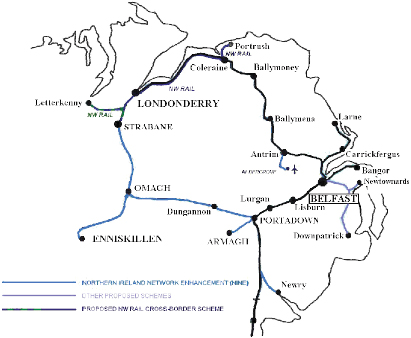
Fig 6 – NINE Outline Map
NINE encompasses the following nine towns / locations:
There is overlap at Derry with the cross-border NW Rail proposal which was made to both NI and ROI governments and their transport concerns in 2003. For the purposes of this proposal, the Strabane- Londonderry section of NINE is incorporated into the NW Rail proposal (available separately). NW Rail further overlaps with the proposed WRX (Western Rail Corridor Extension) scheme from Sligo to Letterkenny in the Republic and on to Derry. This is outside the scope of this document, though relevant documentation is available.
This forms the major part of the NINE proposal and involves approx. 87 route miles (140km approx.) of single track railway on the former alignments.
The work could be carried out in two phases, structured so that benefits and revenue (mainly from local & commuting traffic) would flow immediately;
Phase 1 – Portadown to Dungannon & Omagh to Strabane
Phase 2 – Dungannon to Omagh & Enniskillen to Omagh
Significantly, the combined mileage of Phase 1 (15 miles & 19 miles, giving a total of 34 miles), as well as that of Phase 2 (26 ¾ miles & 25 ¾ miles, giving a total of 52 ½ miles), compares very favourably to the current Waverley Route re-opening project in Scotland (35 miles from Edinburgh to Galashiels) and the Western Rail Corridor in the Republic (36 miles Ennis to Athenry).
In other words, a two-phase approach is eminently manageable and achievable given today's technology and working methods.

Fig 7 - Suggested project breakdown (above ) with twelve work bases from which each railhead would be extended; and 2-stage phasing of project (below)
It is not possible in this Submission to carry out detailed CBA; this must be left to Others. Instead, a very basic "scoring" method is used, using the metric developed by the author and mentioned earlier. Derivation of this metric, which is based on environmental and other savings calculated for the ROI Strategic Rail Review in 2003, is given in Appendix II.
| Defined Sections – Phase 1 | Route Km | Total IB / Yr | Capital Cost |
| PORTADOWN – DUNGANNON | 24 | 9,334,656 | 64,800,000 |
| OMAGH - STRABANE | 30 | 11,668,320 | 81,000,000 |
| Phase 1 Total | 21,002,976 | 145,800,000 |
| Defined Sections – Phase 2 | Route Km | Total IB / Yr | Capital Cost |
| DUNGANNON - OMAGH | 43 | 16,724,592 | 116,100,000 |
| ENNISKILLEN - OMAGH | 41 | 15,946,704 | 110,700,000 |
| Phase 2 Total | 32,671,296 | 226,800,000 |
Indirect Benefit baseline € 486,180 / Km / Yr = STG£ 388,944 / Km /Yr
Capital Cost baseline STG£ 2.7 million / Km, Exchange Rate €1 = £ 0.8
From the outline data used, it can be seen that Phase 1 of this NINE scheme could generate total annual benefits, conservatively estimated, of £ 21 million per annum approx. on a total estimated capital investment of £ 145.8 million, with recoupment suggested within a 7-year period.
Phase 2, using the same methodology, could generate estimated total benefits of £ 32.7 million per annum approx. on a total estimated capital investment of £ 226.8 million, with suggested recoupment in a similar period.
These results point to a likely positive Net Present Value (NPV) in any detailed – and holistic – CBA that might be carried out. However reasonably high patronage of services is also required, and the methodology assumes positive policy-based measures to encourage modal shift to rail, including use of feeder minibus and bus services to stations, etc.
It should be noted that the baseline capital investment per km figure used is based on closely correlating data from both the ROI Strategic Rail Review 2003 and the cost-per-km figure for the current Borders Rail re-opening project in Scotland. These yield figures close to £ 2.7 million per kilometre, and importantly, "greenfield" cost parameters have been used even though in this case the proposed scheme is intended entirely to be on the former route alignments.
Finally, the project would have very important tourism benefits. Arguments regarding low population levels in tourist areas often ignore the fact that local populations can increase significantly in the tourist season.
The Portadown – Omagh – Enniskillen / Strabane proposal contains several engineering challenges. It is vital that a constructive, positive approach be taken. Many perceived "obstacles" to rail re-opening projects, such as bridge-building, land acquisition, etc. also occur in road-building, but are treated in that context positively, not negatively.
It is also important to recall that the engineering footprint of a single-track railway is relatively minor at approx. 5m, whereas a dual carriageway or motorway construction project can often involve a "landtake" of up to 37m.
Far from impacting on this corridor through Omagh – which importantly follows the former railway – reintroduction of the rail route here could complement rather than compete with road traffic.
Working closely with Roads Service and Omagh District Council, careful design and engineering would ensure a successful outcome. A positive and innovative approach is vital, and indeed the engineering work could be put out to tender as a Design Competition, firmly positioning the task as a creative challenge rather than a perceived "obstacle".

Fig 8 – Insertion of single-track railway into Omagh Throughpass (Dublin Road example) can be accomplished by bringing the line in along the landstrip to the right of the photo, and behind the retaining wall extending out from the road bridge, with a new road bridge across the line to the right (out of sight). Alternatively, the retaining wall could be moved to the right and the visible road bridge extended. These are just some engineering possibilities that can be considered at the design stage.
Consideration could be given to re-constructing the station in a triangular format, to permit through running from Enniskillen to Londonderry and Enniskillen to Portadown, additional to the Portadown – Derry main line. Alternatively, the junction could be re-built in the more conventional "Y" format, but facing Portadown rather than Derry as it had done in the past. Trains could thus run direct from Enniskillen to Portadown for the first time, with passengers from Enniskillen to Londonderry changing at the station (preferably with cross-platform interchange). This could generate significant patronage, as the line would be re-positioned as Enniskillen – Portadown – Belfast, rather than Enniskillen – Derry as in the past.
Also, the station would not have to be in the precise location as formerly, and could be much more compact. Consideration however should be given to railfreight handling capability.

Fig 9 – The original Omagh station was located just north of the junction with the Enniskillen and Portadown lines (left). Under NINE, the station could be re-built in a triangular format, allowing through running of services in all directions (centre). Alternatively, the junction could be re-built facing Portadown, with passengers travelling from Enniskillen to Londonderry changing at the station. If the station was located in the "vee" of the junction, cross-platform interchange would be possible. Also, the station would not have to be located at the original site.
Again, far from impacting on this popular amenity in Dungannon, reintroduction of the railway here could be sensitively integrated into the landscape. The railway is immensely beneficial, and excellent design, as well as full participation by the local community, would ensure ownership of the project and a positive outcome for all.
Of course there are a great number of additional works that would have to be carried out, including several river crossings between Omagh and Strabane, Dungannon Tunnel, alignment severance, etc. etc. Again, the ruling mindset must be to tackle these challenges in a creative manner, and indeed Translink has an excellent track record in rail engineering achievement, through the Cross Harbour, Great Victoria St., Bangor Relay and Antrim – Bleach Green rail development projects.
This NINE project restores rail services to Armagh, which was last served in 1957. The re-opening proposal is more modest in that it uses single track with passing loops instead of the double-track alignment as originally built.
With a large catchment, and significant commuting and local travel potential, this project would have significant benefit, as well as encouraging greater tourist and business travel to this important historic town and commercial centre. Noting also that in time, completion of NINE projects would also generate entirely new and sustainable journey patterns in the region – e.g., Armagh – Dungannon, Armagh – Omagh and Armagh - Newry Town (all changing at Portadown).
The basic "scoring" method devised by the author and based on environmental and other savings calculated for the ROI Strategic Rail Review in 2003 yields the following outcome:
| Section | Route Km | Total IB / Yr | Capital Cost |
| PORTADOWN – ARMAGH | 17 | 6,612,048 | 45,900,000 |
| Total | 45,900,000 |
Indirect Benefit baseline € 486,180 / Km / Yr = £ 388,944 / Km /Yr
Capital Cost baseline STG£ 2.7 million / Km
It can be seen that this NINE scheme could generate total annual benefits, conservatively estimated, of £ 6.6 million per annum on a total estimated capital investment of £ 45.9 million, with recoupment in a 7-year period.
This result points to a likely positive Net Present Value (NPV) in any detailed – and holistic - CBA that might be carried out. Again, however, reasonably high patronage of services is also required, and the methodology assumes positive policy-based measures to encourage modal shift to rail, including use of feeder minibus and bus services to stations, etc.
Newry has suffered down the years through having its direct rail connection on the Goraghwood – Warrenpoint route removed in 1965. The present Newry station on the Belfast – Dublin mainline (formerly Bessbrook) is somewhat removed from the main urban centre and – despite the provision of a high-quality connecting bus transfer service – this is a disincentive for those using the town centre for business and leisure to switch from the car mode in the kind of numbers required to achieve significant modal shift to rail.
Importantly, this NINE project not only restores direct connection into the town centre – thus providing a hugely attractive incentive for travellers to switch to the rail mode – but even more beneficially allows frequent rail services to be extended from Portadown to Newry without the kind of capacity and operational problems that would occur if the current Newry station was used as a terminus for extended services into Belfast.
A further great attraction is the very modest level of investment, relatively speaking, that would be required. The distance is relatively short at 6km and it is understood that Roads Service has built bridges over the former alignment in new road schemes that have been built in the area since 1965, at the behest of Newry & Mourne Council.
The basic "scoring" method based on environmental and other savings calculated for the ROI Strategic Rail Review in 2003 yields the following outcome:
| Section | Route Km | Total IB / Yr | Capital Cost |
| GORAGHWOOD – NEWRY TOWN | 6 | 2,333,644 | 16,200,000 |
| Total | 16,200,000 |
Indirect Benefit baseline € 486,180 / Km / Yr = STG£ 388,944 / Km /Yr
Capital Cost baseline STG£ 2.7 million / Km
It can be seen that this NINE scheme could generate total annual benefits, conservatively estimated, of £ 2.3 million per annum on a total estimated capital investment of STG£ 16.2 million, and with recoupment again in 7 years.
This result points to a likely positive Net Present Value (NPV) in any detailed and holistic CBA that might be carried out.
The final NINE project includes this much-sought-after facility. It is worth noting that conventional thinking that specifies that airports should generate in the region of 10 million passengers a year to make a rail link viable is wrong, as it is based on enormously expensive electrified, double-track rail technology.
Yet there is no reason whatsoever that a service could be provided at a far lower, yet high-quality, specification, using conventional diesel railcar technology as currently employed by NI Railways and simple single-track working.
The easiest way to link the Airport to the main line network is via a short spur to the ex-NCC Lisburn-Antrim line that passes the airport perimeter, and thence on to Antrim over this existing (though largely disused) line.
The attraction of this proposal is very low infrastructure and operating costs, with services shuttling between the Airport and the main Belfast – Londonderry line at Antrim. At Antrim, passengers could go northwest to Ballymena, Coleraine and Derry, as well as southeast into Belfast. The northwest travel pattern and associated very large potential catchment and customer base is surprisingly often overlooked in discussions about an airport rail link. This layout thus maximises revenue by exploiting a very wide range of travel options for people using the Airport.
In the longer term, the rail link could very easily be absorbed into a circular rail service from Belfast to Lisburn, the Airport, Antrim and return to Belfast via Mossley West and Bleach Green Junction (Fig 11, overleaf).

Fig 10 – Initial Belfast International Airport rail link uses Lisburn-Antrim line
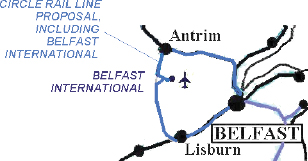
Fig 11 – Airport link can later be incorporated into proposed Belfast Circle Line
The scoring method yields the following outcome:
| Section | Route Km | Total IB / Yr | Capital Cost |
| BELFAST INT. – ANTRIM | 10 | 3,889,440 | 27,000,000 |
| Total | 27,000,000 |
Indirect Benefit baseline € 486,180 / Km / Yr = STG£ 388,944 / Km /Yr
Capital Cost baseline STG£ 2.7 million / Km
It can be seen that this NINE scheme could generate total annual benefits, conservatively estimated, of £ 3.9 million per annum on a total estimated capital investment of £ 27 million.
This result points to a likely positive Net Present Value (NPV) in any detailed and holistic CBA that might be carried out; however it should be noted in this case that the requirements of Belfast International Airport would likely mandate a far greater spend on station construction, specification, etc. Therefore it is quite likely that the project would come in at a greater cost than £ 27 million.
Even so, if the project were to cost say, 50% more, coming to £41 million approx., recoupment of the investment could still theoretically take place in a 10-year timeframe, which is still well within standard infrastructure recoupment periods.
Total investment required for NINE, as well as estimated externality (indirect benefit) valuations for each proposed project, is given below;
| NINE Project | Route Km | Total IB / Yr | Investment |
|---|---|---|---|
| PORTADOWN – DUNGANNON (1) | 24 |
9,334,656 |
64,800,000 |
| OMAGH – STRABANE (1) | 30 |
11,668,320 |
81,000,000 |
| DUNGANNON – OMAGH (2) | 43 |
16,724,592 |
116,100,000 |
| ENNISKILLEN – OMAGH (2) | 41 |
15,946,704 |
110,700,000 |
| PORTADOWN – ARMAGH | 17 |
6,612,048 |
45,900,000 |
| GORAGHWOOD – NEWRY TOWN | 6 |
2,333,644 |
16,200,000 |
| BELFAST INT. – ANTRIM | 10 |
3,889,440 |
27,000,000 |
| Network Enhancement Total | 171 |
66,509,404 |
461,700,000 |
€ 486,180 / Km / Yr x 0.8 = £ 388,944 / Km / Yr
Fig 12 – Table scoring total IB against proposed investment
The population level table below shows how towns currently not served by rail, but listed for rail network extension under NINE (in red), have populations and / or catchment areas significantly higher than other towns or even villages that are already served by NI railways services;
| Armagh | 54,263* | (Unitary Authority Area) |
| Strabane | 38,248* | (Do.) |
| Newry (Town) | 33,433 | |
| Ballymena | 28,717 | |
| Carrickfergus | 27,201 | |
| Ballymoney | 26,894* | (Do.) |
| Coleraine | 24,089 | |
| Antrim | 20,001 | |
| Omagh | 19,910 | (Excluding Catchment) |
| Larne | 18,228 | |
| Enniskillen | 15,000 | (Do.; & Excl. Tourists) |
| Holywood | 12,037 | |
| Dungannon | 10,983 | (Do.) |
| Portrush | 6,372 | |
| Whitehead | 3,702 | |
| Moira | 3,682 | |
| Castlerock | 1,336 |
The data also shows that increased seasonal population levels due to tourism must be taken into account, particularly regarding Enniskillen, given its position as a gateway to Ulster's Lakelands, etc.
Note that the above table is based on limited access to population statistics. In any detailed analysis, careful study of absolute population level, catchment areas and transitory population levels would have to be carried out in order to ascertain an accurate measurement of potential ridership, taking into account policies to get passengers to the railhead via e.g. local feeder minibus services.
A final consideration is the need to look at proposed investment in rail within the context of the current Northern Ireland Regional Transportation Strategy (RTS) 2002-2012:
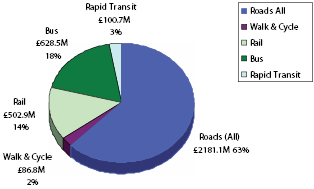
Fig 13 – Chart showing breakdown of planned expenditure in Regional Transportation Strategy 2002-2012 (Source: RTS 2002-2012)
It can be seen from the chart that the intended total roads spend is 4.3 times that of rail. Taken with the fact that almost two-thirds of the overall transportation expenditure is consumed by roads, this highlights a significant imbalance that implies that environmental, economic and social sustainability does not in fact appear to have been a consideration when the RTS was being drafted, despite what the main text of the Strategy might assert. By way of contrast, taking £461.7 million from the intended roads budget to pay for NINE results in a re-balancing of the overall spend, with rail taking a more positive share of 28% and road being curtailed to 49%:
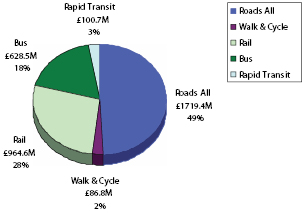
Fig 14 – Re-balanced RTS spend to facilitate NINE
1 Scottish rail development (Stirling-Alloa; Gretna-Annan; Borders Rail Link) highlights the failure of unsustainable, individualised, car- and HGV-based Anglo-American transport policies, and shows the way forward in these islands;
2 cf www.minimodal.com; author has no connection with this company;
3 Source : Transport 2000; Commission on Integrated Transport;
4 Christian Wolmar "Broken Rails" Aurum Press 2001;
5 There are strictly speaking no "non-polluting" fuels. The phrase is used in this context to refer to fuels that do not emit significant quantities of greenhouse gas nor other harmful pollutants upon combustion
6 E.g. timber loading in Scotland
7 SACTRA (Standing Advisory Committee on Trunk Road Assessment) Report of 1994;
8 Based on ROI road- and rail-building costs (Sources: ROI Dept. of Transport and ROI Strategic Rail Review [Booz Allen Hamilton 2003])
9 Source: Northern Ireland Transport Statistics 2006-07, DRD / Northern Ireland Statistics & Research Agency
10 Source: ATOC (Association of Train Operating Companies)
Cover: Translink
Page 17: www.wesleyjohnston.com
NB – Detail maps are to be found in "Johnson's Atlas & Gazetteer of the Railways of Ireland", by Stephen Johnson, Midland Publishing Ltd. 1997, ISBN 1 85780 044 3
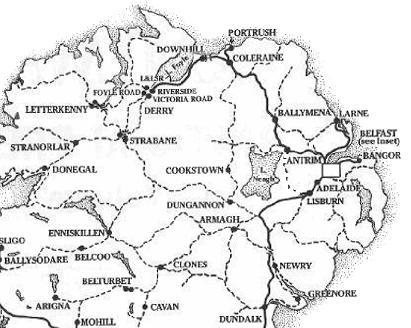
Map from "Irish Railways Past and Present Volume 1" by Michael H.C. Baker,
Past & Present Publishing Ltd.; ? Michael H.C. Baker 1995
The IB data referred to in this report was derived from Booz Allen Hamilton's quantification of the indirect benefit of the rail mode to the Irish Republic between 2003 and 2022. The €18 billion figure for the period stated by BAH in the Strategic Rail Review10 was compared to the total in situ route mileage of the current Iarnród Éireann network. The latter figure was metricated and used to divide into the BAH total indirect benefit figure. This produced a baseline figure of €486,180 per route kilometre per year, as used herein[1] [2].
It's important to point out that the in situ route network figure included non-operational routes where the track is in place under "care and maintenance" by IÉ, as well as the operational ones. This was done intentionally, (a) to reflect the potential of the full network, and (b) to depress "optimism" from having a high IB figure to start out with. This would have happened had the smaller, operational route mileage figure been used. This report also showed how the depressed figure still leaves out very significant benefits accruing from balanced regional development, increased railfreight operation and climate change moderation via reduced CO2 emissions.
These steps were done deliberately, to account for any variations in the IB figure per route kilometre, so that the figure used (€486,180 / km / yr) would be as low as possible, and could be used with confidence as a baseline figure, below the lowest level of variation. This is illustrated in Fig A below. Note that dividing €486,180 by 365 yields a per-day benefit-per-kilometre of €1332 and dividing this further yields only €1.33 (£1.06) per metre per day, graphically illustrating how conservative the IB baseline figure actually is. It is also vital to stress that variations in IB per km, like population density as discussed earlier, are not directly related to the overall benefit, nor indeed to types of traffic (e.g. line sections with low benefits to passengers may have high benefits for freight). This is why road projects, for example, discount these factors.
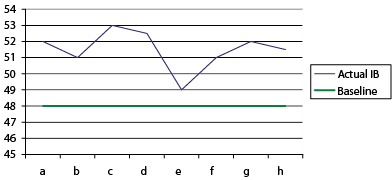
Fig A – How the Baseline IB Figure was minimised to take account of possible variations in Indirect Benefit per section of line.
[1] Inflation having been cancelled out on both sides of the investment / return equation
[2] Unadjusted, contemporary Sterling equivalent values were used in this document
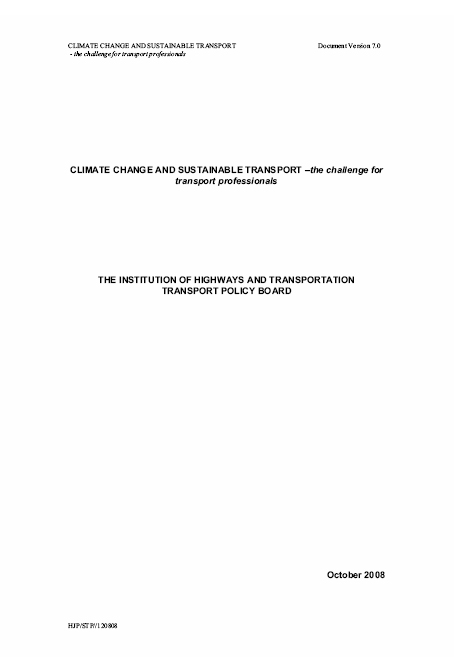
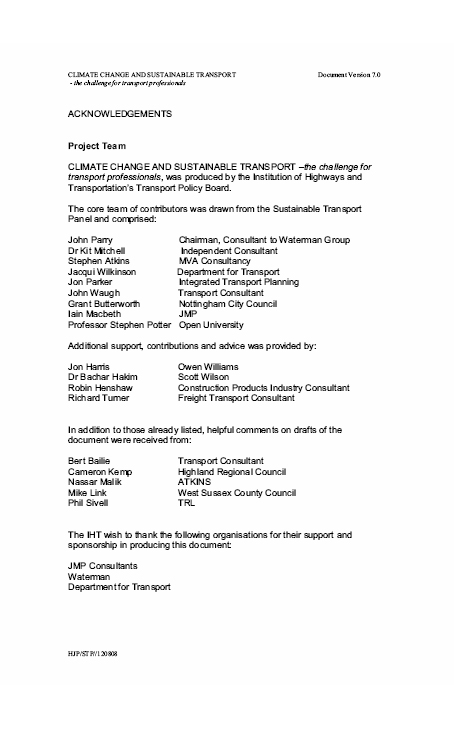

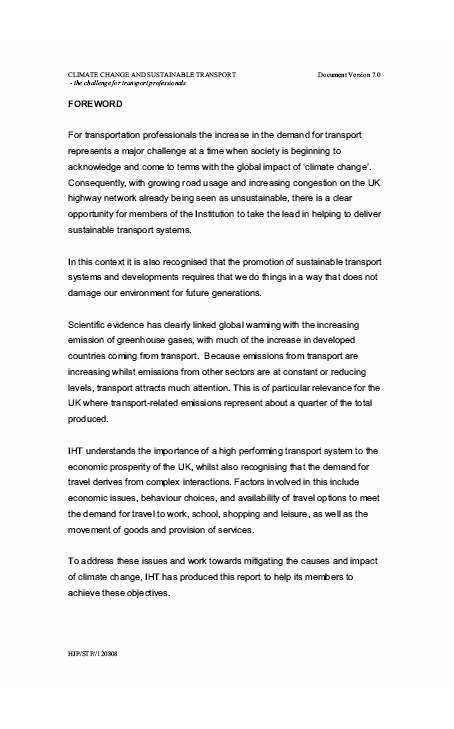

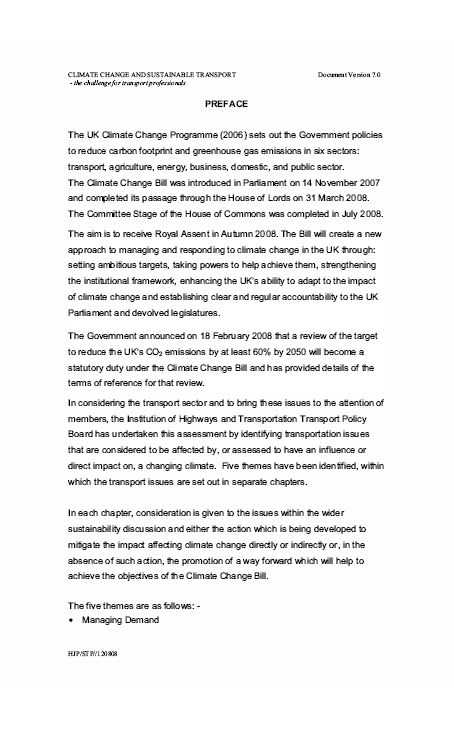
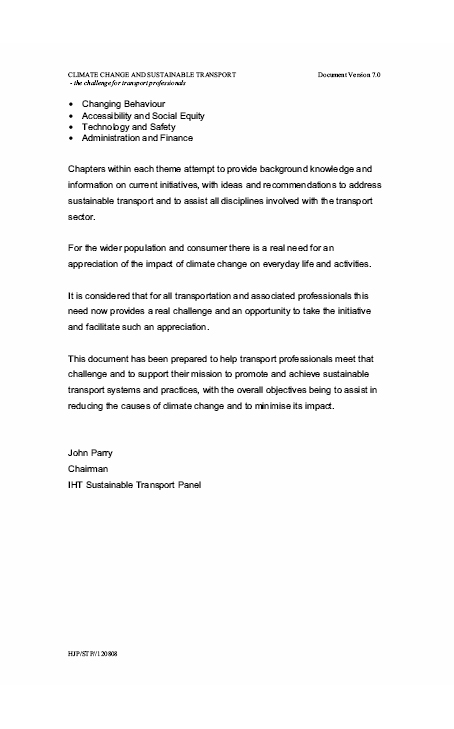



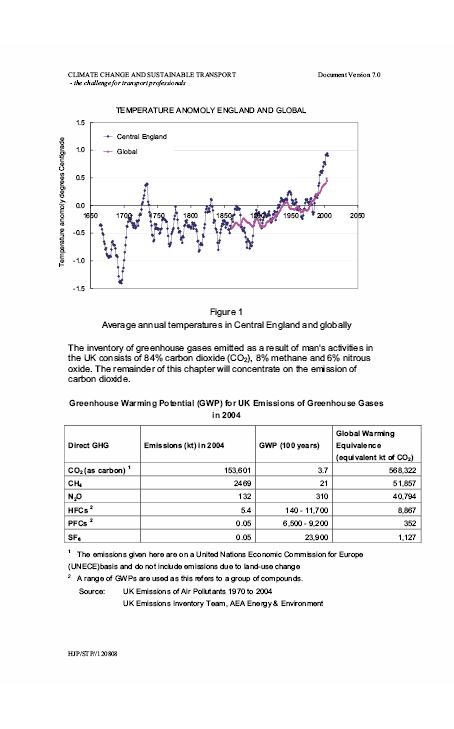




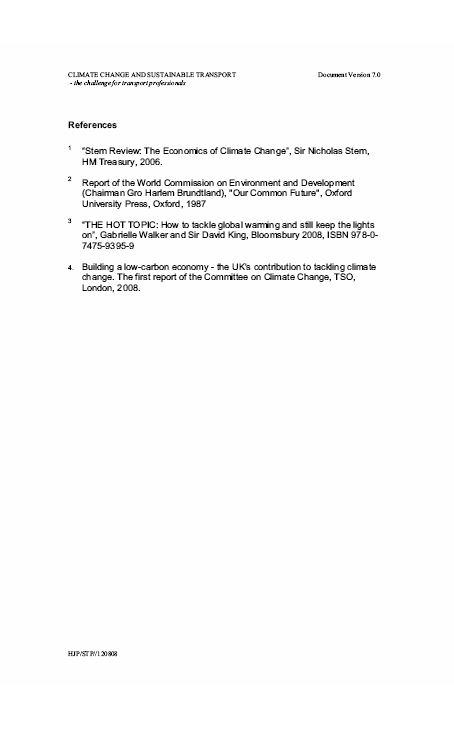
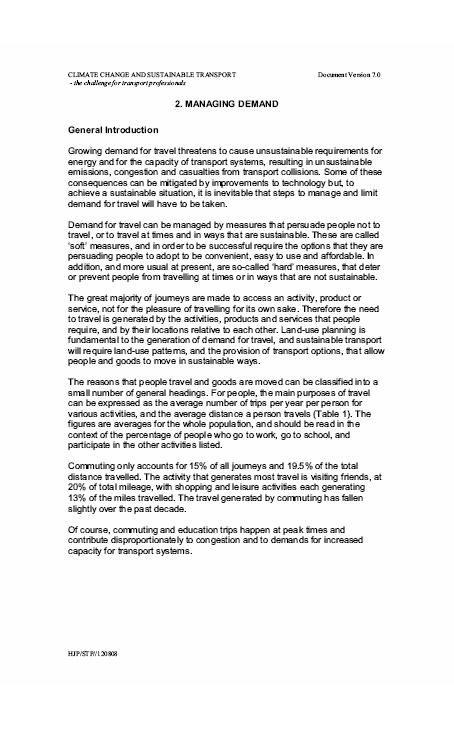





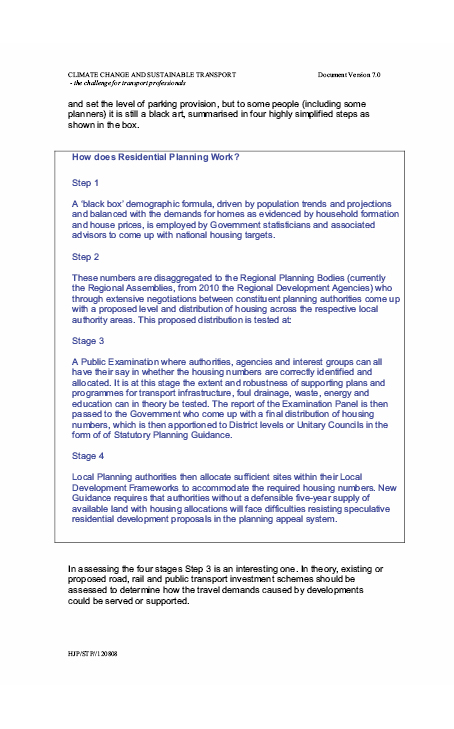
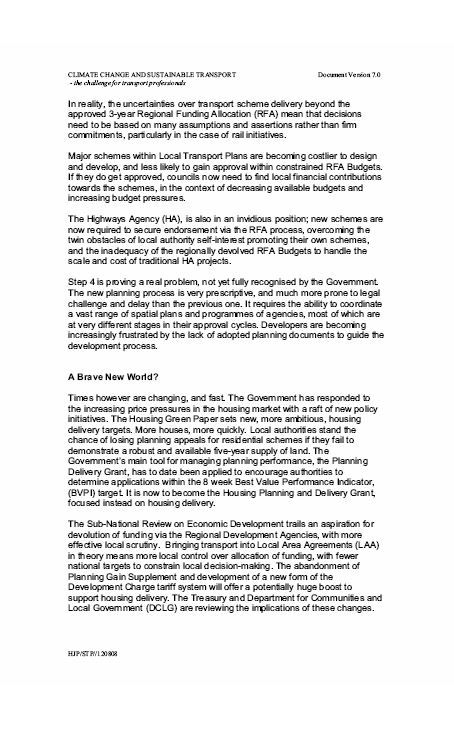
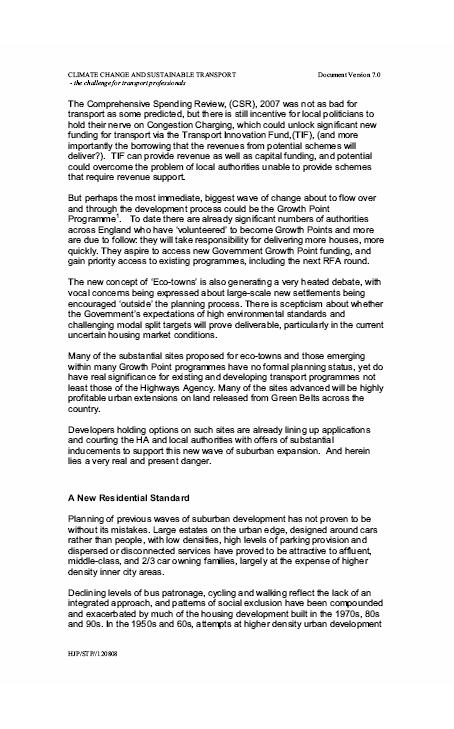

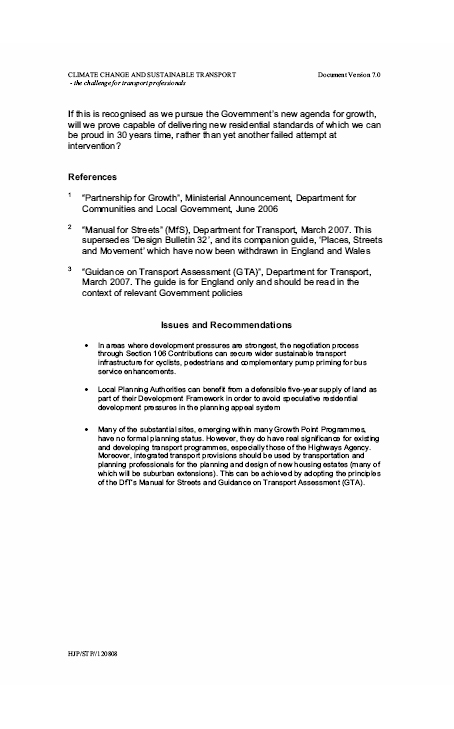
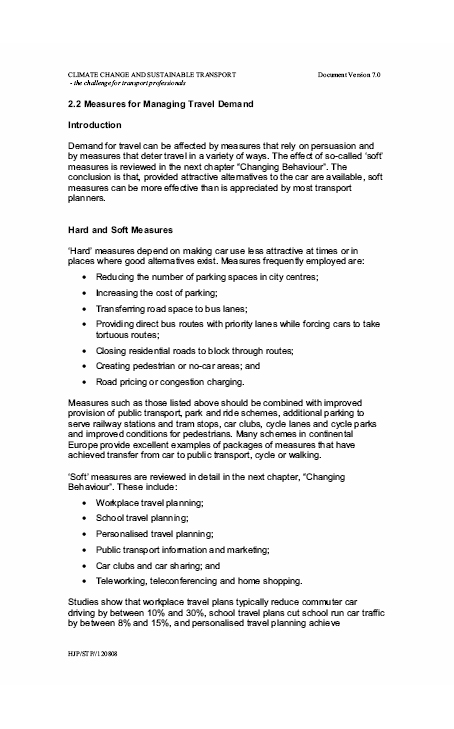
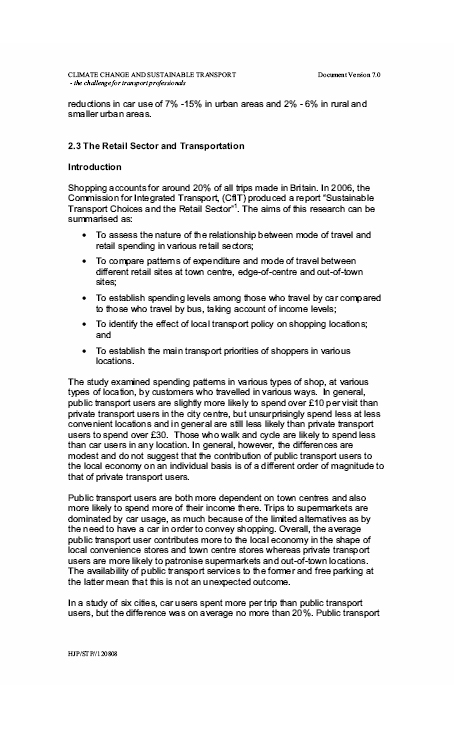
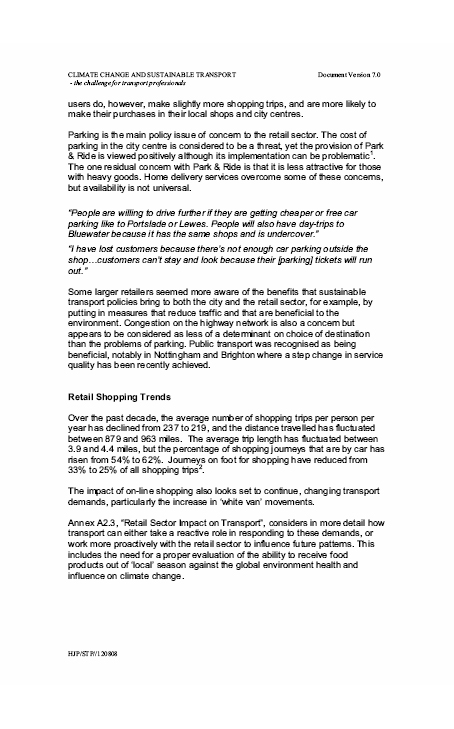
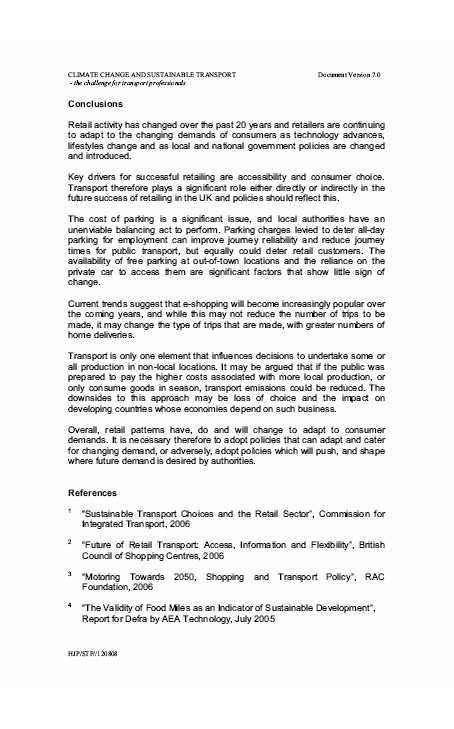
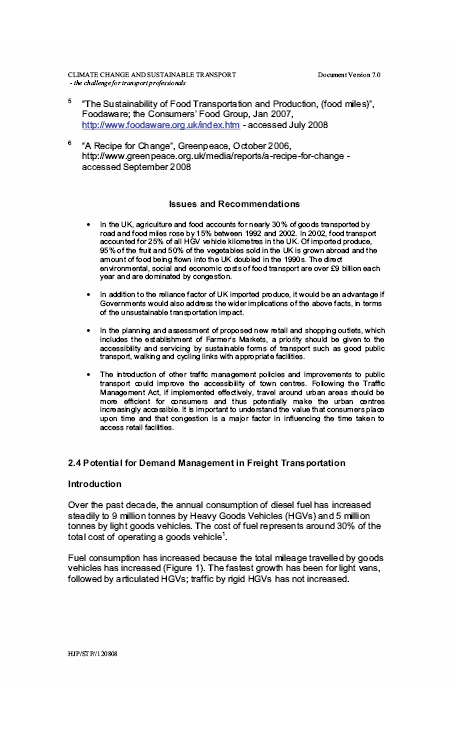
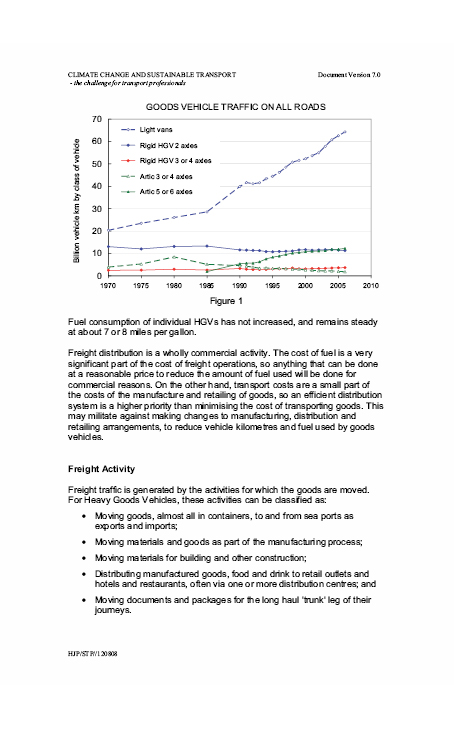

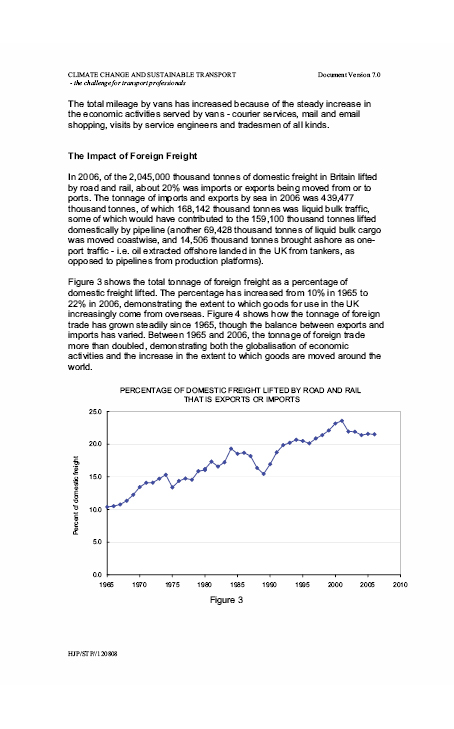

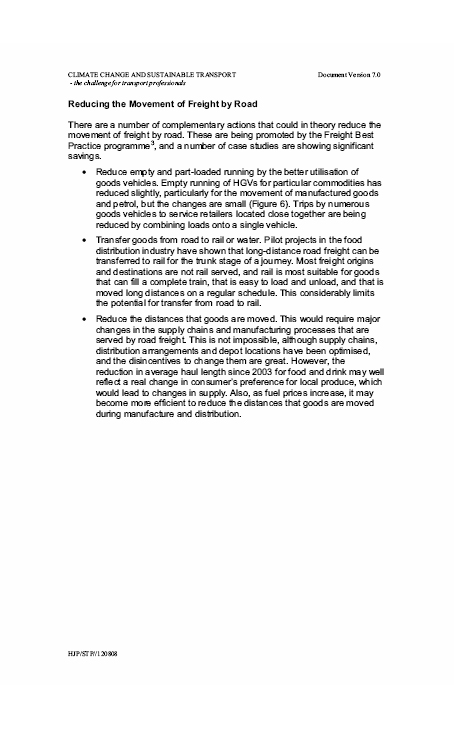
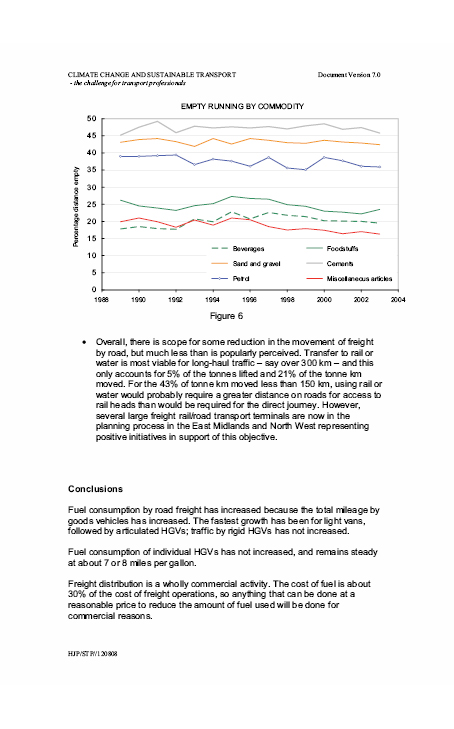

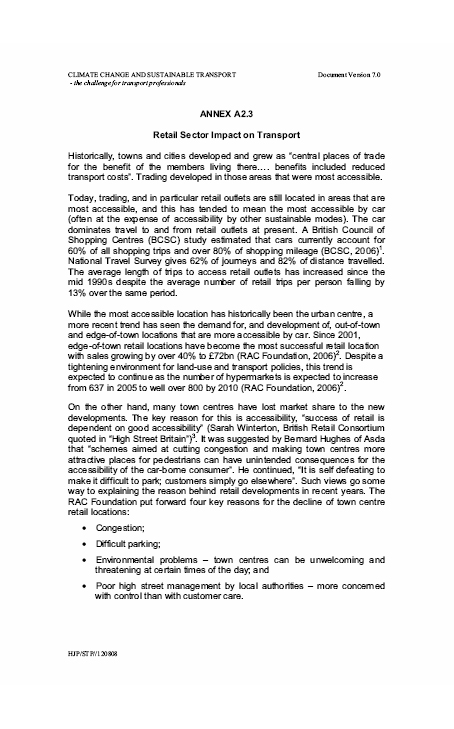
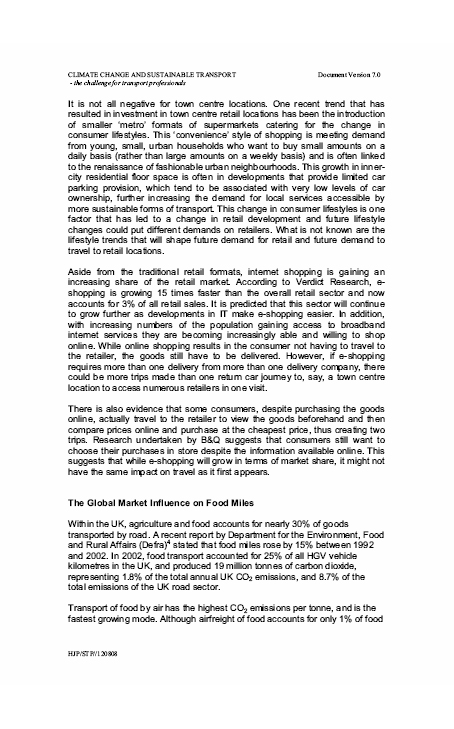
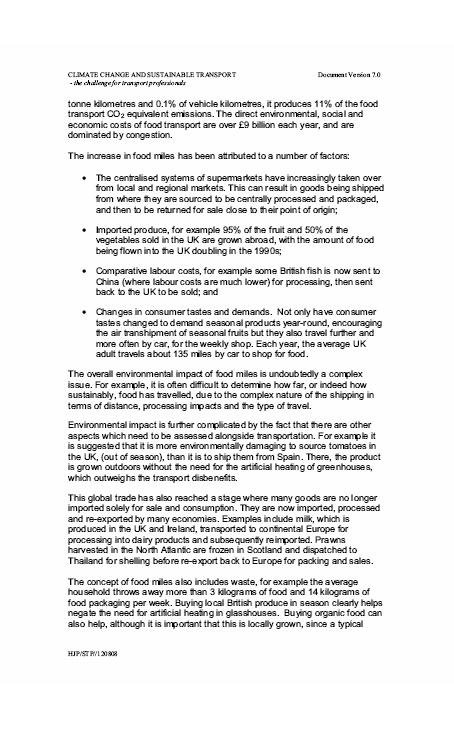

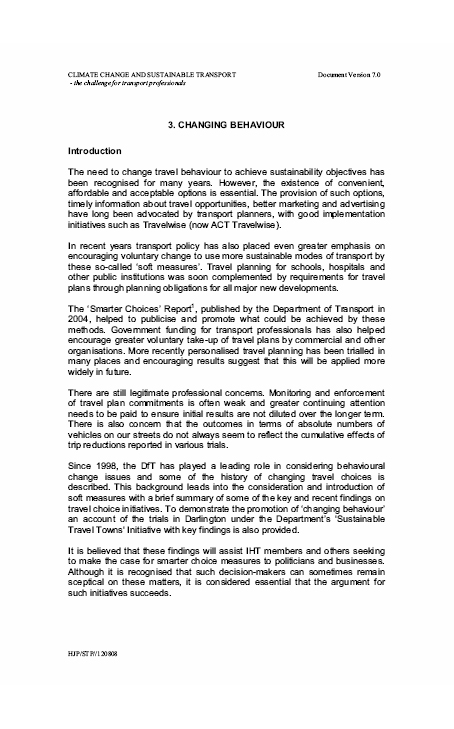



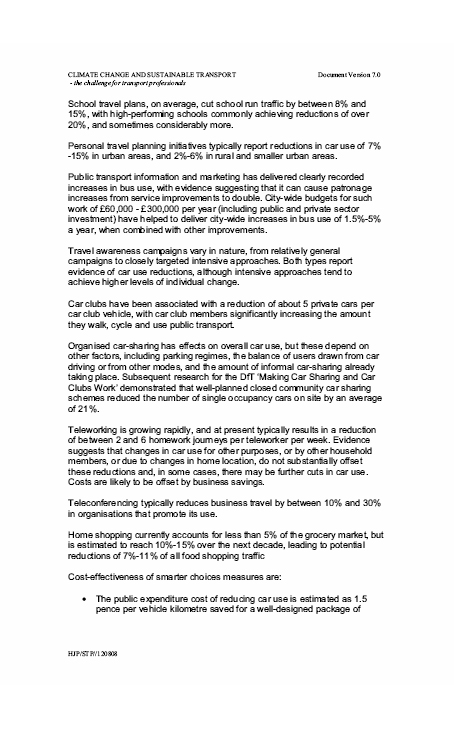
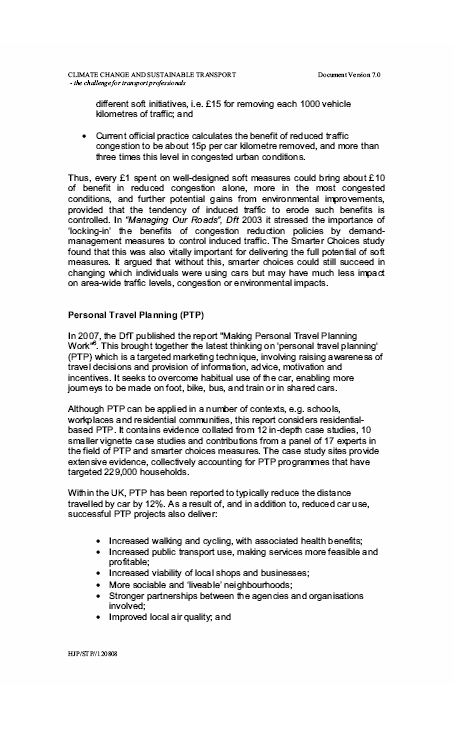



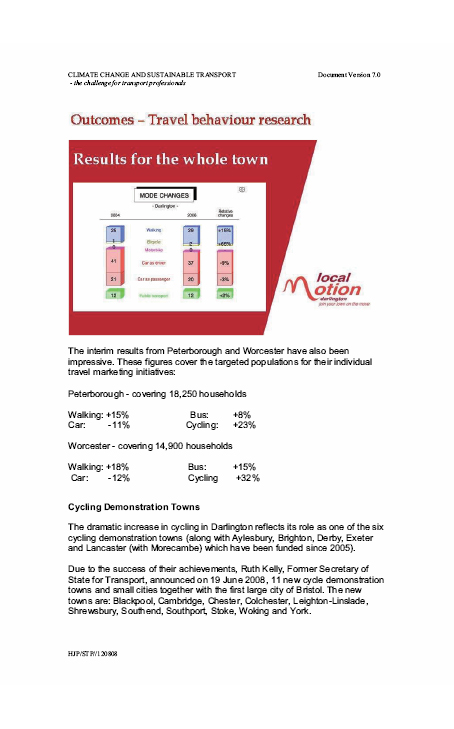


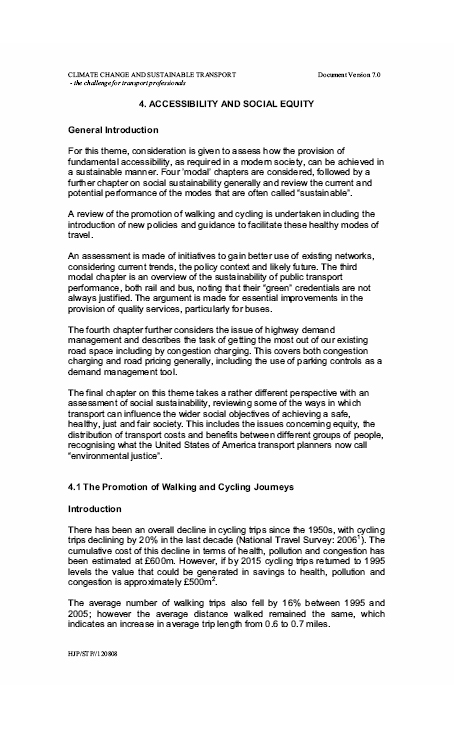
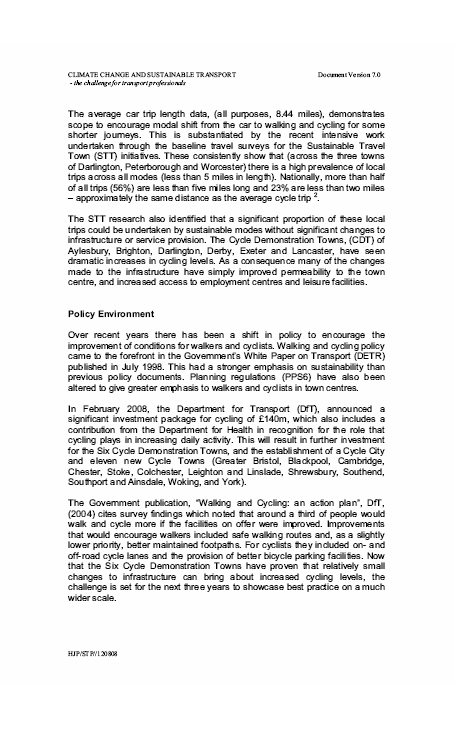
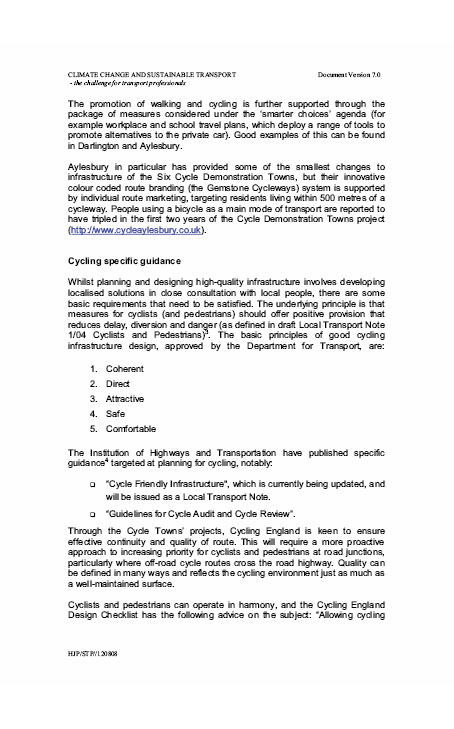
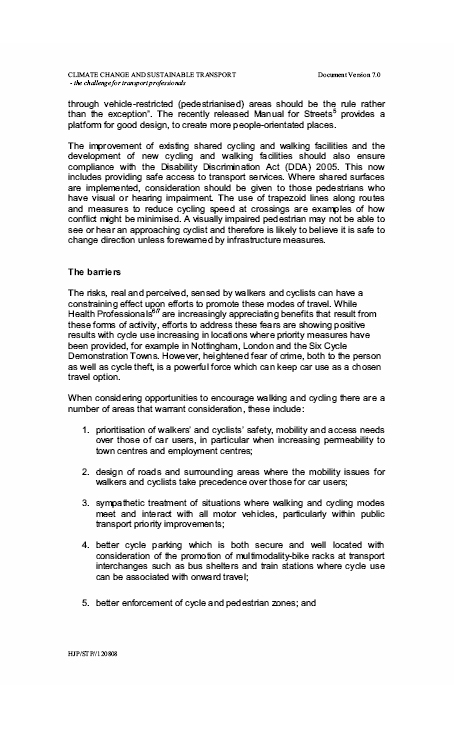
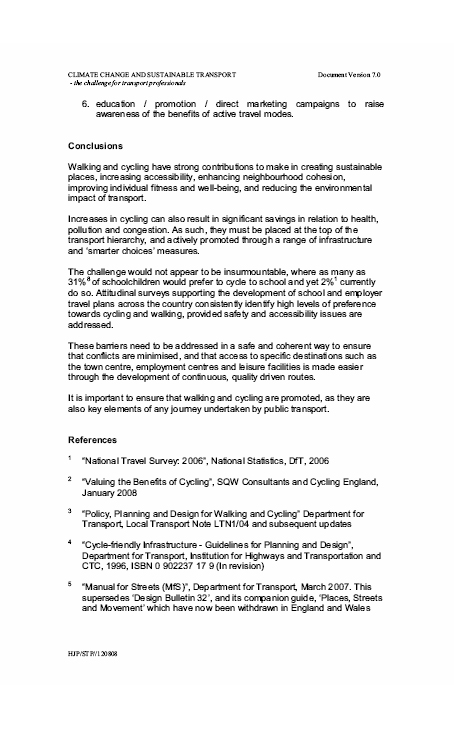
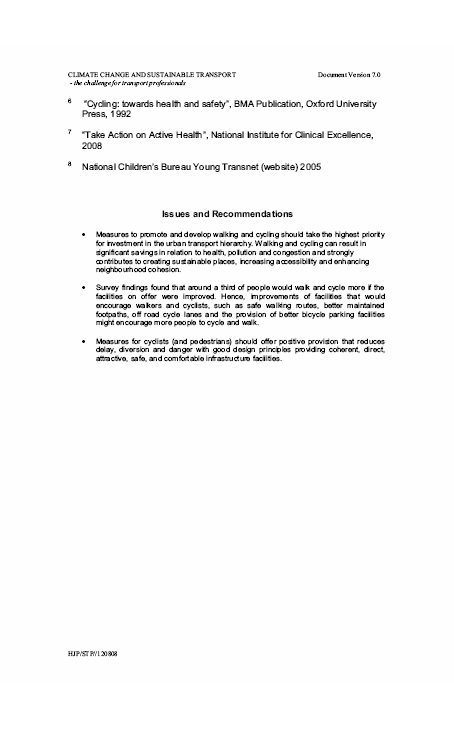


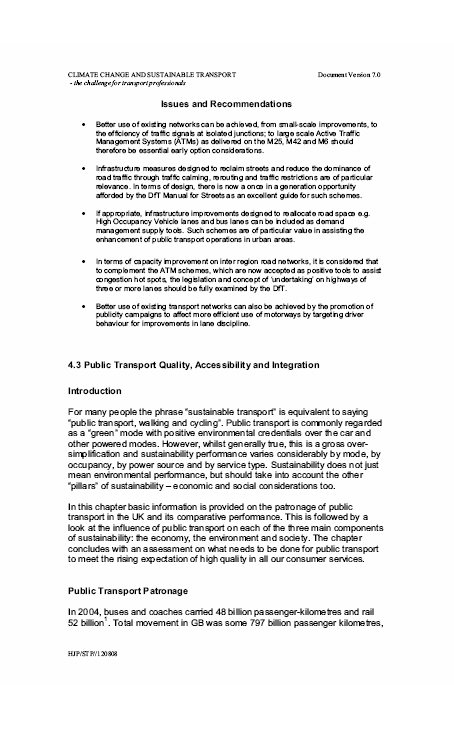
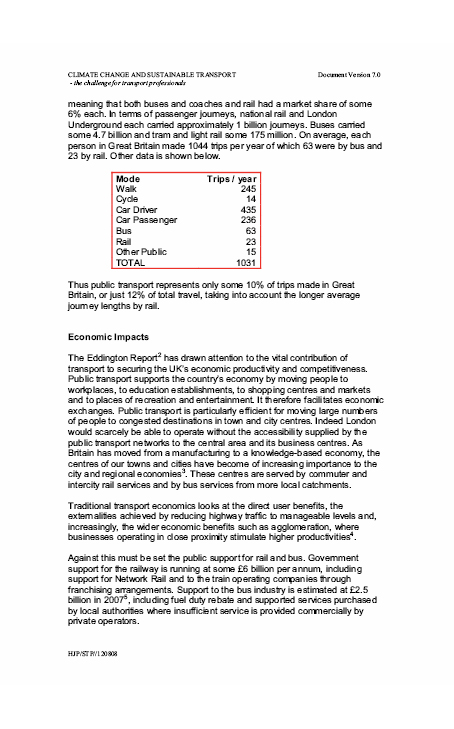
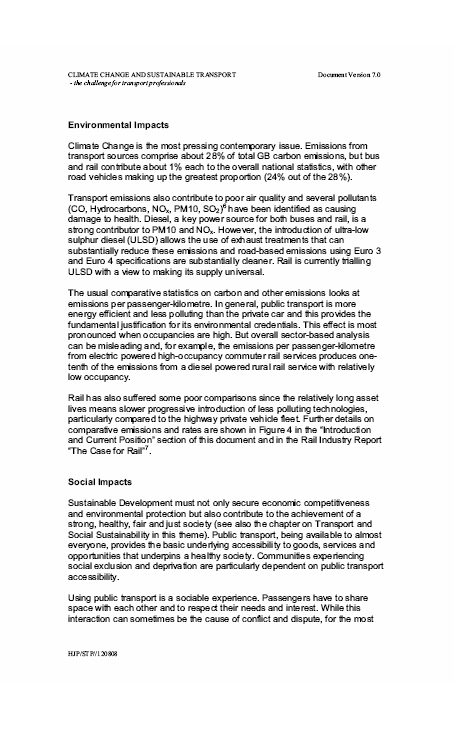
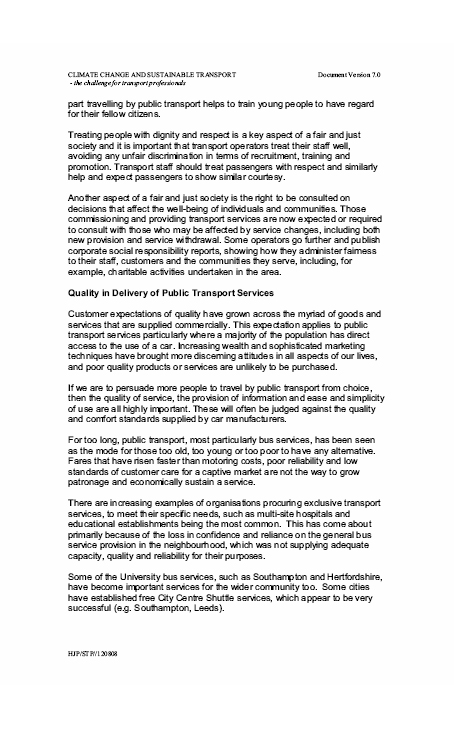

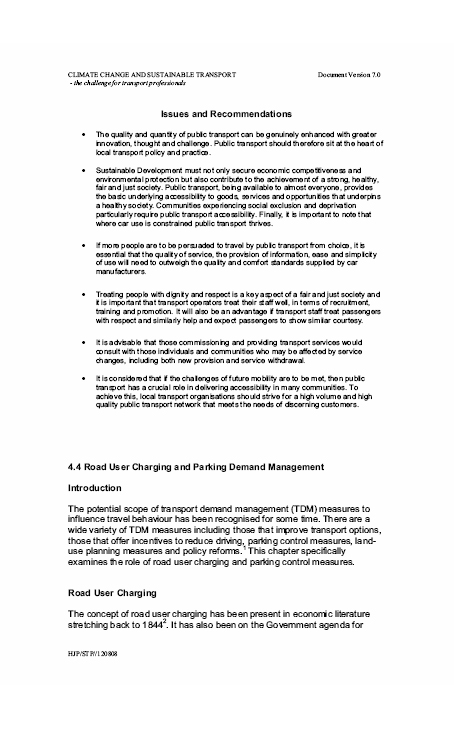
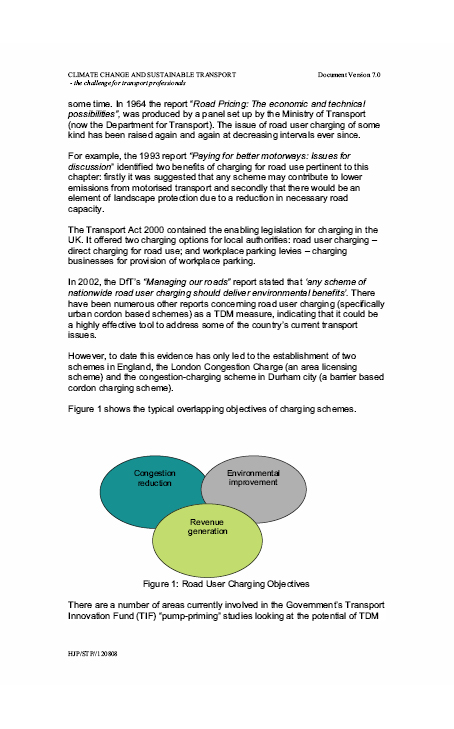
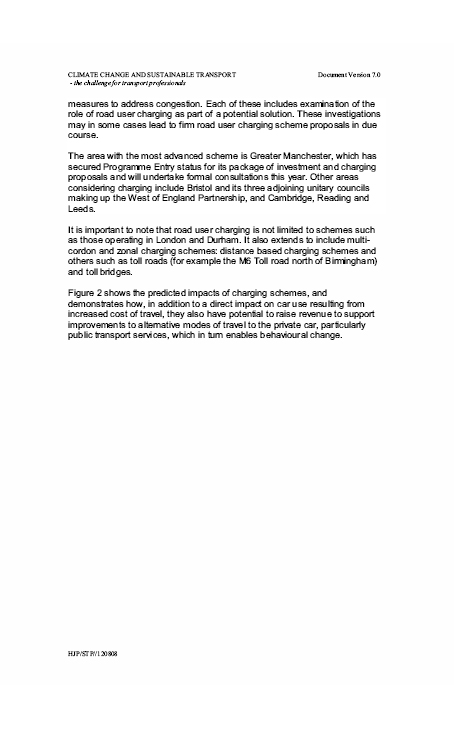


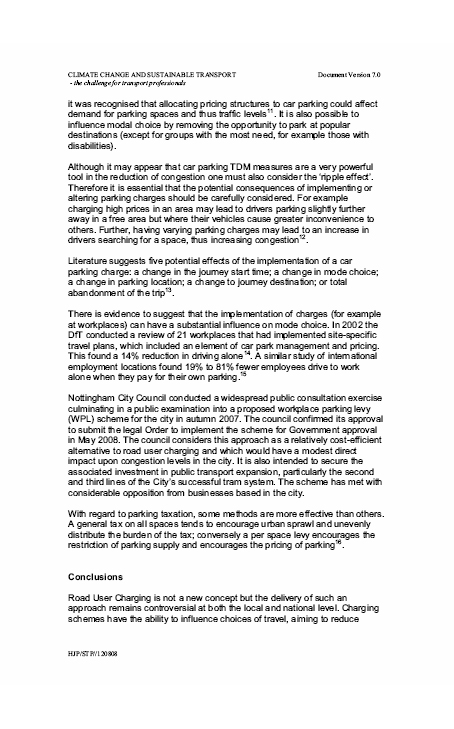


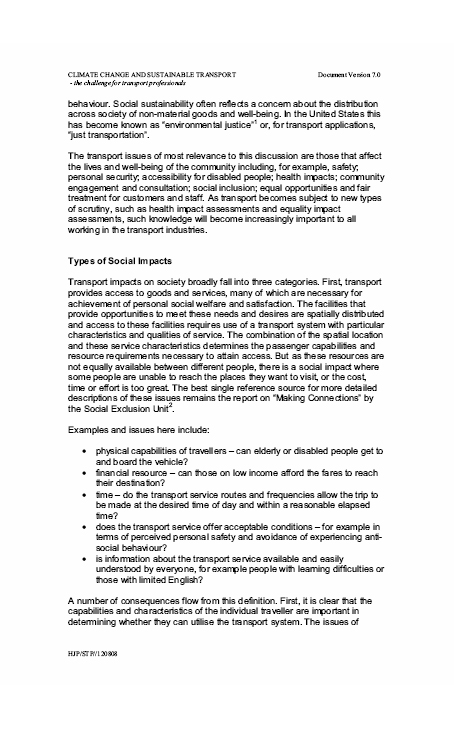


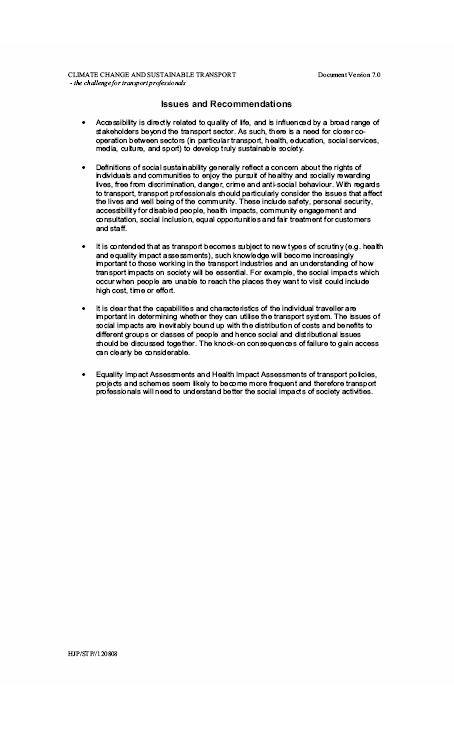
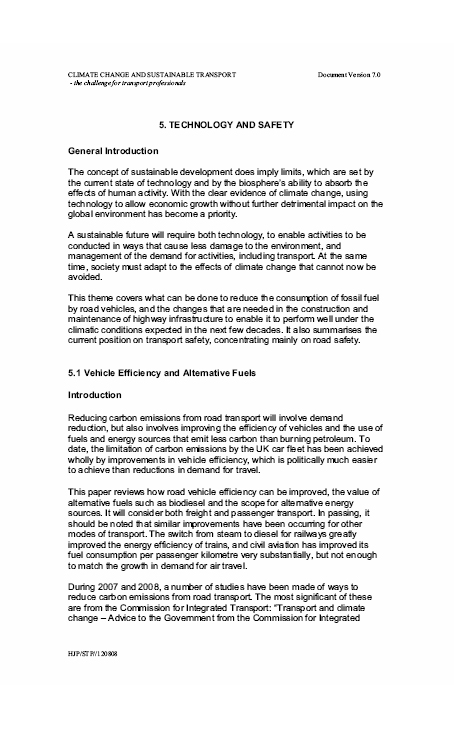

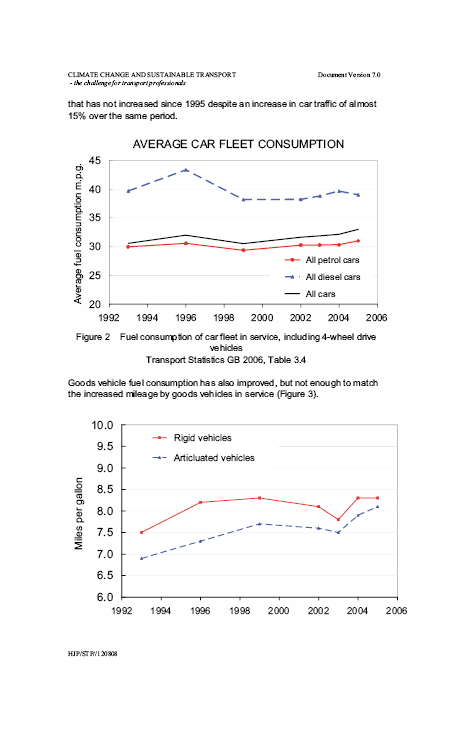

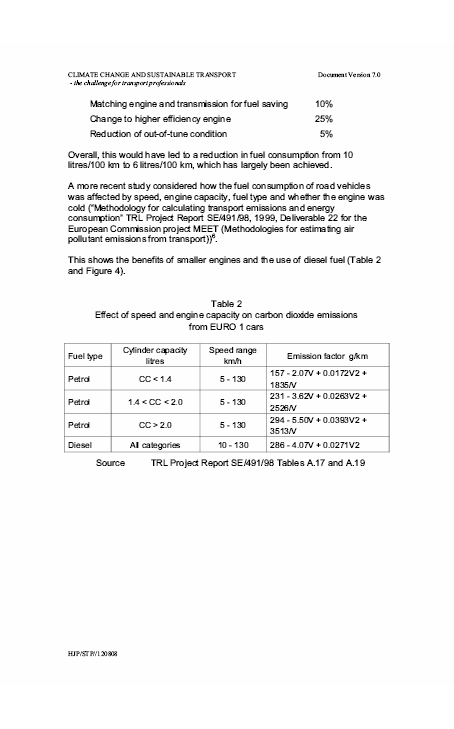

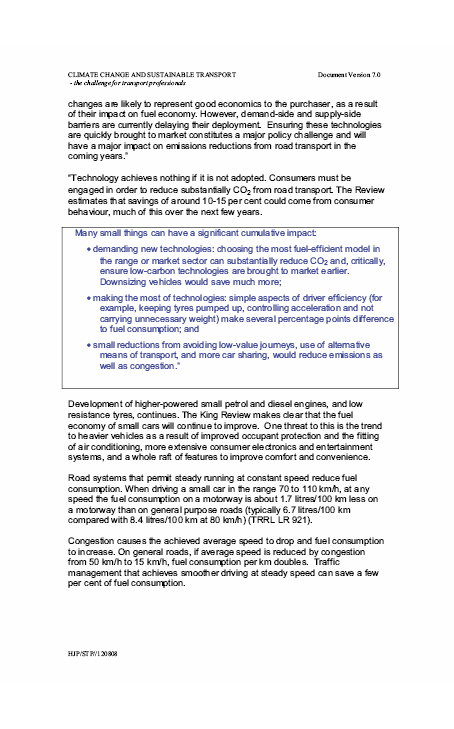

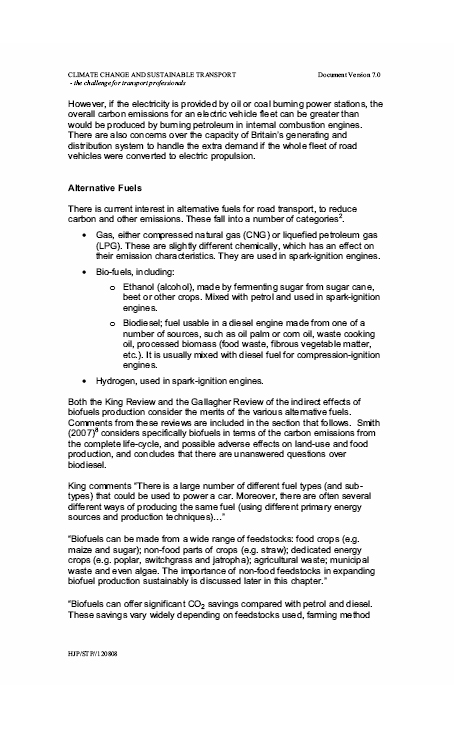



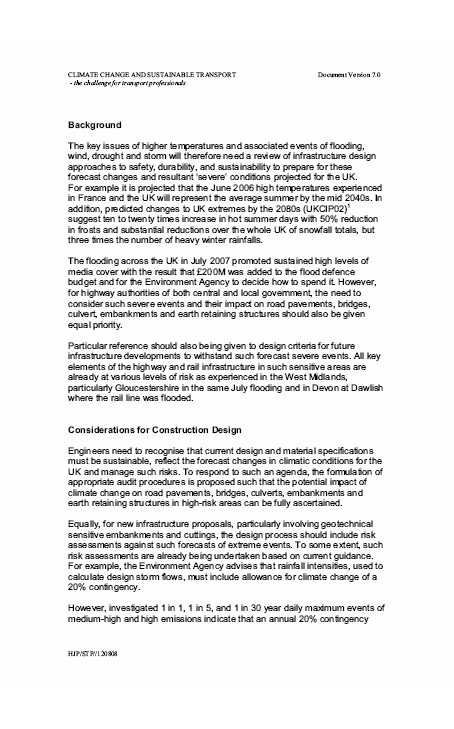
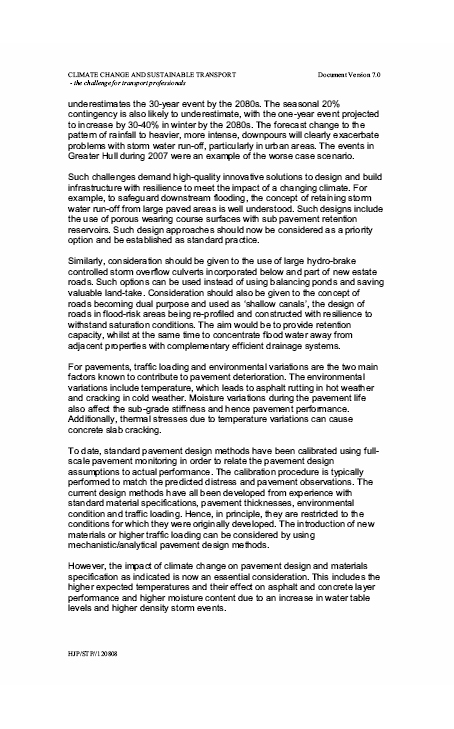
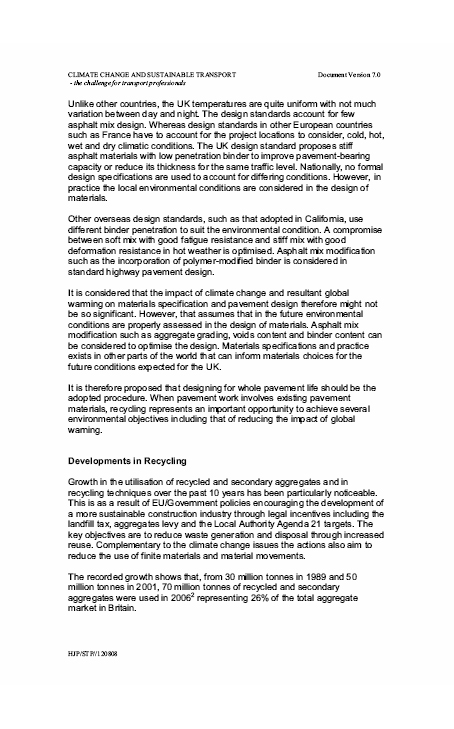


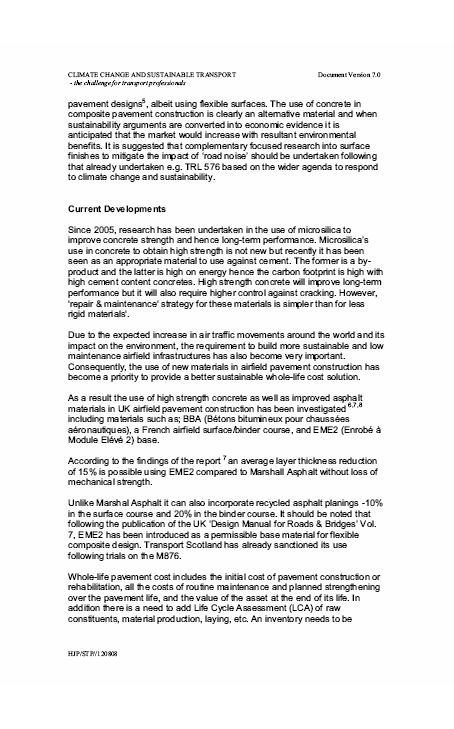
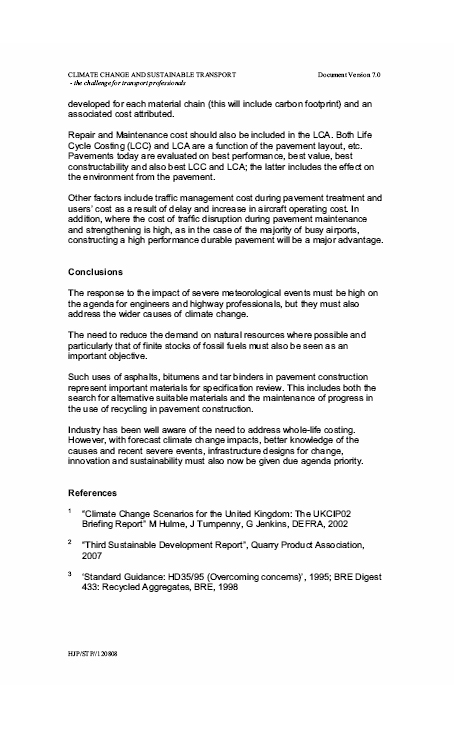

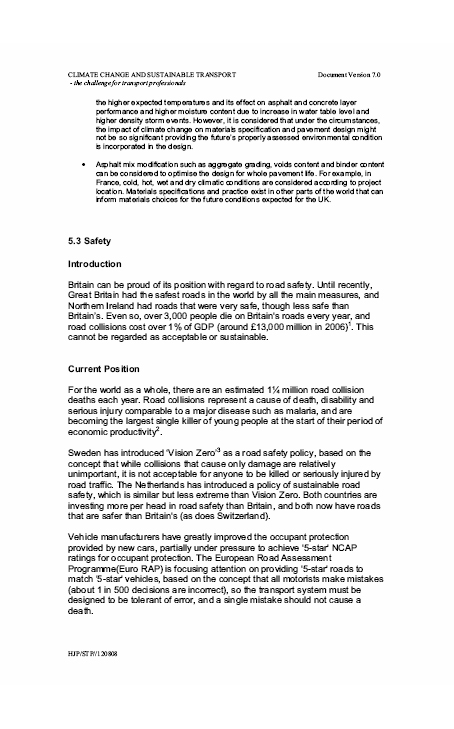
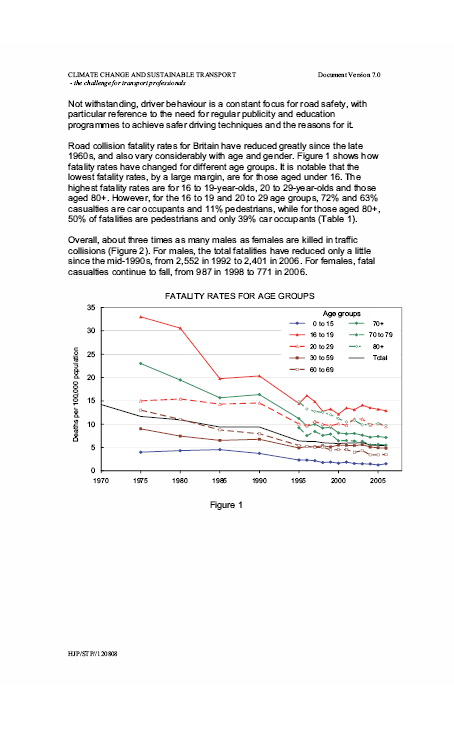
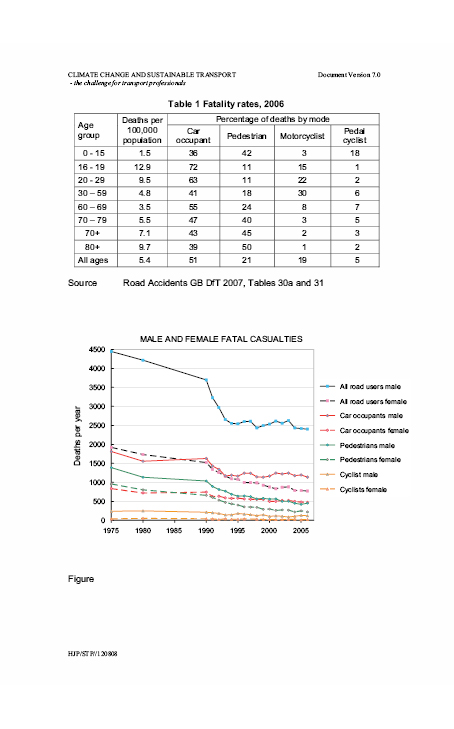
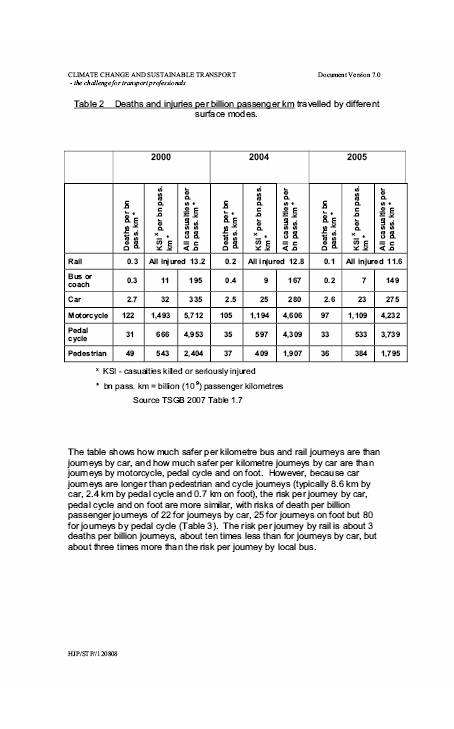


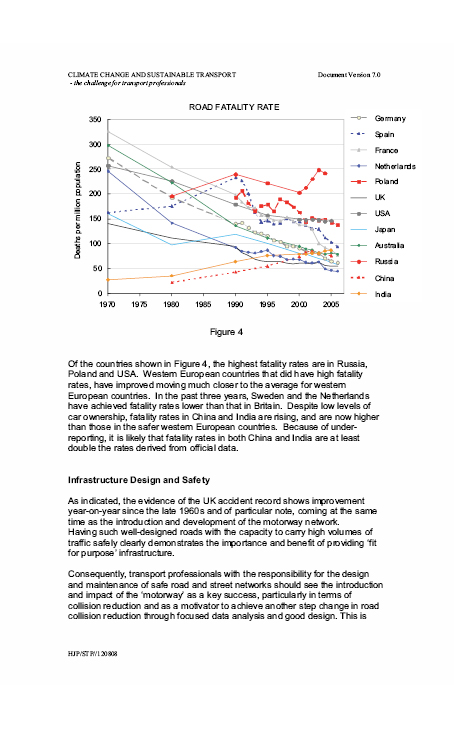
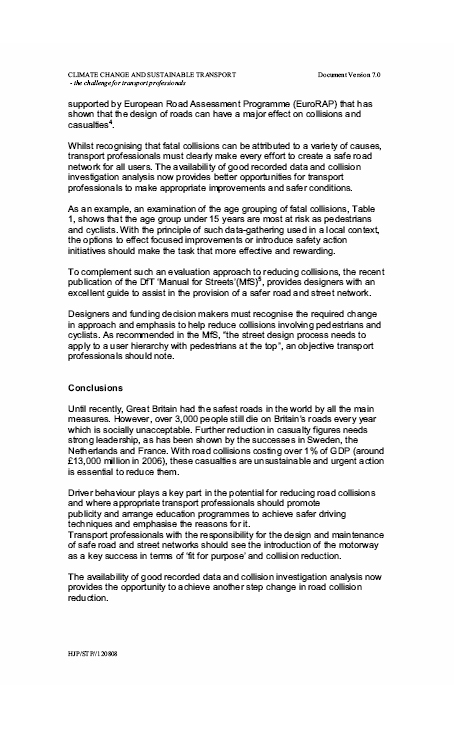
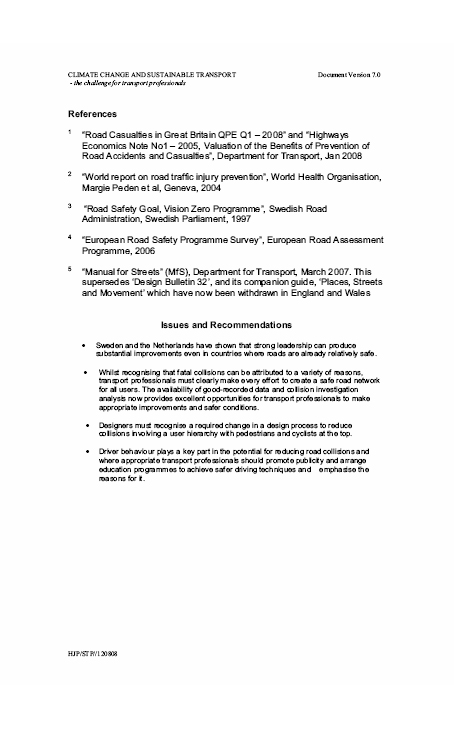

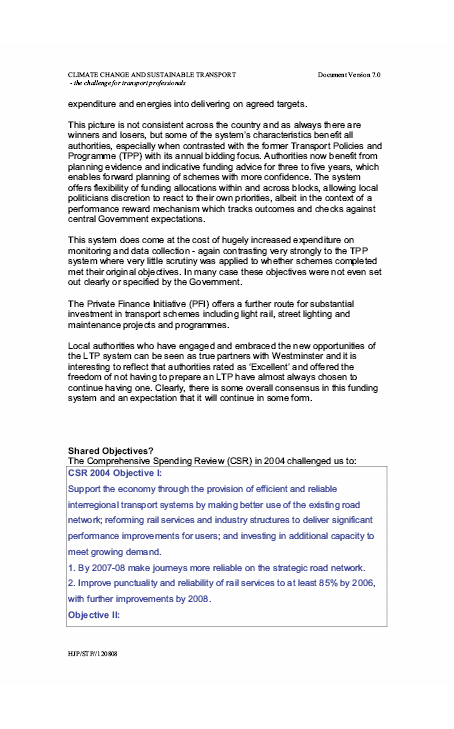
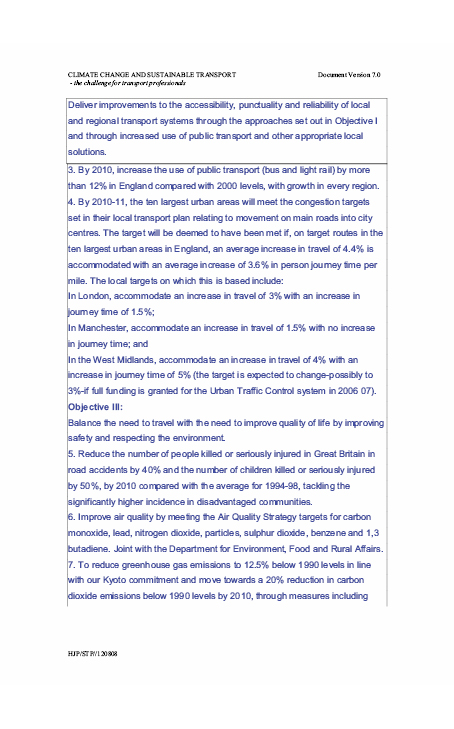

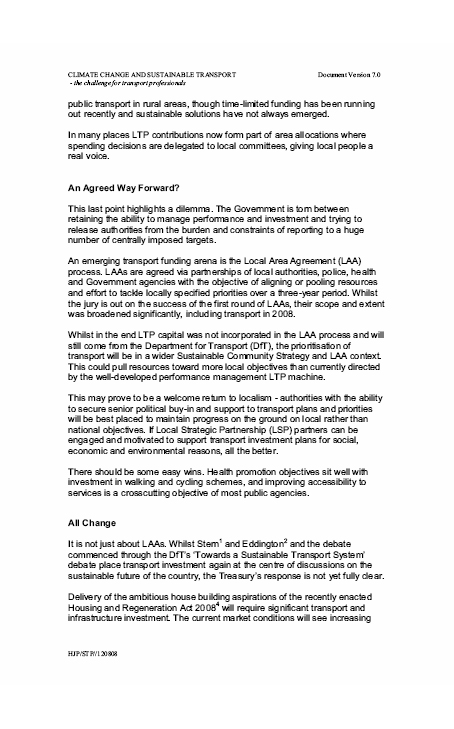

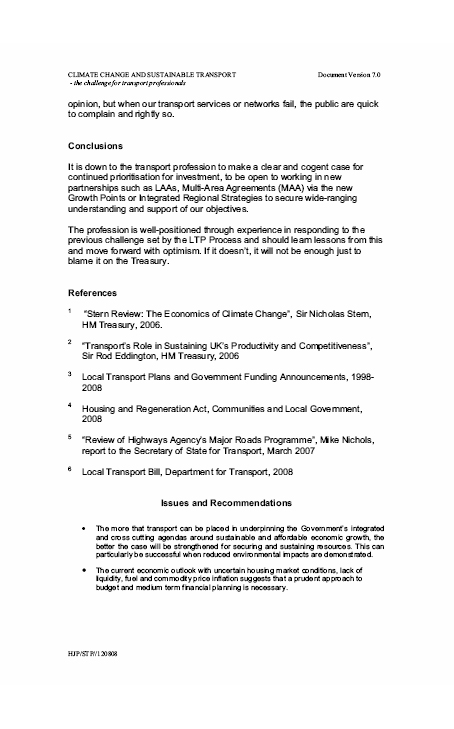

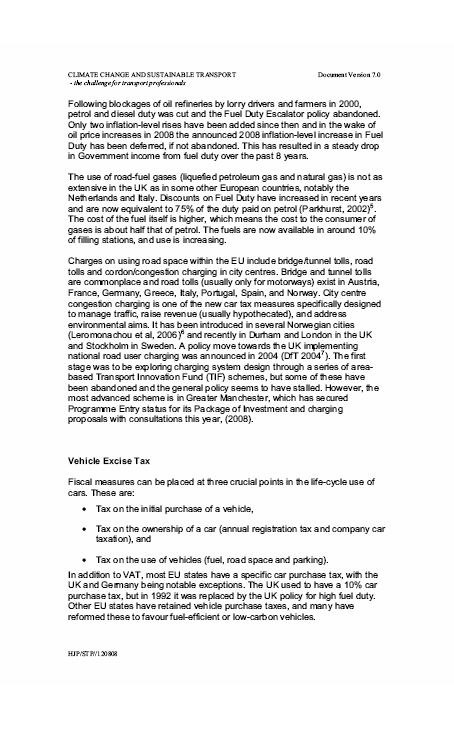
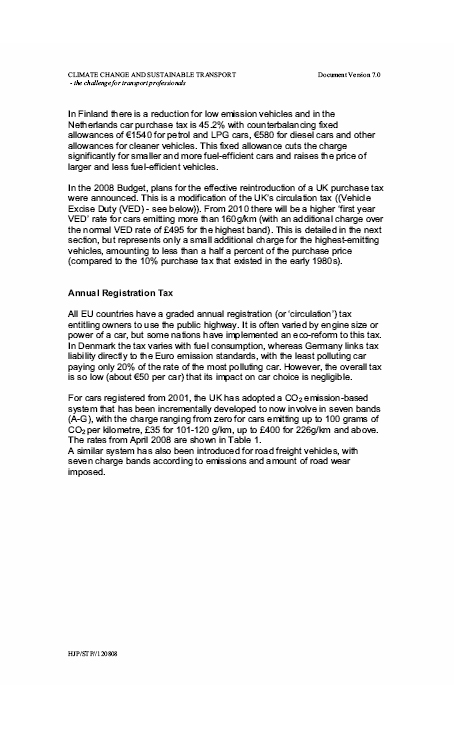
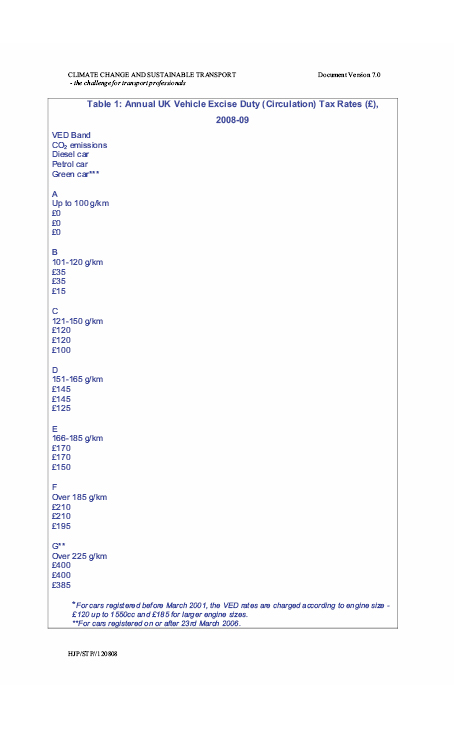
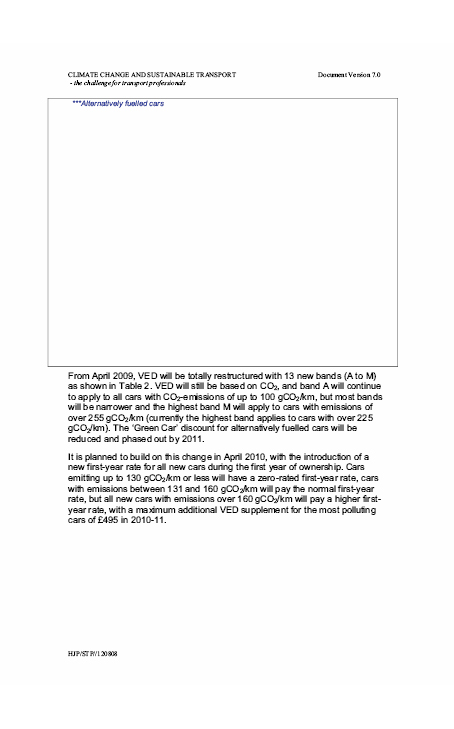
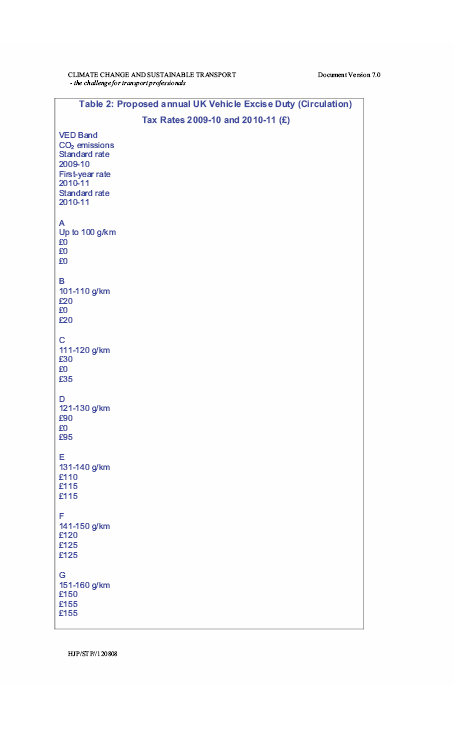
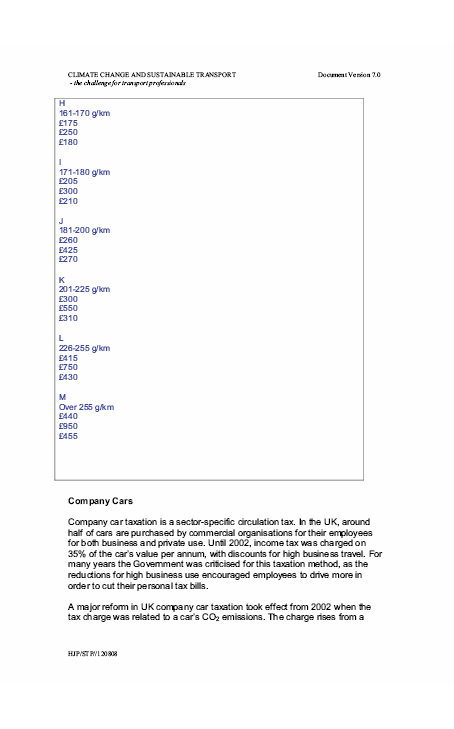
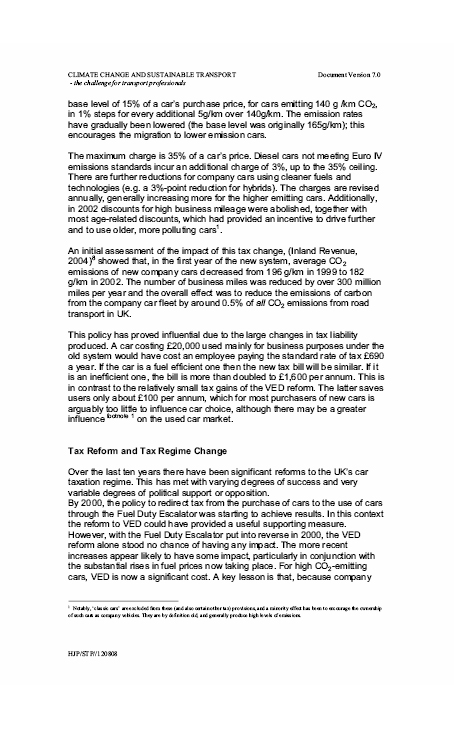
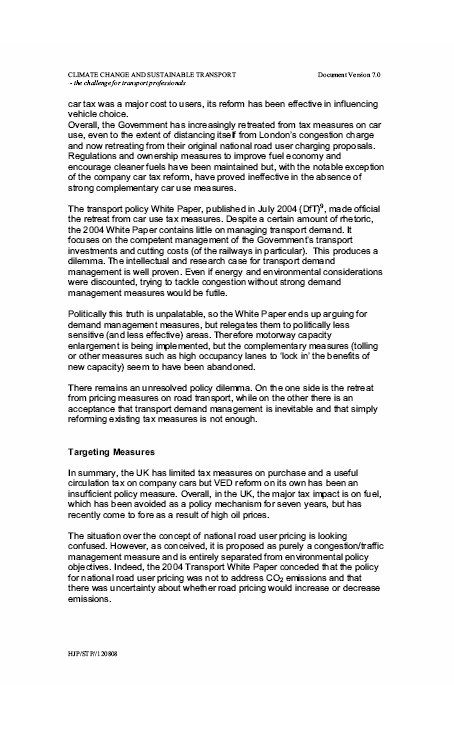
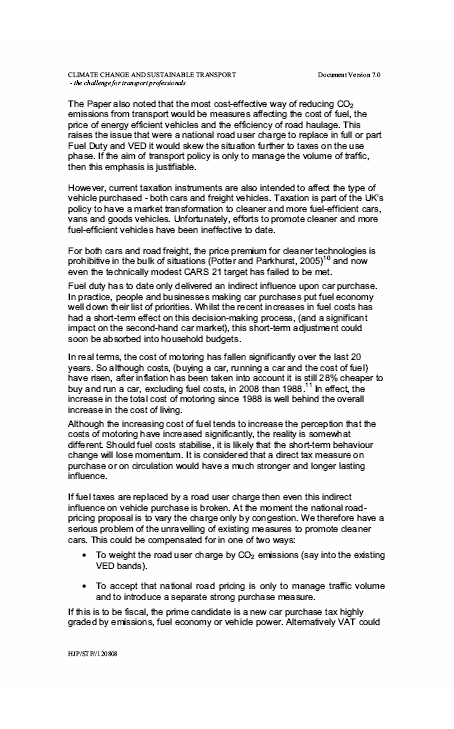

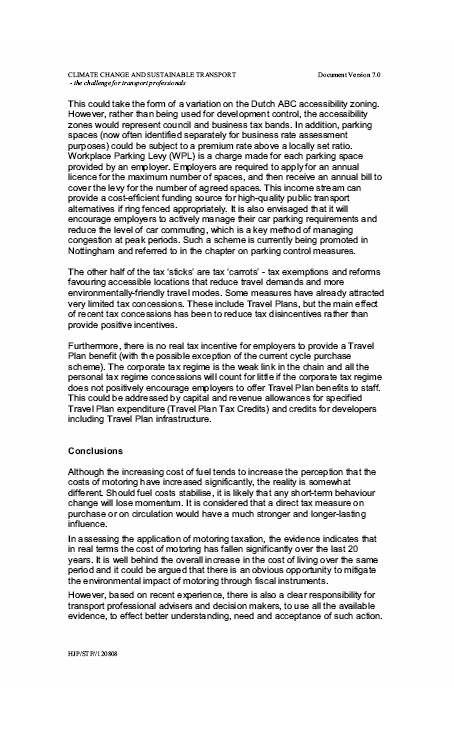
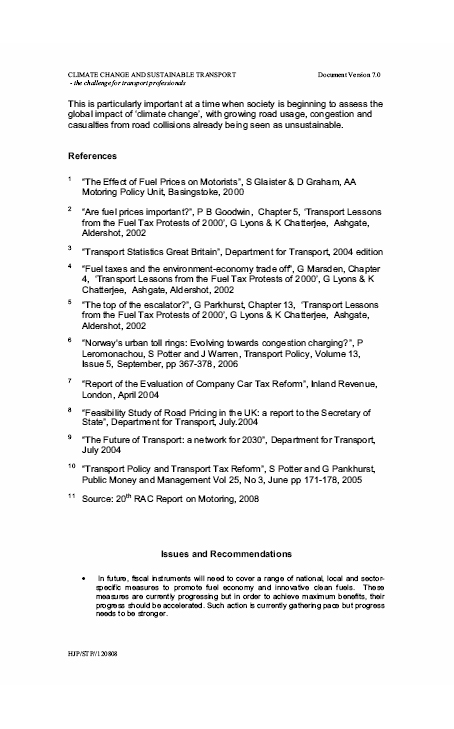
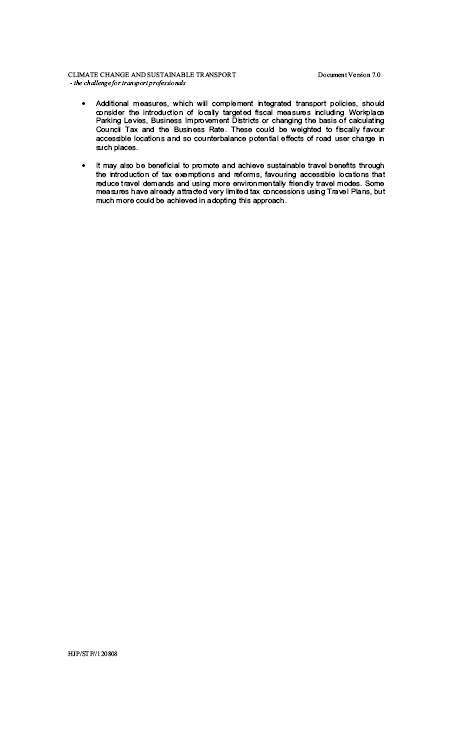
The Northern Ireland Branch of the Institution of Highways & Transportation welcomes the opportunity to contribute to the NI Assembly Environment Committee Inquiry into Climate Change.
We note that the Aim of the Inquiry is initially to understand the implications of climate change for Northern Ireland. While we recognise that there is ongoing debate and scientific study into trends in 'climate change' locally and globally, we believe that it is not appropriate to ignore the issues which may be contributing to those trends, actual or perceived. We also note the Committee's wish to make recommendations on government policies to mitigate the impacts, to examine economic implications and identify suitable adaptation initiatives.
The Institution of Highways & Transportation is a learned society with over 11,500 members. It is concerned specifically with the planning, design, construction, maintenance and operation of land-based transport systems and infrastructure.
IHT recognises that for transportation professionals the increase in the demand for transport represents a major challenge at a time when society is beginning to acknowledge and come to terms with the global impact of 'climate change'. For that reason, in November 2008, it published 'Climate Change and Sustainable Transport – the challenge for transport professionals' to contribute to professional practice and to assist all disciplines involved in the transport sector to address the consequential impacts of climate change. Our contribution to the Inquiry is based around the advice within this publication couched in terms of Northern Ireland's unique position within the United Kingdom. A copy of the Executive Summary and the full document are attached.
Long-term road transport, powered by fossil fuel, is not sustainable. It is contributing to the depletion of a finite stock of fossil fuel and emitting a rising amount of carbon dioxide. There is a need to address environmental impacts such as noxious emissions, noise and unsustainable land development that cause extended journey patterns. The transition to a sustainable transport system involves a combination of technological and transport demand policies.
However we accept for the needs of society and the economy of Northern Ireland good road infrastructure is essential to serve the transport needs of the community for the short to medium term.
We are alert to scientific evidence that has linked global warming with the increasing emission of greenhouse gases, with much of the increase in developed countries coming from transport. The fact that emissions from transport are increasing whilst emissions from other sectors are constant or reducing is of particular relevance for the UK where transport related emissions represent about a quarter of the total produced .
We also recognise the importance of a high performing transport system to the economic prosperity of the UK, and the key role of Northern Ireland's strategic links to the rest of the UK and to other European and world markets and destinations.
The Stern Review into the economics of climate change confirmed that emissions have been, and continue to be, driven by economic growth. Stern estimates that the costs of reducing the emission of green house gases are substantially less than the costs of repairing the damage caused by climate change.
Whether we believe in climate change or not, if we do nothing we may find that it will not be possible to turn back the clock and recover the lost opportunities of acting now.
Emission of anthropomorphic greenhouse gases has raised the concentration of carbon dioxide in the atmosphere from around 280 ppm before the industrial revolution to 383 ppm in 2007. In the last century the global average temperature has increased by about 0.9°C and the average temperature in central England by about 1.4°C . Emission of carbon dioxide is rising in many countries, though in EU27 it is falling.
In the United Kingdom, production of public electricity and heat is responsible for 31% of total emissions of CO2; all transport produces 23% of emissions, and car traffic 12.7% in 2005. Industry, households and services each produce about 15% of total emissions.
Emission of carbon dioxide from all car traffic was almost constant between 1993 and 2003, and is now falling. This implies that the fuel economy of the average car in service is improving faster than traffic is growing. Carbon dioxide emissions from road traffic are growing, but this growth is due to growing emissions from freight transport.
It is essential that planning polices and residential standards are reviewed to ensure they work with, rather than against, integrated transport where it can serve new developments. Sustaining integrated urban and suburban living patterns will become even more of a priority as fuel prices increase.
Reducing the need to travel will not be just an environmentalist objective, but it will become one necessitated by daily and weekly household budgeting. It will play an increasing role in choices about where to buy a house or where to seek work.
It is essential that reviews of the RDS and RTS provide for on-going strategic assessment of infrastructure and resource needs and take account of climate change, peak oil and the sustainable transport.
Policies must be strengthened to require contributions which can secure wider sustainable transport infrastructure for cyclists, pedestrians and complementary pump priming for bus service enhancements.
Demand for travel can be affected by measures that rely on persuasion and by measures that deter travel in a variety of ways. Provided attractive alternatives to the car are available, soft measures can be more effective than is appreciated by most transport planners.
Retail activity has changed over the past 20 years and retailers are continuing to adapt to the changing demands of consumers as technology advances, lifestyles change and as local and national government policies are changed and introduced. Key drivers for successful retailing are accessibility and consumer choice. Transport therefore plays a significant role either directly or indirectly in the future success of retailing and policies should reflect this.
Current trends suggest that e-shopping will become increasingly popular over the coming years, and while this may not reduce the number of trips to be made, it may change the type of trips that are made, with greater numbers of home deliveries.
?In the UK, agriculture and food accounts for nearly 30% of goods transported by road and food miles rose by 15% between 1992 and 2002. In 2002, food transport accounted for 25% of all HGV vehicle kilometres in the UK. Of imported produce, 95% of the fruit and 50% of the vegetables sold in the UK is grown abroad and the amount of food being flown into the UK doubled in the 1990s. The direct environmental, social and economic costs of food transport are over £9 billion each year and are dominated by congestion.
In addition to the reliance factor of UK imported produce, the wider implications of the unsustainable transportation impact need to be addressed at local, national and global levels..
In the planning and assessment of proposed new retail and shopping outlets, which includes the establishment of Farmer's Markets, a priority should be given to the accessibility and servicing by sustainable forms of transport such as good public transport, walking and cycling links with appropriate facilities.
The introduction of effective traffic and parking management policies and improvements to public transport could improve the accessibility of town centres. If implemented effectively, travel around urban areas should be more efficient for consumers and thus potentially make the urban centres increasingly accessible. It is important to understand the value that consumers place upon time and that congestion is a major factor in influencing the time taken to access retail facilities.
Northern Ireland is almost 100% dependant on road transport for the movement of freight. Fuel consumption by road freight has increased because the total mileage by goods vehicles has increased. The fastest growth has been for light vans, followed by articulated HGVs; traffic by rigid HGVs has not increased. Fuel consumption of individual HGVs has not increased, and remains steady at about 7 or 8 miles per gallon.
Freight distribution is a wholly commercial activity. The cost of fuel in 2008 was about 30% of the cost of freight operations, so anything that can be done at a reasonable price to reduce the amount of fuel used will be done for commercial reasons.
The total mileage by vans has increased because of the steady increase in the economic activities served by vans - courier services, mail and online shopping, visits by service engineers and tradesmen of all kinds. About a quarter of the total tonnage of UK domestic road freight are goods travelling to or from ports as imports or exports. Empty running of HGVs for particular commodities has reduced slightly, particularly for the movement of manufactured goods and petrol, but the changes are small.
Reducing the distances that goods are moved would require major changes in the supply chains and manufacturing processes that are served by road freight. This is not impossible, although supply chains, distribution arrangements and depot locations have been optimised, and the disincentives to change them are great.
?Improved operation management leading to the better utilisation of goods vehicles can reduce empty and part-loaded running.
?While pilot projects in the food distribution industry in GB have shown that long-distance road freight can be transferred to rail for the trunk stage of a journey, the restricted rail network in Ireland limits the opportunities although we recommend that opportunities should be kept under review.
Since the realisation that the philosophy of 'predict and provide', to keep pace with traffic growth, was not sustainable, a healthy awareness by transport professionals has emerged to consider alternative strategies and apply innovative measures to manage demand. The need to change travel choice behaviour to achieve sustainable objectives and project the existence of convenient, affordable and healthier acceptable alternative options is a priority. The provision of such options, timely information about travel opportunities, better marketing, advertising and good implementation initiatives have long been advocated by transport professionals. It is therefore considered appropriate for transport professionals to take the initiative, where possible, to engage with society to establish and promote such communication schemes.
While personal travel planning projects have demonstrated effective outcomes based upon area-wide approaches, there is a long-term opportunity to support this work by building upon existing networks and communication channels. Appropriate opportunities to target people would include during life-changing moments, when individuals may be most likely to deliberate about travel behaviour and break established habits. These could include when moving house or school, applying for a new job, obtaining an over-60 public transport pass and changes in public transport provision.
Travel plans should be developed to deal with different types of situations including school, hospital, residential and commercial business travel plans to mitigate the impact of new developments on local traffic and infrastructure to improve accessibility. Such schemes are considered essential particularly for new developments and implemented using the guidance provided by DfT.
Walking and cycling have strong contributions to make in creating sustainable places, increasing accessibility, enhancing neighbourhood cohesion, improving individual fitness and well-being, and reducing the environmental impact of transport.
Survey findings found that around a third of people would walk and cycle more if the facilities on offer were improved. Hence, improvements of facilities that would encourage walkers and cyclists, such as safe walking routes, better maintained footpaths, off road cycle lanes and the provision of better bicycle parking facilities might encourage more people to cycle and walk.
Measures to promote and develop walking and cycling should take high priority for investment in the urban transport hierarchy. Walking and cycling can result in significant savings in relation to health, pollution and congestion and strongly contributes to creating sustainable places, increasing accessibility and enhancing neighbourhood cohesion.
To facilitate and achieve better use of existing networks has been a particular objective since the realisation that the philosophy of 'predict and provide' for traffic growth was unsustainable.
The agenda must now extend from reducing congestion to the complementary and real need to secure greater benefits to reduce the impact of climate change. Innovative measures must be pursued with consideration of Traffic Demand Measures first, ahead of hard infrastructure solutions.
Better use of existing transport networks can also be achieved by the promotion of publicity campaigns to affect more efficient use of motorways by targeting driver behaviour for improvements in lane discipline.
It is accepted that public transport cannot be a substitute for many journeys – particularly those in less built-up and rural areas with diverse origins and destinations. As pressure increases for more sustainable transport, whether this arises from reduced availability and increasing cost of fossil fuels or from policies such as carbon rationing to limit climate change, then public transport will have an increasingly crucial role to play. This is particularly important in delivering accessibility in many of our communities. We should therefore be striving for a high volume, high quality public transport network that meets the needs of discerning customers, if we are to meet the challenges of future mobility.
The quality and quantity of public transport can be genuinely enhanced with greater innovation, thought and challenge. Public transport should therefore sit at the heart of local transport policy and practice.
If more people are to be persuaded to travel by public transport from choice, it is essential that the quality of service, the provision of information, ease and simplicity of use will need to outweigh the quality and comfort standards supplied by car manufacturers.
Treating people with dignity and respect is a key aspect of a fair and just society and it is important that transport operators treat their staff well, in terms of recruitment, training and promotion. It will also be an advantage if transport staff treat passengers with respect and similarly help and expect passengers to show similar courtesy.
Road User Charging is not a new concept but the delivery of such an approach remains controversial at both the local and national level. Charging schemes have the ability to influence choices of travel, aiming to reduce demand on the existing highway network, and improving the environment. It can also provide valuable revenue for the promotion and development of alternative modes. If they are to be successful, action needs to be taken towards promoting the positive aspects of schemes, counteracting the opinions generated through negative press coverage.
Car parking demand management measures have the possibility to significantly influence modal choice, but care needs to be given in particular to the migration of congestion to other areas. As with road user charging, parking control measures can also provide revenue support for improving access to public transport. It is therefore also considered important to ensure that these positive aspects of schemes are promoted to gain acceptance from travellers.
Road user charging has an important role to play in an integrated and equitable transport network with particular reference to urban areas. However, the arguments to promote such schemes need to be well prepared and that the benefits in terms of reduced congestion, CO2 emissions, and improved public transport services are clearly demonstratable
The fuel economy of cars has improved by about 24% since 1997, and there is no reason this improvement for cars will not continue. The fuel consumption of the car fleet, including 4 x 4s and MPVs, is reported to have only improved by 6% since 1993, although this is inconsistent with the slight fall in the total fuel used by cars since 1993, despite a 15% increase in car traffic. One reason for the relatively small reported improvement is the fashion for using large, heavy, bluff four-wheel drive vehicles on normal roads, as these have poor fuel consumption.
The fuel consumption of goods vehicles is being reduced, but the scope for savings is less than for cars.
Alternative electric propulsion is in an early stage, mainly because of the need for development of better batteries or fuel cells. Road transport must ultimately move to electric propulsion, but this will only reduce carbon emissions when electricity generation becomes much less carbon intensive.
The benefits of alternative fuels, other than hydrogen, which is in a very early stage of development, are marginal, with only small reductions in carbon emissions and possible adverse impacts on land-use and food production. However, even if the first generation of bio-fuels are not sustainable and probably release as much or more carbon over their life-cycle as conventional fuels, the second-generation fuels are expected to achieve a significant improvement in their life-cycle carbon emissions and result in a net benefit.
Driver training has been shown to achieve a 10% reduction in fuel consumption (SAFED, a one-day course on Safe and Fuel Efficient Driving has been shown to produce a typical reduction in fuel consumption of 10%).
Alternative electric propulsion is in an early development stage, mainly because of the need for development of better batteries or fuel cells, but should be considered for urban area use. Road transport must ultimately move to electric propulsion but this will only reduce carbon emissions when electricity generation becomes much less carbon intensive.
The description of Bio-fuels as a single category is over-simplistic. Some bio-fuels offer real savings in carbon emissions over the complete fuel cycle with few adverse environmental effects. Others offer little or no saving in carbon emissions and have large effects on land use and food production. It is necessary to assess the benefits of different bio-fuels separately and promote those that are truly sustainable.
The response to the impact of severe meteorological events must be high on the agenda for engineers and highway professionals, but they must also address the wider causes of climate change.
The need to reduce the demand on natural resources where possible and particularly that of finite stocks of fossil fuels must also be seen as an important objective. Such uses of asphalt, bitumen and tar binders in pavement construction represent important materials for specification review. This includes both the search for alternative suitable materials and the maintenance of progress in the use of recycling in pavement construction. Industry has been well aware of the need to address whole-life costing.
The key issues of higher temperatures and drought with associated events of flooding, wind and storm requires a review of infrastructure design approaches to safety, durability, and sustainability in order to prepare for these forecast changes and resultant 'severe' conditions projected for the UK.
Considerations should include the early identification of high-risk infrastructure with particular reference to public safety. Highway and transport authorities need to consider such severe events and their impact on road pavements, permanent ways, bridges, culvert, embankments and earth retaining structures.
Design criteria for future infrastructure developments should consider how to withstand such forecast severe events. This would include the use of sub-pavement reservoirs below car parks, storm overflow culverts below estate road networks and using urban roads as shallow canals in flood risk areas.
The implications for drainage systems and design assessments indicate a clear need to audit current facilities against such event forecasts. Although current Environment Agency guidance suggests an allowance for Climate Change of 20% contingency, the possibility of 30% should also be considered.
The impact of climate change, with global warming on pavement design and materials specification is also an essential consideration. This includes the higher expected temperatures and its effect on asphalt and concrete layer performance and higher moisture content due to increase in water table level and higher density storm events.
Asphalt mix modification such as aggregate grading, voids content and binder content can be considered to optimise the design for whole pavement life. For example, in France, cold, hot, wet and dry climatic conditions are considered according to project location. Materials specifications and practice exist in other parts of the world that can inform materials choices for the future conditions expected for the UK.
While this Inquiry is related to Climate Change we believe that regard must not be lost for the safety of those using the transport network and all proposals that affect transport performance must to ensure that publicity and education programmes continue to promote safer driving techniques and emphasise the reasons for it
The current economic outlook with uncertain housing market conditions, lack of liquidity, fuel and commodity price inflation suggests that a prudent approach to budget and medium term financial planning is necessary. In view of the trends being identified in global warming and climate change and the irreversible damage that will occur if insufficient or inappropriate action is taken, bold decisions are required on investment in policies and measures that will sustainably address and slow down or reverse trends.
Although the increasing cost of fuel tends to increase the perception that the costs of motoring have increased significantly, the reality is somewhat different. Should fuel costs stabilise, it is likely that any short-term behaviour change will lose momentum. It is considered that a direct tax measure on purchase or on circulation would have a much stronger and longer-lasting influence.
In assessing the application of motoring taxation, the evidence indicates that in real terms the cost of motoring has fallen significantly over the last 20 years. It is well behind the overall increase in the cost of living over the same period and it could be argued that there is an obvious opportunity to mitigate the environmental impact of motoring through fiscal instruments. However, based on recent experience, there is also a clear responsibility for transport professional advisers and decision makers, to use all the available evidence, to effect better understanding, need and acceptance of such action.
This is particularly important at a time when society is beginning to assess the global impact of 'climate change', with growing road usage, congestion and casualties from road collisions already being seen as unsustainable.
In future, fiscal instruments will need to cover a range of national, local and sector-specific measures to promote fuel economy and innovative clean fuels. These measures are currently progressing but in order to achieve maximum benefits, their progress should be accelerated. Such action is currently gathering pace but progress needs to be stronger.
Additional measures, which will complement integrated transport policies, should consider the introduction of locally targeted fiscal measures including Workplace Parking Levies, Business Improvement Districts or changing the basis of calculating Domestic and Business rates. These could be weighted to fiscally favour accessible locations and so counterbalance potential effects of road user charge in such places.
It may also be beneficial to promote and achieve sustainable travel benefits through the introduction of tax exemptions and reforms, favouring accessible locations that reduce travel demands and using more environmentally friendly travel modes. Some measures have already attracted very limited tax concessions using Travel Plans, but much more could be achieved in adopting this approach.
As global fossil fuel sources become further depleted the need to replace them with sustainable sources becomes more urgent. Electricity has been a base energy source for many decades but in NI has been largely dependant on fossil fuels although the interconnector to GB means that some of NI's electricity consumption is met by nuclear generation. It may be years before NI's road based transport can be refocused on an electric based or other sustainable fuel system. The use of fossil fuels for much of our energy demand must be replaced by development of alternative and sustainable fuel sources.
NI, with extensive rural countryside, long coastline and situation on the edge of the Atlantic Ocean, is well placed to develop alternative power sources. Generation from wind and water as well as managed cultivation of crops for bio fuels or as fuel for power generation plants must be facilitated by sensitive but clear planning policies and economic support packages.
As waste disposal is also a major transportation and environmental problem for Ireland generally, careful consideration must be given to establishing strategic power and heat generation plants fuelled by waste.
Highways and transportation professionals recognise that their industry has an impact on the environment, on society and on the performance of the economy and seek to minimise and mitigate the negative impacts while maximising the positive impacts.
The IHT believes that it is essential for Ireland, both North and South, to become more self sufficient in energy as an economic and climate change priority.
Freight movement, on which much of our economy depends, is totally road based within NI. If transport impacts on the environment and climate are to be minimised there needs to be an ongoing investment in both transport infrastructure and transport technology to ensure efficient and sustainable movement of goods and people.
Most importantly there is need for behavioural change. The climate change message needs to be clearly communicated to the public and in particular the a general public duty to adapt and mitigate the impact of their desire to travel. Many areas including energy and water saving, waste recycling, and and promotion of alternative modes of transport all should be part of the behaviour change agenda. Leadership and commitment from business and political leaders is required. Potentially unpopular decisions will have to be taken if unsustainable trends are to be reversed.
The investment to date in transport must now be underpinned by the RDS and RTS reviews to ensure continued and sustainable economic benefit. IHT supports the investment in Public transport set out in the BMTP and reinforced by the DRD Minister's public announcements. A high quality integrated public transport system for the Belfast urban area will offer an alternative to car travel and, with the help of investment in park and ride sites and demand management measures ,encourage the public to use public transport and so reduce CO2 emissions.
Road user charging/pricing has potential to contribute to a reduction in CO2 emissions and must be fully reinvestigated. Money raised should be "ring fenced" for investment in public transport. 60% of people in the GB prefer Road User Charging to car tax. ( ICE ) Pricing at "point of use" tackles congestion and CO2 emissions ( IHT )
Failure to maintain our road infrastructure to serviceable standards will be a significant issue in terms of sustainability. Poor road conditions slows traffic, creates unsafe conditions and damages vehicles, all of which increases costs on the economy. Reconstruction of our roads following failure, as opposed to resurfacing requires more materials, fuel etc and could have a significant detrimental impact on our environment.
Greater priority needs to be given to development of sustainable renewable energy sources in Ireland. Development of wind energy sites which is an established source, is essential and will require strategic planning and bold decisions.
The independent members of the Northern Ireland Cycling Forum Board welcome the opportunity to contribute to the Environment Committee's Inquiry.
The NI Cycling Forum Board oversees the implementation of the NI Cycling Strategy. Membership of the Forum comprises staff from the Department of Regional Development, Government Agencies, Local Councils and non-governmental cycling organizations, Sustrans, CTC and the NI Cycling Initiative.
The Forum's independent members hold posts on the Forum on a voluntary, unpaid basis.
The short response time to the consultation constrained our ability to produce an in depth comprehensive response however we would welcome an invitation to present further to the committee if the committee considers it advantageous
The UK government has, by way of the Climate Change Act, made a commitment to the reduction of net UK carbon emissions of at least 80% by 2050 on a 1990 baseline. To meet this ambitious target it is vital that all countries of the UK fully contribute with efforts to reduce carbon emissions.
Current transport activities and policies within NI are not enabling reductions in carbon emissions and on current trends will result in an increase in emissions from the sector by 2050. To compound problems NI road surface transport system is nearly 100% dependent on imported fossil fuel, and as a result a significant amount of NI's annual wealth is consumed by payment for fossil fuel. The Royal Commission on Environmental Pollution concluded that the only fair, acceptable and workable method of implementing carbon reduction was to allocate carbon emission quotas to nations on a per capita basis upon which each would be expected to converge towards over 50 to 100 years
It is vital that there is a committment to reduce net carbon emissions from Northern Ireland's transport system by improving alternatives to the car travel and by providing sufficient investment to make low carbon travel a reality for people.
To consider the necessary actions and a route map for each significant sector in Northern Ireland (energy, transport, agriculture and land use, business, domestic, public sector etc)
Reducing work-related and shopping car travel. Making big cuts in car commuting and shopping car travel would have a big impact. Commuting, business and shopping related travel accounts for over 44% of all adult journeys in NI[1]. People are taking long journeys by themselves – 91% of car commuting and 87% of business car trips are single occupancy journeys[2]. Travel plans should be promoted to businesses to promote alternatives to car travel and shared car travel.
Reducing journey lengths and transfer short car journeys to walking and cycling. People are travelling longer distances to get to essential services or their places of work. Car journeys less than five miles account for 20% of UK passenger transport CO2 – shifting some of these to walking and cycling will help cut congestion and obesity and improve health too. In NI 63% of all journeys are less than 5 miles[3] (a 30 minute bike ride). 97% of rural dwellers in NI live within 5 miles of a rural settlement[4]
The recent economic report into carbon reduction by Lord Turner[5] suggests
"Lifestyle-change (e.g. substituting cycling for driving on short trips) will reduce energy consumption/production, with households reallocating expenditure towards less energy intensive goods and services. This will have no significant impact on GDP"
The Campaign for Better Transport recently published a report[6] which shows how to reduce carbon emissions from transport through a comprehensive package of transport policies mostly extensions of current practices building on past successes.
To identify the costs associated with meeting these obligations and compare them with the costs that will be incurred if they are not achieved.
We look to informed expert knowledge for carbon cost mechanisms and the implication of the cost arising from climate change. Transport externalities excluding carbon and air quality already cost NI society nearly one billion pounds per annum through obesity and road traffic collisions[7] Lord Turners report suggest carbon budgeting around 1% GDP
The Carbon Trust[8] estimates annual cost of carbon reduction in NI through to 2030 between £25 million and £55 million - less than half the annual cost of the NI Assembly
To identify a formal cost effective mechanism for assessing the potential impact of new policies on climate change / CO 2 emissions. (Akin to Regulatory Impact Assessments/Rural Proofing)
We look to informed expert knowledge on these issues and note that the Energy Saving Trust show rural households emit more GHGs[9] than urban households.
Will the principle polluter pays hold true?
To make recommendations for appropriate targets/actions that could be included in the new Northern Ireland Sustainable Development Implementation Plan.
We suggest targets could include the number of children cycling and walking to school. The reduction of car parking spaces provided free to the NI Civil Service and the dependence of the Health Service on private motorised transport. Reducing the annual distance traveled in NI by private motor car. Increase in public transport patronage
To make recommendations on a public service agreement for the DOE Climate Change Unit's commitments in the second Programme for Government that will ensure Northern Ireland will meet its climate change obligations.
The public service agreement must include a targeted and measured reduction in GHGs arising from departmental transport including how the public and employees travel to various government buildings. The current Regional Development and Transport Strategies are long on talk of sustainability but short on the strategies that implement sustainability as measured by the ever increasing rates of GHG emissions from road transport. Targets should be set to reduce CO2 emissions from transport and measures outlined how to make this happen. There is an opportunity to do this given the imminent review of the Regional Transportation Strategy.
To consider what secondary legislation raising powers within the UK Climate Change Act would contribute to Northern Ireland's commitment to the UK Climate Change Act.
Adapt the legislation of local taxation and rating to allow for the carbon taxation of emissions associated with car parking provision and location.
To express views on if and how the Assembly might conduct more effective scrutiny of climate change responsibilities across all relevant departments.
Climate change science robustly demonstrates that climate change is happening. If the anthropomorphic effects on climate are not constrained the late adulthood of NI's current generation of young children will be seriously compromised. The Assembly is obliged to act and shoulder responsibility for the highest rates by household of GHG emissions in the U[10]
The Assembly must give teeth and resources to scrutiny on a regular and searching basis
According to the Met Office, in their 2007 Report 'Together: Make a difference to your climate with the Met Office', the UK's transport system could be severely affected as a result of the effects of climate change. Prolonged high temperatures caused by climate change could cause road surfaces to melt and railway lines to buckle, creating delays and disruption. Railways would be threatened with wetter UK winters, greater storminess, coastal erosion and sea-level rise.
It is essential that mitigating climate change be a priority for the Assembly but in addition that work be undertaken to prepare for mitigation of some of the effects of climate change on our transport networks. Research should be undertaken on adapting materials and techniques in highway works to the changing climate, together with a full assessment of how to manage the risk from climate change to its roads, walking and cycling networks.
[1] Travel Survey for NI 2005-2007 Dept for Regional Development
[2] Campaign for Better Transport
[3] Travel Survey for NI 2005-2007 Dept for Regional Development
[4] Rural Settlement Patterns and Access to development land: Developing the Evidence base
[5] Building a low Carbon Economy http://hmccc.s3.amazonaws.com/pdf/TSO-ClimateChange.pdf
[6] Shrinking Carbon Improving Lives – A plan for reaching Climate Change Goals, Campaign for Better Transport November 2008 http://www.bettertransport.org.uk/system/files/Low_carbon_companion_report_0.pdf
[7] NI population is the least active most obese population in the UK. Obesity costs in NI are£500 million pa and Road Traffic Collisions in NI cost £450 million pa
[8] Carbon Trust Northern Ireland Vision Study for NI published 2005 http://www.carbontrust.co.uk/Publications/publicationdetail.htm?productid=CTC520
[9] GHG - Green House Gas
[10] Green Barometer Three Energy Saving Trust November 2007

Committee on Climate Change,
Area 7B,
3-8 Whitehall Place,
London SW1A 2HH
T: +44 (0)207 270 1916
F: +44 (0)207 270 8309
E: enquiries@theccc.gsi.gov.uk
Web: www.theccc.org.uk
To meet the obligations laid out in the Climate Change Act (2008) the Committee on Climate Change set out recommendations for the level of UK carbon budgets in its inaugural report "Building a low carbon economy – the UK's contribution to tackling climate change". The Committee advised that budgets apply to all greenhouse gases (GHGs), as defined in the Kyoto basket, and exclude emissions from international aviation and shipping, pending agreement on their treatment internationally. The UK budgets imply a reduction in emissions of 31% against 2005 levels by 2020, should a global deal to tackle emissions be reached, with a 21% reduction required in the interim. The Committee advised that no limit was required on purchase of EUA's in the traded sector, whilst the purchase of offset credits should be strictly limited in the Interim budgets to ensure a minimum level of domestic effort.
This advice did not specify precisely how budgets should be met, either at a sectoral or regional level. However, it did suggest that the pattern of abatement ought to reflect the costliness of emissions reductions, the actions required on the path to an 80% reduction in UK GHG emissions by 2050 and the availability of policy levers to unlock emissions reductions.
The Committee has made an initial assessment of Northern Ireland's share of abatement opportunities as a proportion of the UK total. This work identifies over 2 million tonnes of carbon dioxide equivalent (CO2e) of abatement potential in Northern Ireland in 2020, including:
Given the indicative nature of the analysis for Northern Ireland to date, the Committee recommends that further work is required in identifying appropriate climate change targets in Northern Ireland. However, the Committee's work to date highlights that there are opportunities for significant emissions reductions in Northern Ireland.
The Committee also notes that the Climate Change Act 2008 does not require commitments to be made by Northern Ireland in relation to meeting UK carbon budgets.
The Committee has not yet advised on the precise sectoral contributions or necessary actions required to meet carbon budgets. In the first progress report to the UK parliament, to be provided in September 2009, the Committee's focus will be to set out a UK level framework against which future progress in reducing emissions can be monitored.
A key component will be to develop a set of leading indicators to drive forward the emissions reduction pathway to 2020 and help measure progress in achieving a low carbon economy. There will be four levels of indicators:
The Committee is not currently in a position to advise on necessary actions or a sectoral road map for Northern Ireland. The principles established in the progress report will provide an appropriate framework around which to base an approach for Northern Ireland.
The Committee estimates the UK macroeconomic impact of meeting carbon budgets in 2020 would be under 1% of GDP. Meeting required reductions to 2050 are expected to cost around 1-2% of GDP in the UK, or 1-3% of GDP globally.
The Committee believes that this cost is affordable and necessary if larger climate change costs and consequences are to be avoided.
The Committee has not estimated the macroeconomic impact in Northern Ireland.
Not covered by CCC's analysis
See response to 'b'.
Not covered by CCC's analysis
Not covered by CCC's analysis
Not covered by CCC's analysis
Setting a carbon price – either by means of taxes or via an emissions trading scheme – allows environmental policy to be directed fairly at aviation emissions, without favourable or unfavourable treatment in relation to other sources of carbon emissions. The use of taxes requires direct government intervention in levying taxes, and changes in the level of taxes may have to be made regularly and frequently. Decisions on changes to tax rates may be open to distortion by political influences. In the case of aviation, it is not clear which authority within the EU would determine the level of taxes or charges, who would levy them, and what would happen to the revenues raised. To be effective, a carbon taxation regime would have to be imposed consistently across a broad geographical basis, raising concerns about the implicit loss of sovereignty and re-awakening fears about EU-wide tax harmonisation.
There are therefore merits in the inclusion of aviation within the EU's emissions trading scheme. Perhaps because airlines have warmed to it so readily, the ETS has come to be regarded as an easy option for the aviation industry. This perception does not stand up to close scrutiny. If the ETS is operated in a strict manner, with none of the laxity of phase 1, airlines will have to pay heavily for their right to pollute. And the greater their share of total emissions, the more they will have to pay.
Some have expressed fears that the growth in air travel will cause aviation to infect other industries in achieving cuts in greenhous gas (GHG) emissions. For instance, the Tyndall Centre17 estimates that unconstrained growth in air travel could account for more than the UK's entire carbon budget (65 mtC) by 2050. In practice, this phenomenon would appear in the form of sharply higher permit prices within the ETS, adding substantially to the cost of pollution by all sectors of the economy. It would also increase the cost of flying enormously.
These fears are probably exaggerated. In reality, prices would be pushed up more gradually over a period of many years, incentivising all sectors to improve their performance through new technology and fuel efficiencies. By raising permit prices for other sectors, the market is signalling that the most efficient solution is for them to invest in low carbon technologies. Airlines face greater difficulty in finding alternatives to aviation fuel, and will be left to fork out higher prices to pay for their own pollution.
Attempts to stigmatise air travel are therefore misplaced, and contrary to the principles of intelligent policy design. Air travel should be treated in exactly the same way as any other environmentally damaging activity, and pay its full environmental costs – no more, no less.
Policies that are aimed explicitly at reducing the growth of air travel in its own right have not been evaluated properly for their impact on the environment, the economy and society's general wellbeing.
An optimal policy framework would seek to bear down on total greenhouse gas emissions regardless of their source, while leaving society to determine how the reductions should be allocated to different activities. The market – if supported by policies to ensure that environmental externalities are fully captured in prices – is best placed to do this, making full allowance for consumers' preferences, and the different marginal costs of abatement of different industries. Attempts to force particular activities such as air travel to bear the brunt of emissions reductions will only increase the costs to the economy and to society of achieving any given reduction in pollution.
A low carbon economy in Northern Ireland is likely to be powered by a balanced mix of renewable energy, natural gas and oil. Some electricity will also be imported from the UK mainland. Cultural attitudes will have been transformed such that sustainability is at the heart of government policy and high on the business agenda. Other prominent features of this 'vision' of the future that will help to ensure the RCEP's recommendations are met include:
Hydrogen (see Box C) and biomass fuels (see Box D) will play an important role in the development of low carbon transport. However, the exact timing of the mass production of alternative fuel vehicles will depend on the progress of fuel cell research programmes in the USA and Japan, and on whether the UK and other EU member states adopt targets for the use of low emission vehicles. Nevertheless, the abundance of local renewable energy sources means that Northern Ireland is well placed to exploit these new technologies as they become available.
Hydrogen looks likely to play a key role in future low carbon energy systems, as an energy carrier or 'vector' through which renewable energy can replace fossil fuel in applications as fuelcell powered vehicles and small-scale domestic combined heat and power (CHP) units.
Hydrogen-fuelled vehicles generate no carbon emissions at the point of use, and hence most experts believe they can provide a low carbon alternative to petrol and diesel-driven vehicles. As a result, multi-billion dollar research programmes are underway in the USA and Japan to develop fuels cells that are suitable for mass production and use in consumer vehicles, and to produce safe and cost-effective hydrogen production, storage and distribution systems.
Hydrogen can be produced from a range of sources including fossil fuels, biomass and waste products, or the electrolysis of water. This last option opens up the possibility of generating hydrogen from renewable energy and the widespread use of 'zero emission vehicles'.
The development costs of a hydrogen generation, storage and distribution infrastructure are high. Experts are still debating its relative merits compared with potential alternatives such as carbon dioxide capture and storage technology. However, because of its compact nature, Northern Ireland could be a suitable location to pilot the technology prior to its wider use.
A number of countries are building demonstration-scale hydrogen generation and storage plants that will allow the overall economics and technical feasibility of the technologies involved to be assessed. For example, Iceland has set itself the goal of developing a hydrogen economy within the next 30 years and similar efforts are underway in Hawaii and Norway.
These countries are able to use low-cost electricity from hydro and geothermal schemes to generate hydrogen, whereas Northern Ireland's renewable energy resources are much more expensive to develop (see Box G). Nevertheless, Northern Ireland could lead the UK by demonstrating the use of hydrogen in local transport fleets such as buses and taxis.
Underpinning this vision is the assumption that a more rational use will be made of energy resources, forced in part by rising energy prices due to declining oil and gas reserves, but also by the widespread adoption of energy efficiency measures and more sustainable lifestyles.
While implementing the necessary changes to realise our vision will be challenging, they should ensure the development of a prosperous low carbon economy in Northern Ireland by 2050, growing at rate of 2.5% per year, with average incomes close to the UK average.
Unemployment should still be low, with a strongly growing service sector and a prosperous manufacturing sector focused on producing high-value goods and environmental technology.
Although there will have been a shift towards higher technology manufacturing, the agriculture and food manufacturing sectors will still be substantial employers.
Alongside hydrogen produced from renewable energy, the use of bio-energy made from biomass is an alternative way of fuelling lower emission 'carbon neutral' vehicles. Northern Ireland is rich in sources of biomass such as farm wastes and forestry residues but, if necessary, it could also grow crops to support the production of bioethanol and biodiesel. These biofuels can also be blended with fossil fuels to produce lower carbon fuels that can be used by existing vehicles.
Biofuels could also be used for large-scale power generation, in CHP schemes in industry and buildings and, on a smaller scale, for domestic heating applications.
Northern Ireland has the potential to produce enough bio-energy to satisfy at least 5% of its energy demand by 2050 (see table below), and exploitation would secure many jobs in rural areas. Its development could also have a positive environmental impact where energy crops displace intensive agriculture, provided local biodiversity is maintained by growing native species.
The energy markets in Northern Ireland are also more favourable to the use of biomass than in many other areas of the UK due to the limited penetration of natural gas and Northern Ireland's essentially rural character. There is also growing enthusiasm for the development of bio-energy resources for use in heating and CHP. Co-firing of wood and energy crops with coal at the Kilroot power station is also a short-term option that could provide an initial start-up market for the technology. In the longer term, however, the main markets for bio-energy are likely to be domestic and process heating rather than electricity generation.
The successful development of local bio-energy resources will require substantial Government support, particularly in the early stages of development when new infrastructure for collecting, processing and transporting biomass will be required. Support will also be needed to develop the local skills base, to raise public awareness of the environmental benefits of
Surface transport also sees very deep emissions reductions, albeit more slowly than in the electricity sector.
In the Anderson model, the transport sector starts significant decarbonisation only after 2015. First and second generation biofuels play some role, in both surface transport and in aviation.
In aviation, they make up a third of fuel used by 2050. However, hydrogen 26 also plays a substantial role in surface transport, making up almost 20% of energy used by 2050.
In the MARKAL-MACRO model, road transport also sees a major restructuring, with a move to much greater efficiency in engines in cars, and the introduction of hybrids in vans and buses. Biodiesel use (especially second-generation biodiesel27) begins to take off from 2010 across all vehicle classes, and by 2030 conventional diesel has been largely phased out (Figure 5).
However, there are limits to the use of first-generation biofuels in cars, with biodiesel and methanol peaking in 2050 at around 4.5 Mtoe (million tonnes of oil equivalent), or around 17% of current car fuel use. But by 2030 'Fischer-Tropsch' diesel, a second generation biofuel produced from solid biomass, is already emerging as the most important fuel in the mix for cars. By 2050, 70% of fuel used in cars is F-T diesel.
The heavy goods vehicle fleet converts to hydrogen (mainly from electrolysis from zero carbon electricity) by 2030. Rail switches over entirely from diesel (which currently accounts for 60% of energy use in rail) to electricity. Despite more efficient vehicles, overall energy use in transport increases, meaning that mobility across the economy continues to rise.
Air transport is the least transformed sector, with the least low carbon fuel substitution (none at all in the MARKAL-MACRO model), meaning that kerosene jet fuel continues to be used. However, a combination of increased fuel efficiency and the deep decarbonisation in other sectors means that a modest expansion of air travel (30% over current levels in the MARKAL-MACRO model) is still possible.

Rural Policy Division
Room 405
Dundonald House
Upper Newtownards Road
Belfast
BT4 3SB
Committee Clerk
Regional Development Committee
Parliament Buildings. 11 December 2009
Dear
Thank you for your letter which was forwarded to DARD by the Agriculture and Rural Development Clerk seeking DARD's views on this issue. I can advise that Minister Gildernew has a particular interest in the sustainability of transport in rural areas. Transport and access are key issues in helping to tackle exclusion and isolation, particularly in rural areas where this is a key concern for the elderly. Isolation is also a big issue for the disabled in rural areas.
You will be aware that DARD is leading on the development of an Executive wide Rural White Paper with the key aim of identifying measures which the Executive can take to address the needs of rural communities and ultimately help to ensure the sustainability of rural areas. Stakeholders are considering a wide range of issues that will help people living in rural areas. One of the key issues coming out of the stakeholder work is access and availability of rural transport as this can have an impact on many other services.
DARD has been working closely with the Department for Regional Development (DRD) on rural transport and Minister Gildernew, along with Minister Murphy recently announced the introduction of two new rural transport schemes, Dial-a-Lift and the Assisted Rural Transport Scheme (ARTS), which have been developed to help meet the transport needs of rural dwellers.
This demonstrates DARD's commitment to rural areas and a working partnership with DRD to benefit the rural community and help address issues such as exclusion and isolation which have a greater impact in rural areas.
I welcome your engagement with groups representing rural communities on this important issue and ask that any impact on rural areas (rural proofing) is fully considered as part of your remit.
I have copied this letter to Paul Carlisle, Clerk to the Committee for Agriculture and Rural Development for information.

Effective and efficient transport provide opportunities for all people to feel included in society, widen their participation in social, economic and leisure opportunities as well as offering ccess to essential facilities. It is essential that a sustainable transport system can fulfil all these expectations in order to succeed.
However, in order to provide effective and efficient transport if will be necessary for the National & Regional governments to develop measures to reduce the harmful impact of private car usage and positively discriminate towards public transport.
For public transport to compete with the private car it will be necessary to invest more heavily in sustainable forms of transport such as rural buses; high frequency express bus services; urban arterial services and door-to-door accessible transport; and school transport, providing transport options for everyone in society from young to old.
Walking and cycling cannot be overlooked as essential forms of short-range travel and have a number of health benefits1[1] such as:
Transport is undoubtedly one of the largest man-made contributors to global warming and climate change. The Stern Review into the economic impact of climate change has set a benchmark for climate change impacts. According to Stern 57% of emissions are from burning fossil fuels in power, transport, buildings and industry and that 14% is directly attributable to Transport.[2]
Three-quarters of these emissions are from road transport, while aviation accounts for around one eighth and rail and shipping make up the remainder. The efficiency of transport varies widely between countries, with average efficiency in the USA being around two thirds that in Europe and half that in Japan. Total CO2 emissions from transport are expected to more than double in the period to 2050, making it the second-fastest growing sector after power and CO2 emissions from aviation are expected to grow by over three-fold in the period to 2050, making it among the fastest growing sectors. After taking account of the additional global warming effects of aviation emissions, aviation is expected to account for 5% of the total warming effect (radiative forcing) in 2050.
The fastest growing sectors are driven by growth in demand for transport. The second fastest source of emissions is expected to be aviation, expected to rise about three-fold over the same period. Fugitive emissions are expected to increase over four-fold in the period to 2050, because of an increase in production of synfuels from gas and coal, mostly for use in the transport sector.
Stern believes that the need for action is urgent: demand for energy and transportation is growing rapidly in many developing countries, and many developed countries are also due to renew a significant proportion of capital stock. For example, the rate of growth in car ownership in China has been astronomical and India is following closely behind. The development of the Tata Nano will bring private motoring closer to the masses.
Stern believes that "there may be 'win-win' opportunities (for example, congestion charging may lead to a reduction in GHG emissions and also reduce journey time for motorists and bus users). But some demand-reduction measures may conflict with other policy objectives. For example, raising the cost of private transport could lead to social exclusion, especially in rural areas.
The movement of goods by road remains of vital economic importance to Ireland and there will be an exclusive reliance on road vehicles for goods movements, due to the short distances from port to final destination and a lack of alternative infrastructure. Modern supply chain practices, such as lean manufacturing and 'Just-in Time' deliveries are dependent on efficient and fast moving freight carried by road.
Rail freight in Northern Ireland has ceased to be an option for the moving of bulk material and is unlikely to be reinstated. However, there are other options that could provide for the efficient movement of bulk goods such as short sea and coastal shipping and the potential of inland waterways, deserves examination and research by the Department of Regional Development.
A specific target to reduce energy consumption and emissions from the road freight sector is needed while at the same time enhancing our economic competitiveness. There is a consensus from the Logistics sector that more needs to be done to make the business more efficient, reduce fuel consumption and introduce more business sustainability into the marked, however more research needs to be done on the freight sector before deciding on the best approach can be established. The freight industry has a commercial imperative to improve efficiency, which has environmental benefits; and such an example is the increasing use of double-deck trailers and other flexible trailer designs.
The use of sustainable transport systems, despite a considerable initial investment in the early years, may be financially beneficial in the long run. A lower reliance on oil and greater use of carbon neutral, or locally produced sustainable energy, will lead to a more restrained energy consumption and greater energy security. Reduced car usage will also lead to less congestion and less demand for road construction.
The move from a car-dependent society to a more sustainable environment will require a painful readjustment for everyone. Whilst we recognise that this will not happen overnight there are a number of measures that can be implemented or promoted that reduces the need to drive as much, in single occupancy vehicles, for example:
Car sharing is being promoted by the Department for Transport and local authorities in GB as a valuable element in the sustainable transport system. Commercially operated car clubs have a role to play in that, with research claiming that every car club vehicle has the potential to replace at least five privately owned cars. Department for Transport research indicates that car clubs are likely to grow in number and size; and that they may have a useful role in delivering local transport and land-use planning objectives, particularly in urban areas with parking restraints and good public transport.
Car clubs work where there is a combination of high density housing, good public transport and congestion. These are areas where people use public transport for 90% of their trips and then use a car club vehicle for exceptional journeys. According to TfL: Car clubs can have a real impact in reducing the number of cars on the road, reducing congestion and pollution, and easing pressures on parking….The car club system works well for us because it reduces parking pressure. We also know that a lot of people have given up their cars in favour of the car club.[3]
A car club gives people the choice of a fleet of vehicles parked in their neighbourhood and gives them access to a car whenever they need it but without the high fixed costs of individual car ownership. Car club members are able to mix and match their travel, using a car when that is the best option but travelling by public transport or cycling or walking at other times. A number of commercial car clubs now operate around the country in addition to smaller, community based social enterprise clubs. Members of a car club usually pay an annual fee of between £100 and £200 plus a charge for each mile and hour they use a car. The total annual cost for members is usually less than that of buying and running a car. Membership of a car club may also replace a second car.[4]
The term 'car sharing' refers to two or more people travelling together by car for all or part of a trip. One of the people travelling is usually the owner of the vehicle and the other(s) usually make a contribution towards fuel costs. Car sharing may be formal, via an organised car share scheme, or informal, for example friends or colleagues travelling to work together. Formal schemes will match people who register with others making the same trip. Alternatively there are schemes which help people find someone to share a one-off car journey. Informal schemes operate on a more ad hoc basis between friends, family members or colleagues, but can be very effective. The best–developed schemes are targeted at the daily commute. Such schemes may operate within a single company or across a number of different employers in the same area. Car sharing can also operate for parents taking children to and from school or as one-off schemes related to specific events. Evidence of informal car-sharing can be seen at major junctions along the Truck Road network in Northern Ireland.
Companies may introduce schemes and promote them to their staff, for example as part of a workplace travel plan, to address parking restrictions or help employees to reduce their travel costs. Local authorities can promote car sharing across an entire area involving many employers.[5]
The search for alternative fuel sources has been well documented elsewhere. Needless to say the Logistics & Transport industry has supported these initiatives. Examples of the industry playing its part in developing alternative sources are Virgin Atlantic Airlines and Stagecoach investing in, and experimenting with, Biofuels. The use of alternative fuelled vehicles is not unusual in Northern Ireland with DHL operating an electric delivery truck for TK Maxx and the use of Electric vans by B9 Energy based in Millbrook.
Bus Rapid Transit (BRT) is an exciting innovation in public transport and is about developing an enhanced travel system, which is very comfortable, reliable, affordable and quick. BRT will provide passengers with a new fleet of vehicles that will have comfortable interiors and use environmentally friendly engines. High quality stops and waiting areas will be provided along with more options for purchasing tickets before you board. Passengers will also find out about when their next bus will arrive thanks to Real Time Passenger Information).
BRT is a merging of Light Rail and Guided Bus systems that allow passengers the level of service offered by a LRT service with the convenience of a cost-effective bus based package.
The CILT(UK) published a report in 2009 to provide a practical guide to help freight professionals to be proactive in tackling the subject of sustainable transport and understand the benefits this can bring to their businesses. It provided useful resources in the form of practical help, support and tools, and offers a comprehensive integrated source of major academic and NGO research into sustainable transport. The report was focussed on CO2 reduction and aimed to:
Tesco runs a fleet of 2,000 tractors and rigid vehicles and 4,000 trailers, delivering to approximately 1,800 stores across the UK. In 2006, Tesco set itself the challenge of reducing CO2 emissions in its distribution network by 10% during 2007, and targeted a 50% reduction by 2011. Tesco reduced the carbon footprint of its transport activities by better utilising existing assets, adopting alternatives to road transport (where CO2 levels were reduced by 2,750 tonnes per year), by making the move to multi modal transport and by reducing its road miles by over 5 million miles (saving over 7,400 tonnes of CO2). The company also reduced emissions through the use of back loading, double deck trailers, opening three new distribution centres, and using alternative fuels and technology. Overall it reduced its carbon footprint by 10.2% in 2007.
Source: Freight Best Practice 2008
Marks and Spencer, working with DHL, tested 'Tear Drop' trucks and trailers, and used them on garment and general trucking. Emissions savings of 840 tonnes, or 20%, were identified with increased capacity playing a significant part. DonBur the vehicle manufacturer says: "The lightweight trailer can carry up to 16% more load – equivalent to 10,560 extra pairs of knickers than a standard trailer. Its aerodynamic shape also delivers a 10% fuel saving. This shatters the longheld belief in the trucking industry that you cannot improve fuel efficiency without compromising load capacity." M&S working with Isotrak also reduced its mileage by 14% by integrating sites, fleets, deliveries and collections.
Source: DonBur 2007& Isotrak 2008
Energizer Wilkinson, the personal care and battery manufacturer, combined two business units' products into the same trucks and local warehouses, achieving a 20% reduction in truck delivery activity, and 647,000 fewer road kilometres. This resulted in a saving of over 355,000 tonnes of CO2 emissions and €300k cost savings per year. These impressive results only required analysis of vehicle movements, loading capacity and pallet configuration. The project is a great example of how much can be achieved by using methods which are available to everyone.
Source: ECR Europe Case Study 2008
Boots saved 75,000 miles/year and 92 tonnes of CO2 by sharing distribution with Imperial Tobacco to accommodate increased demand for high cube loads. It terms of cost and efficiency, fuel savings of 10% and 10% more load capacity were delivered by the project. The company has also done considerable work on optimising vehicle loads. It found that the number of crates and other forms of returnable distribution units had proliferated, and were causing vehicle loading inefficiencies. Boots then worked with a supplier o create a standard crate for redistribution to all stores, and has seen "some significant benefits" in savings in costs and CO2 emissions due to improved loading.
Source ECR Europe Case Study 2008
European logistics service provider LKW Walter, identified modal shift as a key change for a Spanish client. The client required a reduction in emissions, but had to adhere to strict loading and delivery windows. In collaboration with transport providers and a ferry company, a solution was found which reduced mileage by 1.2 million kilometers by using a short sea solution.
Source ECR Europe Case Studies 2008
The London Consolidation Centre has been set up with Freight Best Practice to reduce the number and distance of construction vehicles travelling to building sites in central and inner London. It is a partnership between Bovis, Stanhope Plc, Transport for London and Wilson James Ltd. In 18 months the centre has reduced its CO2 emissions by 73%.
Morrisons has introduced cleaner Euro5 engines to 58% of its fleet to date, with a target of extending that to 80% by 2010. While this primarily affects pollution, it was part of a group of initiatives which have reduced carbon emissions by 12.8% over the past three years.
James McNaughton a major supplier of paper and board to the packaging industry reduced its paper supplier's fuel bill by £80,000 by working together.
J Sainsbury has developed an award winning green distribution centre in Northampton, which won the 'Green Award' for Sustainable Achievement at the Industrial Agents Society (IAS) awards. It has also participated in several significant ECR transport emission reduction projects.
Energy Savings Trust and The Commercial Group (Suppliers of BskyB) have developed a dynamic mapping system for van fleets, which has resulted in the van fleet driving 80,000 fewer miles.
CILT is setting up a multi stakeholder initiative to bring together industry, NGOs, academics and politicians to help create a more coherent intermediate strategy and plan for freight.
The Institute recognises that the Assembly finds itself in a catch-22 situation: developing a Sustainable Transportation system and maintaining an effective and efficient system that can be the catalyst for sustained economic growth.
To balance the needs of the environment, society and the economy the Assembly will need to take the lead in changing travel habits and behaviours deeply ingrained in society.
This will require a reduction in car usage for short journeys and the promotion of walking and cycling for journeys under 1-2 miles. This will require the reallocation of existing facilities for walking and cycling, the widespread availability of road safety training and cycle proficiency training and the provision of cycle facilities at workplaces eg: cycle stands, lockers and showering/changing facilities. Sustrans are to be commended for the success of their Rural Safe Routes to School amongst their many initiatives and shows that value of contracting out such work to dedicated teams.
This will need to be complimented by a more intensive public transport network; both in the urban areas to improve social inclusion, and to reduce social exclusion outside the conurbations. One of the key factors that can make public transport attractive is the integration of services and ticketing across modes and locations.
Planning policies need to be introduced which discourage dispersed development and long commuting and that support sustainable travel, future population and employment growth will have to predominantly take place in sustainable compact urban areas or rural areas.
The finding from the CILT's research is that there are numerous ways for freight operators to identify and implement programmes to reduce carbon emissions in all areas of business transport. However, it is clear that they are not making progress fast enough. A clear set of problems and repeating themes have been identified in our discussions with academics, NGOs, the industry, and politicians. The following recommendations are therefore put forward:
Many of these recommendations may be very unpopular with some of the industry, some may be unpopular with all of the industry, but they are predicated on the belief that climate change is real. The science shows that reacting successfully to climate change is the most urgent and significant challenge faced by the road freight and transport industry. Emissions need to be substantially reduced, as soon as possible.
The Scottish government have classified sustainable transport as "about reducing the environmental, social and economic impact of travel by promoting and facilitating people and organisations to use more sustainable and active forms of travel."[7]
The priority for the NI Assembly is to reduce the environmental impact of travel and transport and (i) conserve energy sources; (ii) reduce air pollution and hence the impact of air quality on health; and (iii) improve general health and fitness.
As the Scottish government has stated: "Sustainable Transport is about:
Transport will make a meaningful contribution to Northern Ireland's commitment under proposed EU arrangement in relation to climate change and emission reductions. However, deep cuts in the transport sector are likely to be more difficult in the shorter term, but will ultimately be needed. The transport sector is still likely to remain oil-based for several decades, and efficiency gains will be important for keeping emissions down. Increasing use of biofuels will also be important. In the long term, decarbonising transport will also depend on progress in decarbonising electricity generation and on developments in hydrogen production. The main technological options currently being considered for decarbonising transport (other than the contributions of biofuels and efficiency) are hydrogen and battery-electric vehicles. Much will depend on transport systems too, including road pricing, intelligent infrastructure, public transport and urban design. Many of the most successful and important measures to reduce car usage will be the small scale schemes such as Park & Ride and Park & Share rather than the grand Flagship schemes.
The Northern Ireland Assembly must ensure that it with transport and logistics/freight policy issues in a more integrated manner and prepare a specific strategy for the freight sector. They must set targets aimed at reducing the environmental impact of freight while at the same time improving efficiency in the movement of goods and promoting economic competitiveness. The CILT(UK) recommend that the Assembly organise a forum to bring all interested parties together, including industrial development agencies and industry representative bodies, to explore in greater depth the issues relating to the movement of goods, including:
[1] The health benefits of cycling, http://www.cyclehelmets.org/1015.html
[2] Stern Review on the Economics of Climate Change, http://www.hm-treasury.gov.uk/sternreview_index.htm
[3] Car clubs come in to their own, Transportation professional, Issue 12, 2006
[4] http://www.dft.gov.uk/pgr/sustainable/cars
[5] http://www.dft.gov.uk/pgr/sustainable/cars
[6] http://www.ciltuk.org.uk/pages/newsarticle?2866E975-DCF7-48DD-A339-8CF6AA0582C5
[7] http://www.scotland.gov.uk/Topics/Transport/sustainable-transport
As chairman of the Greenway to Stay Campaign I am concerned that decisions being made regarding Rapid Bus in Belfast are based on out of date thinking and that irreversible mistakes will be made.


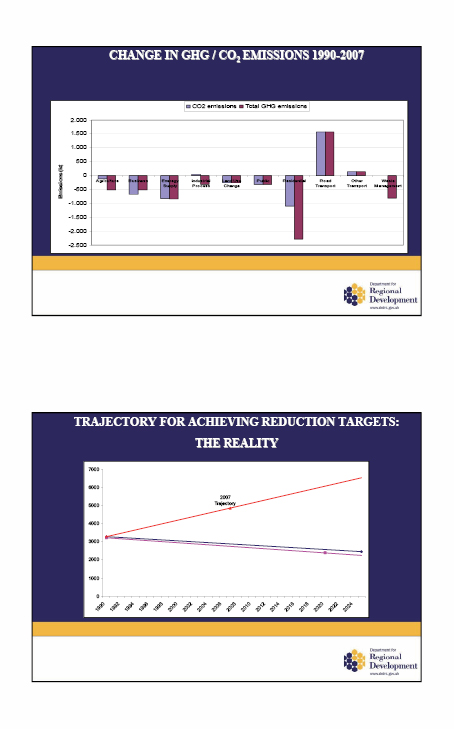
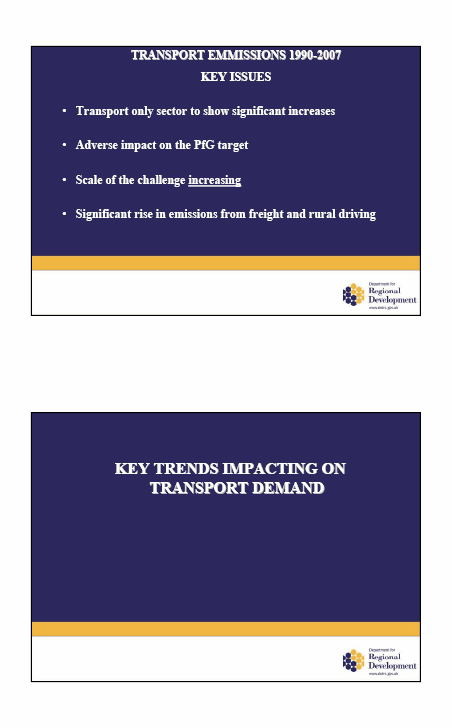


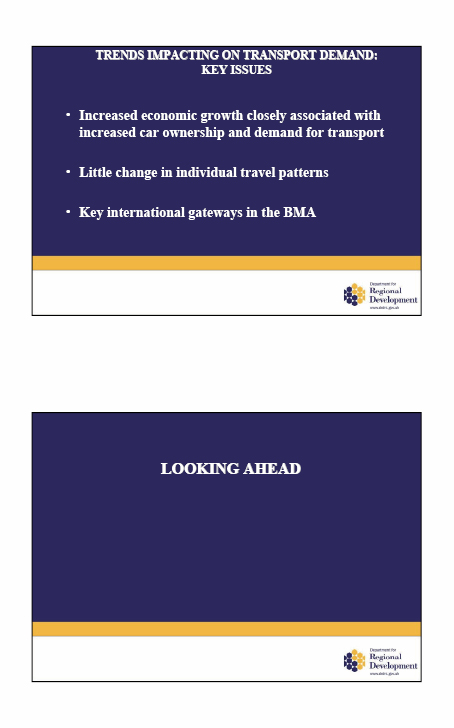

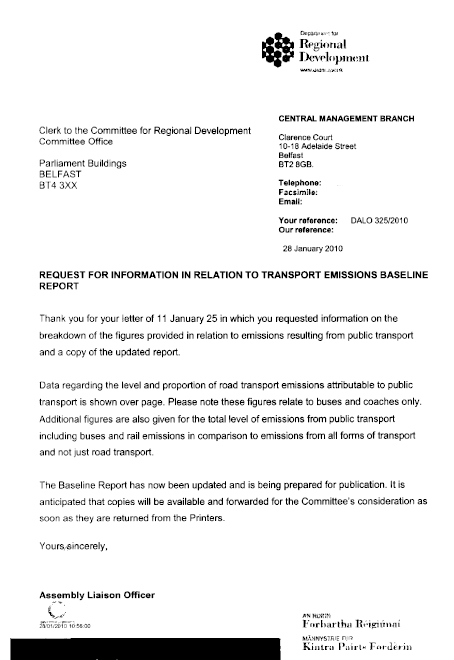

1. Thank you for coming today to the first of the TRi chairman's lectures. This fits into a series of invited lectures and seminars which TRi have been running for a year or so now in Edinburgh, and – although labelling this as the TRi chairman's lecture was not my idea! – I am pleased and delighted to be leading the debate today on a topic of great current interest for transport people, and of great relevance for the climate change agenda in the UK and specifically in Scotland.
2. The UK's commitment to drastic reduction in greenhouse gas emissions by 2050 has led the UK and Scottish governments to set ambitious targets for carbon reduction in transport and other sectors; current policy envisages that at least half of the transport carbon reduction over the next 10-15 years will come from technology change in road vehicles. I want to look at this whole area – the opportunities, the challenges and the factors that are likely to affect successful development and adoption by the market. .
3. I am not an expert on climate change or on carbon emissions, nor I am an expert on vehicle technology as such. I come to this as an experienced transport professional, with a particular interest in transport and climate change – in fact I led a TRi seminar on Merchiston campus in April 2007 on the subject.
4. The RAC Foundation, of which I have been chairman since last summer, has been following developments in climate change policy as it affects road users, and supports the emphasis now being given to the role of vehicle technologies in delivering the target emissions reductions. The Foundation has recently published a report identifying a number of challenges in how these different technologies will be brought to market, what factors will affect their mass market adoption and what contribution will be made to carbon reduction as a result. I will draw to some extent on this work.
5. What I will do therefore is to
a. Set the scene by reminding us of the commitments by the UK and Scottish Governments to achieving GHG reductions in their recent respective legislation, and identify the targets for the non-traded sector and for domestic transport in particular
b. We'll then look at the approaches being taken in the transport sector, and how low carbon vehicle technologies fit into that
c. Unpacking the technology options, we will review the technological prospects for CO2 reductions by the different routes – internal combustions engines, hybrids, full electric vehicles, fuel cells – and then identify the challenges each faces
d. Look at what part the levers available to government play in this, as they affect both demand and supply
e. Then I will seek to draw some conclusions.
6. In the three years since my TRi seminar, the climate change landscape in the UK has been completely transformed by the commitments undertaken in the Climate Change Act 2008 (and the Climate Change (Scotland) Act 2009), by the setting up of the Committee on Climate Change and the reports and advice it has produced, especially the comprehensive first report to Parliament of October 2009, and of interest to us in particular, a range of initiatives and reports by the DfT and other bodies on low carbon transport and technology developments in particular. In Scotland, the Scottish Government initiated a public consultation last summer on Low Carbon Vehicles, and the analysis of that consultation was published just a few weeks ago. And last March the Committee on Climate Change published an advisory report to the Scottish Government on their Climate Change Plans.
7. To remind you, the UK government has committed to a reduction of GHG emissions of 80% by 2050, and an intermediate target of 34% by 2020, both relevant to 1990 levels. Scotland has committed itself to the same long term target, but a more ambitious intermediate target of 42% reduction by 2020.
8. Let me remind you where transport fits into the total emissions picture in the UK. By end user, domestic transport accounted for 25% of CO2 emissions by end user in 2008 (that is, all power station emissions have been allocated to the end user) at 148 MtCO2e. By source, it was 130 MtCO2e – although I prefer to go by end user because that will capture the effect of growing dependence on electricity, the DfT statistics are based generally on source.
9. I am now going to focus on the 2020 target date, as that is the target and the timescale which is driving current plans and policies. The CCC's analysis of what is necessary to achieve the targets divides into the traded and non-traded sectors. The traded sector refers to those industries which are part of the EU Emissions Trading Scheme – such as power stations, major energy using industries, and so on, with aviation to be included in the near future. The non-traded sector includes waste, agriculture, buildings of all kinds and domestic transport – and this is what we are interested in.
10. For planning purposes the UK target for emissions reductions from domestic transport up to 2020 is taken as 32 mtCO2e, on a base of some 145mtCO2e (source measure of business as usual projection).
11. The general conclusion from all the analysis done by the CCC and DfT is that this could be achieved about 50-50 between demand-side measures affecting travel and transport behaviour, and supply-side measures resulting from reducing the carbon-intensity of vehicles. Demand side measures include 'smarter choices' based on the experience in the sustainable travel towns; eco-driving, speed limits enforcements, integrating transport and land use planning, and – at some point if there was the political will to do so – road user charging. I am not going to deal with those in this presentation – although there are questions about their deliverability.
12. Coming to reducing the carbon intensity of vehicles, I am going to concentrate on passenger cars. Light vans are acknowledged to be a forgotten category, yet their proportion of vehicle mileage, their growth and their carbon intensity make them important; It is likely that solutions for the car-derived vans will ride on the back of passenger car developments. Heavier vans and light trucks, and HGVs are subject to an EU regime which in recent years has concentrated on air quality improvements through the EURO III, IV and V specifications, and not really on carbon reductions. The whole question of GHG reductions for freight vehicles needs addressing in the context of their specification and utilisation, and it is clear from DfT report that the subject is only at the foothills. They must not be forgotten – vans and HGVs account for 33% of all road transport emissions (cars 62%).
13. Buses at 4% account for virtually all the balance, and here the strategy is to combine improved operational efficiency (through better driving, better maintenance of vehicles, and more fuel efficient powertrains and engine control systems), for which the new BSOG system provides 3% increase for a measured 6% improvement over a base year per kilometre; and a 6p per km extra BSOG for all eligible low carbon emission buses – those which demonstrate a 30% fuel efficiency improvement over a standard EURO III diesel bus of the same passenger capacity. This is focussed on hybrid vehicles, which are however up to 50% more expensive in initial purchase cost.
14. So let's now focus on passenger cars. The record of passenger car emissions in the UK shows that carbon intensity for new cars has already fallen from just over 200 g/km in 1990 to just under 150 g/km in 2009 – ie 25%. The effect of this on the average emissions of the total UK car fleet (less than 180g/km by 2009) has been offset by the growth in car travel over this period; as a result, total emissions from cars in 2008 were about the same as in 1990.
15. The reduction in carbon intensity of new cars results from a combination of factors – the effect of fuel price increases causing car purchasers to move to more fuel efficient cars and from petrol to diesel, the effect of the company car tax regime since early in the decade with its steeply graded incentive to choose lower carbon cars, and more recently the general VED gradation which is now getting steeper; together with the adoption of the EU target driving manufacturers to achieve ever lower new car emissions, and the response by manufacturer to improve the fuel efficiencies of like for like models, introducing hybrids and continuing to push down the carbon emissions of smaller vehicles. The scrappage scheme has also helped, although not emissions targeted.
16. The reduction in carbon intensity has acquired a momentum - the two years 2007-2009 have seen a 9% reduction in the overall average new car emissions
17. Looking forward, so far as Europe is concerned and the UK within it, the EU target scheme for new car emissions is a powerful driver, even though car manufacturers are constantly trying to push back on the targets – 130g/km in 2015 and 95g/km in 2020. If this is achieved in the UK, it would achieve in 2020 an average for the UK car fleet as a whole of just over 140g/km, and would deliver 11 MtCO2 reduction towards the 2020 target reduction of 32MtCO2 envisaged for domestic transport.
18. Let's look now at the technical opportunities and challenges for bringing about these further substantial reductions in carbon emissions. I am going to look at three parallel paths
a. Optimising the conventional vehicle – ie the internal combustion engine
b. Electrification, including hybrids
c. Alternative fuels – biofuels and hydrogen
19. The internal combustion engine (ICE) has been the dominant and largely unrivalled form of automotive propulsions for a century; the only significant change has been the shift for passenger cars from petrol – spark ignition – to diesel – compression ignition.
20. Despite its maturity and the continuous advancements being made, there are still several areas of improvement for the ICE's energy efficiency that have not yet been fully explored. Of the full energy potential of the fuel entering a petrol engine, typically only some 18% enters the drivetrain and 13% reaches the wheels – of which 6% accounts for aerodynamic drag and rolling resistance and 6% goes into moving the mass of the vehicle which then gets converted into braking. 82% getting lost in the engine seems horrific – some of that loss is intrinsic to the thermodynamic cycle (do you remember the 2nd law of thermodynamics?) and cannot be recaptured; there are also significant losses arise from friction, engine idling, accessories and so on.
21. The main areas of conventional vehicle performance improvement involve the engine and transmission, as well as reducing weight and downsizing, and still there are opportunities to reduce drag and rolling resistance. This table shows several options to reduce energy. They include changes to the configuration and management of the engine itself, improved transmission, and changes to steering and tyres. The biggest single contribution comes from regenerative braking – here illustrated with a flywheel – but this eventually leads us to the electric hybrid. Not all these improvements are entirely additive, but taken together – and depending on your starting point in terms of the vehicle itself – could deliver reductions of up to 30% at a cost of some £1,500 per vehicle.
22. Manufacturers will focus on those measures which will deliver reductions in g/km in the most cost effective way while sustaining the attractiveness of the vehicle in a fiercely competitive market. But on this basis alone, the average performance of new cars with conventional internal combustion engines could reach 100-110 g/km by 2020.
23. There is the often stated finding that exchanging all conventional vehicles in the UK with equivalent but best-in-class vehicles available today in showrooms could reduce car emissions by 25% - a figure which can mislead; it represents both the difference between new vehicles and the average of the existing 'park' and the difference between the best-in-class new and the average new in a particular vehicle category.
24. Driving these changes on the demand side are the fiscal incentives of the company car tax regime, and the steepening of the VED regime for all cars, such that cars in the 101-110 range pay £20 per annum and over 255 a VED of £435 is paid. From April this year the showroom tax is paid, which kicks in at 131 g/km at £110 and reaches £950 above 255.
25. Optimising ICE vehicles is taking place at a rate and has a clear momentum, sustained by the EU target regime, the UK car tax regimes and by the considerable efforts now being made by manufacturers to develop and offer lower emission cars.
26. It is only one part of the strategy and has cons as well as pros.
27. Electrically powered vehicles have been around as long as the ICE but have never mainstreamed – mostly because of poor battery capacity/weight ratios and the consequent low performance, high cost and unwieldy vehicles. The emergence of a practical and fit-for-purpose hybrid powertrain, combining the ICE with electrically based energy capture and release, has been made possible by sophisticated electronic control systems together with the adoption of lithium-based batteries, mostly lithium-ion. But the progressive potential for CO2 reduction is more multi-layered than we might initially have expected, and is illustrated by this ladder of electrification.
28. The micro-hybrid includes stop and start and stop & go systems; the former shuts down the engine when the vehicle stops and uses energy in the battery to start it again. In stop-go systems braking energy can be recovered and stored to start the engine again. Both help reduce energy lost through idling. Citroen introduced this concept on the C2 and C3 four years ago, and are about to introduce a second generation version to include their diesel cars, and offering 110g/km. It is becoming a mainstream variant; it is relatively inexpensive and therefore good value for money if much of the driving is in congested urban conditions – where fuel efficiency savings of up to 25% are claimed. Even more dramatic is the VW Polo Bluemotion, now claiming 89 gCO2/km.
29. Mild hybrids – are the first step to include regenerative braking and acceleration assistance for a slightly downsized ICE; they do not operate on their own but only alongside the ICE when accelerating, and need a slightly larger battery at some 10kWh. They are beginning to emerge among the hybrid options – BMW have recently announced one for their 2011 Series 7 model range – attached to a 4.4 litre V8 engine...!
30. Full Hybrid electric vehicles (HEV) are the most well known, of which the most prominent is the Toyota Prius, the latest third generation of which can achieve emissions as low as 89 gCO2/km depending on model. Three main configurations are the Parallel, Series and mixed – the former is where the ICE normally drives the car directly when in action, and it can supplement the electric drive and/or charge the battery, or the electric drive alone moves the car or is charged by the vehicle's motion. Personally, for a full hybrid, I find the parallel drive more elegant than the series drive, in which the ICE only ever charges the battery or generates power directly to the electric motor, and the vehicle is only ever driven by the electric motor or recharges the battery on braking. The mixed hybrid combines the two.
31. The plug-in electric hybrid places is really an assisted electric vehicle, where a battery and motor drive the car, with regenerative braking, and the charging is either from the grid or from the ICE. Given the defined range of a battery, the PHEV can deal with the phenomenon for users of full battery electric vehicles known as 'range anxiety'! Typically with a battery up to 40kWh capacity, the first one to market will be the Chevrolet Volt, which will be on sale at the end of 2010. Based on the Astra platform, it will be on sale in Europe as the Vauxhall Ampera in 2011 or 2012, but there seems no hurry to bring it to market. Clearly there is a trade-off between battery size and electric-only range. The manufacturers say that they specified the battery size on the basis of a 40 mile range, based on a US DOT survey indicating that 75% of the population did less than 40 miles per day.
32. The DfT in their latest strategy on ultra low carbon vehicles say that 40% of people drive less than 50 miles per week, and believe a range of 70 miles is a good figure to set as a standard for the new electric vehicle support scheme. In the end, the market will guide the optimum trade-off between battery weight and performance on the one hand and electric-only range on the other.
33. Finally there is the full battery electric vehicle (BEV), where the deployment of powerful lithium-ion batteries delivers a greater power/weight ratio than hitherto, but at considerable cost and significant implications for charging logistics on a large scale.
34. This chart summarises the efficiency gains and likely costs per vehicle. At the current state of development the standard HEV seems to offer the best trade off between cost and energy efficiency. It is likely nevertheless that the PHEV will see considerable further development. However, both the PHEV and BEV raise important issues about carbon intensity of grid electricity – both at the margin and on average – and about infrastructure for charging.
35. Let's look at four main challenges for vehicle electrification.
36. Battery technology, costs and capacity.
a. Currently Lithium-ion works out at about £650 per kWh. This gives a cost of some £10,000 for a small PHEV/BEV with a 16kWh capacity, and a range of 90 miles. These costs could come down with large scale production, but it is estimated they would have to fall by a factor of four to start to be competitive with an ICE counterpart; it is likely that some technology breakthrough will be needed as well – either in the materials used or in the manufacturing process.
b. Ownership costs are high given the relatively short lifespan of batteries: in optimal conditions a lifespan of six to eight years can be assumed but in practice may be much less. I have heard from a Norwegian colleague about electric vehicles four years old or less abandoned at the back of garages because the owner could not afford to replace the battery.
c. Range anxiety is an issue for fully electric vehicles and it seems from research that people will typically not plan journeys much more than half the full range – a much reduced 'effective' range.
37. Infrastructure.
a. Although grid connected EVs can be charged from ordinary household sockets, widespread uptake of these vehicles will require public charging infrastructure to reflect not only actual but effective range given range anxiety. While full recharging from household circuits is slow and can take two hours for 80% charge or much longer for a full charge, it is OK for overnight charging. Dont forget that 40% of homes in urban areas have no off street parking, so it would have to be delivered at the kerbside. But daytime charging points in public places and car parks require reaching 80% charge in 30 minutes or less. Charging infrastructure can cost up to £40,000 per fast charging point, and another £50,000 if modifications to the local grid are required due to a high cumulative load. The CCC estimates that for the UK the necessary infrastructure could cost up to £1.5bn; and that will only deliver some 40,000 charging points.
b. An alternative is to put the emphasis on swapping stations for batteries – this is the better place project being rolled out in Israel and japan.
c. The DfT is certainly driving forward developments in this area with the £250m package announced last July to support an early consumer market for EVs and PHEVs, with most of this going on purchase subsidies of £2,000 to £5,000 per vehicle, and the balance of £20m available to support the installation of charging infrastructure in specific areas – the Plugged in Places programme, with £10m from another fund. I have to say I wonder whether the shape of EVs and PHEVs likely route to market and their specification is sufficiently evident yet to know what is the best disposition and specification for charging infrastructure, or even whether the market will look to battery swapping as well?
d. CCC has suggested that even stronger incentives may be needed, costing £800m– and have scoped a target of 1/4m vehicles in the UK car fleet by 2015 and 1.7m in 2020. Total price support – if maintained – could be up to £9bn. I haven't done the sums to see how that works out in marginal abatement costs – that is, how much cost for how much CO2 reduction. They also suggest that there will be limited impacts on power networks up to 2020.
e. The London Mayor has set out his vision to London the electric vehicle capital of Europe, with a £60m plan to put 25,000 charging points in by 2015, and 100,000 EVs on the streets of London as soon as possible. I wonder how much of all this will survive the current cull on public expenditure.
38. The third challenge for grid-connected EVS is the environmental dimension.
a. First, the carbon intensity of electricity generation. In 2008 the share of carbon-free sources for UK electricity generation was only 19% (13% nuclear and 6% renewable). Today the average grid carbon intensity manifested at the socket is about 550g/kWh. If BEVs use about 15 kWh/100km they will achieve even on the current electricity generation mix about 82gCO2/km. This is significantly better than any currently available ICE vehicle, although hybrids will be reaching close to that within a few years. You might have expected it to look better – I did – and of course it assumes electricity availability within the current total capacity and without the full use of marginal capacity and fuels – which would increase the carbon content. The scenario for decarbonising electricity generation is central to this, as to many other sectors of the economy. The CCC is targeting a dramatic 80% reduction in intensity by 2030 (from 550g/kWh to about 100), although only 18% reduction by 2020. The ability of the market to deliver this is questioned by the CCC, but it remains on the table. I do not know what the current government plans are.
b. The other environmental problem relates to battery waste and indeed the dependency on and material depletion of what are called 'rare earths'. Most of the extractable lithium is in China and recent announcements indicate a conservation strategy by them which is likely to create a supply crisis if the world moves towards EVs or PHEVs – replacing one geo-political supply problem with another.
39. None of this suggests that EVs and PHEVs are not the appropriate long term way forward, but there are some significant technical, institutional and environmental challenges to address.
40. Let me finally review alternative fuels and their application. First, bio fuels.
a. The carbon friendliness of biofuels relates to the recent absorption of CO2 (unlike fossil fuels) which on burning is simply returned to the atmosphere. Biofuels can be conventionally produced from food crops (corn, sugar); advanced fuels are produced from agricultural waste and residues, or from farmed algae. Blends with fossil fuels up to 5% require no engine modification, possibly up to 10%. Very high blends such as E85 (85% ethanol) require major modifications to engines. Conventional biofuels can achieve substantial reductions in GHGs – up to 80% or more – with 'well to tank' emissions as low as 20gCO2/km or less. The main problem is one of supply – the 'food versus fuel' conflict. You have to set this in the context of availability of marginal land, the rising world population, increasing productivity of land (and the requirement for water and fertilisers to support it) and there isn't time for me to develop the complexities of this here. And if you fully account for the carbon emitted in harvesting, production
b. The Renewable Transport Fuel Obligation (RTFO) which is an EU scheme sets 5.75% of fuels to be sourced from renewable in n2010, with a longer term target of 20% in 2020 – the UK's target being 15%. As a result of the Gallagher review in 2008, recommending a slowdown in the growth of biofuels, the UK government lowered the target set by the EU to 3.25% for 2010 and 10% for 2020. The tax incentive of 20p per litre for biofuels has now been removed), although the graduated excise duty will remain for alternative fuels. I think it will continue to be a useful though modest element in the carbon emissions reduction landscape.
41. Hydrogen has often been mentioned as an alternative fuel – either in modified ICEs or in combination with a fuel cell. As it does not occur freely, hydrogen has to be produced and there are various different production paths. Hydrogen fuel cell vehicles outperform conventional vehicles achieving efficiencies of up to 60%, two or three times as much – eg the Honda FCX Clarity. With either fuel cells or modified ICEs there are zero tailpipe emissions, and the challenge is to obtain carbon efficiencies in the production and distribution processes. Specific advantages over full electric vehicles can be achieved, including quick refuelling. There are three main challenges, with costs a major issue for each: vehicle technology, infrastructure and hydrogen production, and the latter has CO2 emissions associated with it depending on the production process and the use of CCS technology.
42. Overall there are many uncertainties, and the possibilities of hydrogen – while promising in prospect – require a good deal more R&D before a clear path or a clear case can be made for it place in a decarbonising strategy. Testing continues with a number of fuel cell buses under evaluation by TfL, and the London Olympics will be used as an opportunity to demonstrate hydrogen vehicles.
43. Bringing all these together suggests a possible path of development and migration which looks like this over the longer term to 2050, including fuel cells and a hydrogen breakthrough. The further out the more uncertain – which is why I have in this presentation concentrated on the next ten years to 2020.
44. Before moving to the conclusions I would just like to have a look at the recent Scottish government consultation on low carbon vehicles. This was an interesting exercise initiated in 2009 to elicit the views and responses of stakeholder organisations to the prospects for and factors affecting the decarbonising of road vehicles, as part of the strategy to achieve the very ambitious 2020 target for GHG reductions in Scotland. There was a strong emphasis on the public sector role in leading this, both through vehicles procurement and the support of appropriate industries.
45. There was a recognition that there is no overall 'winner' and no silver bullet. Views on the most influential technologies focussed on hybrid vehicles, followed by electric vehicles and alternative fuels, with efficiency improvements to existing ICE vehicles behind that. This is perhaps a surprising result, given the remaining capability ICE improvement; it may be a result of just not knowing the improvement potential – significant in itself.
46. The opportunity for public sector organisations to lead with their own fleets and procurement was well recognised. But I was surprised to see no exploration of the role of local authorities through their planning, traffic management and transport planning powers to influence the take up of low carbon vehicles by their communities – for example, through favouring LCVs in off street and onstreet parking charges and residents parking schemes, access restrictions, development control decisions, and so on. There are some dramatic examples from Germany about the implementation of low emission zones in towns and cities which discriminate either in pricing or in access to town centres.
47. Apart from these initiatives open to public sector bodies and local authorities, the primary policy levers to bring about technology based changes in CO2 emissions are about financial, regulatory and grant incentives to the supply side – the automotive industry – and fiscal and regulatory incentives to the demand side - influencing the behaviour of individuals and organisations in their car purchasing and use decisions. These policy levers are in the hands of the EU and the UK government. There are opportunities for devolved government and local authorities to influence supply and demand as well, as the consultation recognises, but by the other measures whose impacts may be relatively limited.
48. I think there is a need to understand more about the factors that will drive the market and promote mass market adoption of different technologies, and the relative impact of the different levers open to central, devolved and local government.
49. In conclusion, then I would suggest the following
50. There is no silver bullet – all the technology options offer opportunities but all face certain challenges, and in some cases, significant barriers.
51. For conventional cars and powertrains: It is clear there remains significant scope for reducing the carbon emissions of vehicles with conventional powertrains. Improvements can be made costing about £1,500 per vehicle which could pay for themselves through fuel cost reductions over three to five years. Moreover, all the necessary complementary technologies such as infrastructure and skills are already in place. There are, however, limits to how much can be achieved in terms of carbon dioxide (CO2) savings.
52. Hybrids present a good mix between conventional propulsion and battery technology. Carbon savings of up to 30-50% are achievable for approximately £2,000-4,000 per vehicle, and vehicles are very similar to conventional cars not restricted by range. Grid-connected electric vehicles (plug-in hybrid vehicles on electric drive and battery electric vehicles) can potentially offer substantial emissions reductions, but depend on the carbon intensity of electricity generation; currently a BEV would deliver about 80 gCO2/km. They still face substantial challenges relating to battery cost, and as yet unknown infrastructure requirements.
53. Alternative fuels: Biofuels, especially advanced ones which are produced from wastes and residues rather than food crops, potentially offer significant GHG savings when based on a complete life cycle, but only if they do not result in direct or indirect land use change or significant GHG emissions from cultivation and transport. Furthermore, major questions remain about the opportunity cost of biofuels, and implications for food production in an increasingly overpopulated world.
54. Hydrogen vehicles offer zero tailpipe emissions and increased range, but are still at a relatively early stage of development. They have a number of technology and cost barriers to overcome, for vehicles, infrastructure and the actual carbon content of hydrogen.
55. From a policy standpoint, I believe government should not be trying to back winners in terms of particular technologies, which would point to general outcome-related incentives such as tax and fiscal measures, scrappage scheme and so on, rather than targeted measures. I welcome the commitment reflected in the £250m support for electric vehicles, but I wonder if the charging infrastructure plans are not premature and presume too much about the direction of development and market take up.
56. Meanwhile, it is important policies are developed and strategies evaluated on well-to-wheel analyses, and preferably cradle to grave assessments that also take into account the energy required and CO2 emissions created by manufacturing, distribution and eventual disposal or scrappage of vehicles. Until now, however, policies such as the EU Directive and UK tax incentives are based on tank-to-wheel/tailpipe emissions. This can distort decisions intended to reduce emissions over the long term.
57. More needs to be understood about the impact and effectiveness of the different policy levers open to central, devolved and local government to bring about the changes – whether financial and fiscal incentives to the supply and demand sides, scrappage schemes, or more micro measures at the local level which clearly signal the benefits of LCVs and influence the take up of LCVs

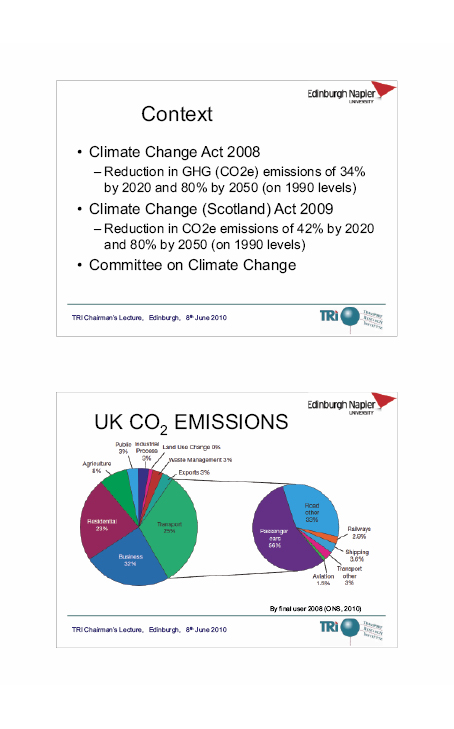
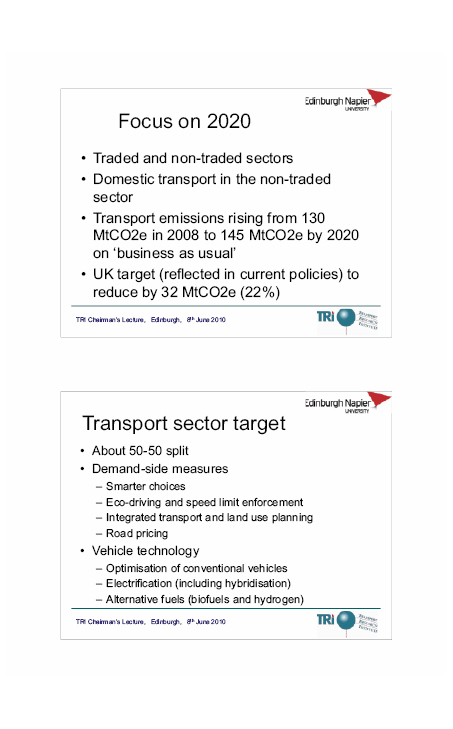
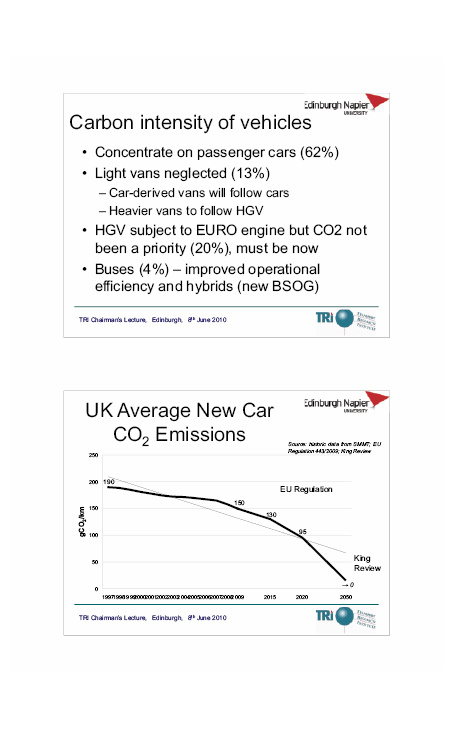
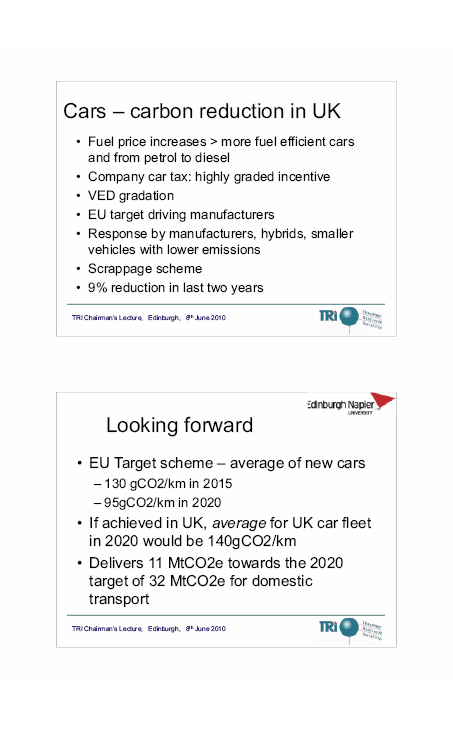

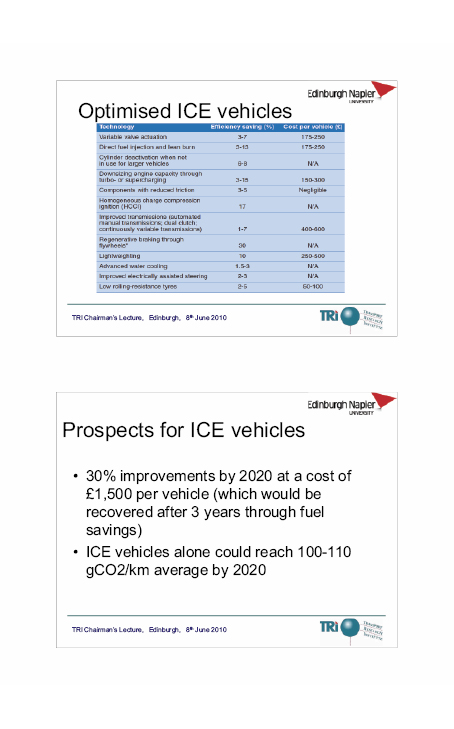
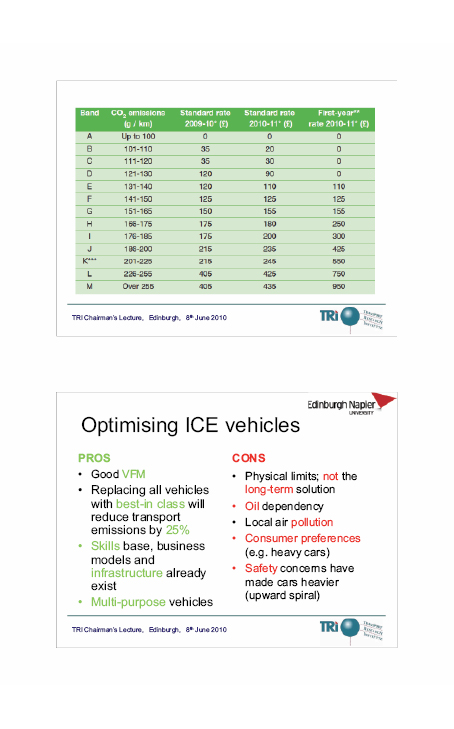
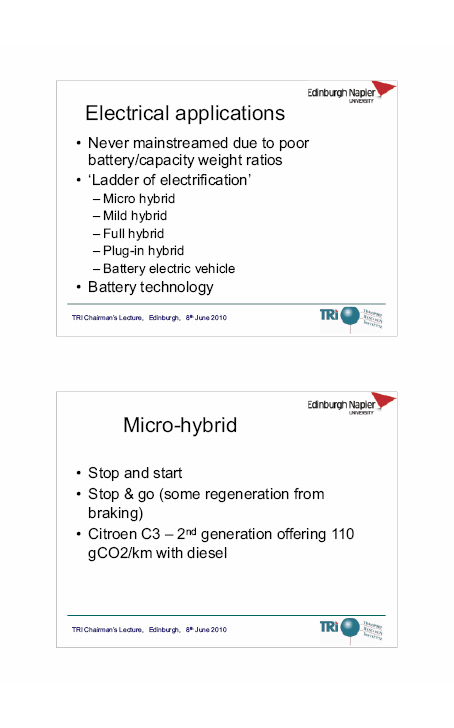
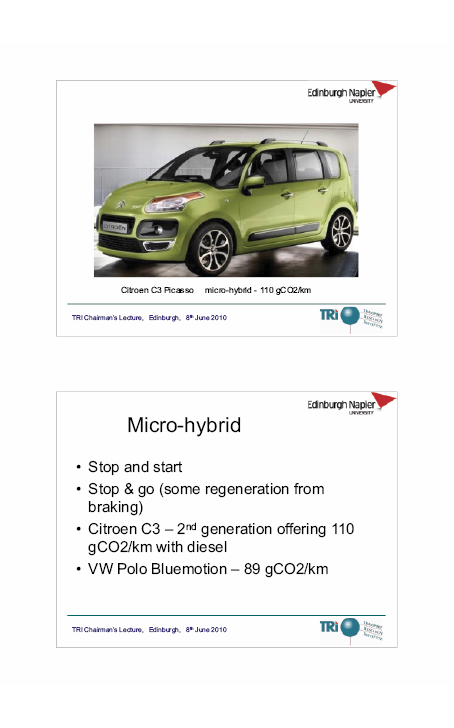

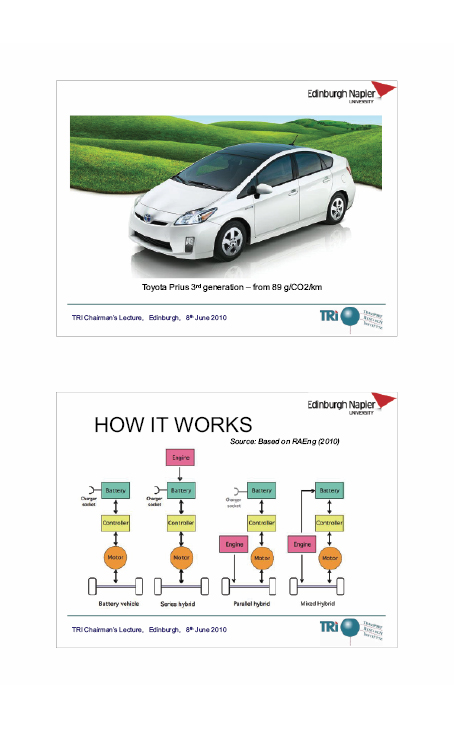
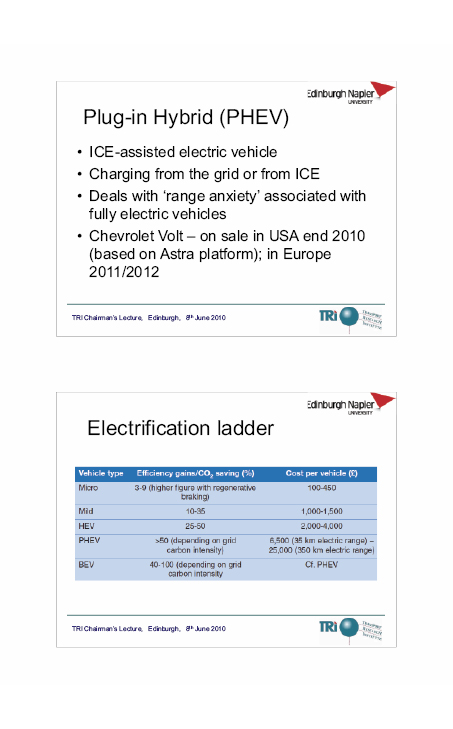
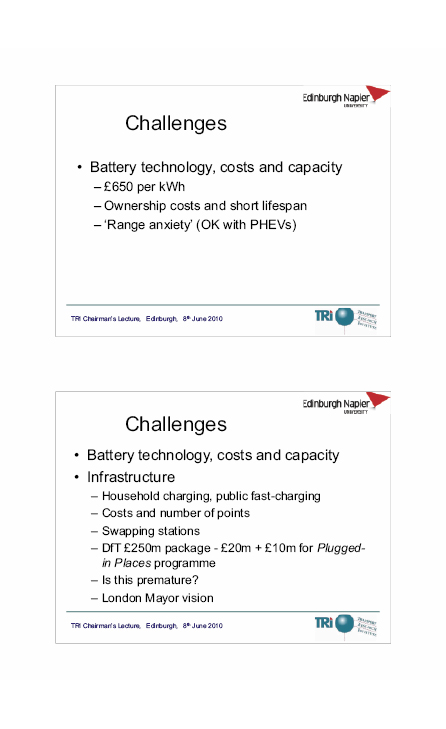
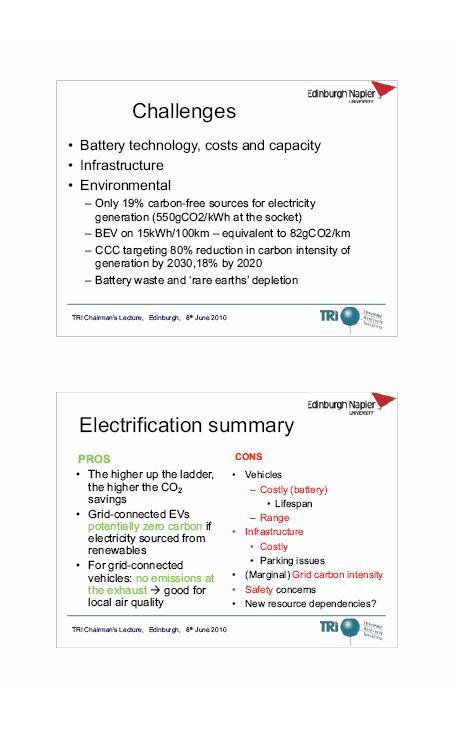

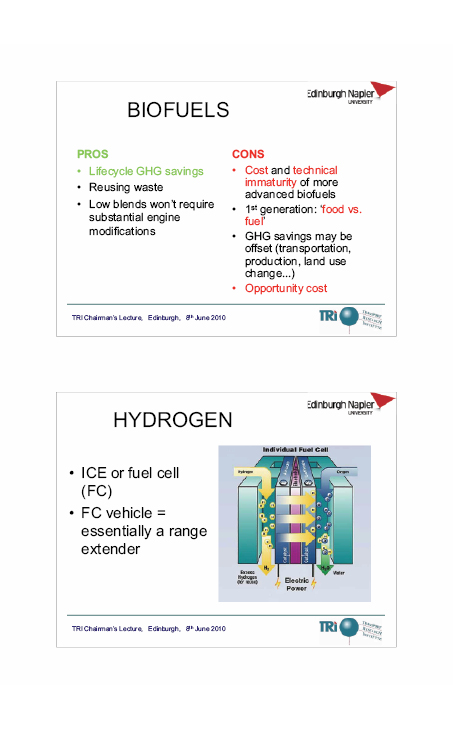
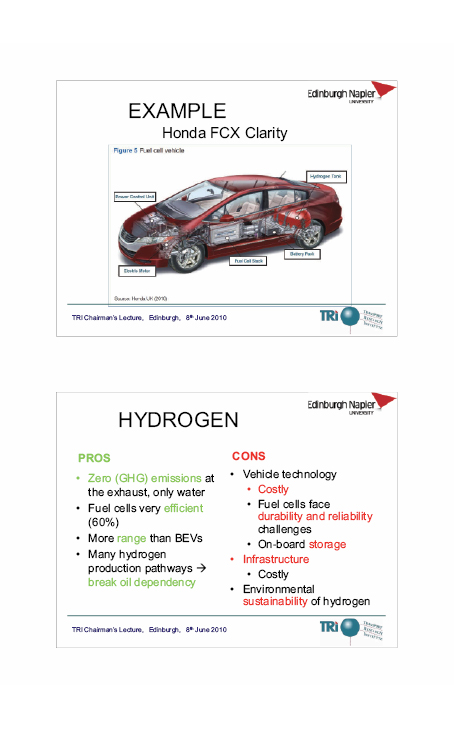

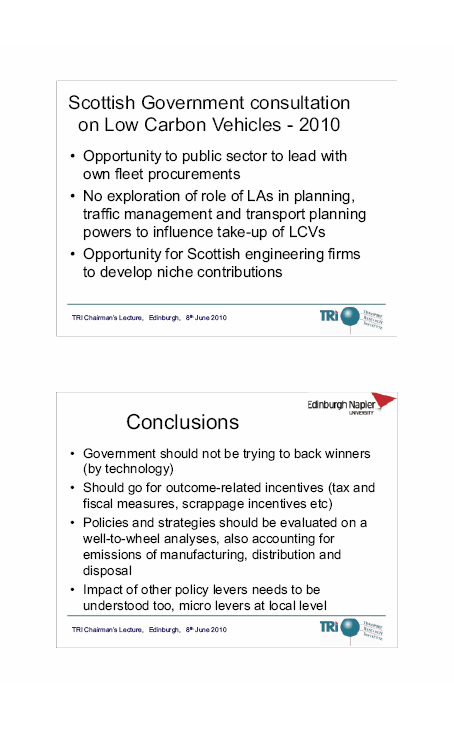
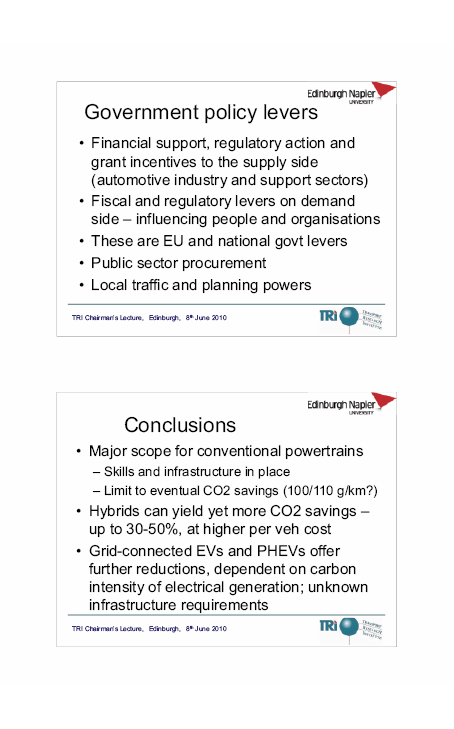

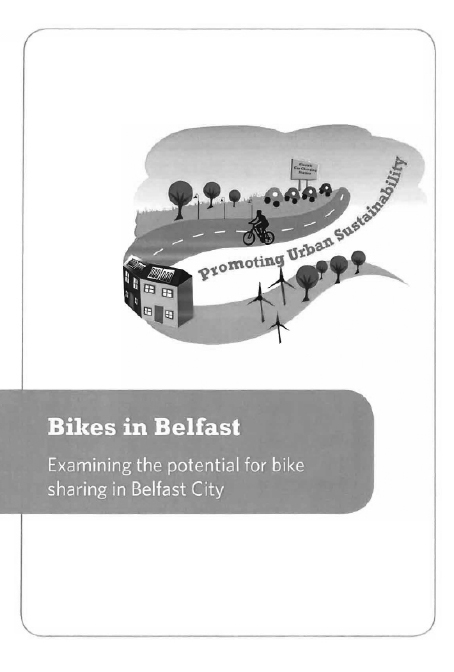



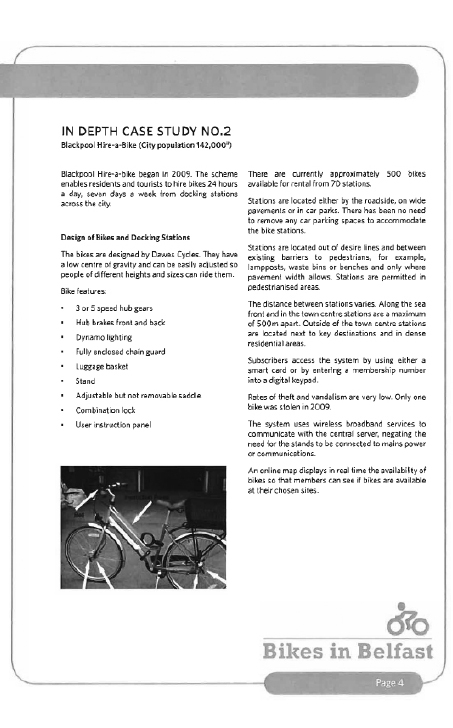
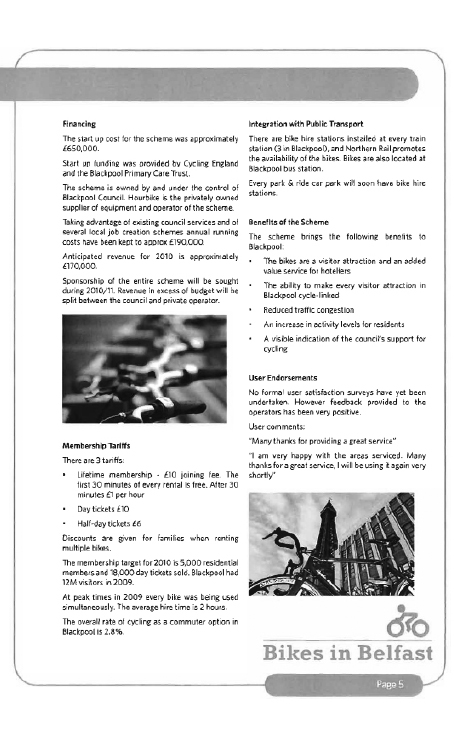
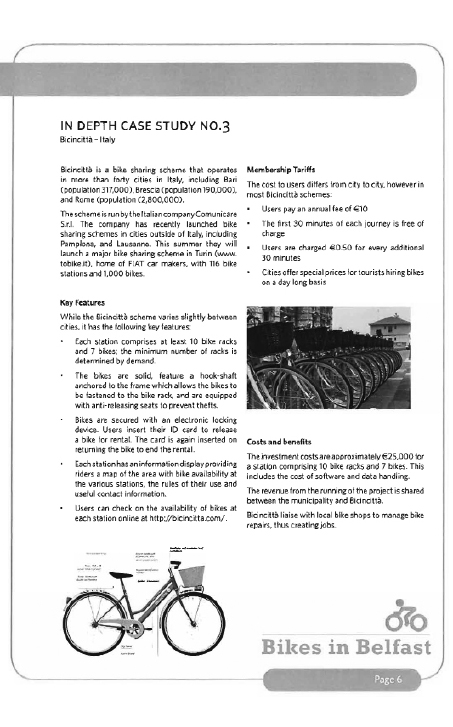
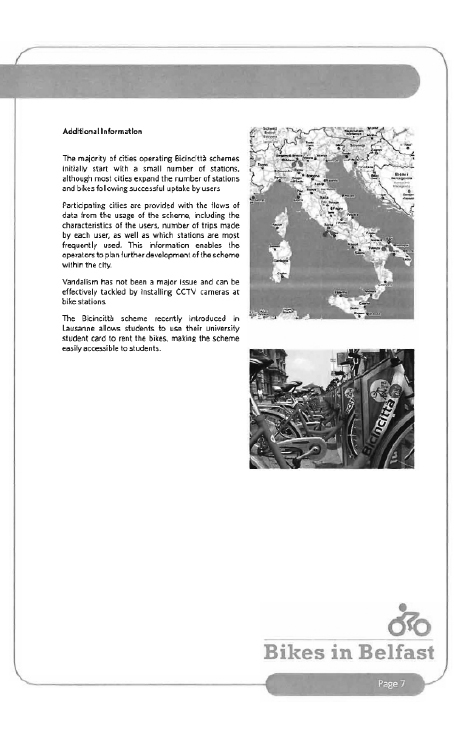


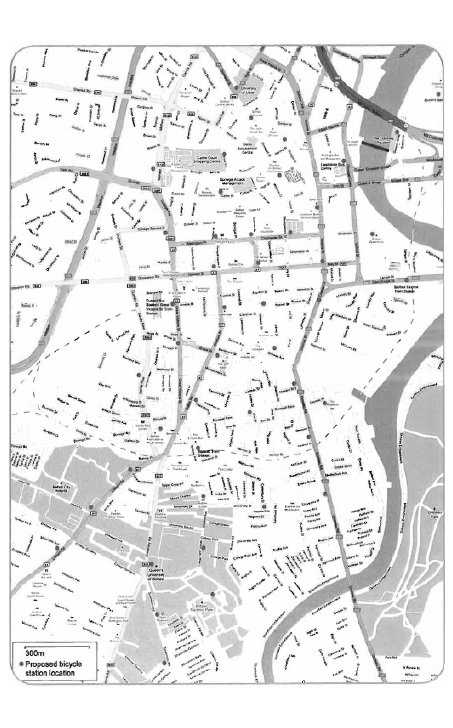
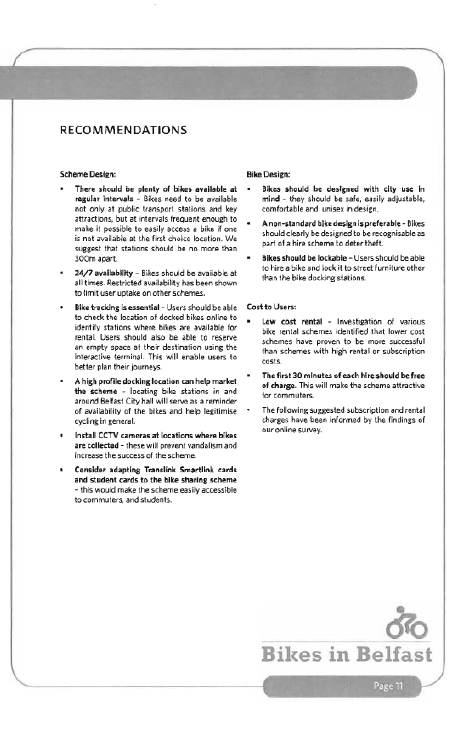
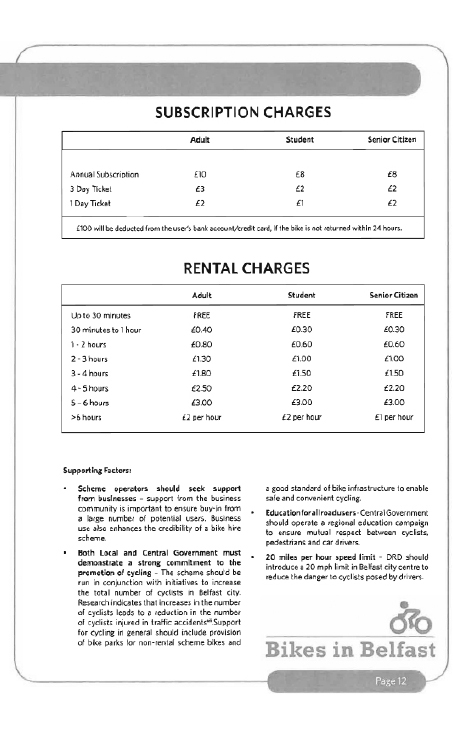
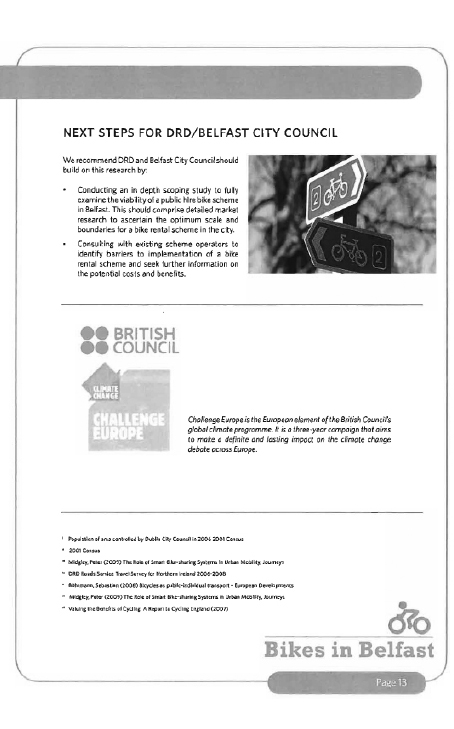
Research Officer 1 October 2008
The purpose of this note is to highlight:
Transport plays a part in 3 of the 5 principles for sustainable development, as agreed by the UK Government and the Devolved Administrations, and shown below: Living Within Environmental Limits; Ensuring a Strong, Healthy and Just Society; and Achieving a Sustainable Economy.[1]
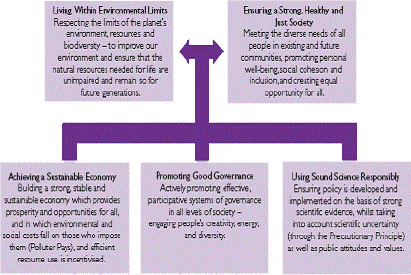
This Bill[2] puts into statute the UK's targets to reduce carbon dioxide emissions through domestic and international action by at least 60% by 2050 and at least 26% by 2020, against a 1990 baseline. This target will extend to the whole of the UK.
The Bill was passed by the House of Lords on 31 March 2008, and is now at the Committee Stage in the House of Commons.
By convention, Westminster will not normally legislate with regard to devolved matters without the consent of the NI Assembly. The consent of the NI Assembly was sought in relation to the Bill and the duty on the relevant NI department to prepare a programme on adaptation to climate change; the NI Assembly granted its approval on 10 December 2007.
The Programme for Government Public Service Agreements[3] assigning responsibility to DRD for transport-related issues are:
Improve NI's manufacturing and private services productivity.
Objective 7: Improve the Strategic Road Network by the advancement/completion of a range of major works schemes.
Actions: In line with PSA 13, progress schemes against major work milestones.
Target: In line with PSA 13, by 2015 reduce journey times on Key Transport Corridors by 2.5% compared to 2003.
Maintain and develop the public road and rail network and improve public transport provision to deliver a modern, efficient and sustainable transportation system that facilitates economic growth and social inclusion across the region.
Actions:
Target: By 2015 reduce journey times on Key Transport Corridors by 2.5% compared to 2003.
Actions: Key work areas are resurfacing, surface dressing and defect repair.
Target:
Actions:
Target:
Deliver a safer roads network and achieve measurable reductions in road deaths and serious injury.
Actions:
Key work areas are:
Target: 50% reduction in total number of target collisions at treated sites over the 3 years following completion of collision remedial works.
Extracts from the 2008 DoE State of the Environment Report for NI show:
Sectoral split (%) of total greenhouse gas emissions in NI in 2005:
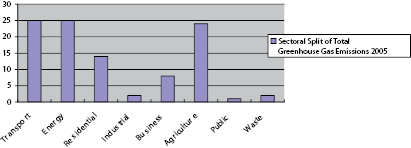
Sectoral split (%) of carbon dioxide emissions in NI in 2005:
Carbon dioxide emissions from transport (% by mode) in NI in 2004:
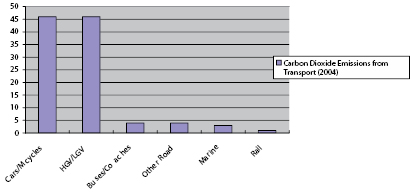
Source: DOE at http://www.ni-environment.gov.uk/stateoftheenvironmentreportfornorthernirelandairandclimate.pdf
[1] http://www.sustainable-development.gov.uk/publications/pdf/SD_Framework.pdf
[2] http://services.parliament.uk/bills/2007-08/climatechangehl.html
[3] http://www.pfgbudgetni.gov.uk/finalpfg.pdf
This note considers transport in terms of the third of 5 shared UK principles for Sustainable Development: Achieving a Sustainable Economy. This means building a strong, stable and sustainable economy, which provides prosperity and opportunities for all, in which environmental and social costs fall on those who impose them (polluter pays), and efficient resource use is incentivised.
The 2006 Eddington Transport Study[1] was commissioned by the UK Government (the Treasury and DfT) to advise the UK Government on long-term links between transport and the productivity, growth and stability of the UK economy, in the context of UK Government commitment to Sustainable Development.
The UK Government agreed with Eddington's analysis, and committed to review its transport strategy, policy and delivery as a result of the advice given by Eddington and by Stern (on the Economics of Climate Change). Eddington's conclusions also appeared to chime with the submissions of key business stakeholders, such as the Confederation of British Industry and the Institute of Directors.
Eddington advised that:
Eddington suggested that inward investors in London, for example, view the quality of its international connections and domestic networks as a key element of its locational advantage. This is threatened, however, by rapidly rising demand on travel systems, densely concentrated on certain parts of the networks at certain times of day, and putting parts of the system under serious strain.
Eddington suggested that:
Eddington calculated that:
Eddington suggested that the strategic economic priorities for long-term transport policy should lie where transport constraints have significant potential to hold back economic growth:
Eddington suggested a sophisticated policy mix to respond to these challenges:
Eddington suggeted that, if the Government shows considerable foresight and ambition, and implements its recommendations, it can:
IPPR[2], an independent think-tank which is influential in Government, agreed with Eddington on the links between transport and national productivity, and, in particular, on the inherent relationship between maximising the economic benefits of density and improving the transport system:
If UK policy, as informed by Eddington, was translated into the NI context, it might suggest concentrating transport investment in NI into the Belfast Metropolitan Area and key strategic routes, to maximise economic returns. This would need to be balanced by consideration of important environmental and social issues, including climate change and inclusion/equality of opportunity.
[1] http://www.dft.gov.uk/about/strategy/transportstrategy/eddingtonstudy/
[2] http://www.ippr.org.uk/publicationsandreports/publication.asp?id=530
Research Officer 1 October 2008
This note considers transport in terms of the first of 5 shared UK principles for Sustainable Development: Living Within Environmental Limits. This means respecting the limits of the planet's environment, resources and biodiversity, to improve our environment and ensure that the natural resources needed for life are unimpaired and remain so for future generations.
The 2006 Stern Review on the Economics of Climate Change[1] was commissioned by the UK Government (the Treasury) to deliver evidence on the economic impacts of climate change, the economics of stabilising greenhouse gas emissions, and the complex policy challenges in making the transition to a low-carbon economy and ensuring adaptation to the unavoidable consequences of climate change.
Stern concluded that:
Stern reported that:
Latest emission figures[2] for all priority air quality pollutants, from all regions of the UK, show the following trends over the period 1990-2006:
Stern reported that demand for transport is a derived demand: it is not demanded for its own sake, but rather for the things it enables people to do, such as get to work, take leisure trips, and move goods from one place to another.
Stern reported that growth in transport emissions is driven by:
Stern expects transport to be among the last sectors to bring emissions down below current levels as:
Road transport is likely to be decarbonised before aviation. Rail could be decarbonised by electrifying the service and generating the electricity in a renewable way.
The 2008 King Review of Low-Carbon Cars[3] was commissioned by the UK Government (the Treasury and DfT) to independently review and examine the vehicle and fuel technologies which, over the next 25 years, could help to de-carbonise road transport, particularly cars.
King concluded that:
King suggested that substantial progress is needed on:
King noted that:
The 2006 NI Sustainable Development Strategy[4] recognised that:
The 2002 NI Regional Transportation Strategy 2002-2012, which did not include the environment in its key drivers for change, aimed to:
However, its funding allocations do not appear to match those ideals.
The same Regional Transportation Strategy, in its 2002 figures for relative funding by mode, showed allocations of:
Its figures for costed initiatives amounted to:
Similarly, in the latest NI Budget[5], which stated that the overall aim of DRD is to improve quality of life, allocations for 2007-2011 included:
[1]http://www.hm-treasury.gov.uk/independent_reviews/stern_review_economics_climate_change/sternreview_index.cfm
[2] http://www.airquality.co.uk/archive/reports/cat07/0809291423_DA_AQ_Inventory_Report_2006_Final.pdf
[3] http://www.hm-treasury.gov.uk/independent_reviews/king_review/king_review_index.cfm
[4] http://www.ofmdfmni.gov.uk/sustain-develop.pdf
[5] http://www.pfgbudgetni.gov.uk/finalbudgetdocument.pdf
Research Officer 1 October 2008
This note considers transport in terms of the second of 5 shared UK principles for Sustainable Development: Achieving a Strong, Healthy and Just Society. This means meeting the diverse needs of all people in existing and future communities, promoting personal wellbeing, social cohesion and inclusion, and creating equal opportunity for all.
The Social Exclusion Unit of the Cabinet Office[1] describes social exclusion as a complex and multi-dimensional situation which:
Transport can be a major influence on all of these.
According to the Eddington Transport Study[2] for the Treasury and DfT, transport is one of several factors influencing the decision of many people to work or not, because:
The coordination of transport policy with housing policy can be extremely valuable, therefore, in securing GDP benefits and promoting social inclusion. Quality of life and non-work/leisure travel options are important considerations in influencing location choices in a world where labour, capital and business are all mobile, and transport provision may improve the desirability of urban areas and their catchments to potential incoming migrant workers and foreign investors.
The DfT outlines the ways in which people are excluded[3]:
The DfT, thus, agrees with Eddington that:
The DfT considers the term 'transport poverty' to be useful as a label for the conjunction of certain transport-related problems. The term is not universally agreed, but refers, in broad terms, to the cumulative effect of poor public transport services, poor provision for walking and cycling, and low levels of car ownership, particularly affecting women, the poor, the disabled, dwellers in rural areas and other classically disadvantaged groups.
Sustrans, the sustainable transport campaign and advisory organisation, believes that the millions of people in the UK who do not have a car, or struggle to afford one, in our 'must-have-car' society, suffer 'transport injustice'[4]. Examples of 'transport injustice' include: difficulties accessing work and other opportunities; enforced indebtedness; reduced opportunity to lead an active healthy life; and, ironically, proportionately greater exposure than average to pollution, road danger and noise caused by those who do have a car. It is important to note that this 'transport injustice' could spread further through society, if oil prices continue to rise and our society continues to be shaped on the assumption that we can all 'hop in the car'.
Sustrans sees the steps required to make our transport system 'socially-just' are the same steps needed to make the transport system less carbon-intensive and more robust to oil price shocks:
Sustrans considers the measures needed to tackle 'transport injustice' to be small-scale, affordable and excellent value for money. An additional annual spend of just £40 per citizen on such measures would have a major impact, be modest in comparison with current spending on roads, and achieve a socially-just transport system for less than current transport expenditure.
Sustrans noted that recent spending on roads was:
The NHS is clear that transport and health are inextricably linked, that transport has major health impacts, and that there are significant inequalities in the impact of transport on the health of individuals and communities[5].
Transport issues are integral to a range of NHS aims and health issues, including:
Such statistics, while improving, represent a substantial burden on NHS services.
The NHS Health Development Agency, in a report on improving health through transport, notes that:
IPPR[6], the independent think-tank reputed to be influential in Government, contends that the car continues to dominate because:
IPPR notes that congestion is identified by the public as one of the major transport-related problems in GB, and believes that the public appears to feel that the best way to tackle congestion is by improving public transport.
IPPR suggests that visible improvements in public transport could increase trust and help persuade people that schemes such as road pricing are not 'just another tax'. Schemes such as road pricing raise concerns about possible impacts on those with low incomes and those who live in rural areas with limited access to viable alternatives to using cars. Schemes in which revenue is returned, for example through tax cuts or investment in public transport, are found to be more acceptable. Although the idea of a revenue-neutral scheme is more popular than a revenue-raising scheme, it is not known how people reconcile the contradiction of wanting a revenue-neutral scheme at the same time as wanting to hypothecate revenue for public transport. Regardless, transparency in the use of revenue is important.
IPPR suggests that:
IPPR reports that the majority of people in the UK are not taking many actions to mitigate their emissions in a significant way:
The use of taxes and subsidies to discourage, or encourage, behaviour change has been effective; examples include the switch to unleaded petrol and the London congestion charge. But evidence suggests that price signals alone are rarely sufficient; in some cases, because other factors are more influential in determining behaviours than rational calculations about cost, price fails to stimulate behaviour change at all.
Policy to reduce car use, which takes account of the diverse and complex range of influences on behaviour, must include: providing convenience; raising understanding; improving the image of alternatives; social proofing; setting attractive rewards and repellent penalties; increasing affordability; and encouraging committing to change.
Similar policy to reduce flying must include: decreasing the affordability of flying; providing convenience; improving the image of alternatives; raising understanding; and social proofing.
[2]http://www.dft.gov.uk/about/strategy/transportstrategy/eddingtonstudy/
[3]http://www.dft.gov.uk/pgr/inclusion/sitransportaspects.pdf
[4]http://www.sustrans.org.uk/webfiles/Info_sheets/FF46_info_sheet.pdf
[5]http://www.healthandtransportgroup.co.uk/articles/makingcase_health_transport.pdf
[6]http://www.ippr.org.uk/publicationsandreports/publication.asp?id=541

Research and Library Service would like to extend a warm thank you all individuals and organisations who gave up their time to participate in this research and engagement event.
Research and Library Service where overwhelmed by the interest in this event and would like to thank those who where unable to attend for registering their interest.
1. The Role of Transport and Scope of Study
1.1 Defining Sustainable Transport
1.2 Scope of Study
1.3 Methodology
2 Group Feedback – What they told us!
2.1 Defining the Problem
2.2 Vision and Values
2.3 Reviewing work done to date
2.4 Reviewing the rationale for government intervention
2.5 Reviewing the mandate for Government Intervention – How much support is there for change in the transport system?
2.6 Moving Forward
3 Key Issues for Consideration
3.1 Defining the problem
3.2 Articulating vision and values
3.3 Reviewing the success of existing policy
3.4 Reviewing the rationale for Government Intervention
3.5 Reviewing the mandate for Government Intervention
3.6 Moving forward
The transport network impacts heavily on many aspects of life in Northern Ireland. Affecting issues of economic prosperity, environmental protection, social inclusion, justice and opportunity, the state of the Northern Ireland transport network is important for all citizens of Northern Ireland.
Much emphasis has been placed on the need to be sustainable in recent times by numerous public, private and voluntary organisations. Definitions of sustainability are numerous and in terms of transport provision can mean different things for different people and organisations.
For the purpose of this project, we adapt the widely accepted definition of sustainable development provided in the Brundland Report. That is, "development which meets the needs of the present without compromising the ability of future generations to meet their own needs".[1]
Building on the above definition, a set of five guiding principles are outlined within UK and Northern Ireland Sustainable Development Strategy[2]. Applying these principles to transport provision within Northern Ireland, a sustainable transport solution is one which respects all five principles outlined below.
Living within Environmental Limits
Respecting the limits of the planet's environment, resources and biodiversity – to improve our environment and ensure that the natural resources needed for life are unimpaired and remain so for future generations
Achieving a Sustainable Economy
Building a strong, stable and sustainable economy which provides prosperity and opportunities for all, and in which environmental and social costs fall on those who impose them (Polluter Pays) and efficient resource use is incentivised.
Using sound science responsibility
Ensuring policy is developed and implemented on the basis of strong scientific evidence, whilst taking into account scientific uncertainty (through the Precautionary Principle) as well as public attitudes and values.
Ensuring a Strong, Healthy and Just Society
Meeting the diverse needs of all people in existing and future communities, promoting personal well-being, social cohesion and inclusion, and creating equal opportunity for all.
Promoting Good Governance
Actively promoting effective, participative systems of governments in all levels of society – engaging people's creativity, energy and diversity.
Source: Securing the Future – UK Government Sustainable Development Strategy
The Committee for Regional Development intends to conduct an inquiry into issues relating to sustainable transport in Northern Ireland.
To aid and inform this, Northern Ireland Assembly Research and Library Service undertook a series of research and engagement exercises to identify the key issues and perspectives raised by selected stakeholders.
Specifically the study aimed to:
In order to achieve these aims Research and Library Service facilitated two research and engagement exercises.
On the 6th February 2009, the Sustainable Transport and Engagement Exercise was held in the Long Gallery, Parliament Buildings.
Stakeholders were allocated into interest groups comprising the business; social; environmental; and transport operation sectors and were asked to consider questions based on the study aims outlined above. See Appendix 1 for a full list of participating stakeholders.
Section 3 of this report provides a comprehensive overview of discussions held within each of these groups. Where possible, common themes have been drawn out of these discussions and areas of potential interest to the Committee have been highlighted in Chapter 3.
The second part of this study was designed to gather an understanding of the views of young people on issues relating to sustainable transport.
A number of educational bodies were selected from those visiting the Assembly in January and February 2009 and were chosen to ensure that opinion was gathered from a relevant cross sample of the Northern Ireland population. RLS undertook discussions, questionnaire analysis and cursory field research to identify issues relevant to young people in Northern Ireland. Further information on these views can be found in an accompanying report
The following section provides an overview of the responses given by the participating groups broadly representing:
1) The business sector;
2) Organisations with social interests;
3) Organisations with environmental or sustainable transport interests; and
4) Transport operators.
This section sets out, independently and impartially, the multiplicity of viewpoints that were offered by the groups.
This section does not attempt to identify common themes or consensus amongst groups as different organisations will be considering the transport network from very different perspectives.
Bullet points are not intended to be direct quotations, rather, give a flavour of the discussion within each of the interest groups. At present, comments are not confirmed by participants.
To begin, the groups were asked to consider individual modes of the transport network General issues relating the overall transport network such as integration, decision making and policy etc are discussed throughout this chapter.
| Does the current roads network meet our needs? | |
| Business | Roads meet our needs in terms of connectivity and movement of freight but do not in terms of congestion and therefore reliability.
"Expansion and maintenance of the strategic road network is seen as the number one priority for the business sector given that 99% of imports arrive by sea and are transferred by roads." "One major threat to the sustainable use of the road network is congestion, particularly around major urban areas…which is linked to the key issue of predictability." |
| Social | Roads meet our needs in terms of commuting but not for social inclusion, congestion, socialising, night travel or those who do not live on bus routes or have access to cars.
"There is too much reliance on the car. The road network is geared towards cars and many groups in society don't have access to cars – there is a serious issue of inequality." "Bus routes are centred on getting people to and from work but not for social and evening activities. It is harder to travel for those who don't live on a bus route." |
| Environment | Roads meet our needs in terms of freight and commuting. They do not in terms of capacity, efficiency, safety and social inclusion.
"The major issues are limited capacity coupled with a bias towards the car." "In Northern Ireland 24% of households are without a car and in Belfast this is higher." "Current policy does not promote equitable travel and excludes certain sectors in society e.g, the young, the old and the poor." |
| Operator | Roads meet our needs in terms of infrastructure but not in terms of congestion, appropriate demand management and capacity, maintenance, connectivity, and integration with the rest of the network.
"Priority consideration for roads is that we need to make better use of our existing infrastructure." "We need to address bottlenecks and reliability". "Maintenance requires consideration for all road users." "We need appropriate connections to the international airport such as appropriate dualling and signage". |
| Does the current rail network meet our needs? | |
| Business | Rail meets our needs as a passenger only form of transport. It does not meet our needs in terms of connectivity, freight and cost.
"Expansion of the rail network to provide an alternative option to roads is not a realistic option due to scale, distance and prohibitively high handling costs associated with rail-freight travel and rail network expansion." |
| Social | Rail is not meeting our needs in terms of accessibility and connectivity.
"The rail service is limited to a number of areas and timetables have not evolved to meet the needs of passengers" "Accessibility of stations is a big issue for a lot of people and whilst facilities have improved over the years, trains and stations do not meet a lot of peoples' needs". |
| Environment | Rail meets our needs for connectivity to the major cities and efficiency. It does not meet our needs in terms of connectivity to the west of Northern Ireland, the airports, speed, integration and reliability.
"The Ballymena/Ballymoney train can be stop start and often as slow as 20mph." "the merits of joining up with RoI to develop complete island integration should be considered". |
| Operator | Rail meets our needs for the passenger on existing routes but not on issues of connectivity, cost or freight.
"Customer response has been positive to recent investment." "Movement of freight by rail is not viable." "Investment should be aimed where the greatest difference can be made." |
| Does the current air network meet our needs? | |
| Business | Air meets our needs in terms of connectivity, cost, efficiency and capacity.
"Air travel is sustainable in terms of cost" "Air travel provides excellent connections to the UK and Europe" "The expansion of the regional airports (such as City of Derry) is not a priority, given services provided by Belfast International and Belfast City." |
| Social | Air meets our needs in terms of capacity but does not in terms of cost of connections for the passenger and access for the disabled. |
| Environment | Air does not meet our needs on social inclusion, environmental sustainability, or economic sustainability.
"Air travel is for the wealthy, cheap flights simply enable the wealthy to travel more" "Air travel is contributing to 80% of the emissions – 3 to 4 times higher than rail transport" "A review of recent air policy is required along with a complete assessment of tourism promotion to establish the net benefits/loss of air based tourism." |
| Operator | Current air policy is not meeting the needs of Northern Ireland and is unsustainable.
"A Regional Air Policy for Northern Ireland is required." "The regional gateway should be strengthened" |
| Do our sea ports meet our needs? | |
| Business | Sea ports meet our needs in terms of freight movement but further capacity will be required into the future.
"Given that sea accounts for over 99% of all imports, expansion of ports is vital to double capacity over the next 10-15 years. This will have obvious implications for the road system." "The future ownership of trust ports must be considered" |
| Social | Sea ports do not meet passenger needs in terms of complete access, cost and time. |
| Environment | Sea ports meet our needs in terms of movement of cars and freight but not in terms of integration.
"Integration and connectivity is lacking and getting worse" |
| Operator | Sea ports meet our needs however capacity at peak times may require consideration.
"There is a need to promote Short Sea Shipping as an alternative to long land journeys. Suitable incentives and support should be considered as a means to improve sustainability." "Passenger facilities could also be improved." "Connections to other ports could be improved." |
| Do current walking and cycling facilities meet our needs? | |
| Business | Cycling and walking initiatives meet our needs in terms of sustainability in an environmental sense but not in the broader sense.
"Limited routes, safety, and the weather undermine the sustainability of these modes". |
| Social | Cycling and walking meet our needs in terms of sustainability but not in terms of the infrastructure required. |
| Environment | Cycling and walking does not meet our needs in terms of safety, health or wellbeing requirements.
"Safety is a key issue" "infrastructure development was abandoned 3-4 years ago" "a robust cost/benefit of 'active travel' is lacking and therefore needed" "There has been some success – cycling in Belfast has increased 80% over the last 4-5 years" but "this is not due to government activity" |
| Operator | Cycling and walking does not meet our needs in terms of the appropriate infrastructure required, safety and promotion, and policy message.
"There can be mixed policy messages. Eg. Comber Greenway". |
| How sustainable are the different modes of transport? | |
| Business | In simple terms, walking/cycling is the most sustainable followed by sea on account of the volume of traffic processed and the potential for expansion. Roads are considered to be the next most sustainable as capacity and cost issues could be addressed through demand management initiatives. Public transport is sustainable so long as it is appropriately priced and subsidised. Air is seen as the least sustainable. |
| Social | Current road use is not sustainable socially due to access and inequality constraints. Land use planning means that people have to travel further to access services.
"It is not sustainable to rely on the car for almost everything – Reliance on the car leads to serious implications for inequality". |
| Environment | The transport system is unsustainable across all environmental, social and economic measures.
"Road NI has increase CO2 by 20%". |
| Operator | The private car is seen as least sustainable and public transport is the most sustainable. Air and sea travel are somewhere in the middle. |
| What principles should guide our transport system? | |
| Business |
|
| Social |
|
| Environment |
|
| Operator |
|
| What can and should we aim for in our transport system? | |
| Business | An integrated transport system that manages demand more effectively through an appropriate pricing regime which delivers cost-effectiveness and minimizes the environmental impact. |
| Social | A system that works for everybody and reduces inequality and discrimination, with better public transport infrastructure and cheaper fares, well-trained public transport employees and greater attempts to encourage people to use the services. |
| Environment | A transport system based on sustainability, safety, economics, and health, which reduces strain on current system, and should be linked with land-use planning. |
| Operator | A system which allows for a decrease in emissions per persons or per journey were the full economic impact has been considered and were there is priority for all essential users. The system should be as socially inclusive as possible. |
| How well do current policies meet our needs? How well do they deliver? | |
| Business |
"Policies are going in the right direction but too slowly". "The Executive has avoided making difficult decisions and if it continues to do so, it will fail to develop and implement the policies required to ensure a more sustainable transport system." |
| Social |
"Current policies are improving the strategic road networks at the expense of other modes of transport" "Current policy does not deliver for certain sectors of society such as those without a car and rural dwellers" |
| Environment |
"The present transport strategy is one where 'Road is King', and is actually encouraging more road use, rather than offering alternatives which would take the pressure off the current infrastructure" "Current policy does not promote equitable travel and excludes certain sections in society eg. the young, the old and the poor". "Policies are reasonable but implementation is skewed". |
| Operator |
"In terms of public transport, we need to aim much higher" |
| Who should be responsible for delivering our public transport needs and what roles should the public and private sector play? | |
| Business |
"Where the public sector can exert influence is on influencing behaviour and potentially mitigating social consequences of a private system. E.g cost and accessibility." "The public sector should only have a role in the delivery of a transport system if there is a market failure. i.e if the private sector can't deliver." |
| Social |
"At the minute, no one taking responsibility" "Increased competition may provide for more effective delivery" |
| Environment |
"The job of motivating people may not be best served by the government but by NGOs and community organisations" |
| Operator |
"The need for individual behaviour change is a key challenge for government – should make it as easy as possible for the individual." "Who delivers the services is not as important as is having an integrated and regulated system" |
The following section provides an overview of the perceived strengths and weaknesses of and the opportunities and threats facing the public and private sector.
| Public Sector | Private Sector | |||
| Strengths | Weaknesses | Strengths | Weaknesses | |
| Business | Legitimate power to initiative change. Access to funding. Leadership. | Bureaucracy results in inefficiencies. Lack of joined up thinking results in conflicting policies. Risk averse and lacks innovation. | Less bureaucratic and more efficient. Responsive to market needs. Innovative. | Little emphasis on social considerations. Short term thinking. Skills levels. |
| Social | Can focus attention on single operator. | No competition. Lack of accessibility and connectivity. | Innovative. | Limited social consideration. |
| Environment | Legitimate authority. Regulated. | Lacks leadership. Short term thinking. Opportunism and conservatism. | Less bureaucratic. Innovative. Responsive to market needs. | N/A |
| Operator | Broader view on overall impacts. Profit reinvested. | Overly bureaucratic. Complicated delivery mechanisms. Lack of flexibility. | Quicker delivery mechanisms. Risk transferred away from public sector. | Narrow economic view point. |
| Opportunities | Threats | Opportunities | Threats | |
| Business | Enhanced joined up thinking. | Funding limitations. Political instability. Inability to take difficult decisions. Unaccountable. | Adaptability. Partnership opportunities. | Vulnerable to changes in public sector funding. |
| Social | Cooperation between Departments. | Lack of knowledge. | Improve quality of service. | Social exclusion. |
| Environment | Large employer so can influence with policy. Consideration of wider policy areas. | Political lobbies. Narrow focus. Lack of skills. Funding decisions. | N/A | N/A |
| Operator | Regulation. | Funding limitations. | Demand management initiatives. (eg road pricing) | Short term view on impacts. Profits not reinvested. |
| How much support is there for a change in our transport system and what would affect that support? | |
| Business |
"Any support would ultimately depend upon the sacrifices that people are willing to make with the caveat, who will pay for this change? Given the finite budget can we prioritise roads over say hospitals?" |
| Social |
|
| Environment |
"Nearly all sectors would say transport is not delivering, people want change. The question is what will the change be and how will it be managed." "Change must compete with the inherent conservatism of the politics in Northern Ireland." "There is a view that a man over 25 on a bus is a failure" "technology can only play a limited role" |
| Operator |
"Whilst there may be support for changes in our transport system, the Political support required to implement change maybe against the popular vote." "We need to make it easier for people to take the environmentally friendly option" |
| How can we move to a more sustainable situation? | |
| Business |
"identify the true cost of road use and consider tolls for example or congestion charges" "In the longer term it is planning policy, particularly relating to housing development, that will help underpin sustainable use of the road network" "the Executive will have to take difficult and potentially unpopular decisions" |
| Social |
"Building better roads will only lead to increased car use" |
| Environment |
"We need to examine where current incentives lie. People are not aware of the real cost of car transport. It is cheaper to travel by car that public transport on the whole. Road and air travel is heavily subsidised." |
| Operator |
"increase the capacity of our existing network by taking people out of their cars" |
The following section aims to draw out common themes from the stakeholder discussions and identify potential areas of interest for the Committee.
There was agreement amongst the stakeholders that the current road network was meeting some of our needs but not others.
Whilst there was consensus that geographical connectivity objectives were broadly being met, negative externalities, most notably in the form of congestion and therefore reliability of the network, are impacting on both the road user and non user. A common observation amongst all interest groups was that the most is not being made of existing road infrastructure and that demand management initiatives, in whatever form, should be explored further. The issue of road maintenance was also raised by a number of groups.
In addition, social and environmental groups identified inequalities embedded within existing road network policy and delivery. Concern was expressed that investment in roads was at the expense of certain sectors in society such as those without a car or those not living close to public transport routes. Travel associated with social inclusion, such as evening and social services, were also considered inadequate.
The Committee may therefore wish to consider:
It was widely agreed that the rail network generally met our needs as a passenger only form of transport where in existence. All groups noted issues in relation to geographical connectivity, non movement of freight and high costs associated with use and expansion of the network. Issues relating to timetabling and accessibility were also indentified. On the plus side, a positive customer response to recent capital investment was noted.
The Committee may therefore wish to consider:
It was generally accepted that the current air network meets Northern Ireland's connectivity needs. Key issues identified related to passenger cost, access, gateway enhancement, environmental impact and economic sustainability of air travel into the future. The lack of a specific Northern Ireland Air Policy was also identified.
There was general consensus that the sea and port network broadly met Northern Ireland's needs in terms of the movement of goods and people. Issues impacting on the sustainability of the ports sector included: the need for enhanced capacity in the future; integration with transport network; cost to the passenger; speed of passenger services; current governance arrangements and passenger facilities.
The Committee may therefore wish to consider:
It was agreed by all that walking and cycling initiatives were sustainable, and undoubtedly met our environmental and health and wellbeing needs. Some however questioned the validity of walking and cycling as means of addressing other needs.
Limited infrastructure, safety issues, mixed policy messages and the Northern Ireland weather were some of the factors hindering of the success of such initiatives.
The Committee may therefore wish to consider:
The groups were asked to consider how sustainable each mode of transport was in its current format. It is recognised that this question is complicated however, in general it was thought by that either air travel or private car use was the least sustainable in its current format and walking/cycling and public transport were considered to be the most sustainable. This leads to interesting questions when considering the focus of current policy.
All groups recognised the need to consider economic, social and environmental objectives in determining sustainability.
The Committee may therefore wish to consider:
Groups were asked to consider what principles should underpin our transport system and how this could be transcribed into a vision for the future. Groups articulated broadly common principles and visions.
Almost all commented on the need to limit environmental impact or at least balance environmental, economic and social objectives.
The importance of an integrated transport network was also highlighted and a number of groups voiced the need to identify the true cost of transport provision or certainly, consider more than just the economic argument in any decision.
The importance of long term planning and its role in reducing the need to travel was outlined by many of groups as was the need to be socially inclusive and focus on the delivery of what the customer wants; ensuring affordability and enhancing quality of services.
The Committee may therefore wish to consider:
Stakeholders were asked to consider the perceived effectiveness of policies as outlined in the Programme for Government. There was some consensus that whilst policy said the right things there was a perceived gap between policy and delivery indicating issues with current delivery mechanisms. Delivery of the strategic network was most successful whilst delivery of public transport objectives and general use of the existing network was perceived to be performing the least.
Much concern was expressed about the dominance of road investment and policy for the private car owner. A number of groups felt that this was leading to inequality of opportunity.
It was also noted that public transport policy did not go far enough and was being done to result in a modal shift away from the private car.
The Committee may therefore wish to consider:
There is broad agreement about what roles the Government and private sector should play in addressing the transport provision.
Government should be responsible for regulation, policy provision and effective leadership whilst the private sector could perform a greater role in delivery of the services.
One group also noted the potential role for the third sector in motivating the individual.
A SWOT analysis demonstrates where perceived strengths and weaknesses of each of the sectors lie.
The Committee may therefore wish to consider:
It is perceived that there is broad level of support on ground for change in the current transport system. What is not clear however, is where these priorities fit within the overall spectrum of policy choices and any desire for change will ultimately be dependent upon who will pay for it.
Whilst there may be a desire on the ground, a number of groups highlighted the lack of political support for issues that may be against the popular vote. A number of groups felt that politics was getting in the way of sustainability objectives.
The Committee may therefore wish to consider:
In terms of moving forward a range of strategic and project specific responses where provided by the stakeholders.
The Committee may therefore wish to consider the common themes required to move towards a more desirable situation and ask whether these are being appropriately addressed by decision makers.
A number of best practice examples were also identified. Areas for further exploration may include:
Freight Transport Association
NITHC / Translink
Quarry Products Association
Belfast International Airport
Belfast Harbour Commissioners
Sustrans
Cycle Touring Club
Sustainable Development Commission
Northern Ireland Environment Link
NI Cycling Forum
Consumer Council Northern Ireland
IMTAC
NI Commissioner for Young People
Economic and Research Institute Northern Ireland
CBI
Federation of Small Businesses
[1] Brundland Report, 1987.
[2] Sustainable Development Strategies, Northern Ireland and UK.
[3] The Five principles of sustainability are: 1) Living within Environmental Limits; 2) Ensuring a Strong Healthy and Just Society; 3) Achieving a Sustainable Economy; 4) Using Sound Science responsibility'; 5) Promoting Good Governance. See pg 2 for further details.
[4] Regional Transportation Strategy Vision Statement – "To have a modern, sustainable, safe transportation system which benefits society, the economy and environment and actively contributes to social inclusion and everyones quality of life. RTS, pg i.

The Sustainable Transport Engagement and Research Exercise was held in the Long Gallery, Parliament Buildings on the 6th February 2009. The aim: to gather opinion and perspectives on issues relating to sustainable transport in Northern Ireland.
Selected stakeholders were allocated into like minded interest groups and asked to consider a series of questions. This paper, the second report within this series, provides a summary of the key issues discussed within each of these groups.
1 The Business Sector – Summary of Key Issues Raised
2 The Social Sector – Summary of Key Issues Raised
3 The Environmental Sector – Summary of Key Issues Raised
4 The Transport Operators Sector – Summary of Key Issues Raised
"Expansion and maintenance of the strategic road network is seen as number one priority for the business sector given that 99% of imports arrive by sea and are transferred by roads."
| What is meeting our needs? | What is not meeting our needs? |
| Roads in terms of connectivity and movement of freight. | Roads in terms of congestion and reliability. |
| Rail as a passenger only form of transport. | Rail in terms of connectivity, freight and cost. |
| Air in terms of connectivity, cost, efficiency and capacity. | No comment. |
| Ports in terms of movement of freight. | Ports in terms of additional expansion required. |
| Walking and cycling in terms of environmental objectives. | Walking and cycling in terms of addressing wider needs and provision of infrastructure, safety requirements. |
In simple terms, walking/cycling is the most sustainable but cannot meet all of our needs followed by sea on account of the volume of traffic processed and the potential for expansion. Roads are considered to be the next most sustainable as capacity and cost issues could be addressed through demand management initiatives. Public transport is sustainable so long as it is appropriately priced and subsidised. Air is seen as the least sustainable.
An integrated transport system that manages demand more effectively through an appropriate pricing regime which delivers cost-effectiveness and minimizes the environmental impact.
The Government should provide: effective leadership; regulation; and transport and social policy. The public sector can influence behaviour and potentially mitigating the social consequences of a private system. The private sector could play more of a role in the delivery of services and influencing behaviour through internal policies. The public sector should only have a role in delivery where market failures present themselves. Individuals will ultimately responsible for own actions and behaviours.
| Public Sector | Private Sector | ||
| Strengths | Weaknesses | Strengths | Weaknesses |
| Legitimate power. Access to funding. Leadership. | Inefficiencies as a result of bureaucracy. Conflicting policies. Risk averse. Unaccountable. | Innovative More efficient. Responsive to market needs. | Limited horizons. Skill shortages. Narrow priorities. |
| Opportunities | Threats | Opportunities | Threats |
| Enhanced joined up thinking. | Funding levels. Political instability Inability to agree on difficult decisions | Adaptability. Partnership opportunities. | Vulnerable to levels of public funding. Social exclusion. |
It was recognised that whilst there may be support for changes in road infrastructure and public transport provision, any support would ultimately depend upon the sacrifices that people are willing to make. That is, who will pay for change?
"Current policy does not deliver for certain sectors of society such as those without a car or rural dwellers"
| What is meeting our needs? | What is not meeting our needs? |
| Roads for commuting. | Roads in terms of social inclusion, congestion, socialising, night travel, those who do not live on bus routes or have access to cars. |
| No comment | Rail in terms of complete accessibility and connectivity. |
| Air meets our needs in terms of capacity. | Air does not in cost for the passenger and access for the disabled. |
| Sea ports in terms of movement of freight and cars. | Sea ports in terms of cost to the passenger and time. |
| Cycling / walking in terms of sustainability. | Cycling /walking in terms of infrastructure required. |
Current road use is not sustainable socially due to access and inequality constraints. Land use planning policy means that people have to travel further to access services.
A system that works for everybody and reduces inequality and discrimination with better public transport infrastructure and cheaper fares; well trained public transport employees and greater attempts to encourage people to use the services.
| Public Sector | Private Sector | ||
| Strengths | Weaknesses | Strengths | Weaknesses |
| Can focus attention on single operator. | No competition. Lack of accessibility and connectivity. | Innovative. | Limited social consideration. |
| Opportunities | Threats | Opportunities | Threats |
| Greater cooperation between Departments | Lack of knowledge. | Improved service quality through competition. | Social exclusion. |
Believe there to be good levels of support for road and rail improvements and some for air and sea. Much less support for walking and cycling initiatives.
"The transport system in unsustainable across all environmental, social and economic measures"
| What is meeting our needs? | What is not meeting our needs? |
| Roads in terms of commuting needs and freight movement. | Roads in terms of capacity, efficiency, safety and social inclusion. |
| Rail in terms of connectivity to major cities and efficiency. | Rail in terms of connectivity to the west of Northern Ireland and the airports and speed; integration and reliability. |
| No comment. | Air in terms of social inclusion, environmental sustainability and economic sustainability. |
| Sea ports in terms of movement of freight and cars. | Sea ports in terms of integration. |
| Walking/cycling in terms of sustainability. | Walking/cycling in terms of appropriate infrastructure, health and wellbeing requirements. |
The transport system is unsustainable across all environmental, social and economic measures.
A transport system based on sustainability, safety, economics and health, which reduces strain on the current transport system and is linked with land use planning.
| Public Sector | Private Sector | ||
| Strengths | Weaknesses | Strengths | Weaknesses |
| Legitimate authority. Regulated. | Lacks effective leadership. Short term thinking. | Less bureaucratic. More efficient. | No comment. |
| Opportunities | Threats | Opportunities | Threats |
| Large employer so can influence with internal policy. Consideration of wider policy areas. | Political lobbies. Narrow focus on economy. Skills shortage. Inappropriate funding decisions. | No comment. | No comment. |
There is much support for change in the transport system on the ground. Change however, will be dependent upon political will and maturity. The availability of incentives; between more rounded environmental arguments; localising the issue; and challenging public transport prejudges will all influence support for change.
"Public transport policy does not go far enough. It needs to aim higher"
| What is meeting our needs? | What is not meeting our needs? |
| Roads in terms of the appropriate infrastructure required. | Roads in terms of congestion, appropriate demand management, maintenance and integration. |
| Rail for the passenger where implemented. | Rail in terms of connectivity, cost and freight. |
| No comment | Air in terms of the appropriate regional policy, gateway investment, and road connections to the airport. |
| Sea ports in terms of movement of goods and people. | Sea in terms of capacity at peak times and possibly connections to non Belfast ports and passenger facilities. |
| No Comment | Walking/cycling in terms of appropriate infrastructure, safety, promotion and policy messages. |
The private car is seen as least sustainable and public transport the most. Air and sea ports are considered to be somewhere in between on account of their necessity to Northern Ireland and the positive environmental measures that have been implemented.
A system which allows for a decrease in emissions per person or per journey in which the full impact of any decision has been considered
| Public Sector | Private Sector | ||
| Strengths | Weaknesses | Strengths | Weaknesses |
| Broader view of overall impacts. Profits reinvested. | Bureaucracy results in inefficiencies. Complicated delivery mechanisms. Lack of flexibility | Quicker delivery mechanisms. Risk transferred away from public sector. | Narrow economic view point. |
| Opportunities | Threats | Opportunities | Threats |
| Regulation. | Funding limitations. | Demand management | Short term view on impacts. Profits not reinvested. |
There is real support for change in the transport system however issues relating to funding availability and improved awareness and information will influence the support for change. The political support required to implement such change maybe against the popular vote. It is important that it is made easier for people to choose the more sustainable option.
Research Paper NIAR 530 2nd November 2009
This paper considers how sustainable transport has been viewed in a policy context
within Scotland, The Republic of Ireland, Wales and England looking specifically
at any actions and proposals which exist to promote sustainable transport.
Library Research Papers are compiled for the benefit of Members of The Assembly and
their personal staff. Authors are available to discuss the contents of these papers
with Members and their staff but cannot advise members of the general public.
Across Scotland, Wales, England and the Republic of Ireland there is recognition of the broader social economic and environmental impacts of transport and therefore their proposals and action plans very much reflect this.
There is recognition across all regions of the need for a multi-faceted approach with the need for capital investment projects which improve infrastructure as well as a 'softer' approach which uses advertising and promotions to encourage people to make better decisions in terms of their transport choices.
Within the four regions this multi faceted approach is being applied in demonstration towns which are essentially acting as pilot programmes.
These are at different stages, for example, in England Sustainable Travel Towns have been piloted over the last five years with the next action in this region being the introduction of a sustainable travel city.
Wales has chosen Cardiff as their flagship sustainable travel city while there are seven sustainable travel projects in Scotland. In the Republic of Ireland no action has yet been taken in terms of choosing a location.
1.1 Smarter Choices, Smarter People
1.2 Active Travel – cycling and walking
1.3 Transport and Planning
1.4 Designing Streets
1.5 Smart Measures
1.6 The Scottish Government Travel Plan
1.7 Cleaner Vehicles and Alternative Fuels
2.1 Transport 21
2.2 Smarter Travel – a Sustainable Transport Future
2.3 Chapter 4 – Actions to encourage smarter travel
2.4 Chapter 5 – Actions to deliver alternative ways of travelling
2.5 Chapter 6 – Actions to improve the efficiency of motorised transport
2.6 Chapter 7 – Actions to ensure efficient delivery of the plan
3.1 Introduction
3.2 Welsh National Transport Plan
3.4 Summary
4.1 Smarter Choices
4.2 ACT ON CO2
4.3 Sustainable Travel Demonstration Town
4.4 TravelSmart
4.5 Sustainable Travel City: Demonstration Project
4.6 Summary
There is now widespread acknowledgement of the unsustainable nature of transport systems the world over. This is not surprising in light of burgeoning evidence of the negative impact transport has on the environment, clearly demonstrated through a range of environmental indicators, such as airborne pollution, greenhouse gas emissions, noise, land use, etc..
Within the UK carbon dioxide emissions from transport have risen throughout the 1990s and now account for around one quarter of the UK's total carbon dioxide emissions with the Department of Health estimating that there are between 12,000 and 24,000 early deaths each year resulting from poor air quality in the UK. Transport impacts are not purely related to omissions and air pollution but it also impacts the wider environment through the provision of infrastructure1.
In addition to the negative environmental impacts of transport there is also a greater appreciation of the broader impacts that transport has on the economy and society as a whole. This is where the issue of definition arises.
"How sustainable transportation is defined determines which policies are considered most effective and desirable. Narrowly defined sustainability lends itself to relatively simple engineering solutions, but more broadly defined sustainability justifies more emphasis on behaviour change in order to achieve a broader range of economic, social, and environmental objectives"2.
This paper will look at how sustainable transport has been viewed within a policy context in England, Scotland, Wales and the Republic of Ireland, looking specifically at any actions or proposals which are in place which address the issue.
From the Scottish perspective sustainable transport is about "reducing the environmental, social and economic impact of travel by promoting and facilitating people and organisations to use more sustainable and active forms of travel"3. The concept of sustainability is incorporated into the five strategic objectives of the Scottish Government. These objectives are to ensure that Scotland is a Wealthier, Fairer, Smarter, Healthier, Safer, Stronger, and Greener country in which to live. Sustainable transport in the wider policy sense is not therefore seen purely in terms of infrastructure improvements or environmental impact.
This section of the paper will look at specific actions / proposals in Scotland that address the issue of sustainable transport though these do not claim to be comprehensive. A list of grants provided to key stakeholders for various transport-elated projects is in appendix 1.
This is a Scottish Government partnership project with COSLAii[2], launched in March 2008, designed to increase active travel and public transport use and tackle transport emissions. The aim is to establish 'sustainable travel demonstration communities' to show the very best methods available to encourage residents to use more environmentally-friendly forms of transport4. The government is providing £15m over the next three years to support this on a matched funding basis. Seven proposals were chosen for funding:
Activities in these Local Authorities will include: better public transport services and residential improvements; upgrades in walking and cycling infrastructures; studies into travel patterns and access; intensive marketing and awareness campaigns; and workshops and information packs. Communities involved range from between approximately 10,000 in Kirkwall to 37,000 in Dumfries.
Cycling - The Scottish Government supports the bottom-up grassroots approach to the development of a Cycling Action Plan for Scotland (CAPS). The consultation on the Plan ended on 20th August 2009. It aims to help achieve the government's target of 10% of all journeys taken by bicycle by 20205. In a recent Question Time in the Scottish Parliament on Active Travel Funding the Minister for Transport, Infrastructure and Climate Change, Stewart Stevenson, advised that the Active Travel budget is £35.7m and that the government "will continue to support local authorities, Sustrans, Cycling Scotland, Living Streets and other delivery bodies to increase the numbers of people cycling and walking. For example, we will continue working in partnership with the seven smarter choices, smarter places communities in Scotland, which aim to increase active travel"6.
The government also funds the National Cycle Network in Scotland through Sustrans.
The Sustrans' School Travel Programme in Scotland - Since November 2007 Sustrans Scotland has received more than £8m from the Scottish Government to encourage and enable children to travel to school in ways that benefit their health and the environment7.
The Sustrans programme 'Tackling the School Run'8 - the Scottish Government has provided £9.5m over the last three years to this programme. This facilitated 182 projects to encourage school children to walk or cycle on the school journey and was delivered in close partnership by the School Travel Coordinator network.
Cycling Walking and Safer Streets (CWSS) – the government has provided funding to local authorities to help them achieve the aims and objectives of their Local Transport Strategies. These grants are provided under section 70 of the Transport (Scotland) Act 2001 – Grants for transport-related purposes9. For example the government has made £249k available to Dundee City Council for CWSS projects for the year 2009-201010.
As is the situation in Northern Ireland the Scottish Government produces a series of public planning statements (PPS) termed Scottish Planning Policies (SPPs) which dictate how planning issues are dealt with. There is a recognition in Scotland that there is a significant link between land use and transport and therefore that the transport impact of development proposals need to be dealt with at the earliest possible planning stage. To this end the government commissioned consultants to review the implementation of the main planning policy, Scottish Planning Policy 17: Planning for Transport, and its daughter documents. The Scottish government is currently reviewing the findings and recommendations. A summary of the findings and recommendations can be accessed here.
The government has published a consultation draft, Designing Streets – a document which sets policy for the design of streets across Scotland. It is being developed from Manual for Streets which was published in England and Wales in March 2007. It focuses on lightly-trafficked residential streets but it may also have relevance to other types of street.
Designing Places highlights six key qualities of successful places. Designing Streets explains how these qualities are applied to street design as follows11:
DISTINCTIVE: responding to local context to create places that are distinctive.
SAFE AND PLEASANT: creating safe and attractive places using imaginative layouts to minimise vehicle speeds naturally.
EASY TO GET TO AND MOVE AROUND: enabling ease of movement by all modes of travel, particularly walking and cycling, connecting well with existing streets and allowing for links into future areas of development.
WELCOMING: encouraging positive interaction between neighbours, creating a strong sense of community,
ADAPTABLE: planning networks that allow for future adaptation.
RESOURCE EFFICIENT: using materials and designs that are durable and cost effective to construct and maintain.
These are measures which provided the infrastructure and support the benefit of more active and sustainable travel. The Scottish government provides support and guidance over a range of such measures. These include:
The government has also produced package of measures aimed at encouraging more sustainable travel practices within government. The document can be accessed here.
The government is pursuing a 'technology neutral' approach to reducing emissions arising from road transport. The aim is to benefit from using the most efficient and cost-effective technologies as they emerge. The government contributes to this goal by providing funding via Regional Selective Assistance grants. In addition the government is working with the Department for Transport at the UK level to meet EU an target for five per cent biofuel (mixed with conventional fuels and supplied through existing pumps) and the target for 2009/10 will be 3.25 per cent, rising to 5 per cent by 2013/14. A target of 10 per cent renewable fuels from transport has been announced for 2020 but this is subject to sustainable production and commercial availability of "second-generation" biofuels14.
Transport 21 is a capital investment programme under the National Development Plan through which the transport system in Ireland will be developed over the period 2006 – 2015. The €34 billion investment package is comprised of:
The current economic situation is likely to impact on budgets and therefore projects. The Minister has stated that:
Negotiations between my Department and the Department of Finance in respect of the transport capital allocation under Budget 2010 are taking place as part of the normal annual estimates process15.
He has also noted that because of the 'changed economic circumstances' the department has had to review its priorities for the coming years16. These are identified as:
Continued planning of other Transport 21 projects to ensure that a shelf of work is ready to go to construction when the economic climate improves.
Budget 2010 will be presented to the Dáil on Wednesday 9th December 2009. It is only at this point will the implications for Transport 21 become clear.
The key document in respect of sustainable travel proposals is Smarter Travel – a Sustainable Transport Future details proposals to achieve a sustainable travel and transport system by 2020.
Five key goals form the basis of the policy. These are:
There are 49 actions in the document detailed over 5 chapters beginning at chapter 4. The following gives a flavour of the actions to be taken but it is recommended that the document be consulted for greater detail.
Enhance existing legislative provisions to deliver deeper integration of spatial and transport planning. Government investment in new public facilities will be linked, as far as is practicable, to the need to give priority to walking, cycling and public transport as the primary means of accessing these facilities.
Better integration of land use planning and transport policies in the relevant planning guidelines as part of their ongoing review. The document indicates that future policy guidelines will include require significant housing developments in cities and towns to have good public transport connections and safe routes for walking and cycling so that these connections and local amenities can be accessed. Other requirements are for development of land in urban rail networks to be high density and appropriate for public transport and the requirements that developments above a certain scale have viable travel plans in place. It should be noted that there is no definition of 'good' public transport connections in the document or indeed what is meant by 'significant' housing developments or how a 'certain scale' is defined.
Promotion of Land Use and Transportation Strategies (LUTS) to support better co-ordination and integration of development planning between local authorities across Gateways[4]iv and Hubsv.[5]
Local authorities will be required to prepare plans to retrofit areas with the aim of establishing sustainable neighbourhoods so that walking and cycling are the best options for local trips e.g. to shops and schools.
All organisations in the public sector will have to set targets for e-working where appropriate.
Government will carry out research to determine if e-working centres can be established so that people in rural areas and in satellite towns can work in locations closer to home.
As part of the Green Schools Travel Programme every school and college will have to develop a school travel plan to encourage students to take alternatives to the car. As part of this programme local authorities will have to provide safe walking and cycling routes to and from school and other educational institutions.
The Government has supported a pilot scheme for the development of Workplace Travel Plans and will work towards a requirement for organisations with over 100 employees to develop and implement a workplace travel plan.
A levy in the region of €200 has been placed on employee parking in key urban areas to dissuade the use of the private car for commuting purposes.
95% of freight is moved by road and over 30% of greenhouse gases originate from the freight sector. The emphasis here therefore is on how to reduce emissions e.g. using more fuel-efficient vehicles. The realistic role of rail freight is also being considered. Logistics are also being considered to ensure more efficient transfer of goods.
This involves the introduction of fiscal measures as disincentives to using the car.
Redesign of bus services including bus networks and implementation of bus priority and traffic management measures.
Implement real time passenger information on bus services in Dublin then role out to other cities and rural areas.
Integrated ticketing to be made more widely available.
Increase Public Service Obligation (PSO) services over and above those provided by Dublin Bus and Bus Éireann
Development of an Intelligent Transport Systems and Services Action Plan as basis to improve efficiency and effectiveness of bus fleet management and service punctuality.
Urban bus service in significant urban areas will have:
Government will publish and implement a National Cycle Policy Framework.
Government will publish National Walking Policy.
Release of state-owned land, where possible, for cycling and walking routes.
Establish car-sharing website (work with NI to make this applicable to the whole island).
Support public and private car club schemes and legislate to make car club on-road parking available
Consider giving traffic priority to mopeds and segways.
Greater use of smart card ticketing for public transport services e.g. Irish Rail to introduce smart cards latter half of 2009.
Integrated ticketing will roll out so that it is national in scope. Possible development of an all-island travel ticket to complement work of Tourism Ireland.
Park and ride expanded to include taxis and bikes.
Creation of a National Travel Information Portal offering an on-line integrated journey planner.
This will be developed and will address issues such as environmental and social impacts in the cost benefit analysis.
Work within Europe to promote efficiency of air travel.
Public Service Obligation (PSO) for regional air services due for renewal in 2011 and will be considered in the context of expanding bus and rail services so that the most sustainable modes of transport are given priority support.
Work at international level to reduce emissions from shipping.
Review of the 2005 Ports Policy Statement to ensure that the efficiency in the movement of goods is maximised.
Enforcement of sped limits.
Improve information for road users, prioritise road space for public transport, reduce fuel consumption and emissions etc
Deployment of 'Incident Management Technologies' on key road arteries to ensure better movement of traffic.
Commitment that 10% of energy used in transport is sourced from renewable resources.
Incentives to encourage switch to electric vehicles with the aim of receiving market penetration by 2020.
Promote the use of alternative technologies in public sector fleets. Every public sector organisation and public transport provider will have to prepare a plan for the replacement of their fleet with the most sustainable vehicle and fuel type.
Motor tax scheme revised to encourage purchase of cars with lower CO2 emissions.
Sustainable Energy Ireland (SEI) – a research facility – has had its remit extended to include sustainable energy and energy efficient technologies in the transport sector.
National driving test will include a module on efficient driving which could reduce emissions by 10%.
A Sustainable Travel and Transport Bill will be introduced.
The inter-departmental working group that assisted in the development of this policy will be retained to advise on progress of it implementation and on alternatives approaches if targets are not being met.
National Sustainable Travel Office will be established to oversee the delivery of many of the initiatives in the policy.
The role of the Dublin Transportation Authority will include a range of responsibilities and functions from other transport organisations including the department of transport. This will encompass functions relating to a National Transport Regulator.
Local Authorities will be empowered to prepare transport plans to complement their development plans. These will include establishing sustainable transport plans for their area and incorporating targets for shifts to sustainable transport modes in the next statutory review of the Regional Planning Guidlines. The Minister of Transport will also be given powers in relation to these plans.
Work with NI to develop sustainable transport initiatives in both jurisdictions.
Government will establish and support a national competition to deliver outstanding examples of sustainable travel towns and rural areas. A national partnership between government departments would support this initiative. Funding will be routed through local authorities which will co-ordinate proposals.
Embed best practice in the principles of sustainable travel in all relevant local authorities and state agencies.
Engage with third level institutions to ensure sustainable travel is a core component in relevant course leading to qualifications in areas such as civil engineering, regional and urban planning and public administration.
Department of Transport to develop branding to support concept of smarter travel.
Fund established to support innovative travel projects.
National Travel, Transport and Mobility Household Survey will be established to support the goals and targets of this policy
Biennial report required from the inter-departmental working group on the progress towards implementing the report with the first to be submitted to Government in 2010.
The Welsh Assembly has a number of strategies which promote sustainable transport. These include:
One Wales – This strategy highlights the role of the transport sector in reducing emissions and identifies greater participation in walking and cycling as key to the nation's health.
Wales Transport Strategy (Connecting the Nation) – two of the strategy's key objectives are to promote more sustainable travel options and to make walking and cycling the public's first choice for shorter journeys. The strategy states that:
"A good transport system is central to achieving a vibrant economy and social justice through equality of access and greater mobility. Moreover, transport must play its part to safeguard the environment and improve the quality of life for everyone, whether or not they are travelling".
This strategy is a pre-cursor of the National Transport plan which will be discussed below while sustainable transport is also a key element of the Environment Strategy and new Sustainable Development Scheme.
All of these strategies feed into the National Transport Plan. The Welsh Assembly launched their first National Transport Plan for consultation on July 15th 2009 with the process ending on October 12th 2009. The aim of the plan is to ensure a "system of transport fit for the 21st Century based on three key principles":
This plan clearly acknowledges the three pillars of sustainable development: the environment, the economy and society, however, it is clear from the document that the reduction of carbon emissions from transport is its highest priority. That said,
the approach put forward to achieve this is pragmatic but also sustainable as it is focuses on changing people's attitudes to travel and encouraging behavioural change.
It is proposed this will be achieved by providing reasonable and in some cases more attractive alternatives to the car, making individuals consider their travel arrangements rather than just opting for the car with the aim being that there will be fewer cars on the road. The plan proposes 10 actions which will be carried out to achieve
the overall aim of supporting the economy, improving health and well being and reducing the impact (of transport) on the environment.
The 10 proposed actions are:
Sustainable Travel Towns are designed to deliver ecological as well as other benefits to the locals such as encouraging changes in transport choice which can reduce congestion and pollution. This is achieved through the provision of higher quality public transport with improved access to key services. Sustainable Travel Towns also aim to promote healthier lifestyles by encouraging more walking and cycling.
In March 2009 it was announced that Cardiff would be chosen as "the pathfinder for the Sustainable Travel Towns Initiative"18. This initiative will benefit from £28.5 million, funded by the Welsh Assembly Government and Cardiff City Council over a two year period. The plan includes a combination of infrastructure and service improvements which aim to cut congestion in the city and improve local and regional access. These include:
The Welsh Transport Plan proposes that a further three Sustainable Travel Towns will be created in urban centres across Wales, learning from Cardiff's experience and spreading the benefits across the country19.
Since the launch of the Sustainable Travel Town initiative in Cardiff much progress has already been made including:
Construction has also been started on a new cyclist and pedestrian bridge across the River Ely20.
This aim will ensure that when any new policy, service or facility is being planned that full attention will be given to the transport implications at the earliest stage of development.
This action has many of the same principles as those outlined in the sustainable travel town initiative but is aimed at the whole of Wales.
It includes raising awareness of alternatives to the car, focusing on encouraging behavioural change.
These changes will be facilitated through improving the ease of access and use of public transport facilities, providing new park and ride facilities and improving walking and cycling routes while providing facilities at public transport interchanges, particularly for cyclists so that journeys can be made using a combination of the two modes.
The Welsh Assembly has created a Walking and Cycling Action Plan (2009-2013) which aims "to help secure a change in behaviour - so that more people, young and old, walk and cycle more often"21. Within this plan the Welsh Assembly core objectives are to:
These objectives will be achieved through a number of actions which can be summarised as:
There are some examples of action having already been taken. In July 2009 two bridges were opened in North Wales in a project that cost £2 million is a bid to promote cycling and walking. The Pen-y-Clip bridges, funded by the Welsh Assembly Government, will provide a safe route for cyclists and pedestrians between Penmaenmawr and Llanfairfechan24 .
On the 9th September 2009 a new £7.6million investment was announced that will complete a £16million cycling and walking network in the South Wales Valleys, benefiting residents and tourists alike. As stated in the report25:
"The money will fund 100 miles of new walking and cycling routes as part of the Valleys Cycle Network. This will enhance more than 250 miles (410km) of existing routes in the Valleys and bringing the National Cycle Network to within two miles of a further 636,000 people. The network of routes will follow the former tramways, towpaths and railways in the south Wales Valleys - legacies of its industrial past".
This action aims to address the lack of consistency in the provision of bus services across Wales and supply where necessary service top-ups such as door-to-door services for those with mobility issues and those in peripheral areas with no public transport supply.
This action is again designed to encourage the use trains by all people by improving stations both in terms of ease of access and general comfort, improving train reliability and providing provision for bicycles on trains.
This action aims to address current gaps in the transport network, which it hopes will encourage greater use of alternatives to the car. This action focuses of the difficulties faced by rural people in accessing essential services and hopes that an integrated transport system an address these.
7. To operate, improve and maintain the trunk road network to meet our statutory obligations and deliver our strategic objectives.
8. To continue to improve the safety of the road network, with special emphasis on reducing casualty rates of vulnerable users.
9. To improve the sustainability of freight movements, including supporting the modal shift of freight from road to rail where environmental, economic and social benefits can be achieved.
10. Use sustainable construction and maintenance methods to reduce the environmental effects of transport infrastructure for which we are responsible.
Figure 1Ten actions for sustainable Transport1. Establish Sustainable Towns 2. Consider transport requirements with all new planning 3. Improve access to public transport and walking/cycling 4. Improve bus services 5. Improve rail services 6. Improve access to key sites and services 7. Manage road infrastructure 8. Improve road safety 9. Make freight transport more sustainable 10. Minimise environmental effects of transport infrastructure |
The Welsh Assembly Government's National Transport Plan is the first plan of its type in Wales and supports many other existing strategies in Wales which look at sustainable development and associated themes such as Carbon Emissions.
This plan, however, addresses all three pillars of sustainable development aimed at providing Wales with a transport system fit for the 21st century that in essence protects its people, its environment and its economy.
The key schemes which the Welsh Assembly is currently using to promote sustainable transport are undoubtedly the sustainable travel towns and walking and cycling action plan. Both these schemes have attracted significant funding from both the Welsh Assembly and local councils as well as funding from sources such as the Big Lottery Fund and are well on their way to being successful and delivering on their mandates.
The Department for Transport is responsible for devising and managing the transport strategy for the UK Government. In 2008 they published a document entitled: Delivering a Sustainable Transport System: Main Report. This was a follow-up to Towards a Sustainable Transport System published in 2007 which provided a long term plan for the transport system in the UK. The 2008 publication explains how the UK will put that plan into action.
The goals of the transport system are designed to take full account of transport's wider impact on climate change, health, quality of life and the natural environment. The vision for the transport in the UK is for it to:
Again similarly to the Welsh Assembly the UK action plan acknowledges that a sustainable transport system must address the three pillars of sustainable development: the environment; the economy; and society all of which are thoroughly represented in the goals section.
Achieving a reduction in emissions and growing the economy is identified as the biggest challenge in achieving a sustainable transport system27. This issue is so important that it is subject to its own strategy: Low Carbon Transport: A Cleaner Future. It was published in July 2009 and sets out how the government intends to reduce greenhouse gas emissions from transport. It also shows how transport will make a major contribution to UK efforts to reduce CO2 emissions by 2022 and 2050 in line with the Climate Change Act 2008.
The DfT states that it is committed to reducing the impact of travel on the environment and as such is promoting policies to:
Smarter Choices is a series of measures proposed by the DfT which would potentially change the way we travel, to benefit ourselves and the environment. Smarter Choices – Changing the Way we Travel is the title given to a research project which looked at the 'The influence of soft factor interventions on travel demand28'. The author of the report suggests that 'soft' transport policy measures seek simply to provide information and make behavioural changes, an aim which has featured throughout all sustainable policies with "…an emphasis on management and marketing activities rather than operations and investment"(p.1) 29. This is in contrast to 'hard' measure which would focus on for example, infrastructural change and investment. It is further suggested that these 'soft' policies such as workplace travel plans and car clubs are often well received, and provide good value for mony.
The (conservative) findings of the research report show that "each £1 spent on soft measures could produce benefits of about £10 on average" (p. 363)30. The report considered 10 measures in total (see figure 2) and demonstrated that each one has the potential for reducing car use noting that workplace and school travel plans are the focus of many local authorities in the UK given that they have been shown to reduce car usage by 15-30 per cent and 8-20 per cent respectively.
In 2007 the Government Operational Research Service (GORS) carried out a review of the extent to which Smarter Choices are embedded in Local Authorities' Local Transport Plans (LTPs)31 on behalf of the DfT. The review found that there were considerable variations. However, the findings did show that 80.5 per cent of the LTPs made reasonable or significant reference to the measure with workplace travel plans (64.6%), school travel plans (69.5%), public transport information and marketing (68.3%) plans featuring most prominently. Travel awareness campaigns featured in 42.7% of the LTPs while personalised travel planning and car sharing schemes both featured in 26.8% of the LTPs. The remaining soft measures (Car clubs 15.9%, Teleworking 8.5%, Teleconferencing 7.3%, Home shopping 2.4%) were much less prominent that the others, although this perhaps is not surprising given the last three would be difficult to promote particularly among those who are unwilling to convert to the new technology given that these could potentially impact negatively on business performance and an individual's social life.
Figure 2'Soft' Measures
|
ACT ON CO2 is a cross-government initiative, currently involving the Department of Energy and Climate Change (DECC), the Department for Transport (DfT), Department for Environment Food and Rural Affairs (DEFRA) and the Department for Communities and Local Government (DCLG)32. This campaign in itself could be described as a soft measure as it simply provides the public with the information they need to make smart, informed decisions regarding their energy consumption, it deals specifically with transport by providing tips on advice on car purchasing and driving as well as information and car sharing with links to relevant sites.
The Sustainable Travel Demonstration Town was a 5 year project which aimed to:
Demonstrate the effect a sustained package of 'Smarter Choice' measures could have when coupled with infrastructure improvements on travel choices.
Darlington, Peterborough and Worcester were selected from more than 50 local authorities in England who expressed an interest in becoming a 'showcase' demonstration town. The 3 towns shared funding of central government funding of £10m with building and improvement works funded by LTP capital funding.
In a period of just over two years all three locations found significant drops in traffic along with increases in public transport, cycling and walking. Each location had chosen to employ Individualised Travel Marketing (ITM)33. ITM highlights travel choices which people may not realise that they have. Individual households are contacted by phone or in person and provided with locally relevant information and support. Based on the initial conversation, households are segmented into three main groups: regular users of sustainable travel modes; non-regular users who are interested in finding out about sustainable travel; and those who are not interested in taking part.
Most of the ITM campaign focuses on the 'interested' group. These households receive an order form from which they can choose the materials and services that meet their transport needs. These include walking and cycling maps, bus and train timetables, guides, active travel advice and discount cards for local bike and outdoor shops34. The complete process is detailed in figure 3 (below). In addition to ITM many of the soft measures mentioned earlier were also incorporated into the plan for these locatins.

The ITM process is employed by Sustrans in their (big lottery funded) TravelSmart initiative. Since its early pilot projects, TravelSmart has succeeded in reducing car use by 10-14% wherever it has operated whilst also increasing levels of walking, cycling and public transport use. It delivers measurable and sustained change by encouraging people to make a few changes to their daily travel choices when and where it suits them best.
The ITM approach was pioneered in Europe, Australia and the US over the past 20 years. To date in the UK, TravelSmart ITM projects have targeted more than 128,000 households, including large-scale programmes in Peterborough, Worcester and Lancashire35. Some of the results of TravelSmart programmes are detailed in Table 1 (below)36.
| Location | Date | Target Population (households) | Sustainable Travel Modes | Car as Driver Trips |
|---|---|---|---|---|
| Bristol | 2002-05 |
6,600 |
+12% |
-10% |
| Gloucester | 2003-04 |
4,400 |
+18% |
-12% |
| Gloucester | 2005 |
4,000 |
+17% |
-13% |
| Peterborough | 2008 |
30,000 |
+17% |
-11% |
| Worcester | 2008 |
23,500 |
+17% |
-10% |
| Preston and South Ribble | 2007 |
10,700 |
+36% |
-10% |
| Lancaster and Morecambe | 2008 |
8,500 |
+16% |
-14% |
| Inverness | 2007 |
1,500 |
+19% |
-13% |
| Doncaster | 2006 |
2,300 |
+29% |
-13% |
Source: www.sustrans.org.uk
Following on from the success of the Sustainable Travel Town initiative which over the last five years, has seen car use fall by up to 9%, walking increase by up to 14%, and cycling increase at least 12% on average across all the sites The Parliamentary Under-Secretary of State for Transport (Paul Clark) announced that large urban areas across England are to be given the chance to bid to become the country's first Sustainable Travel City.
"Up to £29 million will be invested over three years in at least one of England's larger cities to encourage greener travel choices. These could include plans to support walking, cycling and initiatives to improve public transport"37.
The chosen city will introduce innovative new strategies and build on existing work to ease congestion, reduce carbon dioxide emissions and increase levels of physical activity in the local area; projects which could be included are listed below:38
The UK Parliament is taking a mixed approach to promoting sustainable transport within England. There is a significant push on so called 'soft measures' which aim to change people's attitudes towards transport by providing them with the information to make 'smart choices'. This policy to promote soft measures has been shown to work across the country delivering significant reductions in car use and increases in walking, cycling and use of public transport.
The Sustainable Travel Towns initiative has combined the use of soft measures with hard measures i.e. they have invested significantly in improving infrastructure particularly for cyclists and bus passengers with this investment in things like signage, car free cycle ways and lower pricing making these modes a much more attractive alternative than they once were.
1 The Environment Agency (2003) "Reducing the environmental impacts of road and air transport: Position Statement". Available here
2 Litman, T. (2008) "Institutions and Sustainable Transport: Regulatory Reform in Advanced Economies". Journal of American Planning, Vol. 74(3) pp. 381-382
3 http://www.scotland.gov.uk/Topics/Transport/sustainable-transport
4 Press Release. Plans for travel demo towns 17/03/2008 http://www.scotland.gov.uk/News/Releases/2008/03/17083340
5 Ministerial Foreword of CAPS
6 Scottish Parliament debates, 8 October 2009 Active Travel (Funding)
7 http://www.sustrans.org.uk/what-we-do/safe-routes-to-schools/316/scotland
8 The full report can be accessed at http://www.sustrans.org.uk/redirect?id=1213784343583
9 http://www.opsi.gov.uk/legislation/scotland/acts2001/asp_20010002_en_6#pt4-pb3-l1g70
10 City Development Committee. Report 161-2009
11 Taken directly from the Executive Summary at http://www.scotland.gov.uk/Publications/2009/01/27140909/1
12 http://www.scotland.gov.uk/Topics/Transport/sustainable-transport/safe-routes
13 For example, in south-west Scotland http://www.dgtripshare.com/Default.asp?uxi=&cr=check
14 http://www.scotland.gov.uk/Topics/Transport/sustainable-transport/sus-trans-team
15 Link
16 Link
17 Welsh Assembly Government (2009) "A modern, sustainable transport system for Wales", Press release: 15/07/2009. Available from: http://wales.gov.uk/topics/transport/news
18 Welsh Assembly Government (2009) "Green light for £28.5 million sustainable transport system for Cardiff". Press release: 11/03/2009. Available here
19 Welsh Assembly Government (2009) "National Transport Plan". Welsh Assembly Government: Cardiff
20 Welsh Assembly Government (2009) "Sustainable travel town showing signs of success" Press release: 19/10/2009. Available from: http://cymru.gov.uk/news/topic/transport/2009/091019traveltown/?lang=en
21 Welsh Assembly Government (2009) "A Walking and Cycling Action Plan for Wales" Welsh Assembly Government: Cardiff.
22 Ibid
23 Welsh Assembly Government (2009) "Assembly Government plan to get Wales walking and cycling" Press release 23/02/2009. Available from: http://new.wales.gov.uk/news/topic/environment/2009/2967781/?lang=en
24 Welsh Assembly Government (2009) "New £2million bridges to promote cycling and walking" Press release: 03/07/2009. Available from:
25 Welsh Assembly Government (2009) "£7.6 million boost for Valleys Cycling Network" Press release: 09/09/2009. Available from: http://cymru.gov.uk/news/topic/transport/2009/090909vcn/?lang=en
26 (DfT) Department for Transport (2009) "Delivering a Sustainable transport System: Main Report". DfT: London.
27 Ibid
28 Cairns, S. (et al.) (2005) "Final report of the research project: 'The influence of soft factor interventions on travel demand'". DfT: London
29 Ibid
30 Ibid
31 (GORS) Government Operational Research Service (2007) "Review of the Take-Up of Smarter Choices in Local Transport Plans: Initial Findings from a Review of LTPs": DfT: London
32 http://actonco2.direct.gov.uk
33 Merron, G. (2007) "Gillian Merron's letter to Chief Executives on the success of the Sustainable Travel Towns". Dft: London. Online, available from: http://www.dft.gov.uk/pgr/sustainable/demonstrationtowns
34 http://www.sustrans.org.uk/what-we-do/travelsmart/the-individualised-travel-marketing-process
35 http://www.sustrans.org.uk/what-we-do/travelsmart
36 http://www.sustrans.org.uk/assets/files/travelsmart/behaviour_change_ff36.pdf
37 http://www.dft.gov.uk/press/speechesstatements/statements/wmssustravelcity
38 Ibid
The Scottish Ministers provide key stakeholders grant funding for various transport related projects in Scotland, the following table provides details of individual projects.
| Organisation / Grantee | Terms & Conditions | (£) BUDGET (£) - Spending Review Period - |
||
| Grant Offer | 2008-09 | 2009-10 | 2010-11 | |
| Sustrans http://www.sustrans.org.uk/ | Letter | 5,015,000 | 3,555,000 | --- |
| Cycling Scotland http://www.cyclingscotland.org/ | Letter | 1,540,000 | 620,800 Interim Grant offer | --- |
| Smarter Choices, Smarter Places projects | to follow | 2,798,000 | 4,296,000 | 2,188,000 |
| Energy Saving Trust http://www.energysavingtrust.org.uk/scotland | Letter | 1,622,000 | 1,626,000 | 1,643,000 |
| Transform Scotland http://www.transformscotland.org.uk/ | Letter | 50,000 | 50,000 | --- |
| Bike Station http://www.thebikestation.org.uk/ | Letter | 28,666 | 28,666 | 28,666 |
| Cycling, Walking and Safer Streets Projects Grant Offer identical for all Scottish LAs (budget figures are total for all Scottish Local Authorities) | Letter Letter | 9,090,000 | 9,090,000 | --- |
| Regional Transport Partnerships | ||||
| SESTRAN South East of Scotland (includes 8 LAs) http://www.sestran.gov.uk/ | Letter | 158,000 | 53,000 | --- |
| SPT - Strathclyde http://www.strathclyde-pte.co.uk/about/index.html | Letter | 196,000 | 65,000 | --- |
| SWESTRAN Dumfries & Galloway http://www.dumgal.gov.uk/rtpb/miniweb.aspx | Letter | 84,000 | 28,000 | --- |
| HITRANS Highlands & Islands http://www.hitrans.org.uk/ | Letter | 107,000 | 35,000 | --- |
| TACTRAN Angus, Dundee City, Perth & Kinross and Stirling Council areas http://www.tactran.gov.uk/ | Letter | 104,000 | 35,000 | --- |
| NESTRAN Aberdeen City & Shire http://www.nestrans.org.uk/ | Letter | 101,000 | 34,000 | --- |
| ZetTrans Shetland http://www.zettrans.org.uk/ | Letter | 10,000 | 10,000 | --- |
[1]i Information in this section is taken directly from http://www.scotland.gov.uk/Topics/Transport/sustainable-transport/home-zones
[2]ii Convention of Scottish Local Authorities
[3]iii This information is broadly taken from the document Smarter Travel – a Sustainable Transport Future. For a comprehensive overview of actions this document should be consulted.
[4]iv Settlements, identified in the National Spatial Strategy, which have a strategic location, nationally and relative to their surrounding areas and provide national scale social, economic infrastructure and support services. They include Letterkenny, Sligo, Limerick/Shannon, Cork, Waterford, Athlone/ Mullingar/Tullamore, Dublin and Dundalk.
[5]v These are settlements, designated in the National Spatial Strategy, which support the national and international role of the Gateways and, in turn, energise smaller towns and rural areas within their sphere of influence. They include Ballina/Castlebar, Tuam, Ennis Tralee/Killarney, Mallow, Kilkenny, Wexford, Cavan and Monaghan.
This paper discusses the prevalence of car journeys which are made from rural to
urban areas of Northern Ireland in order to access essential services and employment.
Library Research Papers are compiled for the benefit of Members of The Assembly and
their personal staff. Authors are available to discuss the contents of these papers
with Members and their staff but cannot advise members of the general public.
The average person in Northern Ireland travelled 6,033 miles between 2006 and 2008
The average person in Northern Ireland made 81.5 per cent of all their journeys between 2006 and 2008 by car.
Commuting to and from work accounts for more miles per person than any other activity
The 'proximity to services' domain in the Northern Ireland Multiple Deprivation Measure (NIMDM) provides the best available data to demonstrate the distances people travel to access key services although it does not explicitly show rural to urban journeys.
The NIMDM shows that across Northern Ireland the majority of the country has poor access to services.
Patterns of commuting are typically analysed using Census origin-destination data using the information: where an individual lives and the address of that person's main job.
The major drawback with using Census data for analysing commuting patterns is that they become out of date.
In Northern Ireland commuters rely heavily on cars and only a small percentage use public transport
Belfast is the main centre of employment, administration and commerce for Northern Ireland and provides almost 30% of the total employment in Northern Ireland (this figure rises to 50% in the Belfast Metropolitan Area).
A large percentage of people in the district council areas nearest Belfast commute there for work
The data shows a tendency towards people travelling towards urban centres for work
Introduction
Travel behaviour in Northern Ireland
The Northern Ireland Multiple Deprivation Measure (NIMDM)
Proximity to Services Domain
Travelling to work
Transport Mode
Belfast Metropolitan Area
Urban to rural journeys for work
Case study: Fermanagh
At the meeting of the Committee for Regional Development on the 17th February 2010 members received a presentation based on a research paper entitled, 'Sustainable Transport: actions in Scotland, the Republic of Ireland, England and Wales'. Following the presentation it was suggested that planning policy does not encourage the establishment of businesses in rural areas and this could have an impact on the future of any sustainable transport policies. Members therefore, requested details on the number and percentage of cars in Northern Ireland that travel from rural to urban areas for the purpose of accessing work and other important services as a way of highlighting the centralisation of employment and essential services. This paper consults the relevant data sources and provides an outline of travel behaviour in Northern Ireland.
The Department for Regional Development in Northern Ireland commissioned the Central Survey Unit of the Northern Ireland Statistics and Research Agency (NISRA) to undertake the Travel Survey in Northern Ireland (TSNI). The main survey in Northern Ireland began as a continuous survey in March 1999 and has been running on a monthly basis since then. The TSNI surveys around 145 addresses each month.
The survey shows that the average person in Northern Ireland travelled 6,033 miles between 2006 and 2008. 3,230 (53.5%) miles were covered driving a car and a further 1,686 (28%) were covered as a passenger of a car. On the basis of these figures, the average person in Northern Ireland made 81.5% of all their journeys between 20056 and 2008 by car. Ulsterbus accounted for 4.5% of journeys made while walking accounted for just over 2 per cent.
The survey also looked at why people in Northern Ireland are making these journeys and it measures the average distance travelled according to purpose. Results show that commuting; defined as travelling to or from work, is where most miles are accrued, accounting for 21% of total miles, while shopping accounts for 15%, visiting friends homes 13% and personal business; defined as travelling to access services such as banks, doctor etc accounts for 11%. The remaining 40% was made up of various social activities
Figure one shows the average length of journey by purpose. What immediately stands out is that travelling to a holiday base accounts for the longest journey, on average (37.4 miles) although this not surprising given that most holidays are taken away from where people tend to carry out their daily activitiesi[1]. This type of journey is however, made relatively infrequentlyii[2], with the average number of miles travelled per year for holidays or day trips totalling 447 miles while miles travelled for business and commuting total 3975 across 400 separate trips.
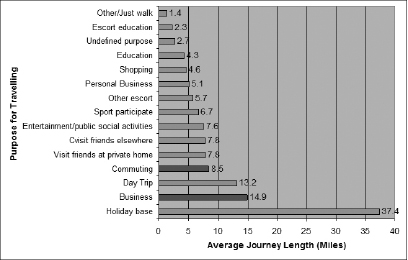
Source: NISRA (2008)1
What this data demonstrates is that the average journeys made by people to work (8.5 miles), to visit friends (7.8 miles), to carry out personal business (4.6 miles), and to go shopping (4.6 miles) could not conveniently be made by walking and therefore would require access to either a car or some form of public transport.
The Northern Ireland Multiple Deprivation Measure is based on the concept that deprivation (in contrast to poverty which is seen as a lack of fiscal resources) occurs across a variety of social, economic and environmental provisions which include:
The proximity to services domain provides the best available data to demonstrate the distances people travel to access key services although it does not explicitly show rural to urban journeys.
"The purpose of this domain is to measure the extent to which people have poor geographical access to key services, including statutory and general services"2.
This measurement is based on a series of indicators:
Figure two shows the Proximity to Services Deprivation Domain for Northern Ireland. This shows that across Northern Ireland the majority of the country has poor access to services, demonstrated by the dark blue colouring of the map. The areas with the highest levels of deprivation in terms of having to travel long distances to key services are in Fermanagh, Omagh, Strabane, the west of Dungannon, Moyle and Larne. Areas which are less deprived in terms of distance to services are the main towns and cities and surrounding areas, for example, Belfast, Coleraine, Derry, Omagh, Enniskillen, Newry, Downpatrick, Lisburn and Antrim.
There are limitations with the access to services domain as an indicator of deprivation, largely due to a lack of relevant data. For example, in the consultation document for the NIMDM 2005 it was proposed that an indicator which comprised access to a car and access to public transport should be included. It was felt however that the data was either outdated or unreliable. In terms of access to a car, the most reliable source was the 2001 census which looks at cars per household, however, this would assume that all members of the household have access to that car or cars, when in fact this is often not the case meaning many members of the household still must rely on public transport, or lifts to access services.
The lack of this type of data means that this domain is based solely on distances to a number of key services and while this is useful it is perhaps misleading when viewed in isolation given that for many people, living in rural areas with a certain degree of isolation, is a lifestyle choice. When the overall map of multiple deprivation (figure3) is consulted it clearly shows that the areas inside the major towns and cities that have access to services are often more deprived (based on other indicators), than those in rural areas which are largely less deprived, with North Tyrone, South Derry and parts of South Armagh providing notable exceptions. It is suggested that an indicator which looks at households without access to a car would provide a stronger representation of access to services deprivation for rural areas, however, up-to-date data for this will not become available until after the next censusiii.[3]

Source: NISRA (2005)3
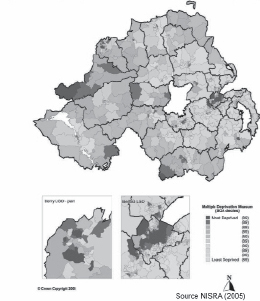
Source NISRA (2005)
Patterns of commuting are typically analysed using Census origin-destination data using the information: where an individual lives and the address of that person's main job. These data provide a very rich source of information on commuting flows for all workers; however, the major drawback with using Census data for analysing commuting patterns is that they become out of date. The last census was 2001 and for the purpose of answering the question of the number of workers travelling from rural to urban areas for work this is the best available source.
Data from the Labour Force Survey (LFS) show that in autumn 2007 the average time spent travelling from home to work in Great Britain (GB) was 27 minutes. In addition the National Travel Survey 2006 (Department for Transport (DfT), 2006) found that one fifth of all km travelled in GB were due to commuting, and this correlates with the data from the NITS which shows that commuting accounts for 21% of total miles travelled. These figures suggest that commuting is highly important in terms of the way people spend their time, in contributing to overall travel patterns and, depending on the mode of transport used, in influencing national carbon emissions4.
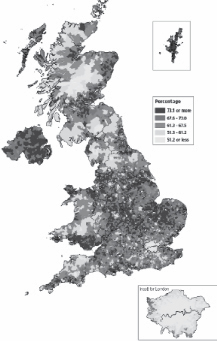
Figure 4 shows that in Northern Ireland there is a very high reliance on cars and vans for the purpose of commuting which is demonstrated by the dark blue covering which is over much of the country. This indicates that 73.1% or more of people use a car to commute while the other predominant colour is light blue indicating a range of 67.6% to 73%. In contrast the map on the right (figure 4) demonstrates a very low usage of public transport services; outside of the Belfast Metropolitan Area only 4.3% or less of the population use public transport while around some of the larger urban centres such as Londonderry and Newry for example, this increases up to 7.6%.
The Belfast metropolitan Area is the largest Urban Centre in Northern Ireland with a population of approximately 645, 000 while almost 1.3 million people live within a 50 mile radius. Belfast is the main centre of employment, administration and commerce for Northern Ireland5 and provides almost 30% of the total employment in Northern Ireland (this figure rises to 50% in the Belfast Metropolitan Area)6.
Research carried out in 1999 as part of the preparation of the Belfast Metropolitan Transport Plan estimated the daily number of cars travelling into and out of Greater Belfast at 297,000 carsiv[4] while the number of cars travelling into and out of Belfast's central core on a daily basisv[5], was estimated at 149,0007.
A survey carried out in November 2005 to establish the mode of transport used by people travelling into Belfast's inner cordon during the morning peak hour showed that 68 per cent of all cars were driver-only occupancy.9
The 2001 census data showed that there were 243, 972 rural dwellersvi[6] employed and working in Northern Ireland. 113, 351 (46%) of these people work in urban areas and 35% of those working in urban areas are employed within the Belfast Metropolitan Urban Area (BMUA).
When area of workplace is compared to area of residence at the district council level it provides some interesting statistics. For example, of the 34, 038 (employed) people living in North Down only 16,534 (48%) actually work in the area while 32% work within the Belfast district council area. Similarly in Newtownabbey 42% work locally while 39% work in Belfast. Of course these areas are within a relatively short commuting distance to Belfast and similarly close areas such as Castlreagh (52%) and Lisburn (32%) also have high percentages of their population working in the Belfast area. For the vast majority of employed people (229,282) living in the Belfast Metropolitan Urban Area (BMUAvii)[7] 88% also work there. Figure 5 is a graphical representation of the commuter flows into the Belfast Area from the Newtownabbey district council area and is useful in demonstrating the high flow of people travelling in from this area.
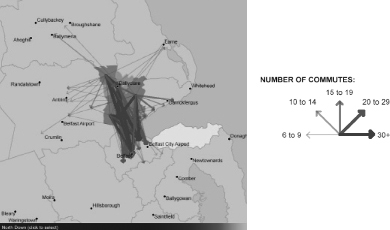
These flows would be very similar for all the surrounding district council areas, like North Down, Carrickfergus, Castlereagh, Lisburn and Antrim, although we can see from figure 6 that in North West Antrim over 70% live and work in the same area, although this area is particularly rural with the main commuter flows going towards Ballymena and Antrim Town. In parts of South Antrim less than 20% live and work in the same area, here the main commuter flow is towards Belfast and Antrim town (see figure 7).

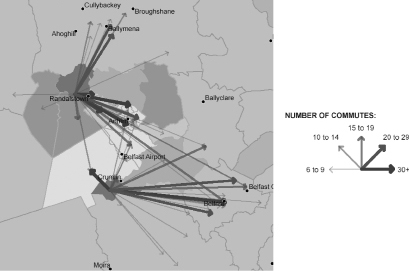

Figure 8 (above) shows that for many parts of the county a large percentage of those who are in employment, work and live in the same area. However, around Enniskillen this percentage drops below 34% and even as low as 20% in some areas. Looking at the statistics for Fermanagh District Council 19,162 (88%) of the 21,725 total people in employment also work in the district council area. 4% do however, work in Omagh; 2.5% work in Belfast; 2% work in Dungannon and there are people from Fermanagh who travel to every other district council area in Northern Ireland for work (see figure 9). Figure 10 shows that for many parts of the county employment was at between 50 to 59%.

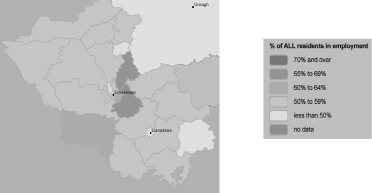
In terms of commuter flows, either within or out of Fermanagh we can see from that maps 1-6 (next page) the majority of these are directed from rural areas into the more urban areas of Fermanagh particularly the urban centre of Fermanagh; Enniskillen which is classified as a medium town (Band D). Lisnaskea is the next largest settlement in Fermanagh however it is classified as a rural area based on the census and is an intermediate settlement (Band F) while Irvinestown is a village (Band G). The maps also demonstrate that people in settlements towards the East of Fermanagh are more likely to travel to urban centres like Omagh and even Belfast.
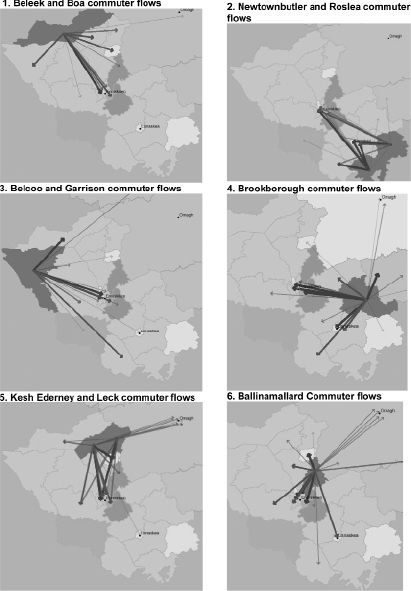
1 (NISRA) Northern Ireland Statistics and Research Agency (2008) "Travel Survey for Northern Ireland 2006-2008". (DRD) Department for Regional Development: Belfast
2 (NISRA) Northern Ireland Statistics and Research Agency (2009) "Northern Ireland Multiple Deprivation Measures 2009: Consultation Document". Department of Finance and Personnel: Belfast
3 (NISRA) Northern Ireland Statistics and Research Agency (2005) "Northern Ireland Multiple Deprivation Measures 2005. Department of Finance and Personnel: Belfast
4 Littlefield, M. and Nash, A. (2008) "Commuting Patterns as at the 2001 Census, and their Relationship with Modes of Transport and Types of Occupation". Office for National Statistics: London [online] accessed 14/03/2010 available here
5
6 Belfast City Council (2008) "Belfast: A Profile of the City 2008-2009". Belfast City Council: Belfast [online] accessed 11/03/2010 available from: http://www.belfastcity.gov.uk/factsandfigures/docs/BelfastProfileOfTheCity08.pdf
7 Letter from The Chief Executive of Roads Service (Dr. Malcolm McKibbin) to Mr. Gregory Campbell, the Secretary of State for Northern Ireland in answer to the question; how many commuter car journeys are estimated to be undertaken in and out of Belfast on a daily basis; and what percentage is estimated to be driver-only occupancy. Dated 6 April 2006 [online] accessed 25/02/2010 available from: http://www.publications.parliament.uk/pa/cm200506/cmhansrd/vo060418/text/60418114.htm
[1]i The TSNI only looks at distances travelled within Northern Ireland, therefore someone travelling from Belfast to Galway (in the Republic of Ireland) via Enniskillen, for example, will only have their journey counted as far as Belcoo where they will cross the border.
[2]ii 6 journey's to a holiday base per year and 17 day trips
[3]iii (NISRA) Northern Ireland Statistics and Research Agency (2005) "Northern Ireland Multiple Deprivation Measures 2005. Department of Finance and Personnel: Belfast
[4]iv Based on cars travelling across the outer cordon, defined by the A55 outer ring road at
[5]v Defined as the area bounded by Westlink in the West of the City and the River Lagan in the South and East
[6]vi People living in Settlements classified in Bands F, G or H
[7]vii Belfast; Carrickfergus; Carryduff; Castlereagh; Lisburn; Milltown; Greenisland; Newtownabbey; Bangor; Groomsport and Crawfordsburn; Helens Bay; Holywood; and Seahill
[8]viii All maps created using CommuterView. Supplied by the Office of National Statistics (ONS); General Register Office for Scotland (GROS); and the Northern Ireland Statistics and Research Agency (NISRA)
| Aspects | Specialist Subgroup | Respondee |
| Social | The Social Development Committee | |
| The Department of Education | ||
| Social Inclusion | Access 2 Benefits | |
| CTA (Community Transport Association) | ||
| Rural Community Network (CTA) | ||
| Mr Lee Wilson | ||
| Health | Belfast Healthy Cities | |
| Institute of Public Health in Ireland | ||
| Environmental | The Environment Committee | |
| Deparment of Agricultural and Rural Development | ||
| Environmental | British Council Challenge Europe Scheme | |
| Energy Saving Trust | ||
| Northern Ireland Environmental Link (NIEL) | ||
| Sustainable Development Commission Northern Ireland | ||
| Sustrans | ||
| World Wildlife Fund (WWF) Northern Ireland | ||
| Cycling/Pedestrianisation | Belfast Metropolitan Residents Group | |
| CTC/NI Cycling Initiative | ||
| Belfast Friends of the Earth | ||
| Greenway to Stay | ||
| Economic | Committee for Enterprise, Trade and Investment (ETI) | |
| Freight | CILT (Chartered Institute of Logistics and Transport (UK) NI | |
| Technology | ACIS Advanced Communications and Informations Systems) UK | |
| The Lord Laird of Altigarvan | ||
| WRIGHTBUS | ||
| Spatial Planning | Mr Arthur Acheson | |
| Belfast Metropolitan Residents Group | ||
| Parker Green International (PGI) |
| Thematic Area | General Issue | Sub Issues | Identified By |
| Modes of Transport | Overdependency of Private Cars | Including Single Car Usage, Emotional Attachement to Cars | Acheson, Bc,Acis, Bmrg, Cilt, Iph, Niel, Sdc, Sustrans, Wwf |
| Externalised Costs | Acheson | ||
| Vehicle Miles Travelled (under 5 miles) | Acheson, SDC, Sustrans | ||
| High Occupancy Vehicle Lanes | British Council, SDC | ||
| Car Clubs | CILT, SDC | ||
| Car Sharing | CILT, SDC | ||
| Car Pooling | CILT, SDC | ||
| Park and Ride Facilities/Walking Facilities | CTA, PGI | ||
| Lower Speed Limits in Residential Areas | NIEL, SDC, Sustrans | ||
| On site car parking | PGI | ||
| Off-site car parking for staff | PGI | ||
| Allocation of Public Sector Jobs (Bain Review) | RCN | ||
| Introduction of congestion charging | SDC | ||
| Current public transportation system | Challenge to Improve Services and Attractiveness | ACIS, PGI | |
| State subsidies for transport links in new developments | BMRG | ||
| Tax effective purchasing of tickets | CTA | ||
| Online purchasing of tickets | CTA | ||
| Review of Bus Corridors in Main Cities | CTA | ||
| Integrated public transport timetabling | CTA, PGI | ||
| Education in schools about public transportation | CTA | ||
| Provision of Enhanced Traffic Management Systems | ACIS, PGI | ||
| Lack of coordination | PGI | ||
| Underutilization of existing transportation vehciles | RCN, Wilson,, DENI | ||
| Dissemination of information on public transport services | RCN, SDC | ||
| Modes of Transport | Walking and Cycling | Health and Environmental Benefits | Acheson, BC, BHC, CILT, FotE. Greenway to Stay, IPH, NIEL, RCN, SDC |
| Road and Pedestrian Safety and Education thereof | Acheson, BHC, FotE, IPH, SDC, Sustrans | ||
| Employer and State Incentives | Acheson, | ||
| Cost-Benefits Analysis | Acheson, | ||
| Cycle Rental Schemes | British Council | ||
| Provision of Hygiene and Changing Facilities | CILT | ||
| Reduced Absenteeism and Improved Fitness | FotE, Sustrans | ||
| Greater independence of our children | FotE | ||
| Broad Accessibility | FotE | ||
| Promotional Events | FotE | ||
| Tax-Free Bicycle Purchase Schemes | FotE | ||
| Creation of Walking and Cycling Networks | RCN | ||
| Alternative Modes of Transport | Electric Vehicles, Monorails | BMRG, WWF | |
| Potential of Inland Waterways | CILT | ||
| Bus Rapid Transit (pro) | CILT | ||
| Bus Rapid Transit (anti) | Greenway to Stay | ||
| Door-to-Door | CTA, RCN | ||
| Rail | LLoA, SDC | ||
| Electrification of current and future NI Rail Network | LLoA | ||
| Trams, Quality Bus Corridors | PGI | ||
| School Transport | DENI, RCN | ||
| Social Services Transport | RCN | ||
| Low Carbon Vehicles | SDC, WWF | ||
| Hybrid Vehicles | ETI |
| Thematic Area | General Issue | Sub Issues | Identified By |
| Accessibility and Equality | Social inclusion, including pt service provision | Geographical, Age, Gender, Disability, Economic | A2B, Acheson, BHC, CILT,CTA, IPH, NIEL, PGI, RCN, Sustrans, Wilson |
| Concessions (passes, fuel) | A2B, RCN | ||
| Real Time Passenger Information Technology | ACIS | ||
| Community Engagement | Belfast Healthy Cities | ||
| Disability and Accessibility | Door-to-Door as an interim solution | CTA | |
| Education | Low Education Level of Professional Drivers | CTA | |
| Spatial Planning | Carrot and Stick measures | Parking charges reflecting full external costs | Acheson, NIEL, PGI, WWF |
| Cost-Benefit Methodology of Road Building | Flaws in current weighing systems | Acheson, | |
| Cost-Benefit Analysis of Rail Infrastructure | External Benefits of Rail mode | LLoA | |
| Comparative Costs of Cycling and Road Building | Higher comparative cost benefit ratio | Acheson, | |
| Cycle Path infrastructure | Lack of cycle paths, greenway networks, signage | CILT, FotE | |
| Adequate Cycle Access and Storage | Cycle Stands | BMRG | |
| Rail Travel | Less Land Intensive | LLoA | |
| Improved pedestrian access | PGI, SDC | ||
| Enhanced public transport links | NIR/Ulsterbus | PGI, SDC | |
| Employment related planning issues | Flexi-time, home office, audio visual conferences | PGI, SDC, DENI | |
| Integrated system of land use and public transport | No detectable features at present | PGI, RCN, SDC, WWF | |
| Need for Health Impact Assesments | in context of transport and land use decisions | Sustrans | |
| Lack of policy in rural areas | Need for a Rural and Equality Proofing scheme | RCN | |
| Removal of sectarian legacy transport planning | Shift to non-sectarian route planning of buses | Wilson |
Sustainable Transport Written Submissions Evidence Matrix
| Thematic Area | General Issue | Sub Issues | Identified By |
| Health | Walking and Cycling | See "Modes of Transport" | BHC, IPH, WWF |
| Obesity and the need for Physical Activity | BHC, IPH, Sustrans | ||
| Health Authorities to assess impacts of transport | BHC, FotE, IPH | ||
| Higher health risk to urban dwellers | NIEL | ||
| Environment | Overdependency on fossil fuels | Acheson, EST, NIEL, RCN, SDC, Sustrans, WWF, ETI | |
| Emissions - Greenhouse Gas, Fossil Fuels | BHC, CILT,NIEL, RCN, SDC, Sustrans, WWF, ETI | ||
| Reduction of Air Pollution | BHC, LLoA, NIEL, SDC, WWF | ||
| Tackling Climate Change | BHC, IPH, LLoA, NIEL, SDC, Wilson, WWF, ETI | ||
| Aviation emissions and pollution | CILT, SDC | ||
| Alternative fuel sources | Biofuels, Biogas, Wind Energy, RTFO | CILT, NIEL, SDC, ETI | |
| Incentives to purchase low carbon emission cars | EST, | ||
| Education of public on environmental issues | EST, | ||
| Rail freight as environmentally friendly mode | LLoA | ||
| Attainment of EU policy and directive targets | NIEL, WWF, ETI | ||
| Govt. Investment in Sustainable Transport | Level of allocation too low | NIEL, Sustrans | |
| Mandatory Vehicle Efficiency Improvement | SDC | ||
| Promotion of Home Shopping | Reduction in road usage by private cars | SDC |
| Thematic Area | General Issue | Sub Issues | Identified By |
| Economic Issues | New economic opportunities through sustainability | BHC, NIEL, PGI | |
| Development of Electric Vehicle Market | BMRG | ||
| Funding for community related schemes | CTA | ||
| Lack of investment in charitable and NP solutions | CTA | ||
| Railfreight as a revenue stream | LLoA | ||
| Correlation between pt investment and pt usage | NIEL | ||
| Prioritization of concerns in decision making | Social and Environmental Considerations v Economic | NIEL | |
| Engagement with Government | Gaps between policy and implementation | Acheson, Belfast Healthy Cities | |
| Need for increased monitoring, good governance | SDC | ||
| Joined up policy making | IPH | ||
| Need for clear target setting, indicators | FotE, Sustrans | ||
| Regulator for Integrated Freight Planning | CILT | ||
| Relationships between govt and govt agencies | CILT | ||
| Lack of strategic vision | FotE | ||
| Need for a Sustainability Audit/Review | LLoA | ||
| Need for a Rail Development Policy | LLoA | ||
| Lack of a Northern Ireland Rural Transport Policy | RCN | ||
| Review of Planning Systems | Location of new settlements in established settlements | Sustrans |
Committee for Regional Development
Room
Parliament Buildings
Tel:
Fax:
To: Committee Members
From: Committee Clerk
Date: 10 February 2010
Subject: Sustainable Transport Inquiry: Consideration of written evidence
Mr Lee Wilson
1. Mr Wilson has responded as a private citizen. His comments reflect his individual background. Six years ago, Mr Wilson lost his sight as the result of a stroke and is fully dependent of public transport and private hire vehicles to commute. Additionally he is the parent of a young family.
2. Mr Wilson makes reference to :
3. Mr Wilson highlights the viability and affordability of public transport. Further that public transport enables increased working commuters to be productive in their travel time.
4. Mr Wilson reiterates general held views that public transport usage contributes to positive environmental trends and reminds that a decrease in the use of private vehicles frees up the road for commercial road traffic.
5. Mr Wilson contrasts existing bus services in his own traditionally loyalist neighbourhood with those in the neighbouring nationalist estate, and questions whether the current modus operandi is economically effective in terms of the size of vehicles used in relation to the number of customers using any particular service, the frequency of service and the routes.
6. Mr Wilson is concerned that current bus services are not operating effectively. Mr Wilson contrasts existing bus services in his own traditionally loyalist neighbourhood with those in the neighbouring nationalist estate, and questions whether the current modus operandi is economically effective in terms of the size of vehicles used, the frequency of service and the routes. Mr Wilson appears to question whether the legacy of segregated services for nationalist and loyalist communities should be continued in our post-transitional society
Committee for Regional Development
Parliament Buildings
Tel:
Fax:
To: Committee Members
From: Committee Clerk
Date: 10 February 2010
Subject: Sustainable Transport Inquiry: Consideration of written evidence
Access 2 Benefits
1. Ms Anderson addresses the Public Notice terms of reference in a generic fashion. In the context of the sustainability of free transport for older people and of rural transport, she raises concerns related to the accessible transport issue.
2. Ms Anderson opines that accessibility to public transport is made more difficult due to the fact that "concessionary passes are not accepted on community and rural transport schemes".
Committee for Regional Development
Parliament Buildings
Tel:
Fax:
To: Committee Members
From: Committee Clerk
Date: 10 February 2010
Subject: Sustainable Transport Inquiry: Consideration of written evidence
Arthur Acheson
1. Mr Arthur Acheson is a qualified architect, Partner and Chair of the Belfast based Boyd Partnership Chartered Architects. Earlier in his career he was a full time lecturer and associate professor at universities in Canada, Australia and N Ireland. In 1982 he was founder Chair of the Belfast Civic Trust.
2. Mr Acheson opines that the report findings and existing policies of specialist bodies are "largely ignored" in Northern Ireland. Specifically he refers to:
3. Mr Acheson notes that the Committee for Regional Development has already identified important aspects of this remit in terms of Northern Ireland and the link between emission reduction and transport policy, the necessity to tackle climate change as part of a Pro-Growth Strategy, the difficulties of the issue of transport emission reduction, the imbalance between Road and Public Transport expenditure
4. Mr Acheson selects statements dated 2009 from a SF MEP and from the Minister to highlight a perceived deficit in knowledge of "the externalised costs" of a car dependent transport system and a transport system "built on sustainability". He attributes this lack of knowledge both to our politicians and the public at large.
5. Mr Acheson favours stronger linkages between policies related to "health, environment, wellbeing, inclusion and economic activity".
6. Mr Acheson suggests a shift a way from the current "cost-benefit methodology of road building" expressing a concern at the current weighting systems.
7. Mr Acheson reminds that the Travel Survey 2005-2007 indicates that more than half of all journeys made in Northern Ireland do not exceed a 5 mile distance and suggests the promotion of walking for journeys not exceeding 1 mile and cycling for journeys not exceeding a 6 mile distance. In this context Mr Acheson further recommends policy making which:
8. Mr Acheson refers to the Transform Scotland document "Towards a Healthier Economy", suggesting the need to apply the economic benefits of sustainable transport.
9. Mr Acheson highlights the benefit of cycling and evidence of achievable savings of £1 million through a shift from sedentary travelling to cycling. He refers specifically to research by Cycling England and the CTC reports, "A new vision for cycling" and "Safety in Numbers".
10. Mr Acheson concludes that a shift to active travel and public transport has multiple benefits, namely health cost reductions, higher levels of child well-being, social inclusion, cost benefits interrelated to a shift to cycling and walking and public health and transport , a reduction in fossil fuel dependence.
11. Mr Acheson advocates redirecting spending into the Northern Ireland economy as Northern Ireland does not have "any major manufacturing plants".
12. Mr Acheson rejects the arguments which suggest the use of electric cars on the basis that it will reduce emissions, on the basis of the increased demands in generated electricity and the improvement of grids. Further it does not reduce the numbers of cars being used nor improve the use of urban space.
Committee for Regional Development
Parliament Buildings
Tel:
Fax:
To: Committee Members
From: Committee Clerk
Date: 10 February 2010
Subject: Review of Submission to Sustainable Transport Inquiry
ACIS
1. ACIS describes itself as the leading UK based provider of integrated information systems in passenger transport applications. Across the United Kingdom, ACIS are currently partnering with all seven Passenger Transport Executives (PTE's), 46 regional and local authorities, 15 regional airports and all the major UK bus operating companies. In Northern Ireland ACIS supply the Real Time Passenger Information System to the partnership of Roads Service and Translink. Its submission focuses on the technology of the Real Time Passenger Information (RTPI)
2. ACIS refers to the following reports:
3. ACIS's data identifies the following key factors which influence passenger satisfaction when using public buses:
Punctuality/Frequency 41 %
Fares 14 %
Comfort 14 %
Cleanliness 10 %
Delay Information 10 %
Information 6 %
Staff 3 %
Refund process 2 %
4. ACIS suggests that Real Time Passenger Information technology can make a significant contribution to changing the public's perception of the reliability of transportation by public buses.
5. ACIS's submission focuses strongly on the link between available state-of-the-art technologies and the ability to increase the usage of public transport. It highlights the Wayfarer system, a low band radio coverage system, which facilitates a flow of Key information to an ACIS procession from each individual bus.
6. ACIS highlights that this technology addresses the key aspects relevant to customer satisfaction and thus makes public transportation a more attractive option. The Wayfarer technology allows not only for a registration of passenger data per available routes, but also for Real Time updating of scheduled arrival timetables to actual arrival times based on the ACIS processor tracking evaluations. Thus both the passenger and the bus company can monitor the whereabouts of vehicles.
7. A non-exhaustive list of the attributes of ACIS system technology includes
8. ACIS evidences the successful application of ACIS technology solutions by the scope and number of installations, in excess of 8,000 buses and at 16 regional international airports, including Victoria Coach Station, London
9. ACIS reminds that Real Time information can be accessed by individual customers through a variety of widely available technologies, such as internet websites, Digital TV platforms, innovative Smart displays in private homes and via SMS requests.
10. In summary, ACIS purports that the following RPTI Technology underpins a change in public attitudes to the viability of public transport and thus directly support sustainable transport policy making. In particular it delivers:
11. This technology is further supported by Traffic Light Priority technology which allows buses running unacceptably late to request a green light at junctions. All major routes within Belfast are fitted with Traffic Light Priority equipment. There are currently 107 junctions fitted with this technology. This underpins the goal of bus timetables being reliable for waiting passengers.
12. ACIS identifies the following advantages to be achieved by using TLP Technology :
Committee for Regional Development
Parliament Buildings
Tel:
Fax:
To: Committee Members
From: Committee Clerk
Date: 10 February 2010
Subject: Sustainable Transport Inquiry: Consideration of written evidence
The Sustainable Development Commission Northern Ireland (SDC)
1. The Sustainable Development Commission Northern Ireland (SDC) describes itself as "the Government's independent advisor on sustainable development, reporting to the Prime Minister, the First Ministers of Scotland and Wales and, in Northern Ireland, the First and Deputy First Minister."
2. SDC refers to a number of strategy papers, policy documents and reports including:
3. SDC further relies on additional statistical information from the following sources to illustrate and substantiate the current situation:
4. SDC identifies the following aspects relevant to the discussion:
5. SDC primarily identifies its own strategy, First Steps in Sustainability, as a key policy in this area, referring in particular to its six principles of sustainable development, namely
6. SDC advocates a four strand approach to transport, which promotes a governmental strategy to reduce demand for motorised transport and to improve the efficiency of existing transport modes.
7. SDC suggests numerous possible measures to realize this strategy, including:
8. SDC highlights the particular overdependence on the car as a mode of transport in Northern Ireland and indicates that the perceived lack of choice of alternative transport modes heavily influences the continued overdependence on private transport.
9. SDC reminds that the whilst the use of more efficient vehicles into current transport trends is laudable, sustainability can only be wants people to have a choice and it wants people to be able to choose the most sustainable and lowest carbon ways of meeting their transport needs.
10. SDC supports the government's initiatives to promote ultra-low carbon vehicles, acknowledging the necessity to develop much more efficient vehicles to reduce greenhouse gas emissions and our reliance on oil. However it notes that simply substituting much more efficient vehicles into current transport trends is clearly not sustainable.
11. SDC advocates a hierarchical approach to transport, which includes a demand reduction, a modal shift to more sustainable modes and efficiency improvements.
12. SDC would welcome government action which:
13. SDC further calls on government to create an environment in which people can choose more sustainable modes when they do travel by
14. SDC believe it is necessary to improve the efficiency of existing modes by:
Committee for Regional Development
Parliament Buildings
Tel:
Fax:
To: Committee Members
From: Committee Clerk
Date: 10 February 2010
Subject: Sustainable Transport Inquiry: Consideration of written evidence Friends of the Earth
1. Belfast Friends of the Earth has submitted its document "Belfast Cycle City – 2020 Vision" as the basis of its response to the Public Notice. The report identifies the many positive benefits of cycling, and identifies best practice from the UK and Ireland and wider EU that should be implemented in Belfast.
2. Belfast Friends of the Earth makes reference to the following existing documentation in its submission:
3. Belfast Friends of the Earth highlights the positive trend the 100% increase in cycling in Belfast since 2000.The Belfast Metropolitan Transport Plan 2004 identified a proposed cycle network but only short sections have been delivered. Indeed the planned pedestrianisation of the city centre may make cycling more difficult should the introduction of one way streets take place.
4. Belfast Friends of the Earth highlight the health benefits which result from physical inactivity which justify expenditure in cycling. Transform Scotland Trust, for example, found that a cycling mode share of 13% in Scotland would result in savings of between £1 and 2 billion pounds each year.
5. Other benefits from cycling include
To identify the policies, attitudes and technologies likely to underpin a move to more Sustainable Transport in Northern Ireland
6. Belfast Friends of the Earth identifies a change in mindset as being crucial to its vision of creating a strong cycling culture in Belfast. It envisages the following three actions as being desirable:
7. However it argues that in terms of infrastructure cycling is being hampered through
8. Belfast Friends of the Earth promote 20mph traffic zones and traffic calming in selected residential areas as a favourable environment for cyclists.
9. Belfast Friends of the Earth relates it recommendations to four specific areas; Belfast Cycling Strategy, Infrastructure, Schools and Further Education, Sustainable Travel City and Promotion.
10. Belfast Friends of the Earth refers to the recommendations of the Northern Ireland Cycle Strategy which foresees strategy making and target setting on a local basis. In the context of Belfast, it recommends a Cycle Strategy which incorporates increased cooperation with strategic partners with the aim of increasing the numbers of cyclists and developing and embedding a cycle strategy for Belfast.
11. In terms of infrastructure Belfast Friends of the Earth highlights the need for the road network, parks and other public spaces to become a comfortable environment for those who cycle. In particular Belfast Friends of the Earth identifies
12. Belfast Metropolitan Transport Plan routes are delivered in full. Other infrastructural improvements include: a city wide 20mph network, removal of one way streets for cycles, cycle tracks, greenway networks, signage, cycle stands and links to public transport.
13. Belfast Friends of the Earth highlights the growing problem of childhood obesity and the health benefits of cycling to school. To encourage more schoolchildren to use cycling as a means of transport between home and school, Belfast Friends of the Earth suggest educational programmes such as Road Cycle Training, Safe Routes to Schools and Bike it.
14. Belfast Friends of the Earth suggests that the expansion of the University of Ulster Belfast City Centre Campus provides an opportunity for creating quality cycle routes between Queen's University and the UU Belfast campus/Cathedral Quarter (with potential links to student residential areas)
15. Belfast Friends of the Earth shares in the carrot and stick approach to discouraging motorists and encouraging cycling, as well as other forms of public transport. Possible suggested sticks are making it more difficult to drive and park in the city and reallocating road space to sustainable means of travel.
16. Belfast Friends of the Earth recognises the need to change the travel behaviour of individuals and communities. Possible "carrots" to promote this transition are
17. In conclusion Belfast Friends of the Earth recommend that following steps in terms of target goals, expenditure on cycling and future strategy development:
Committee for Regional Development
Parliament Buildings
Tel:
Fax:
To: Committee Members
From: Committee Clerk
Date: 10 February 2009
Subject: Sustainable Transport Inquiry: Consideration of written evidence
Belfast Metropolitan Residents' Group
1. The Belfast Metropolitan Residents' Group (BMRG) is an association of community groups drawn from across the Belfast Metropolitan Area. BMRG was founded in 1999 to make a community input into strategic planning issues in Northern Ireland.
2. Belfast Metropolitan Residents' Group suggest that a change the mind-set of government departments, developers and planners towards sustainable transport. In terms of spatial planning, it is suggested that the design of new developments must allow for
3. Belfast Metropolitan Residents' Groups advocates that new developments must be served by public transport from the start of construction even if this means the introduction of some sort of subsidy (which can be tapered). It would therefore be important to consider public transport when constructing roads.
4. Belfast Metropolitan Residents Group suggests an exploration into innovative or new forms of public transport, for example, overhead monorails over dual carriageway median strips.
Committee for Regional Development
Parliament Buildings
Tel:
Fax:
To: Committee Members
From: Committee Clerk
Date: 10 February 2010
Subject: Sustainable Transport Inquiry: Consideration of written evidence
Professor Julian Hine
1. Professor Hine is Professor of Transport, Built Environment Research Institute, University of Ulster. His submission however reflects his own personal views and not necessarily those of the University of Ulster.
2. Professor Hine refers to the following documentation:
3. Prof. Hine opines that the current reviews of the Regional Transport and (RTS) Development Strategies (RDS) offer an opportunity for the development of a modern and sustainable transport system. He acknowledges that the current policy framework as specified in the RTS and RDS has achieved significant new investment in transport infrastructure which has addressed decades of underinvestment but reminds that future strategy and investment decisions must be 'future proof'.
4. Prof Hine focuses on the reduction of car dependency in his submission. He notes that to date the objective of achieving a mode shift from the private car to public transport, cycling and walking, it is quite clear that this has not been achieved, despite rising numbers of passenger journeys on the rail and bus system. He further highlights that often locations cannot be served by an adequate public transport system, hence indicating failures in the land planning system.
5. Prof. Hine, in his comparative analysis of investment in road and investment in public transport, expresses the view that the emphasis in terms of road investment must increasingly be about management of existing capacity rather than the creation of new. This is based on the need to achieve environmental improvements, such as in the air quality and in reducing greenhouse gas emissions.
6. Prof. Hine states that the direction of conventional transport planning is focused on non-sustainable friendly goals, making it difficult for slower green modes and public transport to gain ground, underestimating the environmental and wider societal costs associated with the current range of transport choices and patterns of provision, and producing car dependent communities.
7. Prof. Hines highlights the lower levels of car access of disadvantaged groups in society, for example, those on low incomes, women, and the elderly and disabled, whose access to a variety of goods and services is thus restricted. These patterns are especially pronounced in rural areas and outer metropolitan/urban areas. Increased public transport use can conversely reduce the need for expensive road infrastructure, reduce greenhouse gas emissions and urban air and noise pollution.
8. Prof. Hines indicates that statistical data reveals stagnation in miles travelled by car, car ownership, licensing holding and shared journeys. He was unable to locate data which differentiated between travel for commuting purposes and travel of other types of activities and suggests that such research would be useful in any plan to reduce vehicle miles travelled (VMT).
9. In the context of the uptake of bus and rail passenger numbers, Prof. Hines points out that the statistics do not reveal whether the expansion in passengers is based on car users shifting to public transport. Concessionary fare schemes may have attracted other sections of the population who do not use cars. Prof. Hine argues that evidence regarding the attraction of car users to public transport is limited or non existent in the Northern Ireland context. It also clearly demonstrates the need for a step change in policy. If public transport is to attract more car-borne trips and if mode shift is seen as a serious policy objective then it is clear that policy needs to adopt a different framework to the management of transport demand particularly in urban areas.
10. Prof. Hines discusses the issue of pull factors which would attract car users to shift to public transportation, walking or cycling. These factors include lower fares, travel information, regular departure times, security, improved cycling and walking infrastructure, fuel prices, and reduction in income.
11. Prof Hine refers to a linkage between "carrot and stick" policy making, for example investment in public transport and high parking charges. It may be necessary to differentiate measures depending on the geographical area. In this context, Prof. Hine cites comparative examples of measures taken in Nottingham, Perth (Australia), Rome, London, New York and Paris, which have all resulted in reductions in car usage.
12. Prof. Hines acknowledges a greater car dependency in rural areas to enable access to goods, services and schools. However, the growth of the rural population in Northern Ireland has also created higher traffic levels on rural roads. Aspects of improvement were identified such as greater co-ordination of rural transport bus operations with community transport operations and educational transport provision, and more investment in safer routes for cycling and walking, the latter being modes of transportation which bring significant health benefits. Benefit to cost ratios have been shown to be significantly higher than for roads and public transport schemes at 20:1 for investment in walking and cycling compared to 3:1 that can be found for roads and public transport schemes
13. Prof. Hine suggests that significant changes in public policy are required to reduce levels of car dependence, perhaps through the implementation of demand management measures. Future land use planning decisions need to be focused on increasing density and focusing development in existing urban areas and also reducing average journey lengths. One possible target by public transport, walking and cycling initiatives is journeys under 5 miles distance, which currently represent 54% of all car trips.
14. Prof. Hine advocates mobility management and vehicle miles travelled (VMT) reduction targets, such as those being implemented in California, Washington State and Yolo County. The advantages of such approaches are that they (i) provide strategic guidance for individual policy and planning decisions. (ii) integrate policies and planning practices, reducing conflicts and inefficiencies. And (iii) encourage policy makers to correct existing practices that stimulate VMT growth (such as unpriced roads, generous and free vehicle parking, and dedicated roadway funding that cannot be used for alternative modes), and to implement mobility management strategies, many of which are justified on efficient and equitable grounds.
15. In conclusion, Prof. Hines identifies the following issues to be urgently addressed:
Committee for Regional Development
Parliament Buildings
Tel:
Fax:
To: Committee Members
From: Committee Clerk
Date: 10 February 2009
Subject: Sustainable Transport Inquiry: Consideration of written evidence
Chartered Institute of Logistics and Transport (UK) NI Region
1. CILT describes itself as "the professional body for individuals and organisations involved in all aspects of transport and logistics" and is "not a lobbying group". Its overall membership is 19,000, 200 of which are Northern Ireland based.
2. In response to the call for exploration and clarification of social, environmental and economic aspects of sustainable transport, CILT (UK) NI made the following submissions:
3. In the context of social aspects, CILT (UK) NI identifies a reduction of the use of private cars and positive discrimination towards public transport as a desirable direction for policy making. CILT (UK) NI highlights the health benefits of walking and cycling in the context of underutilised modes of short-range travel.
4. In the context of environmental aspects, CILT (UK) NI draws on statistics from the Stern Review to overview the important global environmental aspects of sustainable transport. In terms of climate change and the problem of fossil fuels emissions 75% of emissions are attributed to road transport, 12.5 % attributable to air transport, and 12.5 % to rail and shipping combined.
5. CILT (UK) NI makes reference to predictions that by 2050 total CO2 emissions will double. Furthermore aviation related emissions will treble and fugitive emissions will quadruple.
6. CILT(UK) NI highlight the Stern Review's concern on the global rate of growth in car ownership, identifying China and India as table leading countries with "astronomical" growth rates.
7. CILT(UK) NI suggest that measures such as congestion charges may be effective in reducing Greenhouse Gas Emissions but an increase in the cost of private transport may lead to social exclusion, particularly in rural areas.
8. In terms of economic aspects CILT (UK) NI identifies movement of goods by road as the primary freight route in Ireland. Rail freight is deemed no longer to be an option. It suggests that "short sea and costal shipping and the potential of inland waterways" are possible alternative freight transport methods which require more exploration by the Department of Regional Development.
9. The CILT (UK) NI submission indicates that the logistics sector is agreed on the need to enhance its economic competitiveness and identifies increased business efficiency, reductions in fuel consumption, business sustainability as possible areas of improvement. CILT (UK) NI cites several possible examples of efficiency improvement, naming the use of double-decker trailers and other flexible trailer designs.
10. However CILT (UK) NI cites lack of sufficient research as a hurdle to deciding on the best possible approach moving forward. CILT (UK) NI argues that the initial investment in a sustainable transport system may be financially beneficial in the long term, highlighting a movement away from reliance on oil towards carbon neutral energy sources or locally produced sustainable energy and a reduction in car usage as two practical measures which could be implemented.
11. In answer to the call to identify policies, attitudes and technologies likely to underpin a move to more sustainable transport in Northern Ireland CILT(UK) NI focuses on the use of cars, renewable fuels, the Bus Rapid Transit system and its own report "The Inconvenient Truck".
12. CILT(UK) NI suggests two methods of tackling the problem single occupancy vehicles, "Car clubs", whereby a club member can book a fleet vehicle for an annual fee of between £100 and £200 plus mile and hour usage charges, are identified as a workable solution in areas of high density housing, good public transport and congestion. The benefits attributed to car clubs are reduction of the number of cars on the road, reduction in congestion and pollution, and reduction in parking pressure.
13. The second CILT(UK) NI suggestion is "car sharing", whereby car owners share their own vehicles with one or more people for all or part of a trip in return for a contribution to fuel costs. CILT(UK) NI indicate that car sharing may operate on an informal basis between private individuals travelling to the workplace, parents sharing "school runs", or on a more formal basis, such as company car sharing. Reference is made to the use of car sharing car parks on the major arterial junctions as evidence of informal car sharing. CILT (UK) NI further suggests that the introduction of company car sharing schemes may benefit problems with parking restrictions and travel costs.
14. CILT (UK) NI indicates that the use of alternative fuel sources such as biofuels are being tested by companies such as Virgin Atlantic Airlines and Stagecoach and cites the examples of the use of electric delivery vehicles by companies such as TK Maxx and B9 Energy in Northern Ireland.
15. CILT (UK) NI mentions the Bus Rapid Transit as an "exciting innovation in public transport."
16. CILT (UK) NI refers to its 2009 report "An Inconvenient Truck" as a useful practical guide to industry members. The focus of the 2009 report was CO2 reduction and aimed to increase the level of understanding of the issues involved, to raise awareness of existing structures to measure, monitor and reduce carbon emissions from business transport.
17. CILT (UK) NI makes recommendations in two main areas, personal travel and freight transportation. Cycling and Walking are promoted as alternatives to private car usage for journey's under two miles. A need is identified for the increasing education in road safety and cycle proficiency. CILT (UK) NI positively evaluates the use of the Sustrans organisation in its provision of the "Rural Safe Routes to School" programme.
18. CILT (UK) NI further identifies the need to provide cycle related infrastructure (cycle paths) and facilities (lockers and showering/changing facilities).
19. CILT (UK) NI advances the argument that an intensification of the public transport network, both in urban and rural areas, if issues of social inclusion are to be addressed.
20. In terms of the relevance to Northern Ireland of the "Inconvenient Truck Report", CILT (UK) NI focuses on the issue of the reduction of carbon emissions by the business transport sector, complaining of the slow progress rate. CILT (UK) NI advances the following suggestions to improve the current situation. Investment should target the rail network to provide more freight capacity and improve facilities to optimize the transportation chain between rail and road.
21. CILT (UK) NI suggests a single body for Northern Ireland with the responsibility for integrated freight planning "in each region/local area of the country". It further suggests the need to improve coordination of Government Agencies to resolve "a conflict between central Government policy and local Government actions."
Committee for Regional Development
Parliament Buildings
Tel:
Fax:
To: Committee Members
From: Committee Clerk
Date: 10 February 2010
Subject: Sustainable Transport Inquiry: Consideration of written evidence
Wrightbus
1. WRIGHTBUS describes itself as the only major bus manufacturer on the island of Ireland and second largest bus manufacturer in the UK. Its approach is both pioneering and innovative in the field of low floor buses, BRT (Bus Rapid Transit) and hybrid vehicles.
2. WRIGHTBUS refers to the following existing literature in its submission:
3. WRIGHTBUS response to the terms of reference reflects its field of specialism as a bus manufacturer.
4. WRIGHTBUS highlights the following social aspects of sustainable transport: the high value placed on greater personal mobility, the link between mobility and access to jobs, education, shops and services, the shift in housing trends and the resulting growth in traffic from suburbs to the towns, particularly in the context of work commuting.
5. WRIGHTBUS reminds of the risk of deaths and personal injuries on our roads, and the higher incident of accidents when travelling by car as compared to travelling by public transport.
6. WRIGHTBUS notes the link between health risks and both air and noise pollution attributed to the field of transport, citing respiratory and cardiovascular disease. disturbed sleep, hearing impairment and hypertension as examples.
7. WRIGHTBUS refers to WHO reports which highlighted the importance of social interaction to human wellbeing and thus reminds that transport can facilitate wider social interaction. In this context WRIGHTBUS reminds that public transport can promote social inclusion and the alleviate the lack of access to private cars among certain sectors of our communities, such as the young, many elderly persons and those who do not drive either for health reasons or issues of affordability.
8. In terms of environmental aspects WRIGHTBUS highlights the following important issues: the under usage of biofuels and the lack of address of the issues of finite resources, particularly petroleum, the fact that road transport contributes to 74 % of all emissions from transport, and the disproportionate rise in greenhouse gas emissions in the transport sector. In this context WRIGHTBUS highlights more generic environmental concerns such as include the preservation of wildlife habitats, and the hydrological impacts of new road developments and increasing water run-off from more extensive hard surfaces.
9. From an economic perspective, WRIGHTBUS acknowledges both a rise in car ownership and the number of lorries on the road and the intrinsically linked risk in congestion, the direct cost of which it suggests is 2 % of GDP. It is clear that public transport alleviates congestion and contributes to better urban space planning.
10. WRIGHTBUS identifies two other major trends influencing the growth in transportation, namely the import of finished goods produced in low cost countries by developed countries and the import of food from all corners of the globe due to the increasing sophisticated palate of a more affluent society.
11. WRIGHTBUS suggests improving public transport creates local employment. Whilst it acknowledges that there are no car factories in Northern Ireland., it reminds that the Wrightbus factory in Ballymena employs some 900 people directly, and many more indirectly.
12. In its assessment of existing and old policies which use "carrot and stick" systems to incentivise the use of public transport, WRIGHTBUS acknowledges that strong public rejection of congestion charges and the need for politicians to get re-elected are factors which cannot be ignored.
13. To counterbalance the need for personal mobility and the use of private cars, WRIGHTBUS believes that the most realistic opportunity to reduce emissions from cars is to offer a very attractive public transport system as an alternative. To be successful this needs to be high quality and affordable. On average public transport consumes 3.4 times less energy per passenger kilometre than cars, and this ratio is even more favourable in the rush hour. WRIGHTBUS acknowledges that Public transport will not be the ideal solution for every individual for every journey, but it could curtail the steady increase in the number of two and three car families.
14. WRIGHTBUS reminds that land use planning which favours increasing urban population densities may result in the need for a better public transport provision. Conversely the containment of urban sprawl will reduce the need for car transport. The benefit of investment in new trains and the new buses on the Metro services and the need for further investment in the rural bus network are cited as specific examples of policy directions as is the need to benchmark the level of funding for public transport in Northern Ireland with the UK, Ireland and the rest of Europe,
15. WRIGHTBUS identifies network Quality Bus Corridors (QBC), Bus Rapid Transit (BRT), trolleybus, hybrid buses, light rail and heavy rail as modes of transport which could enhance and develop existing public transport network systems. Its submission includes detailed technical information and reference to its own publications.
16. WRIGHTBUS further advocates a system-based approach to public transport network planning, whereby passenger demand, system objectives and funding should inform the decision making process.
17. WRIGHTBUS suggests bus rapid transit systems as a good alternative when passenger demand is not high enough to justify light rail solutions, but large numbers of people still require transportation. BRT is a rubber tyred transit service that can provide passengers with a comparable journey experience to Light Rail provided it is afforded similar segregation from traffic, high quality infrastructure and customer focussed delivery. BRT vehicles have the additional advantage that they are not confined to rails. After enjoying segregation from traffic in town/city centres they can continue on ordinary roads.
18. WRIGHTBUS summarizes the value of bus rapid transit in that:
19. WRIGHTBUS evaluates the possible contribution of hybrid buses technology in terms of positive effect of improving fuel savings, and reducing emissions which is consistent with a vision for sustainable transport. The hybrid system couples a much smaller car engine with electric motors and an advanced battery pack. Regenerative braking (energy captured during the braking process) acts as a supplementary power source for the vehicle. Power to drive the bus therefore derives from electrical energy produced by the very efficient small diesel engine as well as energy captured when the vehicle brakes.
20. In conclusion WRIGHTBUS submits that the early introduction of cleaner technologies is necessary to achieve sustainability in transport targets. In addition policies to influence individual travel behaviours towards public transport alternatives to private car usage are needed.
Committee for Regional Development
Parliament Buildings
Tel:
Fax:
To: Committee Members
From: Committee Clerk
Date: 10 February 2010
Subject: Sustainable Transport Inquiry: Consideration of written evidence
Community Transport Association (CTA)
1. CTA Northern Ireland is part of the Community Transport Association UK, "a growing national charity giving voice and providing leadership, learning and enterprise support to a wide range of organisations delivering innovative and flexible transport solutions to achieve social change in their communities." The composition of its current Committee (2009-2010) evidences representation of important local based transport-related organisations, specifically:
2. CTA refers to a number of existing documentation, including legislation, strategy papers and reports in its submission. These include
3. Given that the focus of CTA's work is on what can be generically classified as accessible transport issues, many of the issues raised can be allocated to this important subsection of the overall remit of Sustainable Transport policy making.
4. CTA highlights the preferred usage of private car to public transport as a major sustainability issue.
5. CTA overviews its contribution under the following headings
6. CTA's response highlights the transport needs of specific groups within our society, in particular the elderly, the disabled and those living in rural communities. CTA is opposed to segregated transport such as the Door-to-Door services provided through the Transport Programme for People with Disabilities. Whilst it acknowledges it usefulness, CTA views this as interim solution which does not address overall public transport system accessibility and which may be seen as non-inclusive, "disabled only" form of transport.
7. CTA suggests a link between the low level of essential skills education of "career drivers" and a need to improve education in schools which in turn will result in better understanding of road related issues and improved access to transport workforce related careers.
8. CTA highlights the issue of continuation of funding for schemes such as the Rural Community Transport network which currently provides in excess of 618,000 passenger trips per year is due to end March 2012. There is no guarantee that the Rural Transport Fund will continue post March 2012. The problematic issue of future planning therefore results in a call clarification and confirmation of the future of alternative transport solutions from DRD.
9. CTA further purports that the lack of investment in the last 5 years in urban community will inevitably result in an increase in isolation and polarisation in some urban communities across Northern Ireland.
10. CTA raises concerns about the lack of investment in charitable and non-profit making, community led solutions and the disparity between the levels of investment in this sector compared to the level of investment in private companies.
11. CTA believes that it is imperative to make the use of public transport easier and thus facilitate accessibility. This may be achieved through improving existing policies, attitudes and technologies in a wide range of areas including:
12. CTA calls for a major review of the Northern Ireland public transport system. CTA opines that the current procurement system is flawed on the grounds that it excludes alternative transport providers. CTA views the exclusion of community and charitable organisations as detrimental as private companies are disproportionately advantaged in terms of their access to public sector investment.
13. CTA identifies education of school leavers on the merits and viability of public transport options, including the environmental aspects, and a shift in marketing strategies in favour of rural transport scenarios as underpinning policy measures which would promote public transport patronage.
Committee for Regional Development
Parliament Buildings
Tel:
Fax:
To: Committee Members
From: Regional Development Committee Clerk
Date: 10 February 2010
Subject: Review of Written Submission to Sustainable Transport Inquiry from British Council Challenge Europe (BCCE) –
Promoting Urban Sustainability Project Group
1. The British Council defines itself as "the UK's international cultural relations organisation which operates in 110 countries and territories worldwide. Its purpose is to build mutually beneficial relationships between the UK and other countries and to increase appreciation and understanding of the UK's creative ideas and achievements
2. The Promoting Urban Sustainability project is one of three projects being taken forward by British Council Challenge Europe. It comprises a programme of research, stakeholder engagement and lobbying aimed at ensuring Governments in Northern Ireland and the Republic of Ireland place sustainable transport options at the heart of their transport policies for cities and urban areas. Its submission therefore makes no reference to rural sustainable transport issues.
3. The Challenge Europe is the European element of the British Council's global climate programme. The British Councils identifies its core partner organisations as
4. BCCE makes reference to the following literature and documentation in its submission:
5. The aim of the project is to identify examples of best practice in sustainable transport from across the globe.
6. BCCE acknowledges that technical improvements in vehicle efficiency will lead only to small reductions in Northern Ireland's level of greenhouse gas emissions from transport. To ensure significant reductions in transport related emissions a modal shift is needed in transport behaviour coupled with an overall reduction in vehicle kilometres travel.
7. BCCE identifies high occupancy vehicle (HOV) lanes, lanes on motorways or dual carriageways in which only vehicles with 2 or more occupants are permitted to travel, as a policy measure to encourage car sharing. HOV lanes may be in operation at all times or at peak hours only. It is suggested that one such scheme has resulted in a 10% reduction in single occupancy vehicles (from 80% to 70%) and a 10% increase in vehicles with at least 1 passenger (from 20% to 30%) travelling the route. BCCE identifies examples of such practice in USA and Canada, as well as four stretches of road in the UK.
8. It is BCCE's intention to conduct further research into the potential for introduction of HOV lanes on major arterial routes in Belfast and potentially other cities in Northern Ireland.
9. BCCE notes a tandem practice of introducing HOV lanes and promoting car sharing schemes and reminds of the existence of the DRD Travelwise Carshare NI scheme.
10. BCCE promotes cycling as an environmentally friendly and healthy travel option, but identifies a threshold distance of three or four miles as the point at which cycling becomes a less realistic option.
11. Cycling further bears economic benefits such as improved workforce efficiency and reduced rates of absenteeism.
12. Cycle Rental Schemes are identified by BCCE as an initiative practiced in many large European cities. The Paris example is based on a symbiotic partnership between local government and a major advertising agency whereby the council has traded off its city owned on-street advertising hoardings to the agency in return for the agency paying for the supply and repair of the bicycles and all start up costs. The council receives all the revenue from the programme as well as an agreed fee from the advertising agency.
13. BCCE cites Dublinbikes as another example which is based on the Paris model. A user of the scheme buys a daily, weekly or yearly pass, priced at €1, €7 or €29 respectively and guarantees a €150 deposit payable by credit card if the bicycle is not returned after a specified period of time. The first 30 minutes of use are free, and then the user is charged €1 for each subsequent 30 minutes. The fee structure supports the fundamental principle behind the rental scheme that the bikes are for city commuting and are for use by the whole community.
14. BCCE lists the following potential modus operandi of a public rental bicycle scheme for Belfast.
15. In addition to being a "no-carbon" transport option, cycling has the potential to become an additional revenue stream for local government and may boost the Belfast tourism industry.
16. Relying on DRD documentation, BCCE assert that over a fifth of our population would cycle more if government invested in cycle track network improvements. BCCE intend to make a comparative study of international best practice to identify how cycling commuting can be increased in Northern Ireland's urban centres.
17. BCCE raise the issue of the contribution government and employers could make to make cycling a more viable transport choice for their staff, and include financial assistance in the provision of cycle parking, changing and showering facilities, bicycle maintenance and cycle training as suggestions for positive practical support in this area.
Committee for Regional Development
Parliament Buildings
Tel:
Fax:
To: Committee Members
From: Committee Clerk
Date: 10 February 2010
Subject: Sustainable Transport Inquiry: Consideration of written evidence
Belfast Healthy Cities
1. Belfast Healthy Cities is a leading member of the WHO European Healthy Cities Network. Healthy Cities defines health as the outcome of social, economic and physical living conditions and remind that the lowest social groups are furthest removed from access to resources and goods relevant to health. Belfast Health Cities works in partnership with a number of organisations, including:
2. Belfast Healthy Cities refers to a number of strategy papers, policy documents and reports and to its involvement in transport related projects. These include:
3. Belfast Healthy Cities highlights that convenience greatly influences people's transport decisions. Convenience is defined in terms of cost of transport options, quality of transport options and the degree of connectivity in transporting people to their required destination(s).
4. Belfast Healthy Cities contrasts convenience with the need for sustainable transport policy making to produce a reduction in the need to travel. This encompasses decision making processes in land use planning. Belfast Healthy Cities identifies land use planning as an aspect of policy making which shapes people's transport needs and is easier to tackle than changing people's behaviours. The concept of accessibility is central to the success of sustainable transport and is identified as being particularly well-suited to underpin a sustainable transport system.
5. Belfast Healthy Cities cites the following social aspects linked to sustainable transport policy making. It should deliver
6. In terms of environmental aspects Belfast Healthy Cities highlights the need to reduce air pollution and to tackle climate change and peak oil consumption.
7. Belfast Healthy Cities reminds that investment can bring about savings elsewhere in economy, especially in health and social care. Investment generates new economic opportunities. Further a reduction in the need for new roads and road maintenance would result in spin off savings and benefits.
8. Belfast Healthy Cities identifies policy as the key driver of change; behaviour change is most likely if the right choice is the easy choice and there are examples of success
9. Belfast Healthy Cities advocates policy measures which usefully build on examples of success elsewhere. Policy should be developed on a cross department basis. Key policies, including the RDS, RTS, Planning Policy Statements and Investing for Health, should be based on common aims and objectives and ideally shared targets
10. Belfast Healthy Cities calls on the Regional Development Committee to take leadership in developing common aims and objectives and has a key role in monitoring progress and garnering support throughout the Assembly
11. The health sector can support sustainable transport by providing an extensive evidence base and tools for assessing impacts of transport. Belfast Healthy Cities can offer support by sharing expertise on Health Impact Assessment and ways of strengthening health equity.
12. Belfast Healthy Cities sees strong, high level, cross sectoral leadership as being crucial. It advocates further planning which should be led by a Ministerial Action Group incorporating Ministers responsible for transport, planning and environment, economy, regeneration, health and rural affairs. Joined up policy making is key to a successful switch; need to develop common definition, aim and objectives across relevant policies.
13. Belfast Healthy Cities envisages that the policy focus should be on the RDS and the RTS, with the planning system, investing for health, regeneration and rural policy key supporting policy arenas. It suggests that action could be strengthened through a cross departmental sustainable transport strategy and action plan, linked to the RDS and RTS. Further, health and health equity objectives should be incorporated in policy and action; all transport decisions should incorporate assessment of environmental, health and social impact, while cost benefit analysis also should incorporate these aspects
14. Belfast Healthy Cities advocates the use of clear targets to assess policy and action, e.g. a 5% reduction in car journeys per annum or increasing the non car share of journeys to 50% by 2020 (baseline 30%, 2007/08). Another example would be to set indicators and collect data to monitor progress. Belfast Healthy Cities admits that this may require new indicators to be developed or new data to be collected, for example on accessibility and people's transport needs
15. Belfast Healthy Cities express the need to urgently implement monitoring processes and to meet climate change and emissions targets already set in the UK Climate Change Bill, in order to provide sufficient time to prepare for a 'post-oil' society.
Committee for Regional Development
Parliament Buildings
Tel:
Fax:
To: Committee Members
From: Committee Clerk
Date: 10 February 2010
Subject: Sustainable Transport Inquiry: Consideration of written evidence
Institute of Public Health (IPH)
1. The Institute of Public Health in Ireland (IPH) defines its aims as the improvement of health on the island of Ireland by working to combat health inequalities and influence public policies in favour of health. IPH promotes cooperation between Northern Ireland and the Republic of Ireland in public health research, training and policy advice.
2. IPH's submission focuses of sustainable transport in terms of health outcomes and makes reference to the following documentation in its submission:
3. IPH links its discussion of sustainable transport to the areas of health outcomes, health inequalities, social connections and climate change.
4. One of the main areas of concern for IPH is the issue of obesity in Northern Ireland and the impact of obesity in terms of loss of productivity and terms of costs of care.
5. IPH submits that current transport patterns have contributed to an increase in obesity. Urban sprawl, where land use spreads out into areas adjoining the edge of the city can increase car dependency and evidence shows that those living in such areas drive three to four times more than those who live in efficient, well-planned areas. It has also been shown that each additional hour spent in a car a day can be associated with a 6% increase in the likelihood of obesity. Sustainable transportation methods contribute to increased physical activity which in turn impacts on levels of obesity. Public transport can impact positively on physical activity levels as most trips begin and end with some form of physical activity with one study quantifying this as 19 minutes a day.
6. IPH identifies transport planning as an area which should promote exercise, in a way so as to ensure that those forms of transport which promote physical activity, in particular walking and cycling, are given highest priority.
7. IPH further recommends adopting a life course approach which would consider the needs of young children through to elderly people, for example walking or cycling to school for children and exercise and social connectedness for older people. Generically, sustainable transport should become more attractive in terms of travel times, convenience and financial cost.
8. The issue of health inequalities, the differences in outcomes between different population groups, is of particular importance to IPH. It highlights the high risk of fatalities for children from deprived areas, the overstepping of air quality limits as a result of commuting traffic in deprived communities, and the lack of access to private vehicles in decreased social connections. IPH recommends a sustainable transport system which ensures equity for all users.
9. IPH link well planned transport systems which facilitate social connections to improvements in mental health, highlighting that a balanced mix of vehicle and pedestrian transportation lead to better social networks and equity in the social connectedness. IPH recommends a multi-sector approach to ensure sustainable transport systems are a key element of any new development or neighbourhood.
10. IPH acknowledges climate change and the negative contribution which Northern Ireland makes to the problem of greenhouse gas emissions as central to the discussion of sustainable transport. It reiterates the higher risk of road traffic accidents and fatalities as well as vehicle-related air pollution in disadvantaged urban areas.
11. IPH recommends reducing dependency on private transport by encouraging a modal shift to more sustainable travel patterns such as public transport, walking and cycling which can help to reduce greenhouse emissions and also improve overall air quality.
12. IPH notes that The Regional Transportation Strategy in Northern Ireland is due for review in 2012. It recommends a commitment to investing in public transport alongside cycling and walking routes as well as a more cohesive approach through cooperation with other government departments and sectors.
13. IPH, in reference to the PWC Bridging the Gap report, remind that investment is crucial to the transformation of Northern Ireland's public transport system. It notes however that this report failed to consider health implications. IPH would prefer an approach similar to that evidenced in the Department for Transport in the Republic of Ireland strategy report, 'Smarter Travel: A Sustainable Transport Future' which recognized the potential health benefits of a sustainable transport system and the important role this in turn plays in combating obesity.
14. IPH highlights the recommendations of Northern Ireland's broad based and cross government public health strategy Investing for Health which stressed the need for all government policies to consider their impact on health. IPH suggests that The Regional Development Committee could play a significant role by undertaking a Health Impact Assessment on sustainable transport policies and by ensuring there is particular focus on health inequalities.
15. In conclusion, IPH would welcome increased cooperation with other jurisdictions including other parts of the UK, Ireland and Europe. This should be done in a systematic and transparent way, and used to identify areas of best practice.
Committee for Regional Development
Parliament Buildings
Tel:
Fax:
To: Committee Members
From: Committee Clerk
Date: 10 February 2010
Subject: Sustainable Transport Inquiry: Consideration of written evidence
CTC/NI Cycle Initiative
1. CTC/NI Cycle Initiative is a District Association of the Cyclists' Touring Club, which campaigns for and provides information and services to cyclists. There is similar local group based in Dublin and about 60 further groups throughout Great Britain. In Northern Ireland there are 300 members, most of whom live in the Greater Belfast area.
2. CTC/NI Cycle Initiative make reference to the following publications and reports in its submission to which it would like to draw the Committee's attention :
3. CTC/NI Cycle Initiative notes the call from Bairbre de Brun, MEP, for more investment in our transport services and the need to create a public transport service which removes excessive car usage. It identifies a need for further education of both local government and the public at large on the externalized costs of a car dependent transport system.
4. CTC/NI Cycle Initiative suggests an immediate review of the cost-benefit methodology of road building appraisal, arguing that the currently applied weightings are flawed.
5. CTC/NI Cycle Initiative would welcome policies which link health, environment, well-being, inclusion and economic activity. It would further like to see a sustainable transport hierarchy being developed and implemented.
6. CTC/NI Cycle Initiative notes that 63 % of all journeys within Northern Ireland are journeys under 5 miles in distance. In this context it welcomes the promotion of walking and cycling for such short journeys. Policy in this should reflect issues such as road safety, pedestrian safety, segmentation of urban areas, parking restraints and charges both in urban, suburban and out-of-town retail centres.
7. CTC/NI Cycle Initiative, in conclusion, lists the benefits of policy development and implementation in this area, namely:
Committee for Regional Development
Parliament Buildings
Tel:
Fax:
To: Committee Members
From: Committee Clerk
Date: 10 February 2010
Subject: Sustainable Transport Inquiry: Consideration of written evidence
Northern Ireland Environment Link (NIEL)
1. NIEL describes itself as "networking and forum body for non-statutory organisations concerned with the environment of Northern Ireland".
2. NIEL refers to a number of strategy papers, policy documents and reports including
3. NIEL relies on additional statistical information from
4. NIEL highlights that a comparatively small increase in cyclist numbers (10 %) can produce NHS savings of £200 million per annum. In terms of personal health, regular cycling can result in a "10-years younger" health diagnosis, i.e. a 40 year old would have the profile of a 30 year old.
5. NIEL reminds that the transport sector now accounts for 25% of Northern Ireland's total GHG emissions. NIEL summarizes the environmental aspects in terms statistics relating to domestic transport emissions from 1990 to 2006, which reveal that whilst the UK experienced a 9% increase, Northern Ireland experienced a 51% increase.
6. Further NIEL suggests that urban area inhabitants are exposed to a higher respiratory disease risk and higher road traffic injury risk.
7. NIEL expresses concern that while the car ownership per capita ratio in Northern Ireland is just 1:2, there is a social equity imbalance in car ownership per se. Statistical evidence is provided to demonstrate that 50% of households in areas of Belfast and 20.5% of rural residents have restricted access. Further that 39% of women in Northern Ireland do not have a full driving licence.
8. NIEL issues a precautionary warning on oil dependency and suggests a future necessity of moving away from hydrocarbon fuelled private cars. In the context of renewable fuels, biogas and wind energy produced electricity, are identified as alternatives. However NIEL reminds that policies on new fuels would not address wider consequences related to private car use.
9. NIEL suggests energy reduction in the field of transport as a central aim of new transport policy making.
10. NIEL positively evaluates the correlation between investment in public transport and the increase in public transport usage, citing almost a third increase in Metro passengers in 2005 and a two-fold increase in railway passengers between 2001/02 and 2007/08 (excluding cross-border journeys).
11. NIEL opines that sustainable transport may secure jobs, highlighting the cooperation between the government in the Republic of Ireland, and the Electricity Service Board (ESB) and Renault and Nissan related to the development of the local electric car market and similar activities of the UK government to promote "green cars" as part of a £250 million investment in low carbon transport.
12. On a local level NIEL positively assesses the outcome of recent investment in public transport in Northern Ireland, in particular Translink's conversion of Citybus to Metro, its Strategic Review to examine the introduction of additional Ulsterbus service and the purchase of over 194 new buses and 23 new trains.
13. NIEL is concerned that economic considerations outweigh social and environmental consideration in Northern Ireland transport investment decision making processes. Further that enhanced productivity and "time savings" aspects are consistently prioritized over other direct economic factors.
To identify the policies, attitudes and technologies likely to underpin a move to more sustainable transport in Northern Ireland
14. NIEL identifies Climate Change as a key consideration when determining transport policy. In this context it identifies the following aspects to be worthy of further investigation:
15. NIEL suggests that second generation biofuels are the most likely to satisfy sustainability criteria.
16. NIEL promotes policy making which facilitates a change in travel behaviour, promoting the use of public transport and walking. In this context it supports support a default 20mph or lower speed limit in all residential areas.
17. NIEL opines that spatial planning should underpin a co-ordinated approach to land-use and transport. It refers to a current review of the planning system of Northern Ireland and a revised policy for development in rural areas which has been recently published. Further it uses the examples of the "carrot and stick" approach to shaping travel choices as exercised in Nottingham, Perth (Australia) and Rome to evidence effective policy making.
18. NIEL promotes a holistic approach to finding solutions to an improved rural transport policy. In particular it identifies the needs of the immobile and socially excluded are incorporated into policy making processes.
19. NIEL identifies the Government in its role as an employer as having a particular duty to lead on the implementation of public and active transport for all public employees.
20. NIEL, with specific reference to the "Policy Priorities for Northern Ireland's Environment - The Way Ahead 2009", recommends:
21. NIEL indicates that a revolutionary approach rather than an evolutionary approach is needed to tackle the challenges of sustainable transport issues in the 21st century.
22. NIEL suggest that 50 % of Government investment should be allocated to sustainable transport measures.
23. NIEL calls on the Assembly to show Leadership, reconsider their Investment priorities, embrace new Technology and promote Behaviour Change in a serious way.
Committee for Regional Development
Parliament Buildings
Tel:
Fax:
To: Committee Members
From: Regional Development Committee Clerk
Date: 10 February 2010
Subject: Review of Written Submission to Sustainable Transport Inquiry from Rural Community Network (RCN)
1. RCN describes itself as "a regional voluntary organisation established by community groups from rural areas in 1991 to articulate the voice of rural communities on issues relating to poverty, disadvantage and equality." It represents 450 members across Northern Ireland.
2. RCN refers to a selection of reports,academic journals and case models, including:
3. RCN identifies the car as is an absolute necessity in ensuring the mobility of rural dwellers and their accessibility to key services and employment. Thus, A new rural transport policy is needed which ensures that the problems of the immobile socially excluded are not analyzed or tackled in isolation from the mobile included within a wider canvass of growing sustainable rural communities that balances environmental, social and economic sustainability. RCN states that 20.5 % of the rural community do not own or have access to a car.
4. Referring to the findings of the Comhar Sustainable Development Commission, RCN reiterates that it is necessary to decrease car ownership, decrease individual miles driven and increase accessibility and mobility to local services if a more sustainable transport system is to be created.
5. RCN reminds that two thirds of rural dwellers live in settlements with populations of less than 50 people or in the open countryside, and thus a sizeable proportion of the rural population who live beyond walking range to a number of key services such as schools and food shops. Therefore these people need to use motorised modes of transport. This is particularly true in the North and the West of rural Northern Ireland.
6. In its analysis of car ownership data RCN notes the constant rise of the number of cars owned over the 2002 – 2007 period and attributes this rise to factors such as declining services, poor public transport, and poor integration between land use and spatial planning. It is suggested that the rise in the rural population and projected rise has a critical role to play as well. Trends indicate that urban populations remain relatively stable and rural area populations are steadily rising.
7. RCN links the rise in car ownership to governmental obligation in terms of the sustainability, such as reducing carbon emissions, retaining a social equity model of provision of services to the rural community, and an acknowledge of the growing trend of migration from urban areas and an ageing profile.
8. RCN reminds of the following statistics:¼ of the rural population receives a minimal level of service from conventional bus services; 4.2% of Northern Ireland's rural population choose to or are able to use public transport to commute to work 10.7% of the rural working population walk or cycle to work
9. RCN highlights that the Rural Transport Fund provides financial support to 48 Ulsterbus services. These services are viewed as uneconomic to run, but socially necessary.
10. RCN uses comparative survey statistics (Northern Ireand:Great Britain) to highlight poor access to bus services in general (23% : 10 %). the acute lack of bus services in rural areas (42% : 16% )
11. RCN underline that 42% of rural dwellers are in transport poverty (defined as the % of households with no car or spending 1/3 of income on car ownership
12. RCN note the complaints that the frequency and coverage of public transport services are generally poor and are not customer-need driven.
13. RCN question the legitimacy of seeking efficiency solutions for service delivery in the direction of centralization of services, particularly given the projected trends of population growth in rural areas and in a rise in age in the coming years.
14. RCN view accessible transport as a key issue, noting that NISRA currently estimate that 21% of the population has a disability. Accessible transport is a means to allowing people with disabilities are to play an active role in the social, economic, cultural and political life of Northern Ireland. The NI labour Force Survey 2004, found that people with disabilities are only half as likely as non-disabled people to be in employment and have lower than average incomes.
15. RCN reminds of gender inequality in terms of access to transport, stating that 39 % of the eligible female population in Northern Ireland do not have a full driving license. and that this statistic has particular implications in rural areas.
16. RCN acknowledges successes in the area of accessible transport, in particular door-to-door transport schemes, the system of prior notification to Translink to ensure easy passage of disabled customers, the financial support provided by the Rural Transport Fund and the cooperation between service providers to operate complementary services to the public transport network, often in situations which are per se economically unviable.
17. RCN identifies the following policy making weaknesses: the lack of a Northern Ireland Rural Transport Policy, a lack of coordination and integration between existing services such as the rural bus routes funded under the Rural Transport Fund and the Community Transport Schemes, an underutilization of existing transportation vehicles whose journeys are segregated depending under which various government departments they operate (i.e. school buses standing idle during school hours when they could be used for other community purposes during the day).
18. RCN indicate that the Executive's commitment to the development of a Rural White Paper within the current programme for government (2008-11) means that all ministers and departments are now signed up to doing what they can in relation their department's responsibility for rural sustainability. The reviews of the Regional Transportation Strategy and Regional Development Strategy offer a real opportunity to consider how the funding available for rural transport might contribute to sustainable rural communities from the provision of infrastructure (footpaths, cycling paths, bus stops/waiting areas) to revenue funding and subsidies to bus services and community transport providers.
19. In terms of 'accessibility planning', RCN would welcome if all major services and new developments were be accessible by walking, cycling or public transport with accessibility defined "as the right of people to access key services at reasonable cost, in reasonable time and with reasonable ease."
20. RCN lists a number of policy areas which would contribute to achieving a sustainable transport system, including
21. In relation to car owners, RCN is of the view that it is necessary to further explore the potential for a fuel duty differential for rural car owners for whom the car is not a luxury item but an essential element to daily life with no viable public transport alternative for commuting.
22. RCN also identifies the dissemination of information as an important aspect of a sustainable transport policy. This information such cover the broad range of services including bus, community transport, taxis, demand responsive services (flexibly routed bus services), community lift giving schemes, community taxi buses, car pools, school transport, social services transport, non-emergency health transport, park and ride facilities and other transport initiatives available in the local area.
23. Further it is important to effectively coordinate the delivery of this information and associated services from one office/organisation. In this respect RCN would welcome inter-departmental working leading to, for example, school buses being used for demand responsive services out of school hours (see possible project).
24. RCN opines that transport should be better integrated with land and spatial planning at a local government and departmental level with a focus on addressing the accessibility needs of those most at risk from social exclusion. The review of the Regional Development Strategy is identified as an opportunity to improve such integration.
25. RCN highlights the importance of implementing the outcomes of the Bain Review on the Location of Public Sector Jobs. This would lead to a significant reduction in of the commuting traffic between the rural areas and Belfast. Further exploration is also possible of the potential for more services, particularly health services, to be delivered within isolated rural communities through a mobile/community space clinic thereby reducing the need for vulnerable people to travel large distances.
26. RCN opines that further research is necessary to actively engage those within rural communities for whom transport is a major issue. In particular it would welcome further data collection in the following thematic areas:
Committee for Regional Development
Parliament Buildings
Tel:
Fax:
To: Committee Members
From: Regional Development Committee Clerk
Date: 10 February 2010
Subject: Review of Written Submission to Sustainable Transport Inquiry from IMTAC
1. IMTAC describes itself as "a committee of disabled people and older people as well as others, including key transport professionals" and its role as "to advise Government and others in Northern Ireland on issues that affect the mobility of older people and disabled people."
2. IMTAC refers to a number of strategy papers, policy documents and reports including
3. IMTAC cites a selection of best practice schemes including
4. IMTAC by its own admission focuses its contribution on how a future sustainable transport policy can contribute to a fairer society and reduce inequality by increasing accessibility. In particular IMTAC links the issue of accessible transport to sustainable transport as it opines that the design of the current transport system does not work for too many groups within our society and in turn that social exclusion is directly linked to the issue of transport.
5. IMTAC suggests that a focus on the use of the private car has impacted to such an extent of planning policies that travel for those with poor access to a car has become more difficult and results directly in reduced access to work and employment, to healthcare, to healthy/cheap food, to social, cultural and sporting activities.
6. IMTAC further highlights that the barriers that prevent people from travelling relate directly to the accessibility and cost of transport, the location of services and activities, as well as personal safety, security and the attitudes of others and low travel horizons and a lack of information.
7. Using census statistics, IMTAC remind s that 25% of households across Northern Ireland have no access to car. This figure can rise above 50%, depending on location. Evidence confirms that access to car transport decreases as people age. Further the barriers listed above also apply to disabled people.
8. IMTAC opines that whilst there is increased recognition for the role transport plays in promoting social inclusion, the scope and complexity of the issues have not yet been fully acknowledged nor have they been appropriately prioritised. IMTAC advocates a multi agency approach to reduce the current fragmentation of services and identifies a lack of cohesion amongst policy makers in the education, social service and health, and land planning sectors.
9. In reference to the Regional Transportation Strategy in 2002, IMTAC sees a possibility that our public transport network will meet current accessibility standards by 2012. IMTAC notes that there has been no significant change to the level of services (other than frequency) in the same period. and concludes that there are other barriers to access apart from physical access mainstream public transport remains out of reach for many
10. IMTAC highlights existing alternative services aimed at improving access to transport for amongst others older people and disabled people, naming door2door, rural transport, concessionary fares and Shopmobility. IMTAC voices concerns about policy makers holding unrealistic expectations of these services as they do not meet demand and are thus rationed, for example, on a " first come, first served "basis. IMTAC further reminds that such services were designed to be integrated into mainstream public transport and not as a stand-alone solution. Similar reservations are expressed concerning complementary provisions to transport people in rural areas without access to a car.
11. IMTAC addresses the currently operating system of concessionary fares and acknowledges the significant investment to date as well as removing economic barriers which prevent financially weak citizens participating in public transport. It praises in particular the free travel arrangement for people over 60, the free or half-fare concessions to people with disabilities.
12. IMTAC reminds that despite the availability of concessions over 50% of older people do not use the concession and only around 10% of eligible disabled people take up the half-fare concession. It is indicated that only some 20% of pass holders use their pass once a week or more. This statistic is linked to other non-price related barriers which make accessing public transport difficult for older people and people with disabilities.
13. IMTAC further links improved accessibility to public transport to improved access to the concessionary fares and would welcome an extension of the eligibility criteria. It highlights the use of travel vouchers to pay the cost of local taxi services when access to public transport is difficult or impossible.
14. IMTAC indentifies the following priorities in future sustainable transport policy linked to its organisational aim of reducing social exclusion: Improving access to public transport, supporting people to travel, making travel safer, making travel more affordable and reducing the need to travel.
15. IMTAC raises the issue of physical access to public transport in the context of shifting transportation modes from private car usage to public transportation and to improve the overall performance of public transportation in terms of frequency and speed of services, bus priority measures and better park and ride facilities. Further, IMTAC identifies spatial planning issues, particularly in areas which currently have poor access to public transport services, be it for geographical, economic or social reasons.
16. IMTAC welcomes a stronger emphasis on accessible information, be it in terms of travel training programmes for disabled people or improvements in training programmes for staff providing services with a focus on reducing the impact of traffic on communities.
17. IMTAC acknowledges past projects aimed at improving safety and security on public transport and around stations but would prioritise pedestrian safety measures within this context and would welcome road safety programmes.
18. IMTAC opines that a cross department approach is required if a reduction in the need to travel is to be achieved. It identifies as important a sustainable development approach in the areas of land use planning, the delivery of public services with regards to accessibility, the provision of more outreach, home and virtual delivery of services as well as a prioritization of town centres and local centres for the location of shops, leisure facilities and offices.
19. IMTAC reminds of the need for diversification to reflect that any general policy measures implemented to promote a shift from car use to public transfer should not per se be unfair to disabled and older people who will remain reliant on car transport.
20. IMTAC recognizes that, in developing a sustainable transport policy, the debate must reflect economic, environmental a social dimensions to transport planning to meet the requirements of that sector of our community which finds accessible to public transport difficult. IMTAC c alls on planning to become more sophisticated and detailed, for transport to be factored in more highly at planning and design stages of government department decision making and that existing transport resources are used more efficiently including those currently provided by health, education and social services.
21. IMTAC acknowledges that current budget restrains will mean that existing resources will have to be used more wisely and efficiently and in the quest to implement change and promote improvements difficult choices for both government and key stakeholders will have to be made. This may entail reviewing eligibility to existing accessible transport provisions, or concessionary fares, should public transport solutions become more affordable and more flexible.
Committee for Regional Development
Parliament Buildings
Tel:
Fax:
To: Committee Members
From: Committee Clerk
Date: 10 February 2010
Subject: Sustainable Transport Inquiry: Consideration of written evidence
Energy Saving Trust
1. The Energy Saving Trust Northern Ireland is the regional representative of the Energy Saving Trust which defines itself as "an independent, UK-based organisation focused on promoting action that leads to the reduction of carbon dioxide emissions - a key contributor to man-made climate change".
2. The Energy Saving Trust Northern Ireland makes reference to the Department for Regional Development's 2009 report on the reduction of greenhouse gases from Road Transport.
3. The Energy Saving Trust highlights the negative impacts of climate change as well as the environmental and economic aspects of vehicles with low carbon emissions. The lowest carbon car could save CO2 by 25%. Driving more efficiently can save up to 16% of CO2, and car sharing at least 50%. In this context the Energy Saving Trust links the need for investment in educating both fleet operators and individual consumers on the need to reduce emission reductions from transport.
4. The Energy Saving Trust Northern Ireland identify the availability of independent and authoritative advice in these matters of sustainable transport and would envisage increased funding in this domain as being necessary to educate the public. Policies which incentivize the selling and purchasing of more efficient cars is also viewed as desirable.
Committee for Regional Development
Parliament Buildings
Tel:
Fax:
To: Committee Members
From: Committee Clerk
Date: 10 February 2010
Subject: Sustainable Transport Inquiry: Consideration of written evidence
Sustrans
1. Sustrans describes itself as "the UK's leading sustainable transport charity". It has a regional office for Northern Ireland and the Republic of Ireland. Its aims are directly linked to the issue of sustainable transport, namely to:
2. In addition to its own publications, Sustrans makes reference to existing literature, including:
3. Sustrans highlights the poor uptake in public transport usage and the implications in terms of congestion, fatalities linked to lack of physical activity, low investment in cycling and the need to find sustainable transport solutions for both urban and rural settlements.
4. Sustrans response to social issues evidences the lack of social equity in the access to private vehicles, the high percentage (39%) of women in Northern Ireland who do not have a full driving licence, and the fact those households which fall into the poorest fifth of households spend almost a quarter of their income on the cost of motoring. Further that road fatality and road injury likelihood is higher in the poorest households, and, in this context, the risk to children from this social background is particularly high.
5. Sustrans reiterates the need to take action to address climate change and the green house gas problem, reminding of the high Northern Ireland's per capita greenhouse gas (GHG) emissions of 12.83 tonnes per annum compared to the UK average of 10.48 tonnes. Further transport and agriculture emissions are identified as areas of concern, whereby 25 % of our GHG emissions are attributed to the transport sector.
6. Sustrans reminds that between 1985 and 2005 average annual mileage per head (excluding foreign travel) increased by 35%, though the number of trips was broadly unchanged. Further car journeys under five miles account for 20% of passenger transport CO2 and suggests cycling and walking as being beneficial to counteract congestion and obesity.
7. In terms of health, statistics from 2006 indicate that 25 % of men and 23 % of women in Northern Ireland are obese. Active travel – walking and cycling – may be an area which helps reach the recommended 30 minutes of physical activity a day. At present only 30 % of the population of Northern Ireland fulfil this basic health recommendation.
8. In its analysis of economic aspects the improvement of transport choice and the creation of local environments which encourage walking, cycling and the use of public transport as viable alternatives, are cited by Sustrans as worthwhile. Sustrans specifically identifies the three English Sustainable Travel Demonstration Towns of Darlington, Peterborough and Worcestershire as having provided real evidence of an increase in opting for active and sustainable forms of transport leading to a decrease in car travel.
9. In terms of shifting behavioural patterns and mindsets towards to walking, cycling and public transport, Sustrans reminds of the contribution of existing and possible schemes, educational programmes and policies such as:
10. Sustrans refers to a current review of the planning system in Northern Ireland and expresses the need to concentrate new housing construction and locate new settlements in established settlements to optimise the use of infrastructure and to provide a larger and more concentrated customer base for public transport operators.
11. Sustrans desires that 10 % of the transport budget be allocated to walking and cycling and that the National Cycle Network be completed and that the level of implementation of existing programmes be strengthened.
12. A blanket setting of 20mph or lower speed limits for residential areas and areas with higher pedestrian or cyclist volume is suggested as a measure to encourage the sustainable transport agenda.
13. Sustrans expresses the usefulness of policy performance measurement and tracking systems whereby target sets within any given policy fulfil SMART criteria and would wish to see more accountability in this regard.
Committee for Regional Development
Parliament Buildings
Tel:
Fax:
To: Committee Members
From: Regional Development Committee Clerk
Date: 10 February 2010
Subject: Review of Written Submission to Sustainable Transport Inquiry from Social Development Committee
1. In response to the Committee's request for written evidence from the Social Development Committee, the latter has provided the Committee with its report "Inquiry into Town Centre Regeneration" which it feels is relevant to the current inquiry.
2. Whilst sustainable transport is not a thematic area contained within the Town Centre Regeneration report , this review maps the findings and recommendations to the inquiry's terms of reference where it is felt useful.
3. The Social Development Committee takes the position that town centre regeneration policy and related planning controls should act together to favour the facilitation of town centre or edge-of-centre developments. The Social Development Committee believes that this principle should apply to all town centre regeneration intervention generally and in particular to practical issues such as pedestrianisation and car-parking.
4. The Social Development Committee recommended that that the Department of Social Development develop town centre regeneration Key Performance Indications (KPIs) which include a balanced range of indicators relating to: economic activity, community cohesion, poverty, disadvantage and disability access.
5. The Social Development Committee further recommended that the Department of Social Development set out a menu of town centre regeneration interventions designed to actively address inequality and exclusion and to be delivered by a range of agencies working in concert.
6. The Social Development Committee recommended that in line with draft PPS5 a simple and transparent test be applied to proposed out-of-town shopping centres based primarily on the economic impact of existing retailers but that less stringent conditions should be applied to edge-of-town or town-centre developments.
7. This approach continues in its recommendation that care parking capacity and related charge be developed in sympathy with town centre and /or edge-of-town regeneration activities.
8. The Social Development Committee recommended that the Department s clarify roles and responsibilities in relation to pedestrianisation and that any plans for further (or partial) pedestrianisation of town centres be carefully reviewed in terms of the impact on all stakeholders including the visually impaired.
Committee for Regional Development
Parliament Buildings
Tel:
Fax:
To: Committee Members
From: Committee Clerk
Date: 10 February 2010
Subject: Sustainable Transport Inquiry: Consideration of written evidence
Department of Education
1. The Department of Education's response focuses on sustainable transport related to the current policy and practices on school transport.
2. The Education and Libraries (Northern Ireland) Order 1986 provides the legislative framework for the provision of school transport by a public authority. The underlying principle of Article 44 of the Order means that the obligation of the Board to provide transport assistance must be weighed against considerations of reasonable public expenditure.
3. The Department highlights that the most efficient services available are the Translink bus network (Ulsterbus or Metro), followed by Board buses and then private operator bus services. Statistically 49 000 of the 89 395 pupils entitled to transport assistance travel with the most efficient option, 26 000 with the second most efficient, and 7 000 with the third most efficient. The Translink services are subdivided into two service types, stage carriage service (schoolchildren and members of the public) and designated service (the classical "school bus"). The latter is implemented to facilitate sufficient pupil numbers whose are resident at venues which the stage carriage service cannot accommodate.
4. The Department is content that this high level of mass travel implementation fulfils its commitment to the goal of sustainability, whereby more than 93 % of all eligible pupils travel by sustainable means. The modes of transport included are buses, NIR and ferries.
5. The Department acknowledges that the remaining 7 000 pupils travel either by taxi or their parents are paid an allowance in lieu of transport. Taxi transportation for the most part is provided in keeping with Special Educational Needs statement entitlement. In other cases taxi transportation is the only economically sustainable means to transport low numbers of pupils or individuals whose residence and school choice are incongruent with the stage carriage service and designated service routes.
6. The Department of Education links the current policy of the ability of individual schools to determine their own school opening and closing times as an area which runs counter to the goal of maximising the usage of bus sizes, occupancy rates and concessionary seats to ensure the best use of expenditure.
7. Further, the existence of six educational types (Integrated, maintained, Controlled, Irish-Medium, denominational and non-denominational) produces a more varied school transport demand than if pupils were only transported to their nearest school irrespective of religion or ethos.
8. The Department of Education's internal regular review process underpins it commitment to sustainable transport objectives. The Department of Education reminds of a deferral of any fundamental review of the transport policy until after the Transfer 2010 arrangements and area based planning proposals have come forward and notes that the review may not take place for up to 18 – 24 months time.
Committee for Regional Development
Parliament Buildings
Tel:
Fax:
To: Committee Members
From: Committee Clerk
Date: 10 February 2010
Subject: Sustainable Transport Inquiry: Consideration of written evidence
World Wildlife Fund (WWF) Northern Ireland
1. WWF Northern Ireland is the regional representation of the largest independent conservation organisation in the world which operates in over 90 countries. WWF is a challenging, constructive, science-based organisation that addresses issues from the survival of species and habitats to climate change, sustainable business and environmental education.
2. WWF objectives encompass the conservation of endangered species, the protection of endangered spaces and responding to global threats to the planet - such as climate change and toxic chemicals.
3. WWF Northern Ireland makes reference to a variety of sources, including:
4. In its response WWF indicates overlapping aspects of the three areas identified in the terms of reference and does not feel it is suitable to investigate the area of sustainable transport without input from other Departments.
5. In reference to the issue of energy consumption, WWF opines that Northern Ireland unsustainable consumption of natural resources and the Carbon Dioxide generated from this consumption impacts on climate change, deforestation and biodiversity loss.
6. This point is amplified in WWF's assessment of Northern Ireland's overreliance on imported fossil fuel and the interrelated aspects of the volatility of oil prices, and an imbalance of diminishing oil resources and increasing demand. Referring to the 2008 DETI Executive Report, WWF asserts that currently approximately 99% of Northern Ireland's primary energy needs are met from imports.
7. WWF highlights transport as the sector within the EU with the largest demand for energy, accounting for 31% of total final energy consumption. Of this 31 %, road transport accounts for 85%.
8. WWF reminds that CO2 emissions from Road Transport are a main area of concern, particularly in Northern Ireland, where emissions from road transport represented 29.4% of Northern Ireland's CO2 emissions in 2006, an increase of 49.5% since 1990 and second only to energy production (35%) By contrast, road transport represents only 21% of the UK's total CO2 emissions and grew by only 10% since 1990, so there is clearly a disproportionate problem in Northern Ireland.
9. WWF further indicates that passenger cars account for around half of all transport-related carbon emissions and at both a UK level and a Northern Ireland level, around 15% of an individual's ecological footprint is attributable to personal transport.
10. WWF criticises the Department of Finance and Personnel's approach Northern Ireland views this balance, whereby approximately three quarters of all of money is allocated for road building and approximately one third allocated for public transport. WWF views this as inappropriate on the basis that it compounds the problem of the inadequate provision of alternatives to car use, and is contra productive to reaching Northern Ireland's target to reduce GHG emissions by 25% by 2025.
11. WWF cites examples of policy making in the Republic of Ireland, and Denmark as useful for comparative analysis. WWF further aspires to a policy of at least 50% of future transport budgets be spent on public transport.
12. From a financial perspective, WWF reminds of the costs of unsustainable transport such as congestion, pollution and negative health impacts.
13. Referring to the PWC "Bridging the Gap" report WWF emphasize the need to invest in public transport works to produce a more sustainable transport system and to generate a number of potential win-win opportunities. The core thrust of WWF's argument is that investment in public transport will generate sustainability related benefits.
14. WWF provides a statistically supported overview of the current scientific and governmental knowledge on the theme of climate change, relating identified issues and trees to actual statistics on Northern Ireland. This overview focuses on emissions from road transport, the use of alternative fuel sources, the overreliance on oil as an energy source for transport needs, the use of electric cars, the promotion of green cars, the nature of energy supply systems and the role of sustainably produced and sourced biofuels. The overview includes reference to EU binding targets on the average emissions for new cars sold in the EU to be achieved by 2015.
15. WWF acknowledges the breadth and width of the issues to be tackled in terms of improving our ecological footprint but specifically prioritises a reduction in the need, to achieve an overall reduction in the total distance travelled by cars, vans and lorries in Northern Ireland.
16. In reply to the social aspects of sustainable transport, WWF opines that it is likely that we will encounter additional impacts and costs from climate change across a range of sectors including, but not limited to public health, biodiversity and loss of ecosystem goods and services, increased cost of extreme weather, including flooding and other associated insurance losses and impacts on agricultural production.
17. WWF stress the link savings which can be made to the NHS service if the number of frequent cyclists could be raised. WWF notes the social equity issues related to the high number of registered vehicles in Northern Ireland (900,000) in relation to its 1.7 million population, particularly in the context of half of households in Belfast and a quarter of rural residents who are without access to a car. In terms of gender, 39 % of women in Northern Ireland do not have a licence.
18. Air pollution in urban areas and the related health risks including respiratory disease and injury or fatality due to increased risk of road traffic accidents is also highlighted as a social issue.
19. WWF overviews the main findings of the Stern Review on global climate change, with particular reference to greenhouse gas emissions. Relying on the Northern Ireland Environmental Statistics Report of 2009 WWF remind that the top environmental concern for Northern Ireland residents was climate change (39%), followed by waste (34%) and traffic fumes and urban smog (31%).
20. WWF highlights the area of cost, frequency, choice, safety and reliable as worthwhile priorities goals in terms of provision of public transport and call for the provision of public transport links to be made mandatory with new connections and stops provided before any new residential developments are completed/opened.
21. Other areas of concern are spatial planning, the planning system with particular emphasis of development of rural areas, and the need for a new rural transport policy to tackle issues of the immobile socially excluded and a "carrot and stick" approach to improving travel choice and reducing car use. WWF reminds that the availability of a well planned transport system can facilitate social connections which are important for mental health.
Committee For Enterprise, Trade And Investment (ETI)
The ETI Committee makes reference to the following existing documentation in its submission:
The response of the Enterprise, Trade & Investment Committee focuses on two specific areas, namely
In relation to these three aspects, the ETI Committee draws attention to the recently introduced RTFO which came came into effect in April 2008. This domestic legislation is concerned with the meeting of current EU targets for the increased use of biofuels in the UK. As such, it places an obligation on UK road transport fuel suppliers to produce evidence that an increasing amount of renewable transport fuel has been supplied. Evidence of compliance is by way of a system of RTFO certificates. Suppliers have the alternative of complying by payment of a 'Buy-Out' price. Obligation levels are currently 5% by 2010/2011.
The ETI submits that the main impact on Northern Ireland of the RTFO will be, over time, the increased availability of biofuel blends on the forecourts. This is specifically due to the fact that only one road transport fuel obligated company is actually located in Northern Ireland, namely LSS Ltd at Londonderry, a subsidiary of Lissan Coal and Statoil of Norway, as the big suppliers such as Shell and BP cover their NI market from their GB Refineries. LSS Ltd will import biofuels and blend them at their plant for distribution within Northern Ireland and the ROI.
Referring to the Gallagher Review into Biofuels, a study which investigated whether biofuel production actually leads to a reduction in greenhouse gas emission from the transport sector, the ETI Committee highlights that biofuels have the potential to reduce GHG emissions and should be supported. Notwithstanding this, a degree of caution is required in setting future targets due to the fact that biofuel production could cause indirect land use change and have adverse environmental impacts. The Gallagher Review recommended that the rate of introduction through the RTFO should be slowed down, until adequate controls to address displacement effects are implemented and demonstrated to be effective.
The ETI Committee identifies the use of hybrid vehicles as evidenced to the ETI Committee during a recent visit to the Wright group as a technology likely to underpin a move to more sustainable transport in Northern Ireland.
Committee for Regional Development
Parliament Buildings
Tel:
Fax:
To: Committee Members
From: Committee Clerk
Date: 10 February 2010
Subject: Sustainable Transport Inquiry: Consideration of written evidence
The Lord Laird of Artigarvan
1. The submission by Lord Laird of Artigarvan is formulated by Mr Brian Guckian, Rail and Integrated Transport Researcher. The submission focuses on the role of Rail as a key component of Sustainable Transport policy and is in two parts; the first sets out key points about the Rail mode and makes some policy Recommendations
2. The submission makes particular reference to and includes as an attachment the document "Northern Ireland Network Enhancement" .NINE is described as "an ambitious rail development programme proposal" which was devised by Mr Guckian and submitted to Translink in his capacity as a regular Translink Customer. Due to the expansive technical and empirical the data included in this proposal, it does not appear purposeful to summarize this document.
3. In response to the terms of reference a summary has been provided by the respondee which is included verbatim below:
4. "The authors concur with the broad principles of Sustainable Transport as ably outlined in the Submission from the Sustainable Development Council of Northern Ireland to the Regional Development Committee
5. The authors stress the key energy-efficiency and CO2-efficiency of the Rail mode – typically up to 80% more efficient in terms of oil consumed and between 40% and 60% more CO2 efficient than road transport
6. Rail is also far less land-intensive; a single-track railway typically takes up to 85% less land than a dual carriageway / motorway this percentage rises further when the major ancillary landtake of motorway interchanges / feeder roads are taken into account
7. The impact of Rail on the environment is minimal, preserving increasingly valuable arable land, cutting CO2 emissions and reducing oil dependency in transport. Electrified rail can utilise renewable energy.
8. Cost-Benefit Analysis methods that currently favour road over rail must be urgently revised. It is imperative to correctly and properly internalise the substantial external benefits of the Rail mode. A useful example is the ROI Strategic Rail Review carried out by Booz Allen Hamilton in 2003 which conservatively quantified the external benefits of the Rail mode in ROI at some € 18 billion projected over a 20-year period beginning in 2002.
9. The idea that Rail requires very large populations for viability is false and arises out of a misunderstanding of Rail economics where the external benefits of the mode are ignored. Again, properly internalising the external benefits reduces the perceived "need" for large populations.
10. Railfreight is often ignored. As well as being essential to reduce the carbon-intensity of transport and to increase its energy efficiency, Railfreight provides another important revenue stream that also reduces an excessive dependence on passenger traffic.
11. Also, the perception that Railfeight is viable only over long distances is also false. Viable railfreight flows take place on a daily basis along short routes in the UK and ROI. Examples are coal train runs to power stations in the UK and the Tara Mines flow to Dublin Port in ROI.
12. The Regional Transportation Strategy 2002-2012 urgently needs to be subjected to a Sustainability Audit / Review. Unacceptably, given what is now known about Climate Change and Peak Oil, the RTS proposed heavy spending on roads (63% or almost two-thirds of total proposed allocations) over Rail (just 14% of the total) – an imbalance of over 4 to 1.
13. It is notable that a re-balancing of the RTS to pay for the Rail investment and expansion programme detailed below would only reduce the road allocation in the RTS to 49% and increase the Rail share to just 28%.
14. An active, expansive Rail Development Policy should be established at all levels of central and local government in Northern Ireland as a central component of broader Sustainable Transport policy.
15. The DRD should take its cue from Scotland and mainland Europe for this Rail Development Policy.
16. The DOE must be involved in Sustainable Transport policy, and by extension, the proposed Rail Development Policy.
17. A dedicated, cross-cutting Rail Development Unit (RDU) could be established within the DRD and the DOE to implement this policy.
18. Education in Rail, both for central and local government officials, public representatives and the public at large is absolutely essential. There is currently an enormous education deficit in this area that has allowed patently false ideas and myths about Rail to become established in the last number of decades, particularly since the era of the widespread rail closures in the 1960s.
19. Cost-Benefit Analysis methods that currently favour road over rail must be urgently revised. It is imperative to correctly and properly internalise the substantial external benefits of the Rail mode. A useful example is the ROI Strategic Rail Review carried out by Booz Allen Hamilton in 2003. They conservatively quantified the external benefits of the Rail mode in ROI at some € 18 billion projected over a 20-year period beginning in 2002.
20. The re-introduction of Railfreight in Northern Ireland should be examined urgently, with critical reference to CO2 emission reduction and the need to significantly increase the energy efficiency and reduce the energy intensity of transport.
21. Electrification of the current and future NI Rail network should be examined.
22. The Regional Transportation Strategy 2002-2012 urgently needs to be subjected to a Sustainability Audit / Review and the imbalance of over 4 to 1 for road over rail needs to be dramatically improved or even reversed."
Committee for Regional Development
Parliament Buildings
Tel:
Fax:
To: Committee Members
From: Committee Clerk
Date: 10 February 2010
Subject: Sustainable Transport Inquiry: Consideration of written evidence
Greenway to Stay
1. The Greenway to Stay Campaign is opposed to the proposed Rapid Transit bus programme as it argues that this programme will destroy the Greenway. The Greenway is defined as "a traffic free linear park which stretches from inner East Belfast to Comber is growing in popularity with walkers and cyclists". As an alternative the Greenway to Stay Campaign suggests the Upper Newtownards Road as an alternative route.
2. According to the Greenway to Stay website, the route begins on Dee Street in Belfast and finishes on the Belfast Road, Comber (September 2008). It is highlighted that the Greenway provides a ideal and safe environment for the leisure activities of walking and cycling and as such provides a much needed health benefit, not only in the nationwide fight against obesity, but also in the decrease in stress it can facilitate.
3. To this extent the response to the Terms of Reference was specific to this agenda, and simply states:
"As chairman of the Greenway to Stay Campaign I am concerned that decisions being made regarding Rapid Bus in Belfast are based on out of date thinking and that irreversible mistakes will be made."
The Northern Ireland Assembly's Committee for Regional Development has announced that it intends to hold an inquiry into sustainable transport.
The Terms of Reference are:-
a. To explore and clarify the social, environmental and economic aspects of sustainable transport;
b. To identify the policies, attitudes and technologies likely to underpin a move to more sustainable transport in Northern Ireland; and
c. To make recommendations arising out of the above investigations, and report to the Assembly.
Any organisation or individual with an interest in this inquiry is invited to submit evidence to the Committee, preferably by e-mail at the address below, on any or all of the matters listed above. Oral evidence sessions are indicatively scheduled for the month of October 2009, and those submitting written evidence may be called to give oral evidence at that time.
Submissions should be received no later than 5pm Tuesday 1 September 2009. Further information on the Committee's inquiry is available at:
http://archive.niassembly.gov.uk/regional/2007mandate/inquiry_sustainable/inquiry_sust_home.htm
Committee Clerk, Room, Parliament Buildings, Belfast BT4 3XX.
The Terms of Reference are:-
a. To explore and clarify the social, environmental and economic aspects of sustainable transport;
b. To identify the policies, attitudes and technologies likely to underpin a move to more sustainable transport in Northern Ireland; and
c. To make recommendations arising out of the above investigations, and report to the Assembly.
Date Thursday, 18 March 2010
Venue The Long Gallery, Parliament Buildings, Stormont
Participants See attached lists.
13:00 – 13:20 Registration. Refreshments will be served
13:20 – 13.30 Welcome and opening address
13:30 – 14:15 3 concurrent working group sessions:
Working Group 1 – "Social Aspects"
Working Group 2 - "Economic Aspects"
Working Group 3 - "Environmental Aspects"
14:15 – 14:45 Working groups 1, 2 and 3 feed back to the whole seminar in plenary session. This session will be Hansarded.
14:45 – 15:00 Coffee break.
15:00 – 15:45 3 concurrent working group sessions:
Working Group 4 – "Policies"
Working Group 5 - "Attitudes"
Working Group 6 - "Technologies"
15:45 – 16:15 Working groups 4, 5 and 6 will feed back to the whole seminar in plenary session. This session will be Hansarded.
16:15 – 16:30 Closing address
| Name of Organisation | Social |
| Architect and city planner | Arthur Acheson |
| Sustainable Development Commission | James Dillon |
| Professor – University of Ulster | Julian Hine |
| Wright Bus | Claire Coulter |
| Community Transport Association | Oonagh McCallan |
| Belfast Healthy Cities | Jonna Monaghan |
| Institute of Public Health in Ireland | Claire Higgins |
| Rural Community Network | Karin Eyben |
| IMTAC | Michael Lorimer and David McDonald |
| sustrans | Steven Patterson |
| Access to Benefits | Zoe Anderson |
| Greenway to stay | Jim Sandford |
| Quarry Products Association NI | Gordon Best |
| Translink | Lynda Shannon |
| Consumer Council | Aodhan O'Donnell |
| Belfast Metropolitan Group | John Wright |
| Queens University Belfast | Peter Doran |
17 |
It is often said that for transport to be sustainable, it must be environmentally, socially and economically sustainable.
| Name of Organisation | Economic |
| Architect and city planner | Arthur Acheson |
| Planning Advisor Parker Green | Pat McBride |
| Wright Bus | Ted Hesketh |
| Community Transport Association | Gerard Galvin |
| Belfast Healthy Cities | Ruth Fleming |
| CTC and NI cycling Initiative | Tom McClelland |
| Northern Ireland Environment Link | David McCann |
| Rural Community Network | Mark Allen |
| Greenway to stay | David Munster |
| Quarry Products Association NI | Paul Brogan |
| Translink | Bernard Clarke |
| Consumer Council | Ryan Simpson |
| SIBNI | Johann Gallagher |
| Belfast International Airport | Uel Hoey |
| 14 |
It is often said that for transport to be sustainable, it must be environmentally, socially and economically sustainable.
It is sometimes said that tensions exist between social, environmental and economic sustainability.
| Name of Organisation | Environmental |
| Architect and city planner | Arthur Acheson |
| Advanced Communication and Information Systems | Martin Gregg |
| Belfast Cycle City | Andrew McMurray |
| Wright Bus | William Wright |
| WWF | Malachy Campbell |
| Northern Ireland Environment Link | Sue Christie |
| Energy Saving Trust | Noel Williams and Caroline Watson |
| Greenway to stay | Richard Angus |
| Quarry Products Association NI | Pat Lyons |
| Translink | Mal McGreevy and James Irwin |
| Department for Regional Development | Philip Hamilton |
| Roads Service | Brian Maxwell |
| Belfast Metropolitan Group | John Moore |
| CILT | Jonathan Seymour |
| 14 |
It is often said that for transport to be sustainable, it must be environmentally, socially and economically sustainable.
It is sometimes said that tensions exist between social, environmental and economic sustainability.
| Name of Organisation | Policies |
| Architect and city planner | Arthur Acheson |
| Professor – University of Ulster | Julian Hine |
| Planning Advisor Parker Green | Pat McBride |
| Wright Bus | Ted Hesketh |
| Community Transport Association | Gerard Galvin |
| Belfast Healthy Cities | Jonna Monaghan and Ruth Fleming |
| CTC and NI cycling Initiative | Tom McClelland |
| Institute of Public Health in Ireland | Claire Higgins |
| Northern Ireland Environment Link | Sue Christie |
| Rural Community Network | Karin Eyben |
| Energy Saving Trust | Noel Williams and Caroline Watson |
| IMTAC | Michael Lorimer |
| Access to Benefits | Zoe Anderson |
| Greenway to stay | Richard Angus |
| Quarry products association NI | Paul Brogan |
| Translink | Bernard Clarke |
| Consumer Council | Ryan Simpson |
| Roads Service | Brian Maxwell |
| Belfast Metropolitan Group | John Wright |
| SIBNI | Johann Gallagher |
| Queens University Belfast | Peter Doran |
| Belfast International Airport | Uel Hoey |
| 22 |
| Name of Organisation | Attitudes |
| Architect and city planner | Arthur Acheson |
| Sustainable Development Commission | James Dillon |
| Wright Bus | Claire Coulter |
| Community Transport Association | Oonagh McCallan |
| British Council | Andy McClenaghan |
| Northern Ireland Environment Link | David McCann |
| IMTAC | David McDonald |
| sustrans | Steven Patterson |
| Greenway to stay | Jim Sandford |
| Quarry products association NI | Gordon Best |
| Translink | Lynda Shannon |
| Consumer Council | Aodhan O'Donnell |
| CILT | Jonathan Seymour |
| 13 |
| Name of Organisation | Technologies |
| Architect and city planner | Arthur Acheson |
| Belfast Cycle City | Andrew McMurray |
| Wright Bus | William Wright |
| WWF | Malachy Campbell |
| Rural Community Network | Mark Allen |
| Greenway to stay | David Munster |
| Quarry products association NI | Pat Lyons |
| Translink | Mal McGreevy and James Erwin |
| Department for Regional Development | John Irvine |
| Belfast Metropolitan Group | John Moore |
| Advanced Communication and Information Systems | Martin Gregg |
| 11 |